 |
||
|
HOME
|
US Navy -
ships
|
US Navy - air
units
|
USMC - air
units
|
International
Navies
|
Weapon Systems
|
Special Reports |
||
|
US Navy - Aircraft Carrier CV 34 / CVA 34 - USS Oriskany |
||
|
||
| 02/20 | ||
|
Type, class: Aircraft Carrier, Essex class (long
hull) Builder: New York Navy Yard, Brooklyn, New York, USA STATUS: Awarded: August 7, 1942 Laid down: May 1, 1944 Launched: October 13, 1945 SCB-27 conversion August 1947 - September 1950 Commissioned: September 25, 1950 reclassified CVA 34 on October 1, 1952 Decommissioned: January 2, 1957 SCB-125A conversion January 1957 - May 1959 Recommissioned: March 7, 1959 reclassified CV 34 on June 30, 1976 Decommissioned: September 30, 1976 Fate: sunk (scuttled) as an artificial reef on May 17, 2006 - south of Pensacola, Florida Namesake: Battle of Oriskany, New York (1977) Ships Motto: ? Technical Data: see: INFO > Essex class Aircraft Carrier - CV |
||
|
Deployments - Carrier Air Groups/Wings embarked: CV 34 May 1951 - October 1951 with Carrier Air Group 4 (CVG-4) - Mediterranean Sea May 1952 - July 1952 > homeport change - Norfolk, Virginia to San Diego, California via Cape Horn reclassified CVA 34 on October 1, 1952 September 1952 - May 1953 with Carrier Air Group 102 (CVG-102) - Pacific Ocean, Korean War September 1953 - April 1954 with Carrier Air Group 19 (CVG-19) - Pacific Ocean March 1955 - September 1955 with Carrier Air Group 19 (CVG-19) - Pacific Ocean February 1956 - August 1956 with Carrier Air Group 9 (CVG-9) - Pacific Ocean May 1960 - December 1960 with Carrier Air Group 14 (CVG-14) - Pacific Ocean June 1962 - December 1962 with Carrier Air Group 16 (CVG-16) - Pacific Ocean August 1963 - March 1964 with Carrier Air Group 16 (CVG-16) - Pacific Ocean April 1965 - December 1965 with Carrier Air Wing 16 (CVW-16) - Pacific Ocean, Vietnam War May 1966 - November 1966 with Carrier Air Wing 16 (CVW-16) - Pacific Ocean, Vietnam War June 1967 - January 1968 with Carrier Air Wing 16 (CVW-16) - Pacific Ocean, Vietnam War April 1969 - November 1969 with Carrier Air Wing 19 (CVW-19) - Pacific Ocean, Vietnam War May 1970 - December 1970 with Carrier Air Wing 19 (CVW-19) - Pacific Ocean, Vietnam War May 1971 - December 1971 with Carrier Air Wing 19 (CVW-19) - Pacific Ocean, Vietnam War June 1972 - March 1973 with Carrier Air Wing 19 (CVW-19) - Pacific Ocean, Vietnam War October 1973 - June 1974 with Carrier Air Wing 19 (CVW-19) - Pacific Ocean, Vietnam War September 1975 - March 1976 with Carrier Air Wing 19 (CVW-19) - Pacific Ocean |
||
| images | ||
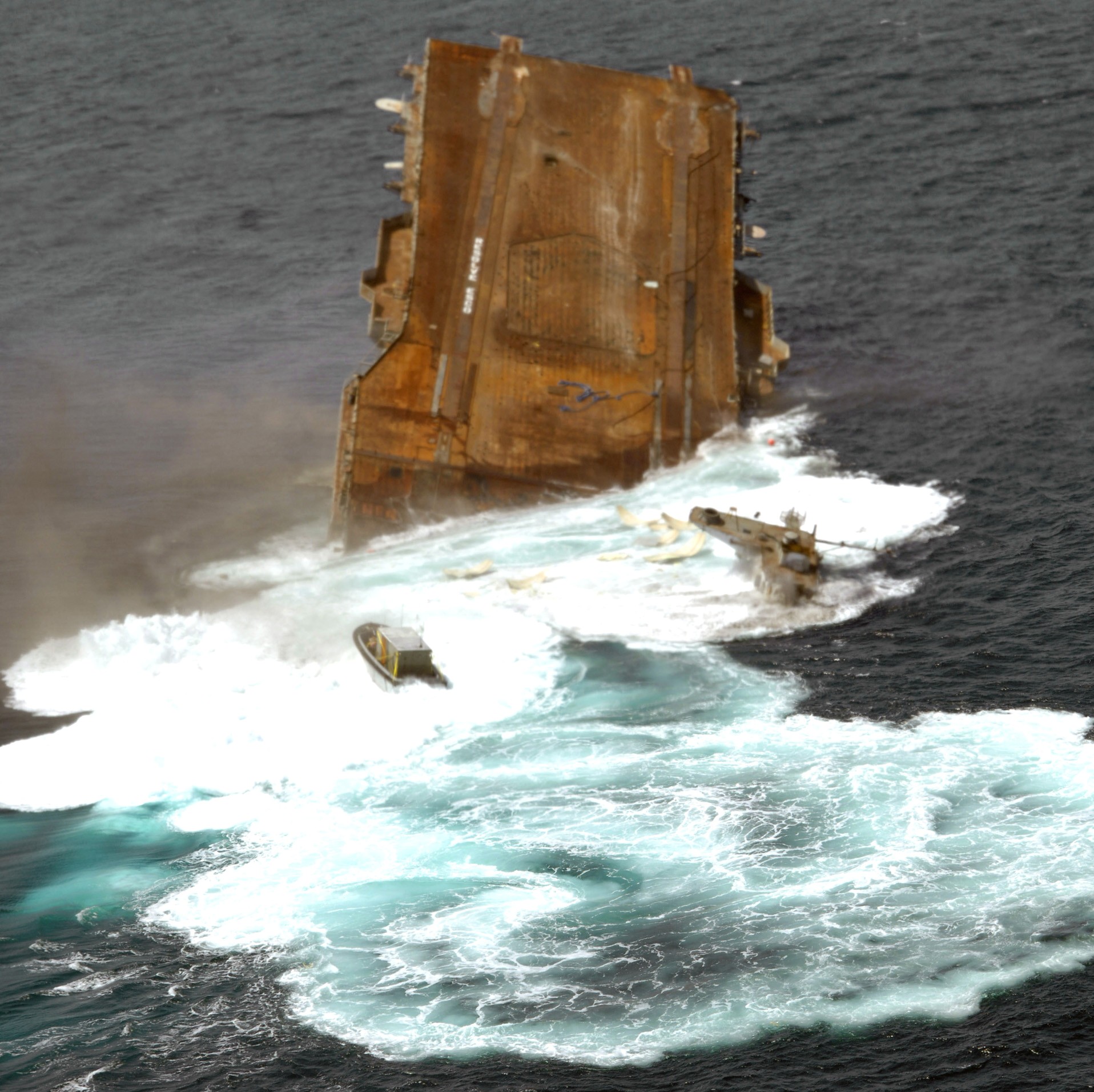 ex USS Oriskany (CV 34) sinking. The carrier will rest on the sea floor 22-miles south of Pensacola, Florida in approximately 212-ft. of water in the Gulf of Mexico, becoming the largest ship ever intentionally sunk as an artificial reef - May 17, 2006 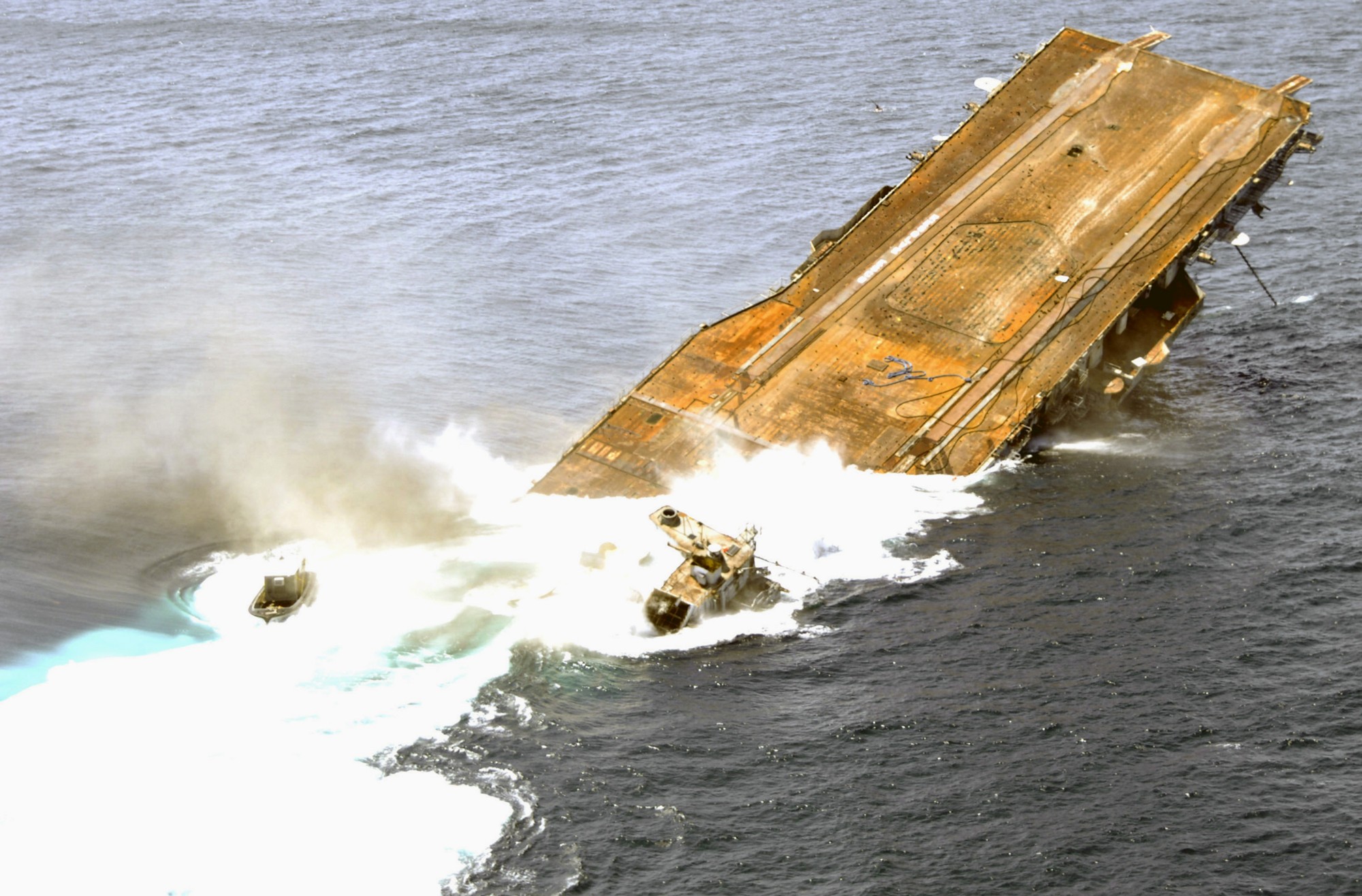 ex-USS Oriskany was sunk 24 miles off the coast of Pensacola, Florida, on May 17 to form an artificial reef. The ship took about 37 minutes to sink below the surface 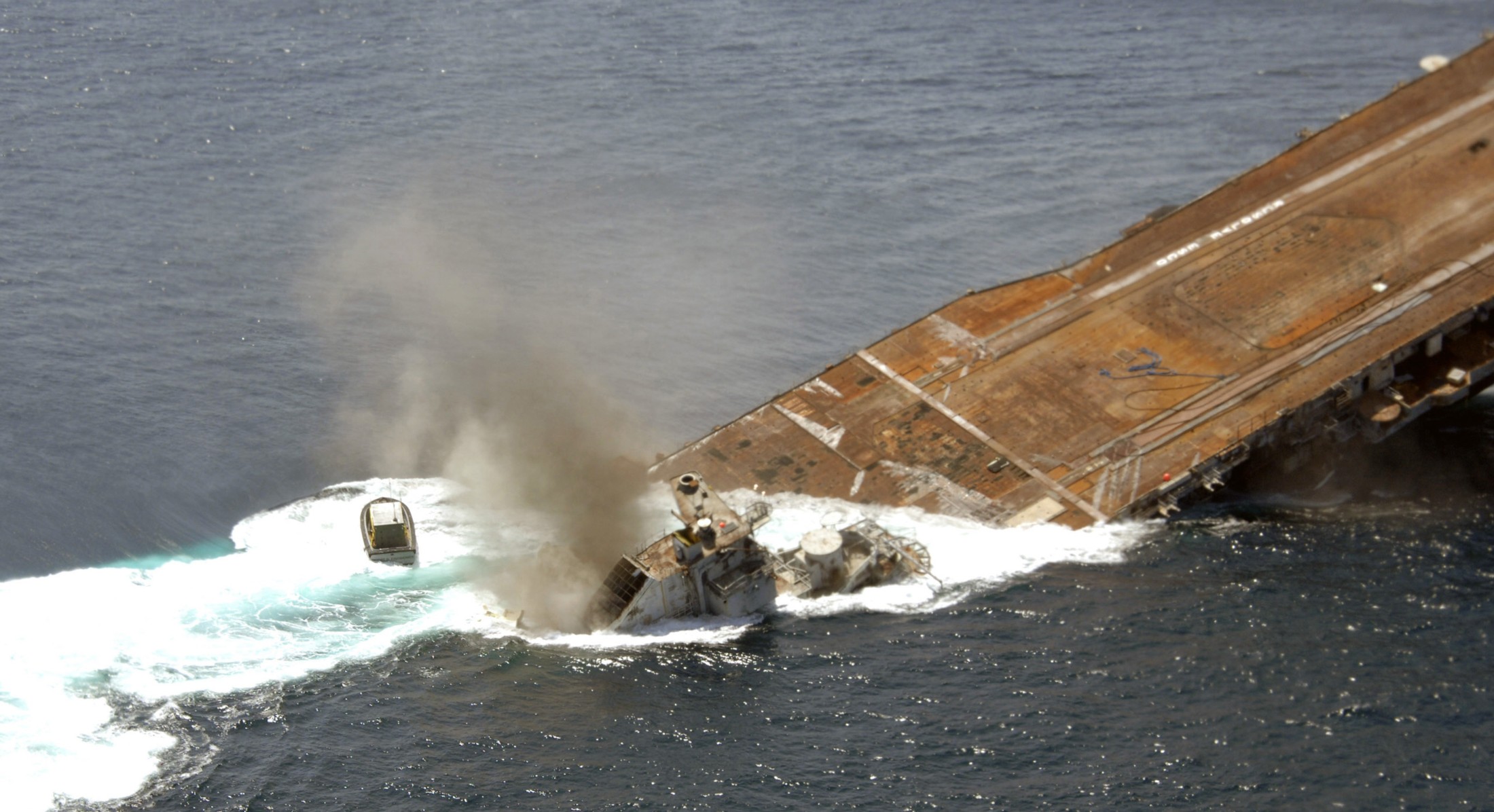 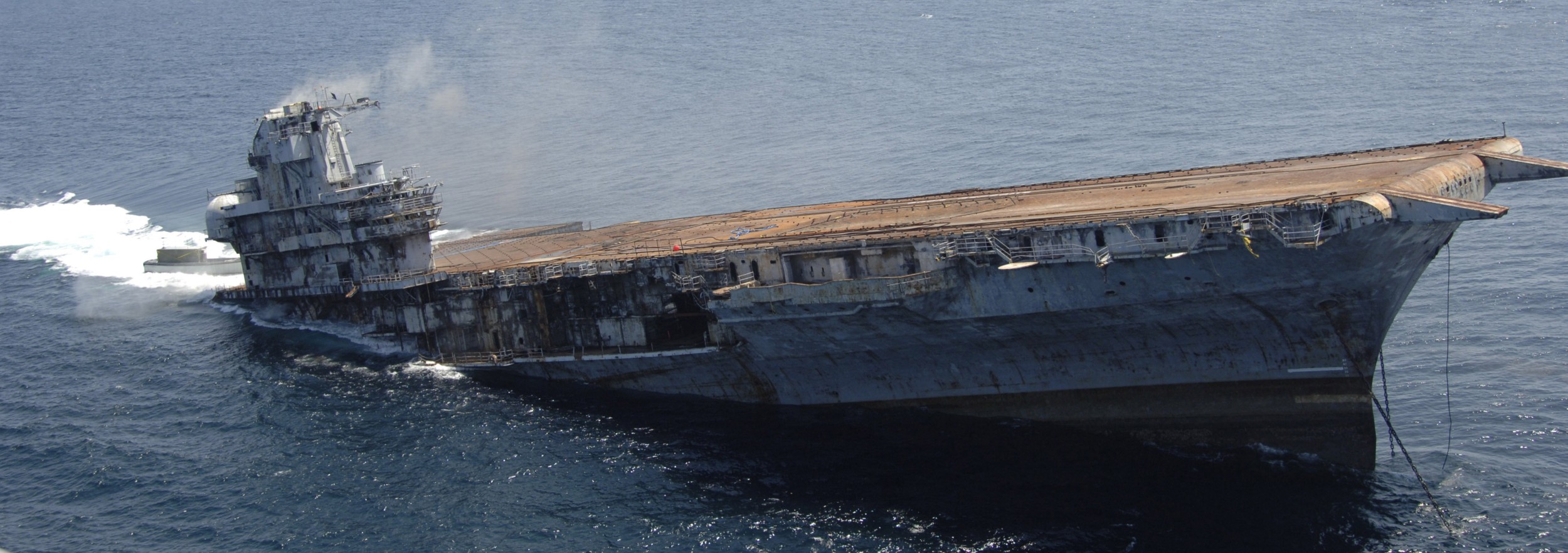 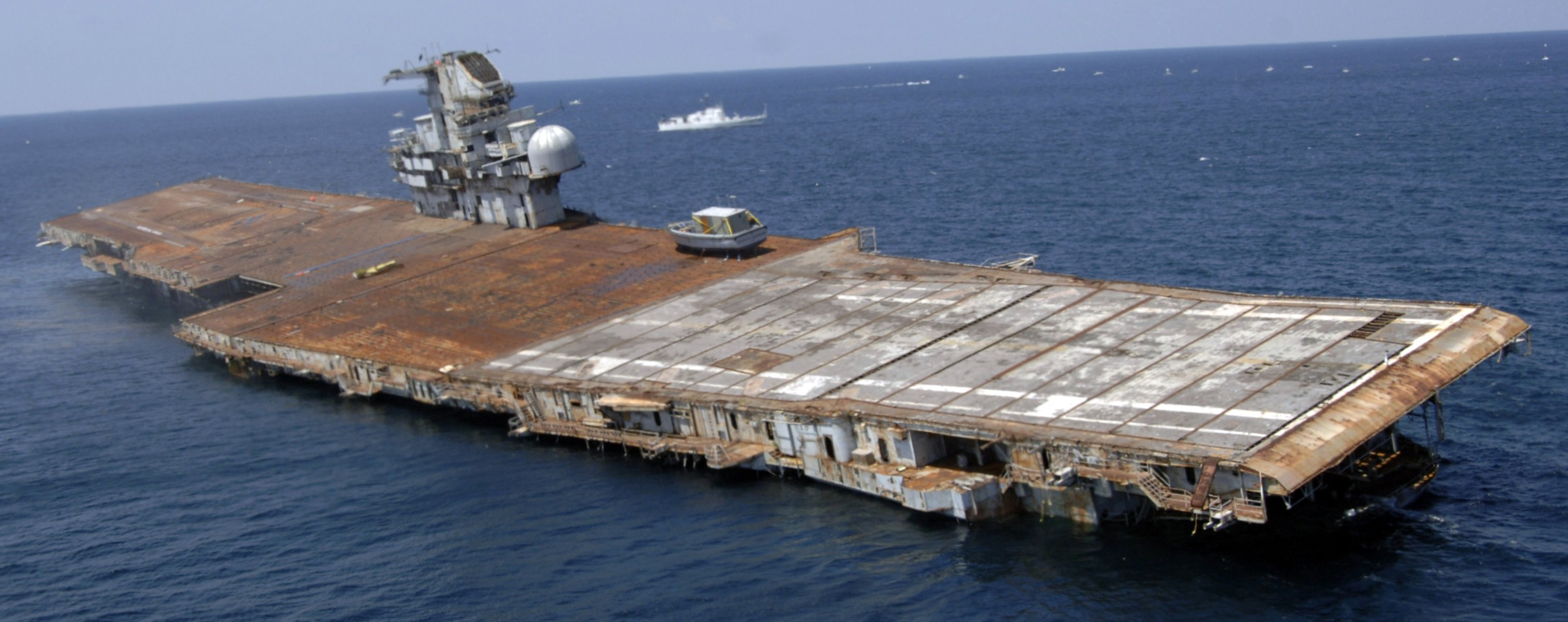 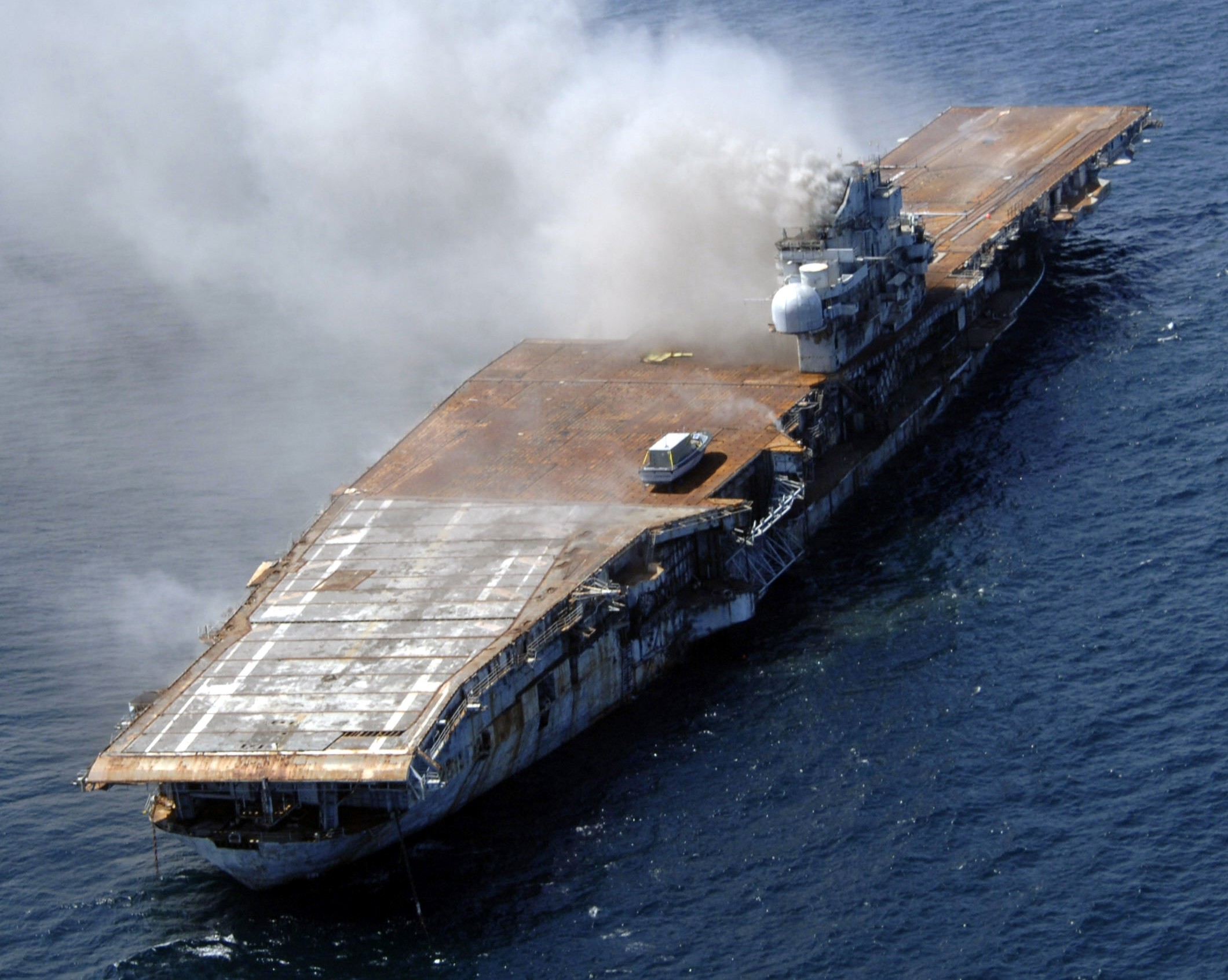 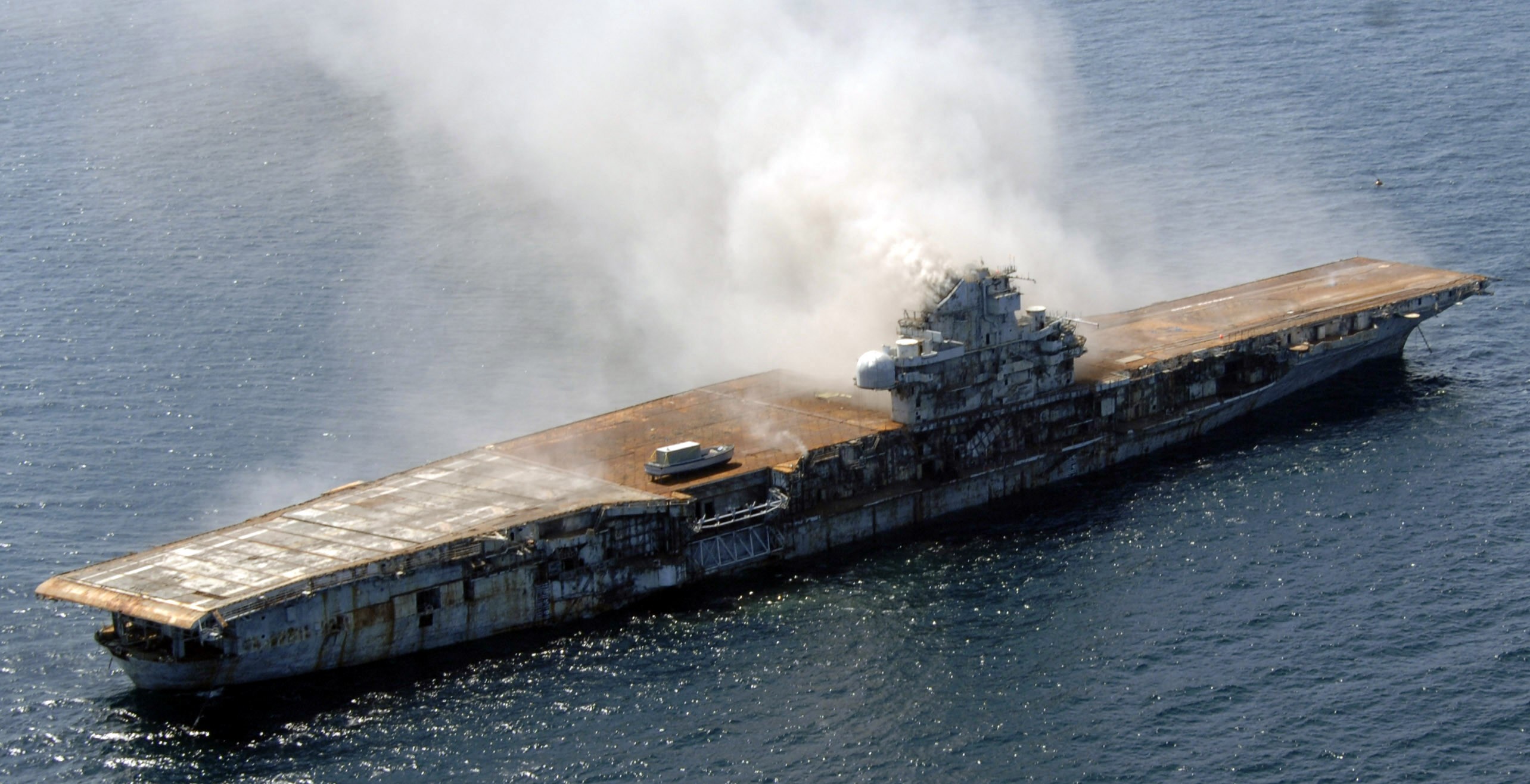 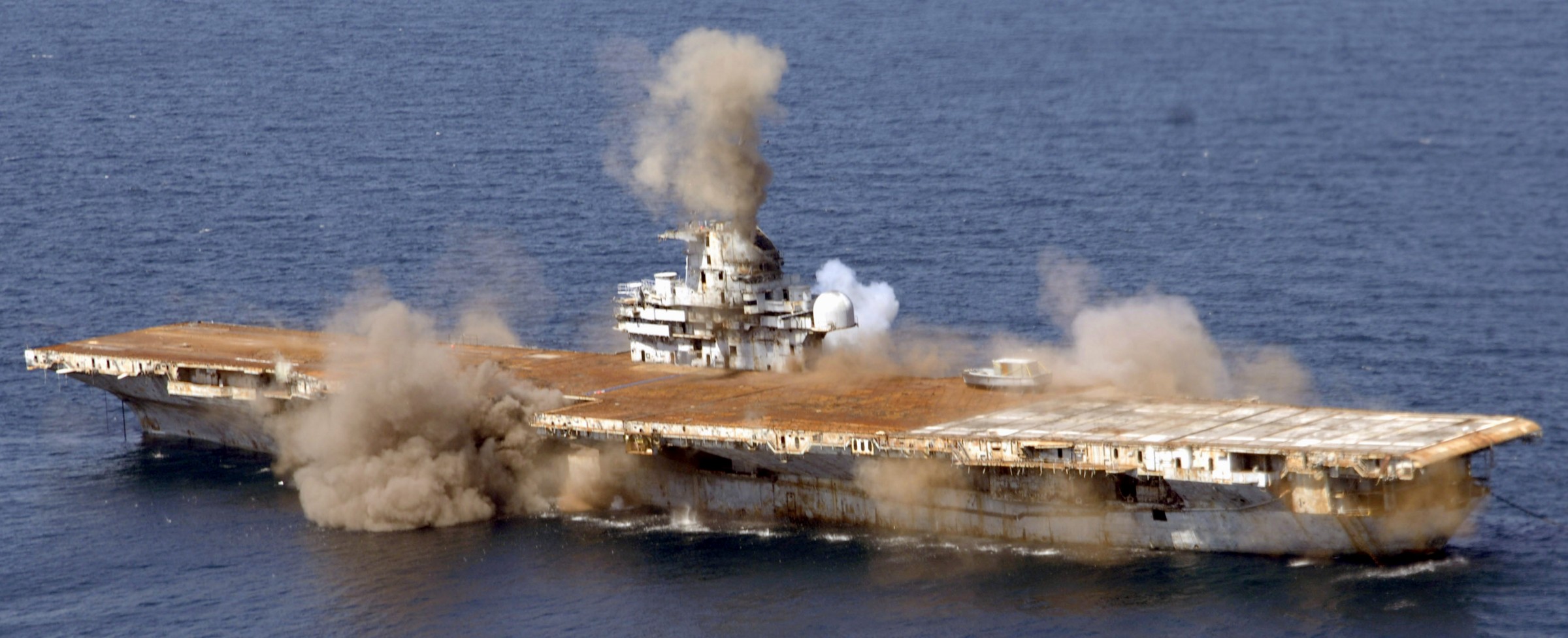 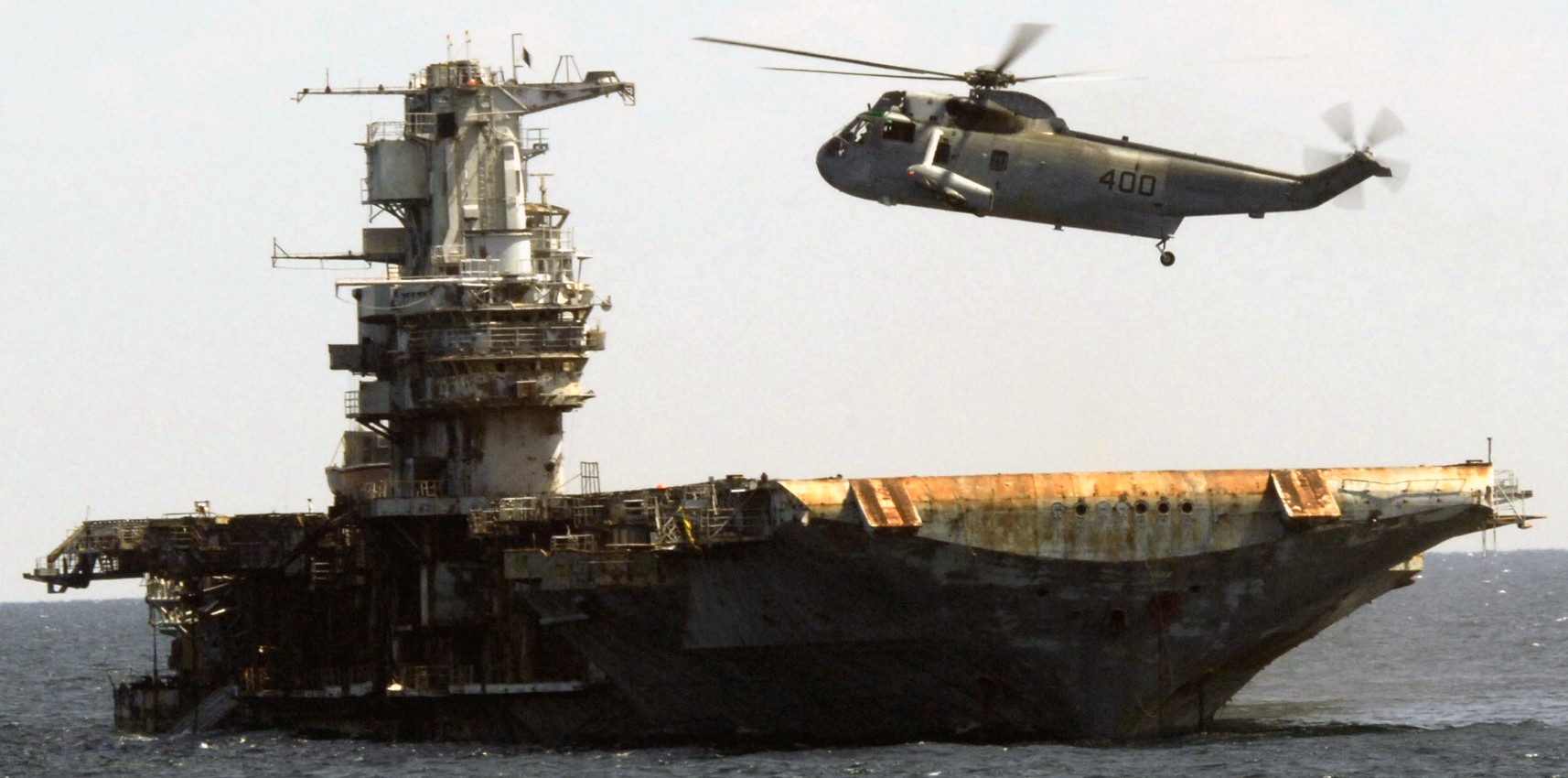 Oriskany's last minutes 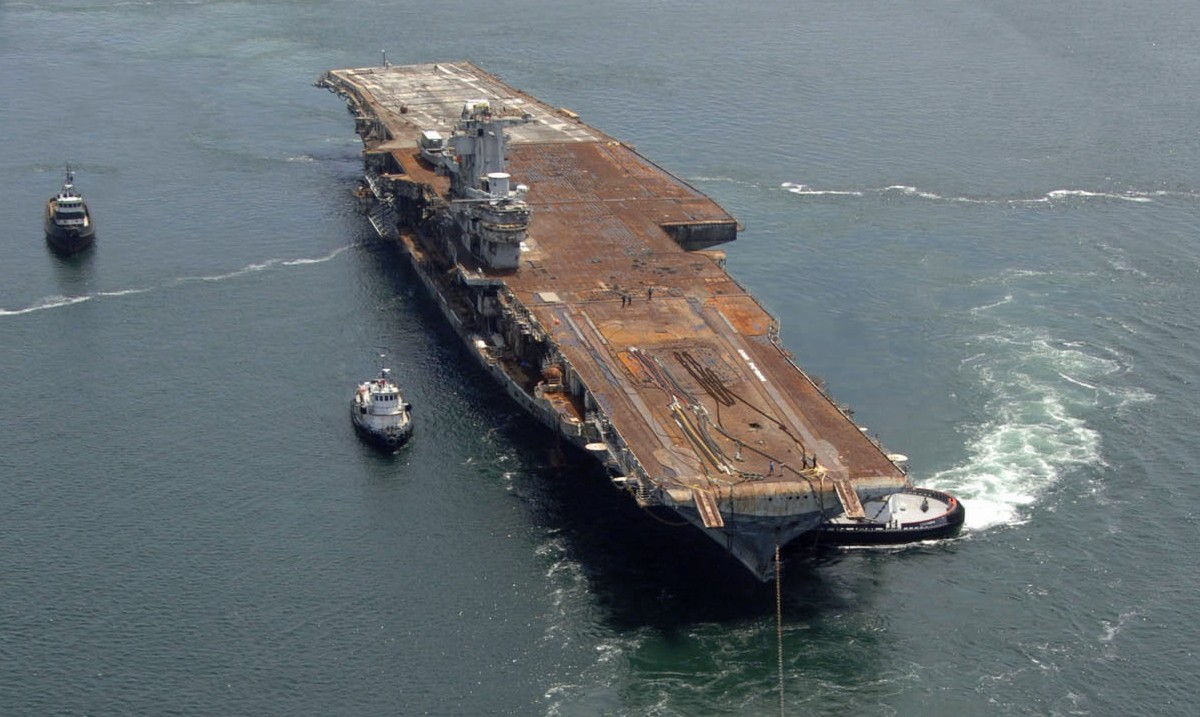 leaving Pensacola for her final journey 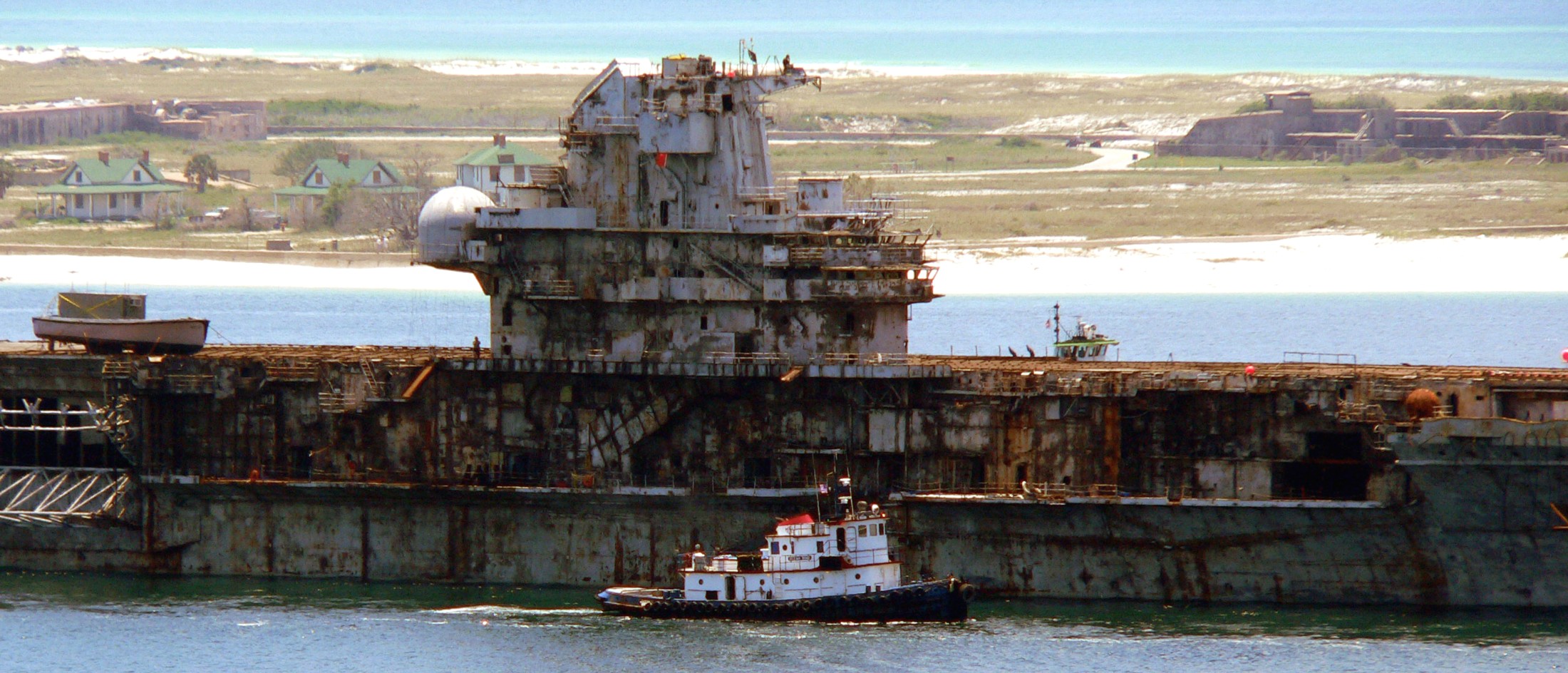 leaving Pensacola for her final journey 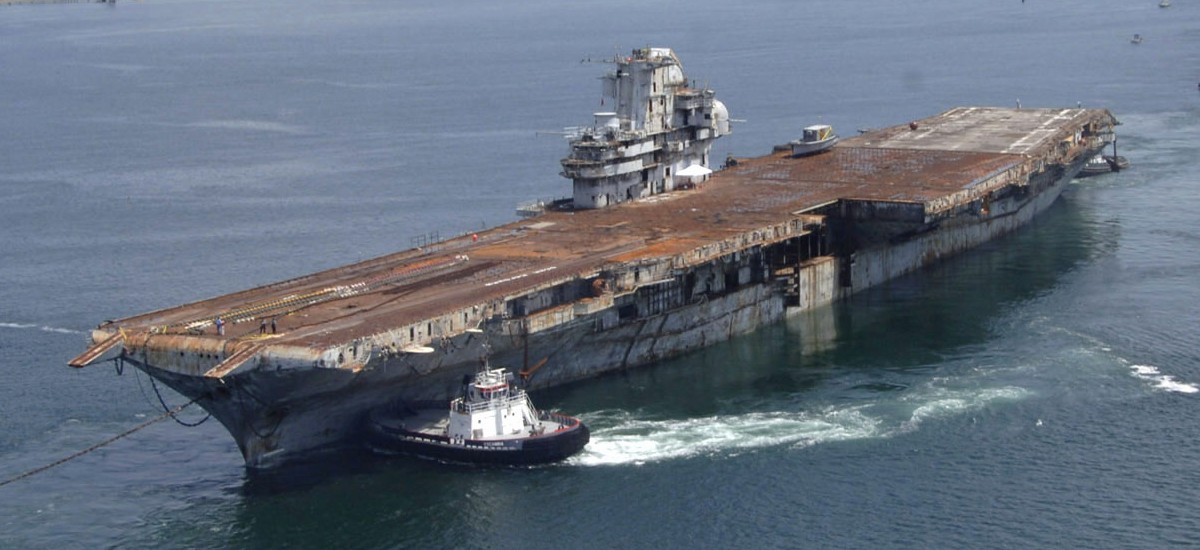 leaving Pensacola for her final journey 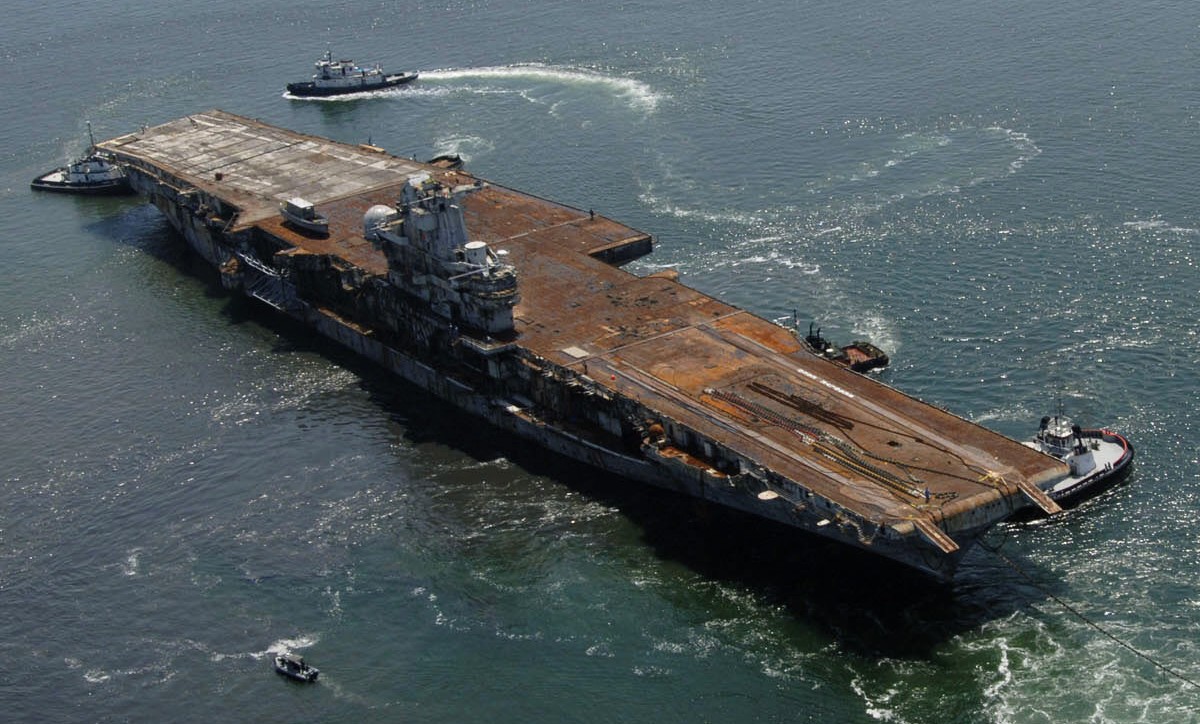 leaving Pensacola for her final journey 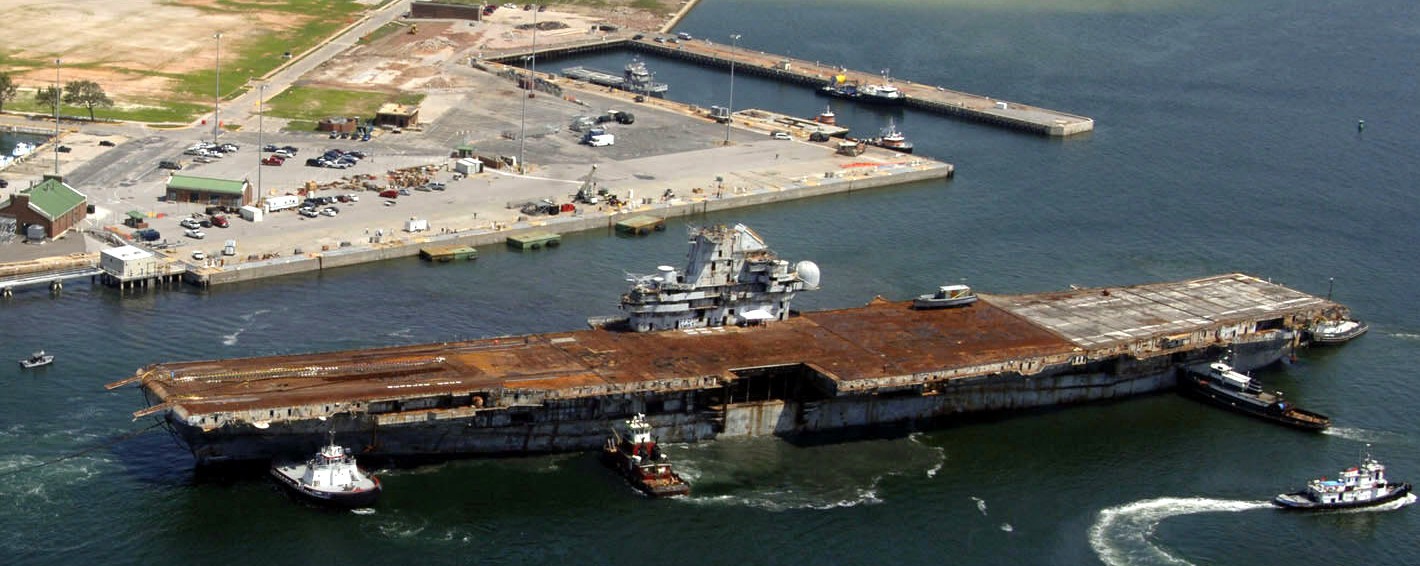 leaving Pensacola for her final journey 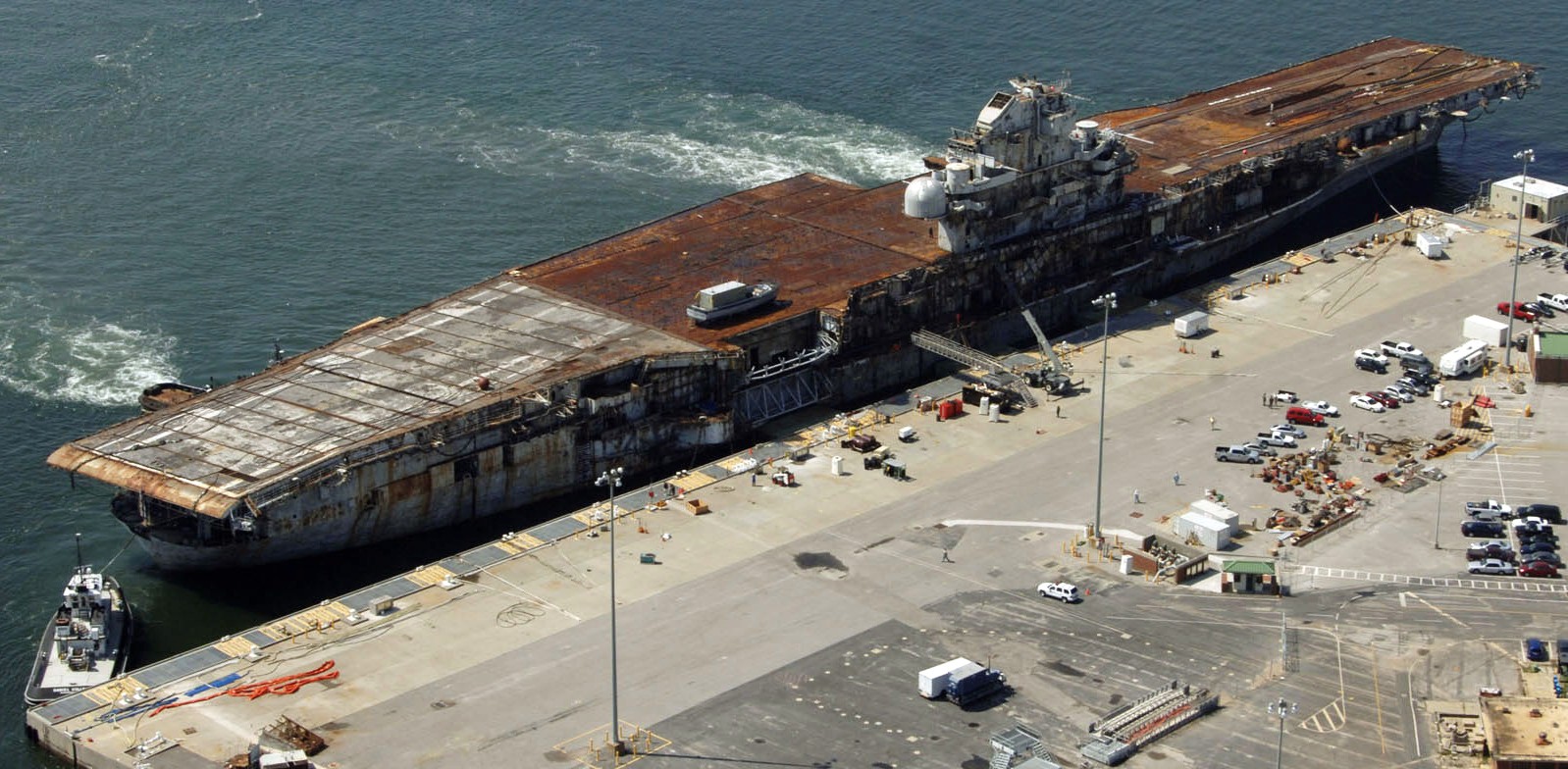 ex USS Oriskany (CV 34) moored at Naval Air Station Pensacola, Florida - April 2006 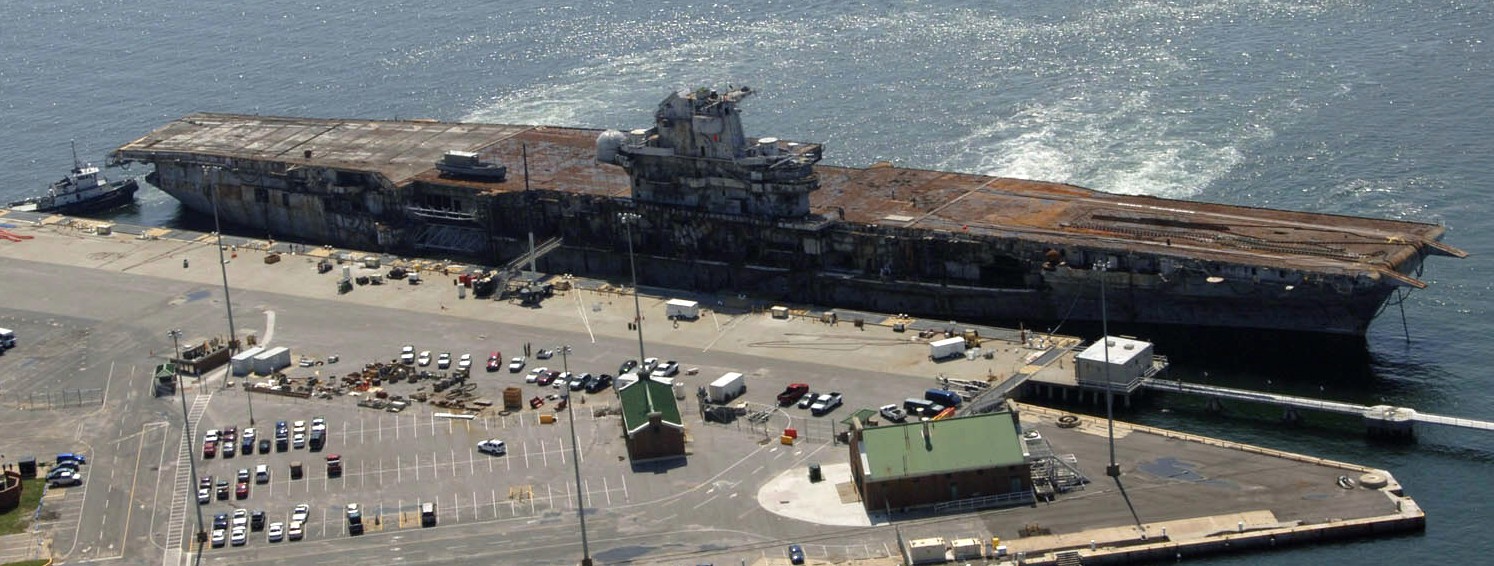 ex USS Oriskany (CV 34) moored at Naval Air Station Pensacola, Florida - April 2006 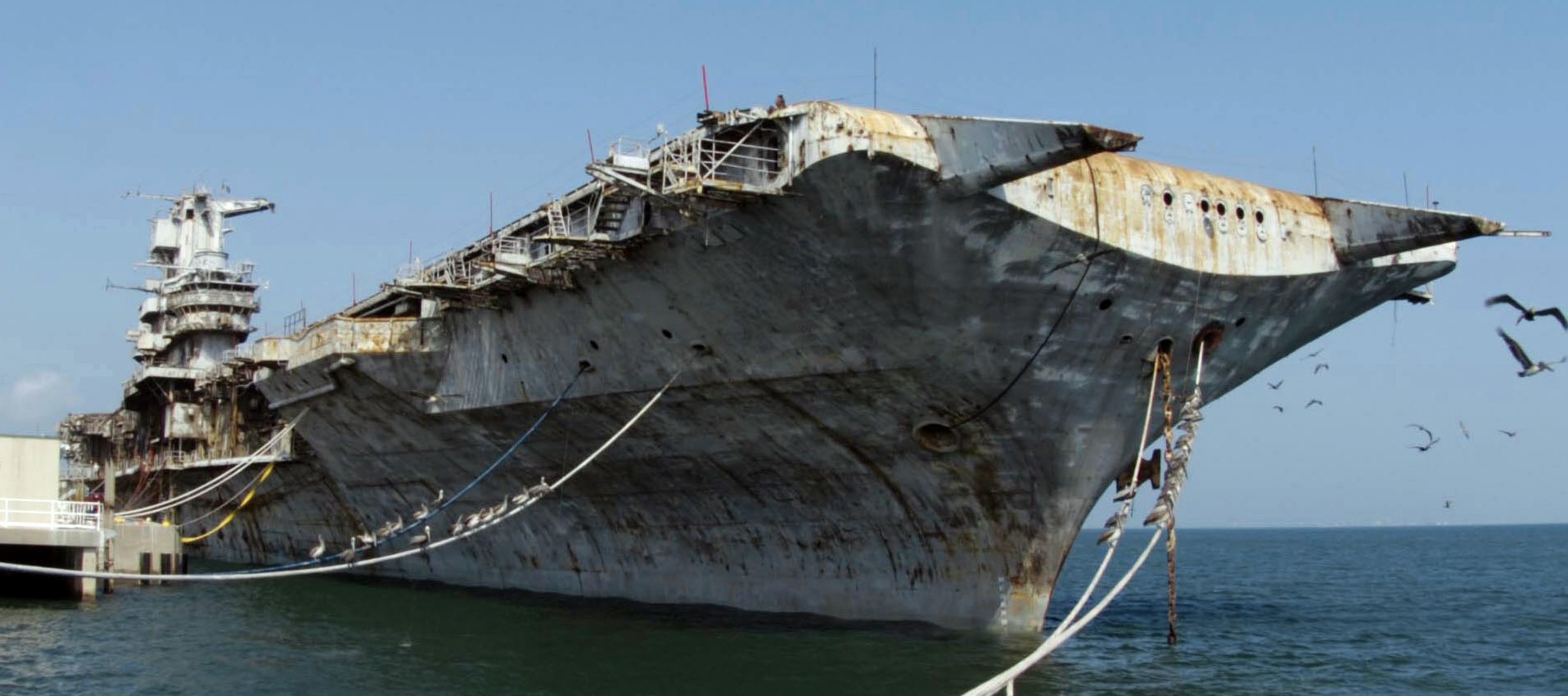 ex USS Oriskany (CV 34) moored at Naval Air Station Pensacola, Florida - April 2006 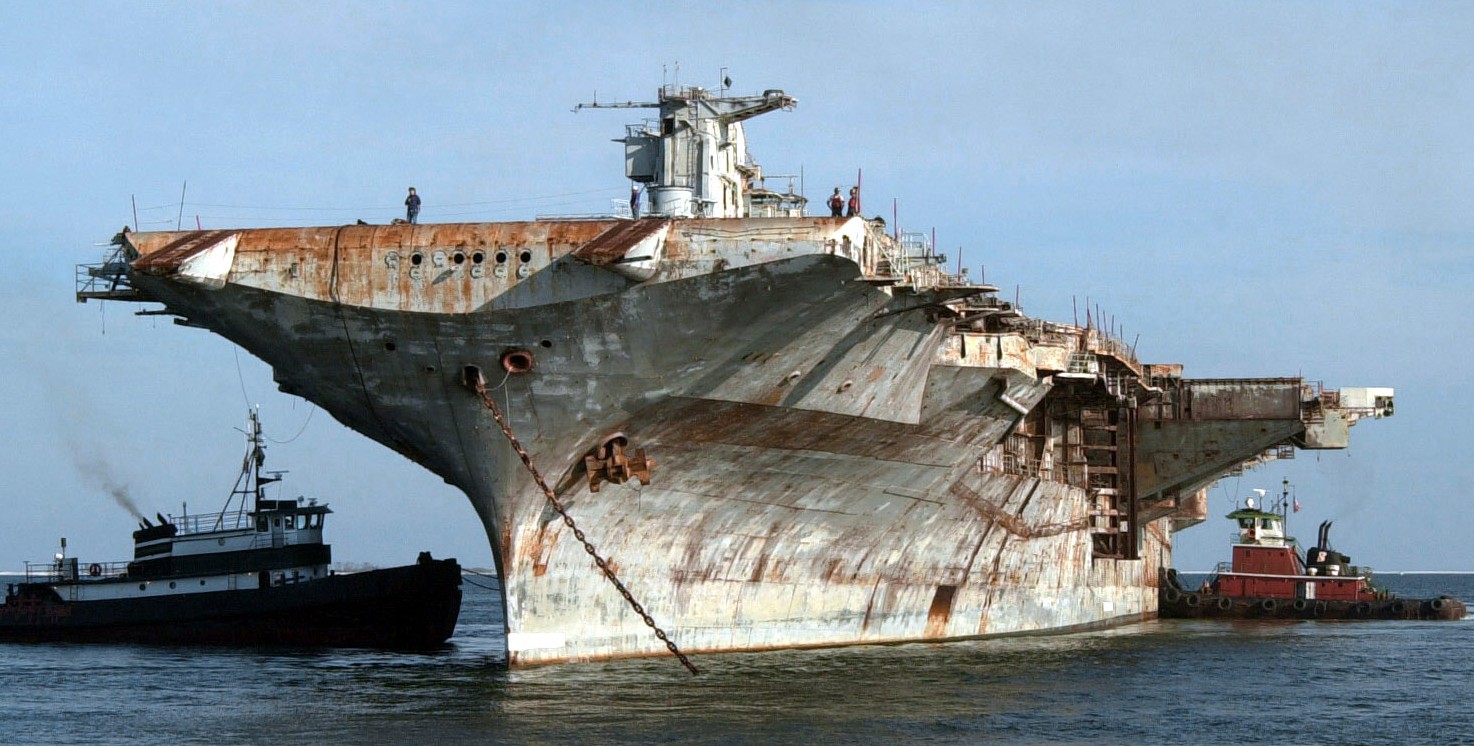 tugboats turn the decommissioned USS Oriskany (CV 34) prior to mooring onto the Allegheny Pier at Naval Air Station Pensacola, Florida - March 2006 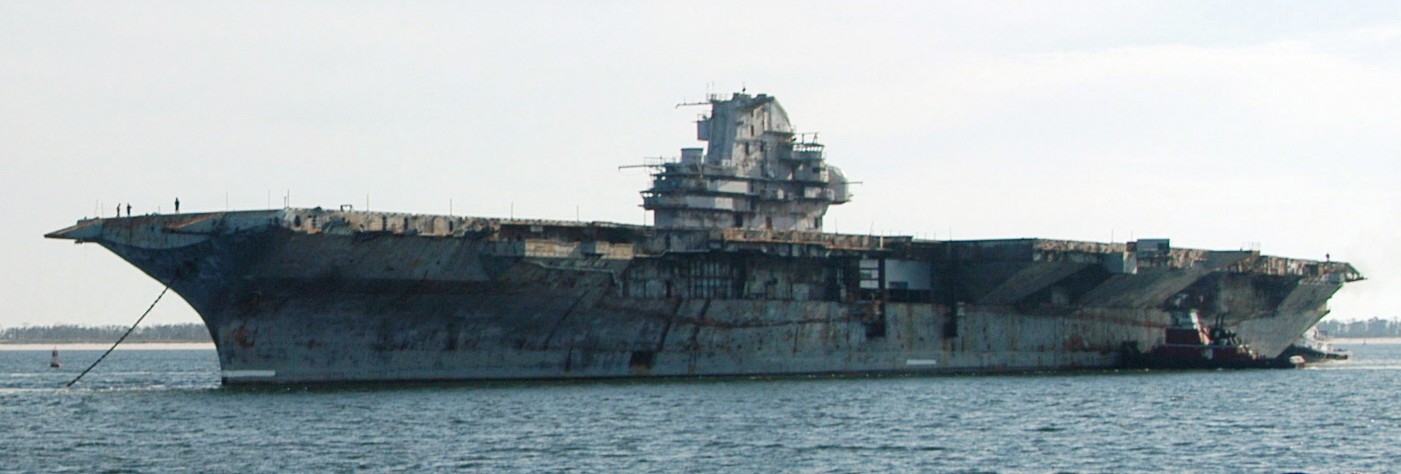 USS Oriskany (CV 34) at Naval Air Station Pensacola, Florida - March 2006 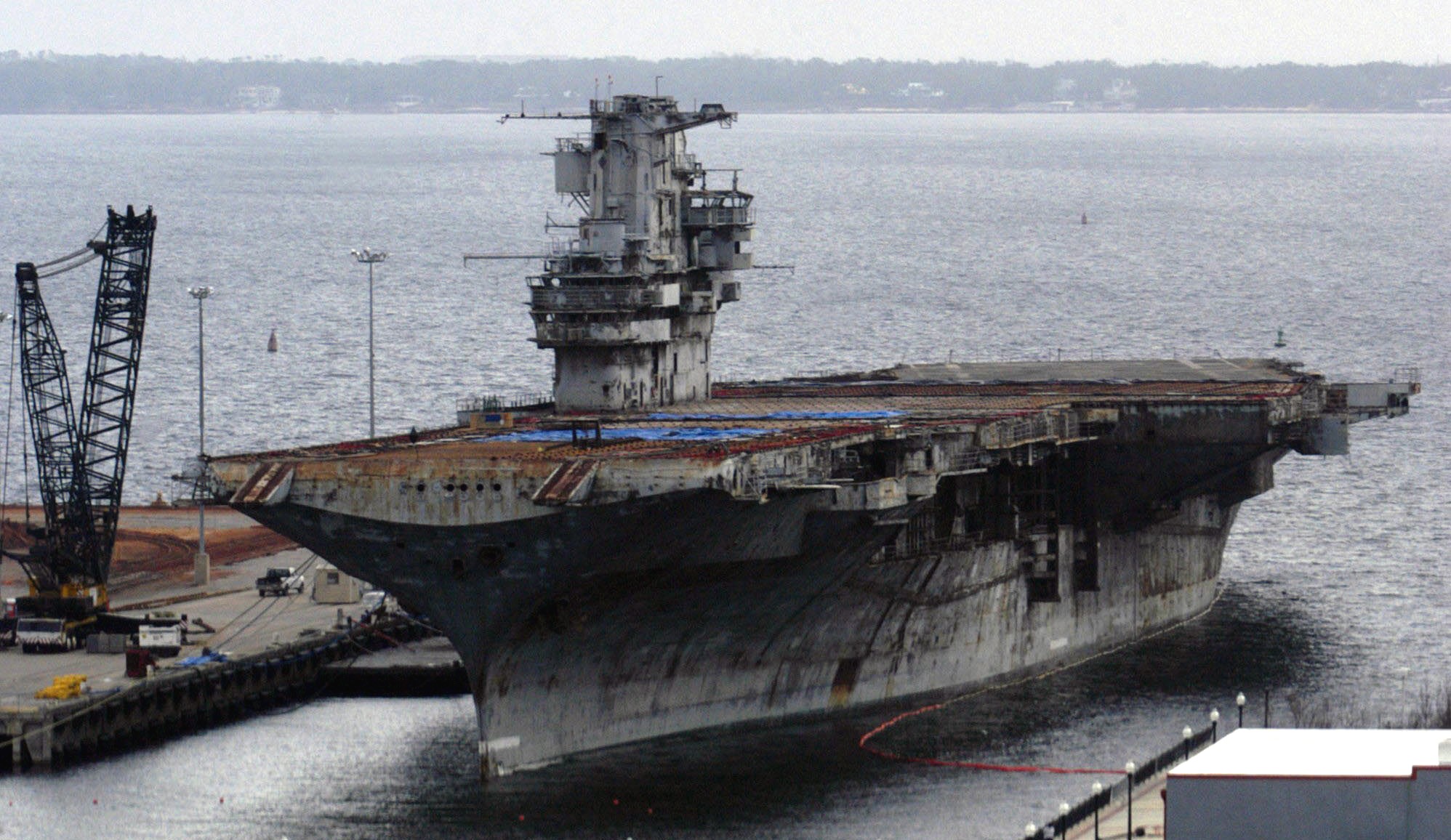 USS Oriskany (CV 34) arriving at Naval Air Station Pensacola, Florida - January 2005 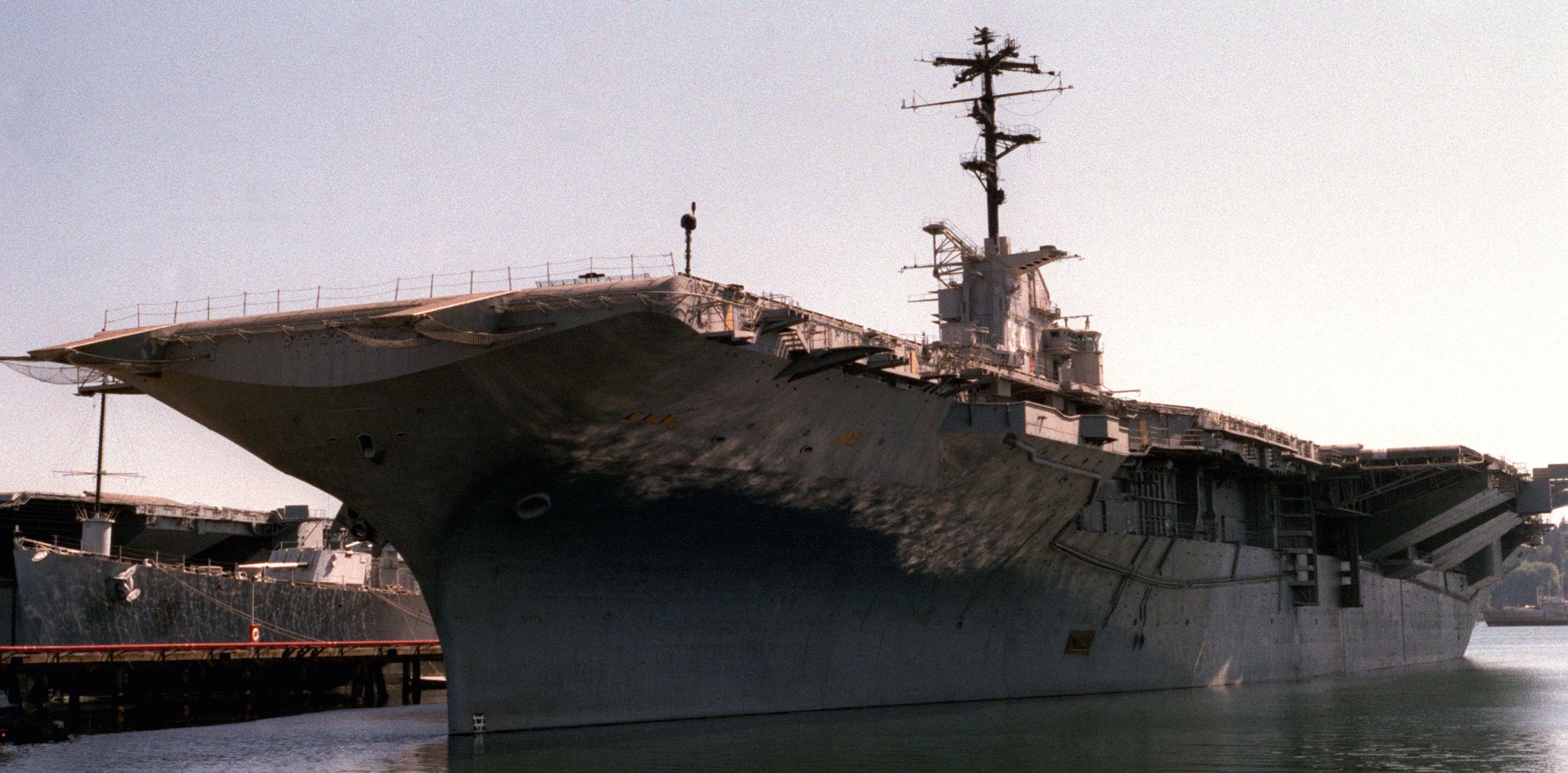 ex USS Oriskany laid up at the Naval Inactive Ship Maintenance Facility (NISMF) Puget Sound, Washington - 1990 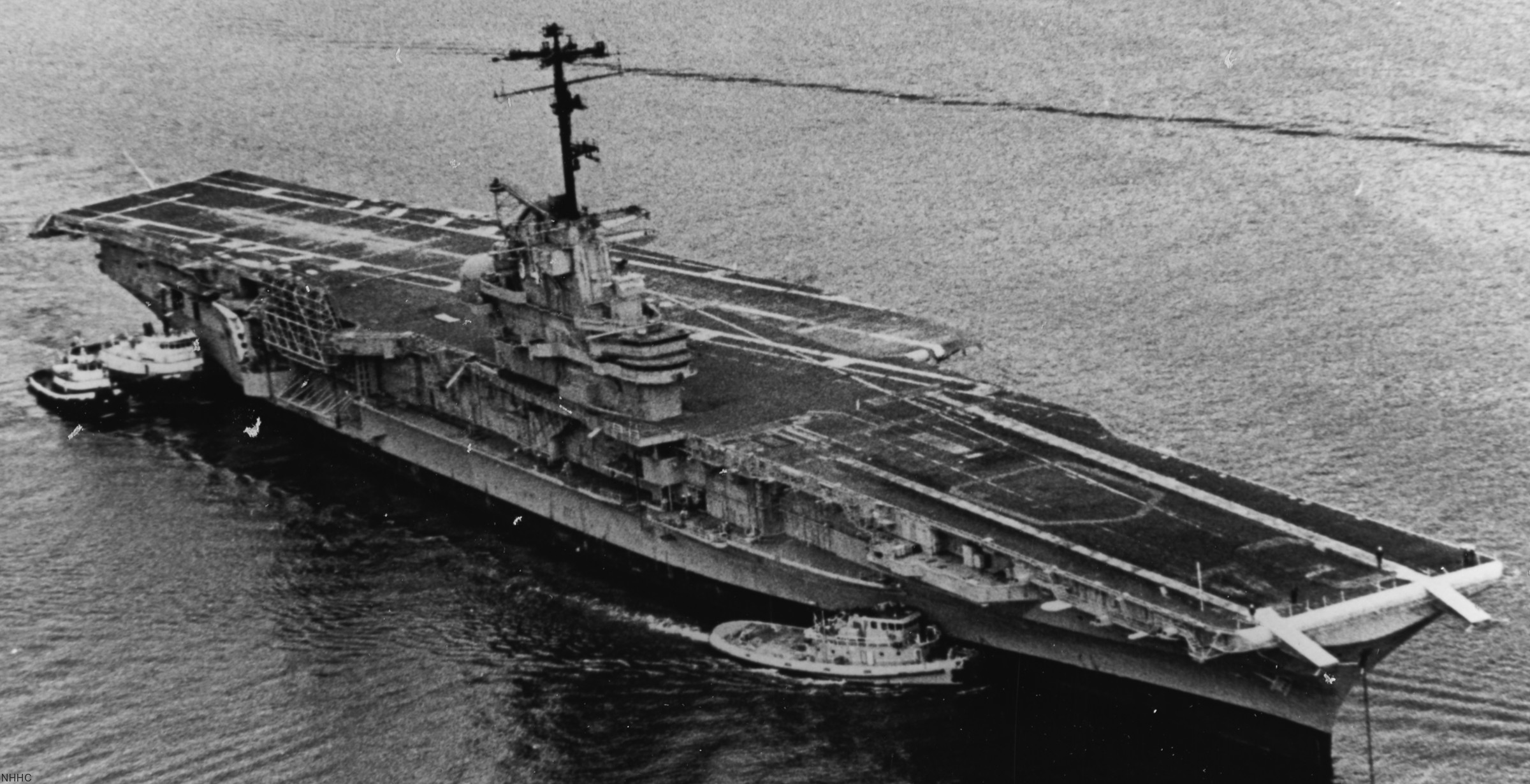 USS Oriskany (CV 34) being towed into the Naval Reserve Fleet Area at Bremerton, Washington - October 1976 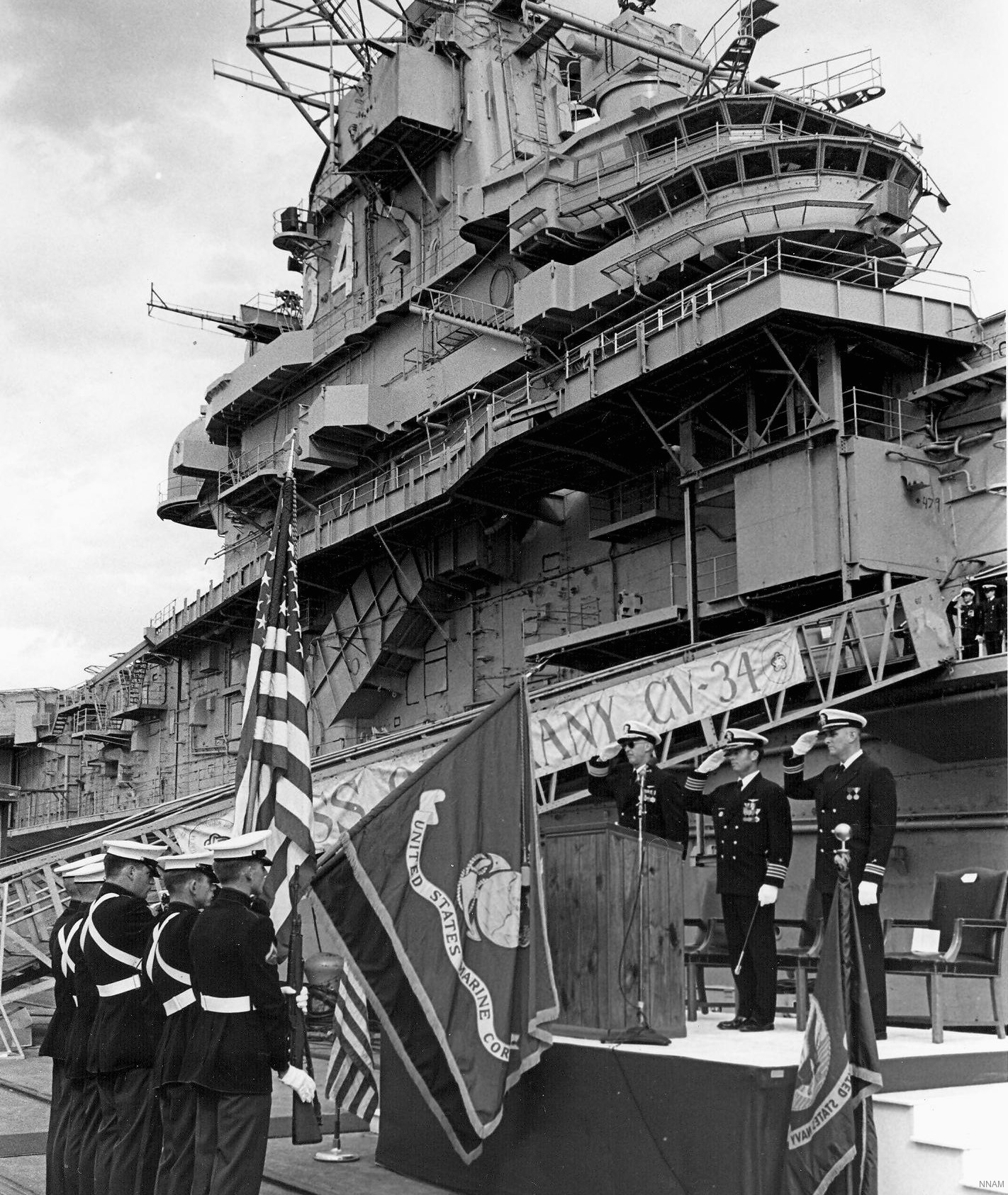 USS Oriskany (CV 34) during her decommissioning ceremony at NAS Alameda, California - September 30, 1976 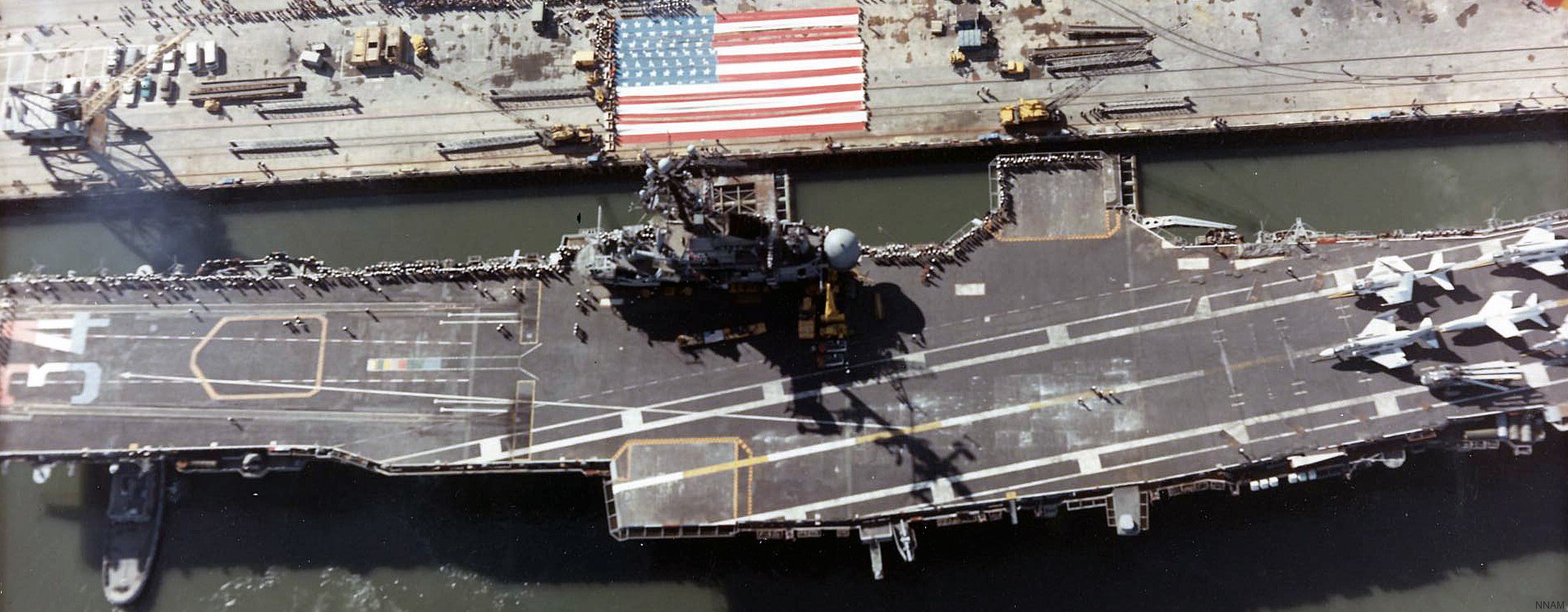 USS Oriskany (CV 34) returning to NAS Alameda, California after her final deployment - March 1976 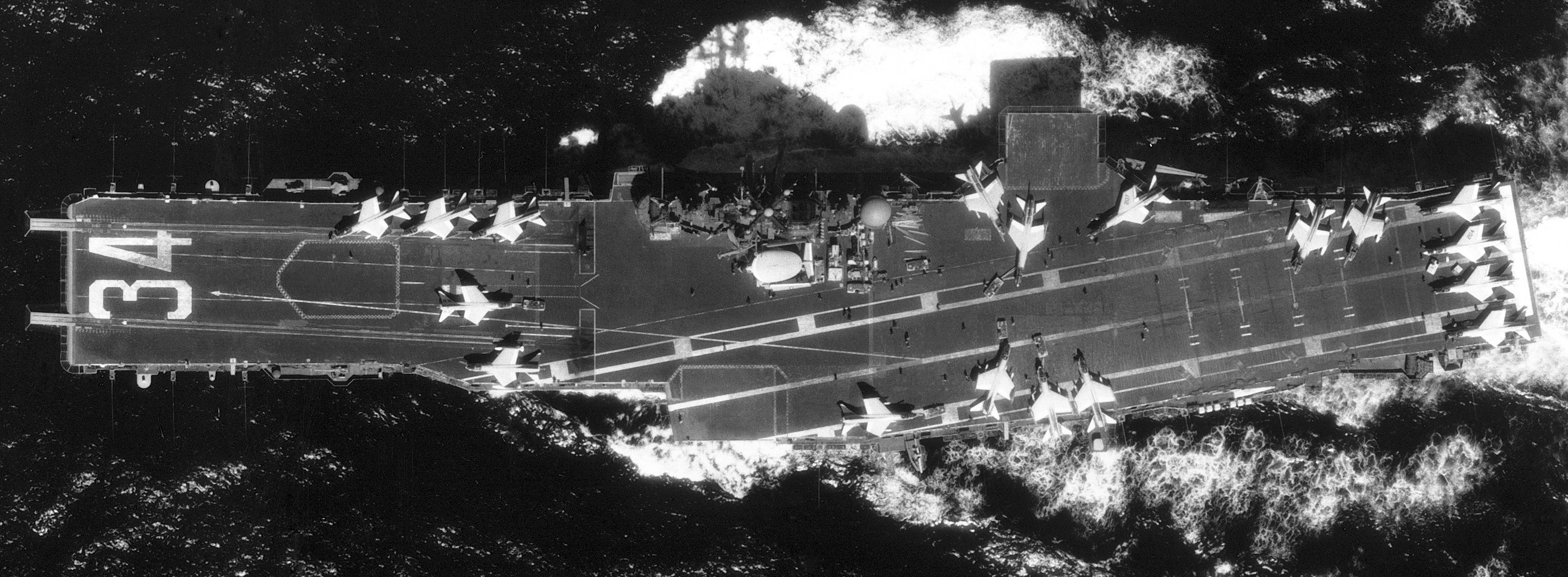 USS Oriskany (CVA 34) with Carrier Air Wing 19 (CVW-19) embarked - circa 1975  USS Oriskany (CVA 34) with Carrier Air Wing 19 (CVW-19) embarked - 1974 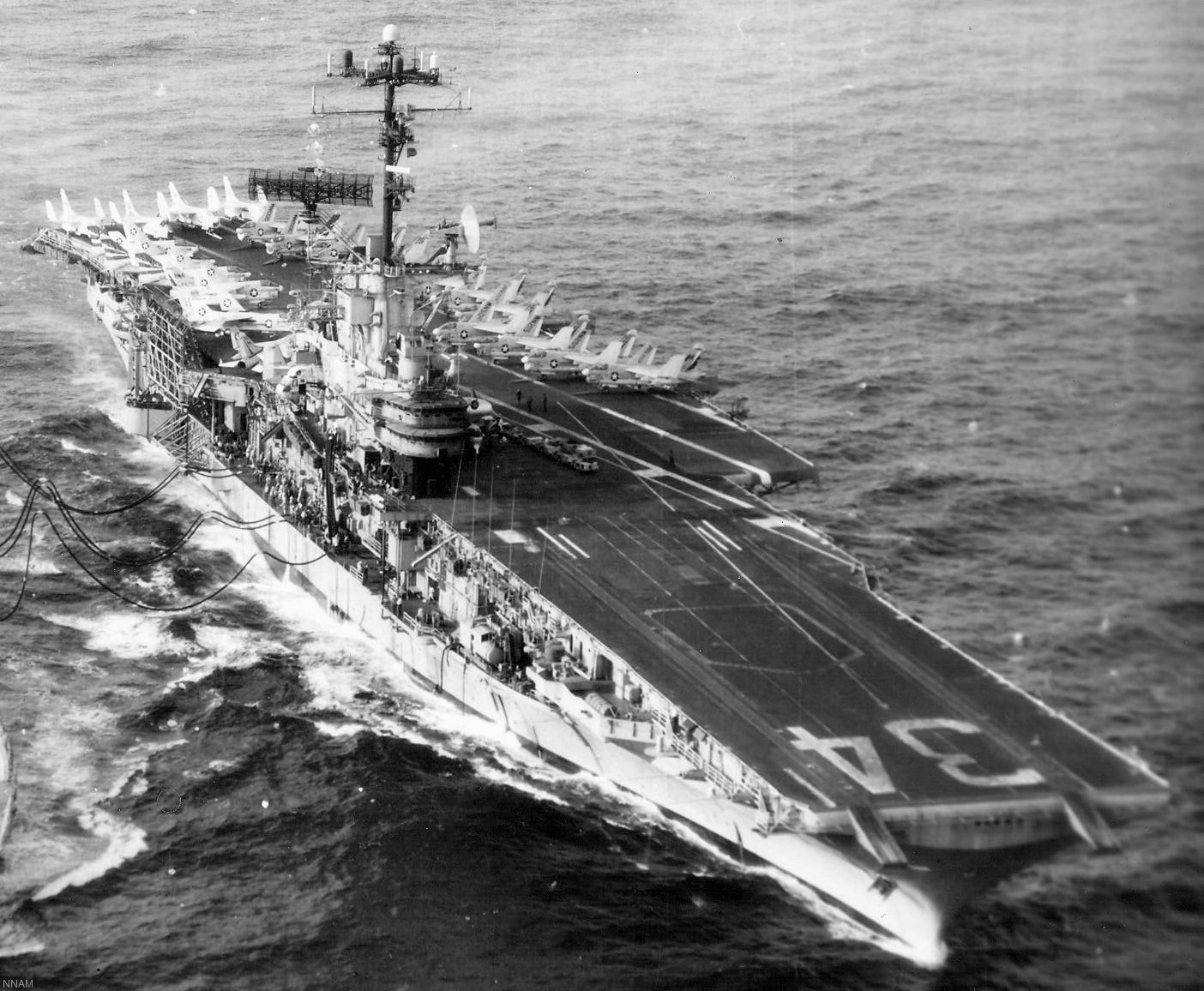 USS Oriskany (CVA 34) with Carrier Air Wing 19 (CVW-19) embarked - 1974 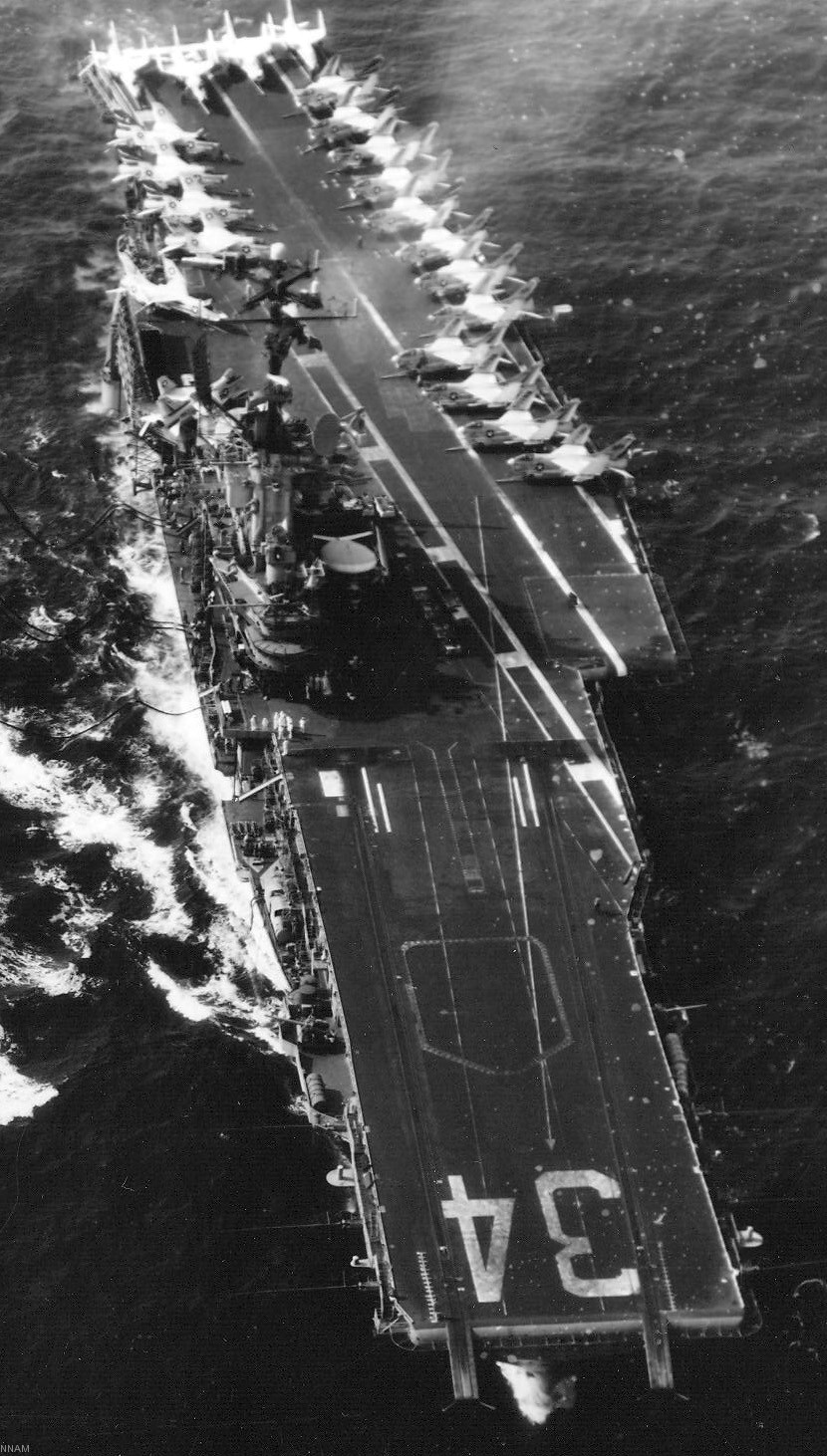 USS Oriskany (CVA 34) with Carrier Air Wing 19 (CVW-19) embarked - 1974 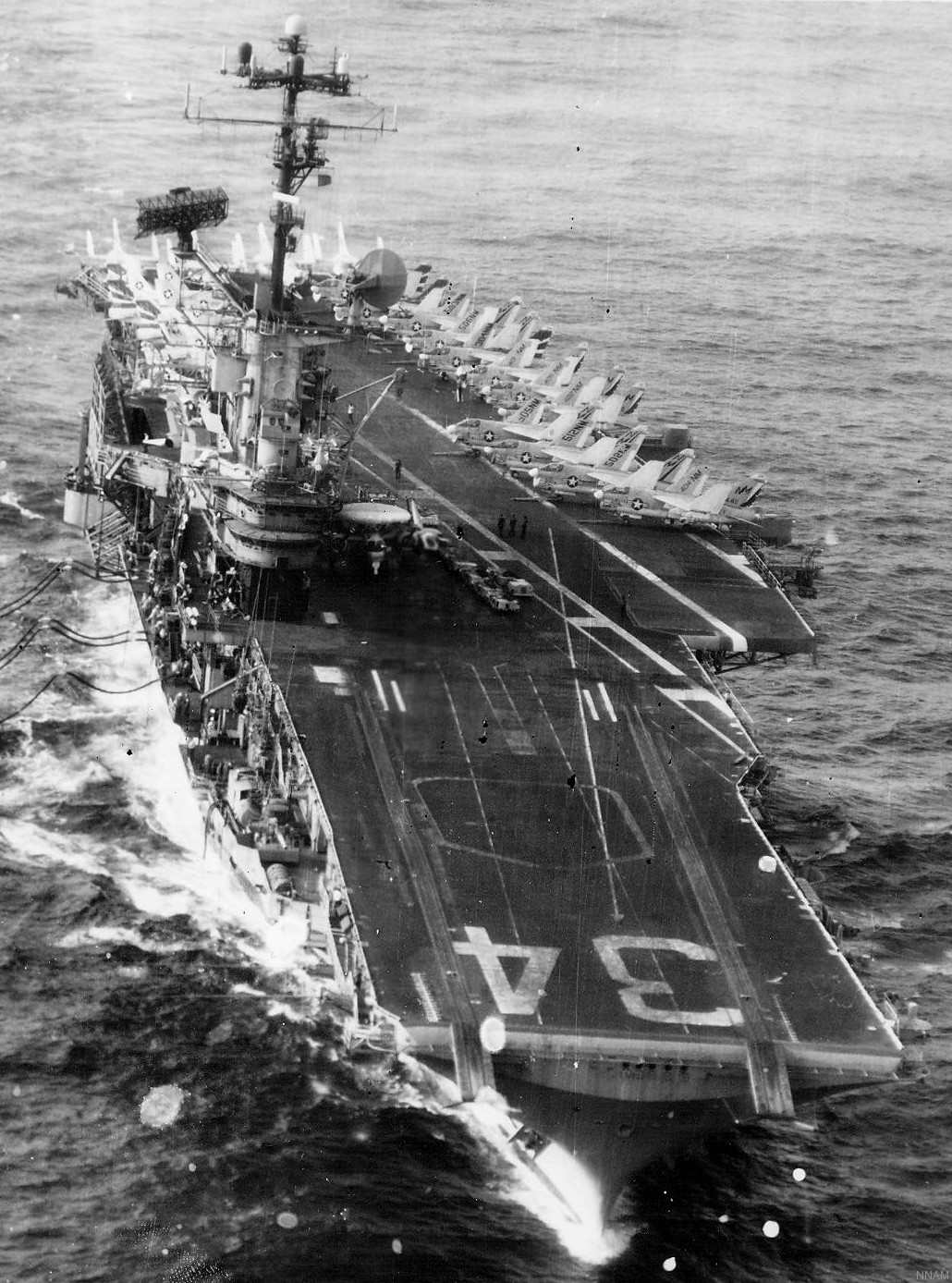 USS Oriskany (CVA 34) with Carrier Air Wing 19 (CVW-19) embarked - 1974 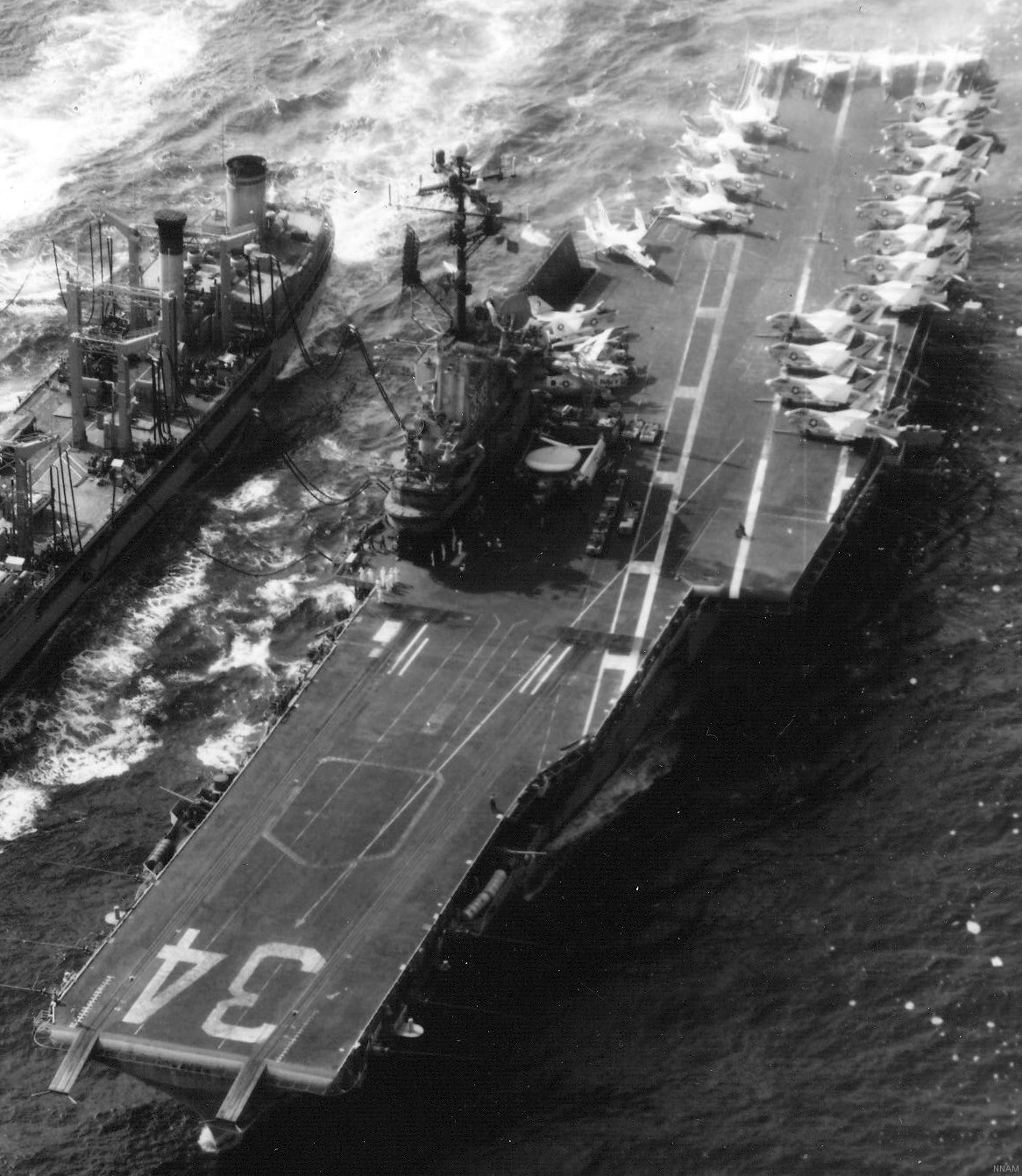 USS Oriskany (CVA 34) with Carrier Air Wing 19 (CVW-19) embarked - 1974 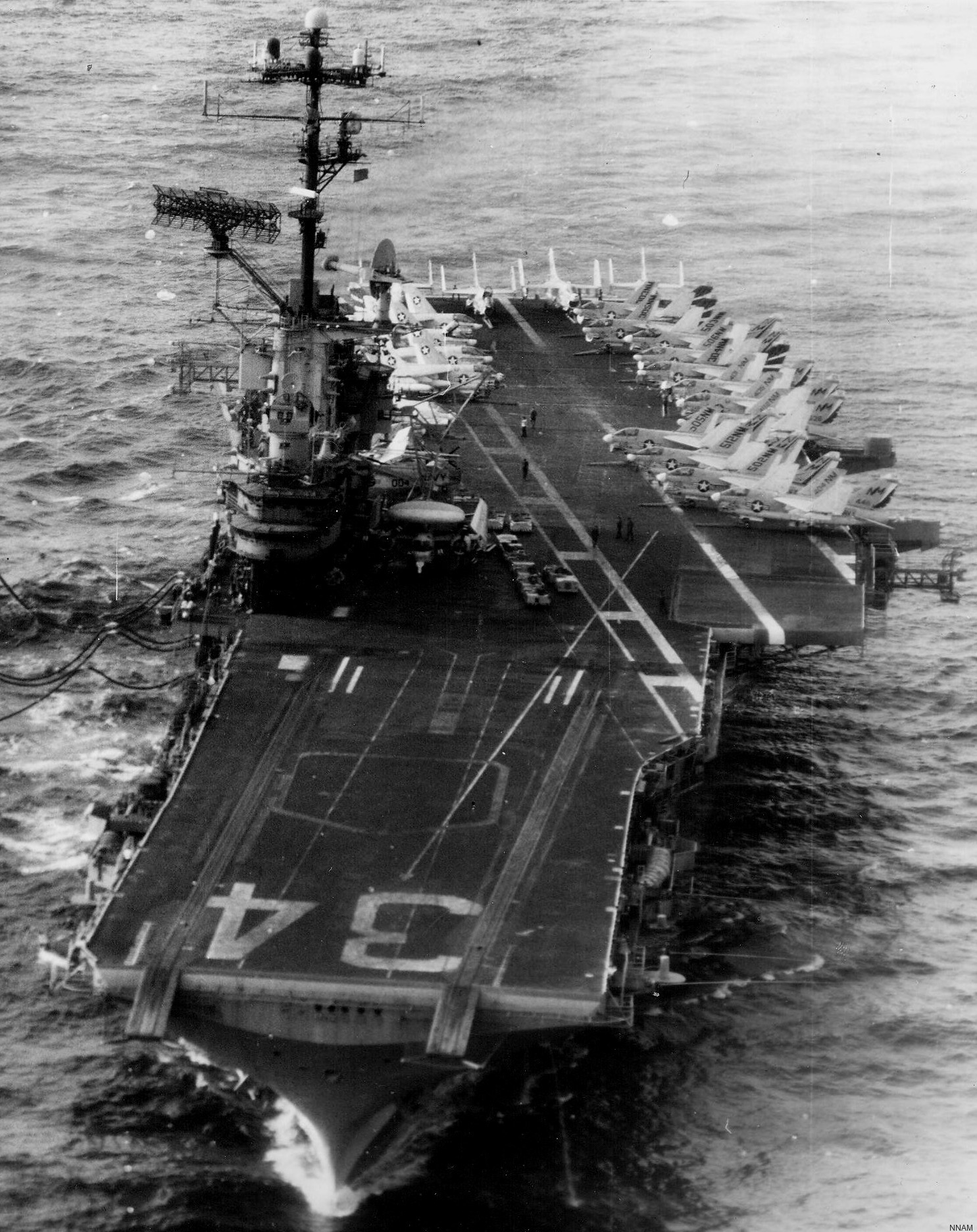 USS Oriskany (CVA 34) with Carrier Air Wing 19 (CVW-19) embarked - 1974 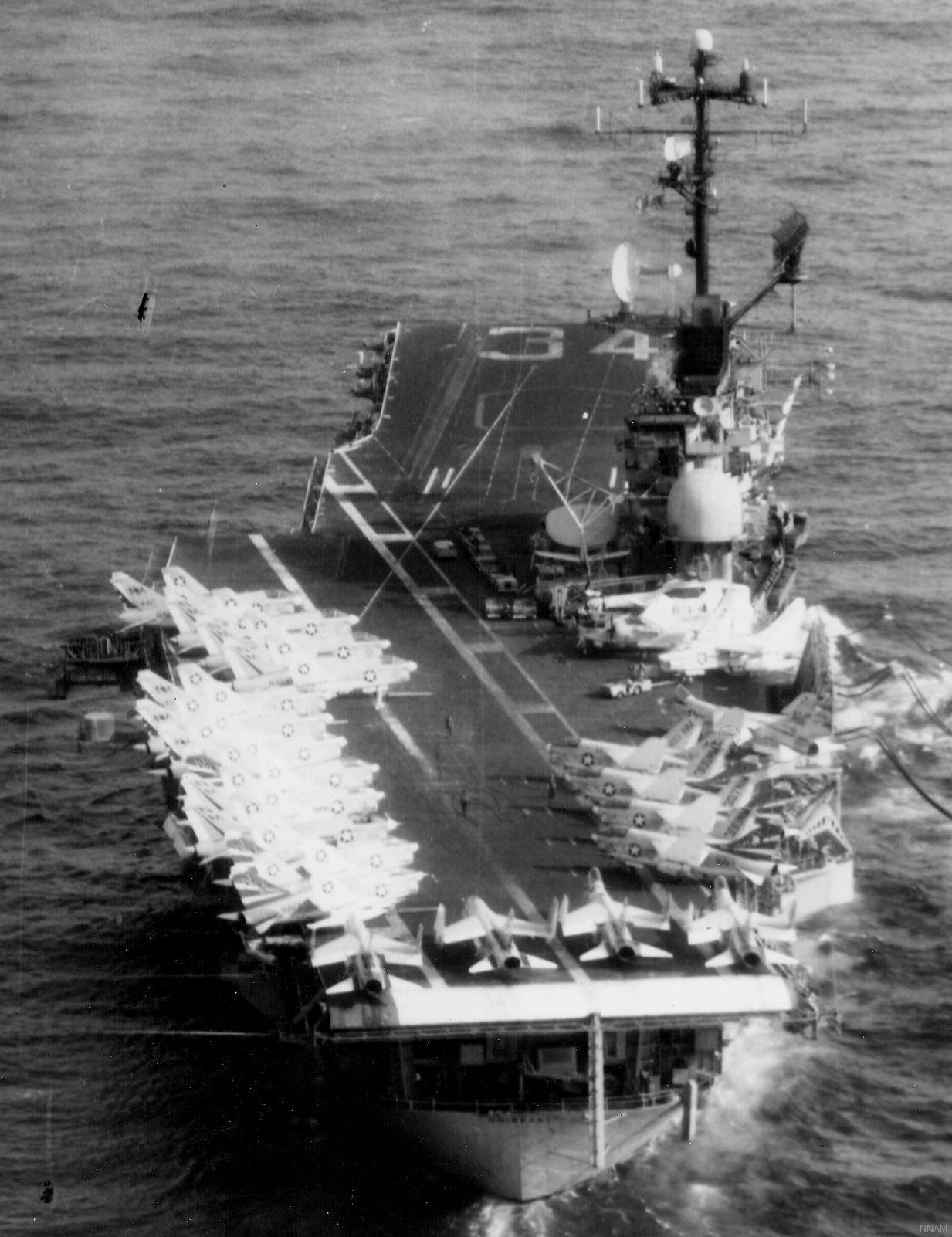 USS Oriskany (CVA 34) with Carrier Air Wing 19 (CVW-19) embarked - 1974  USS Oriskany (CVA 34) with Carrier Air Wing 19 (CVW-19) embarked - circa 1974 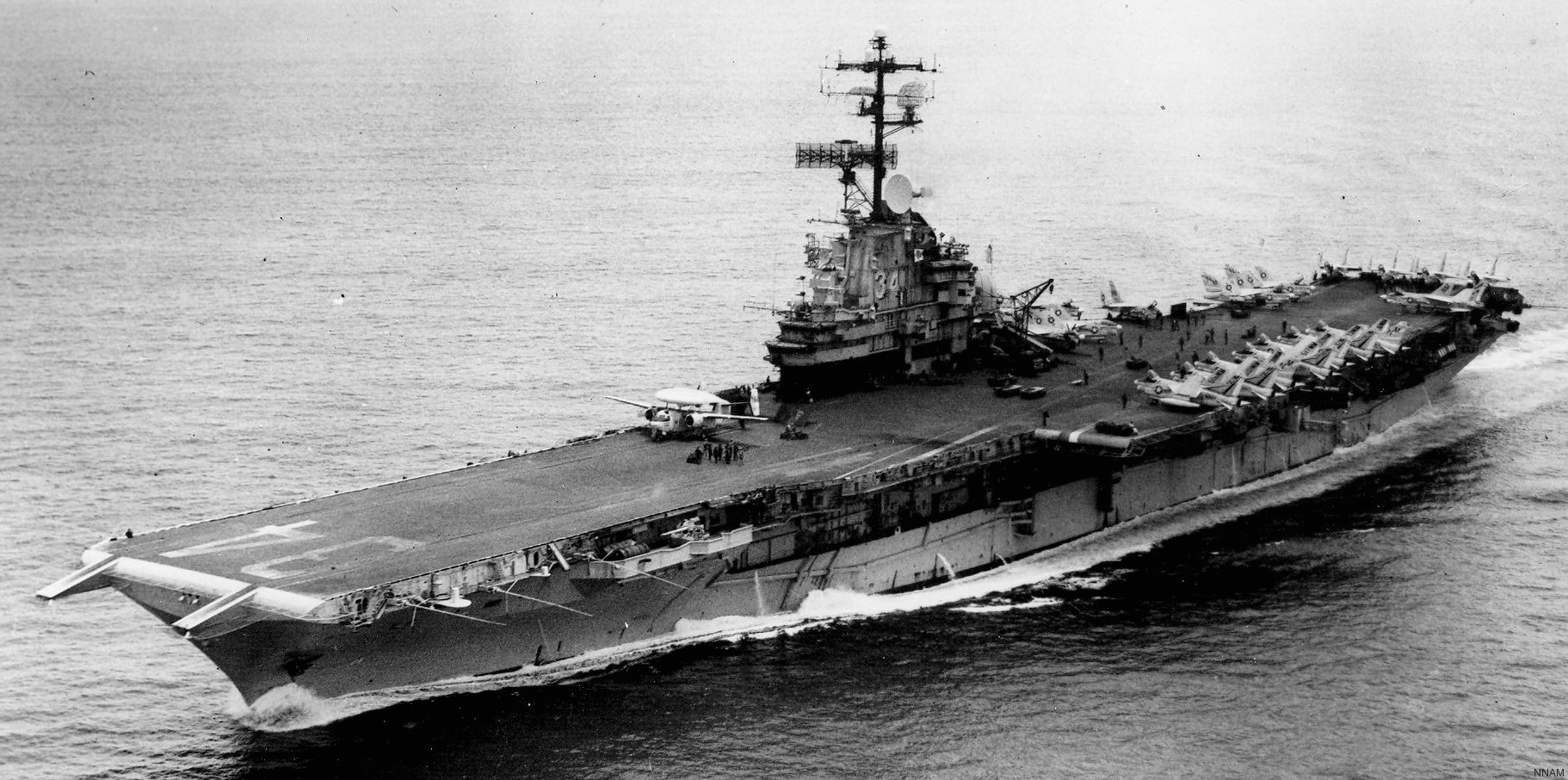 USS Oriskany (CVA 34) with Carrier Air Wing 19 (CVW-19) embarked - 1972  USS Oriskany (CVA 34) with Carrier Air Wing 19 (CVW-19) embarked - October 1970 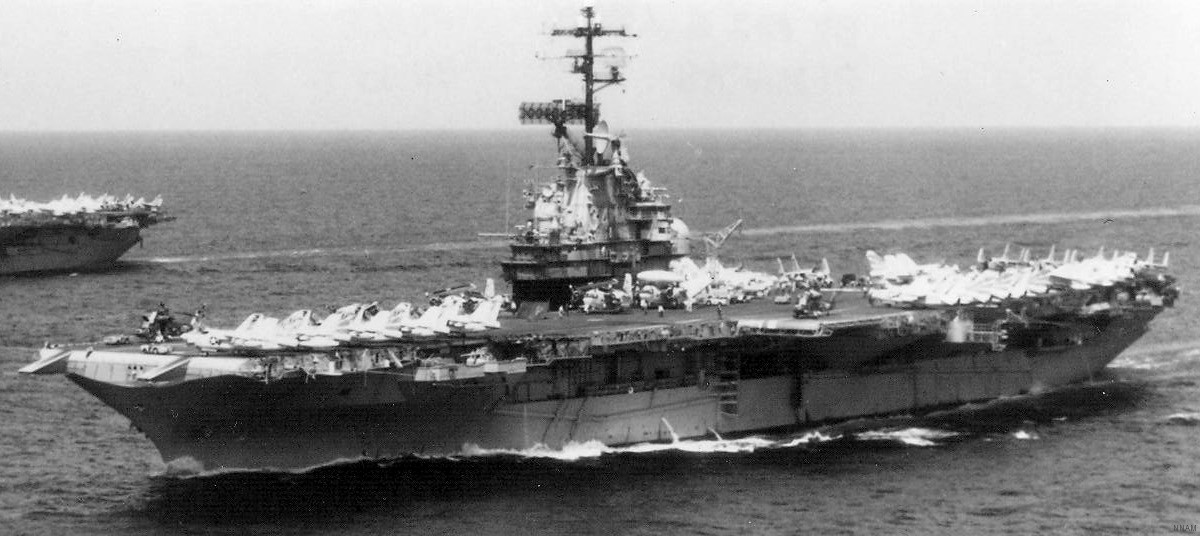 USS Oriskany (CVA 34) with Carrier Air Wing 19 (CVW-19) embarked - October 1970 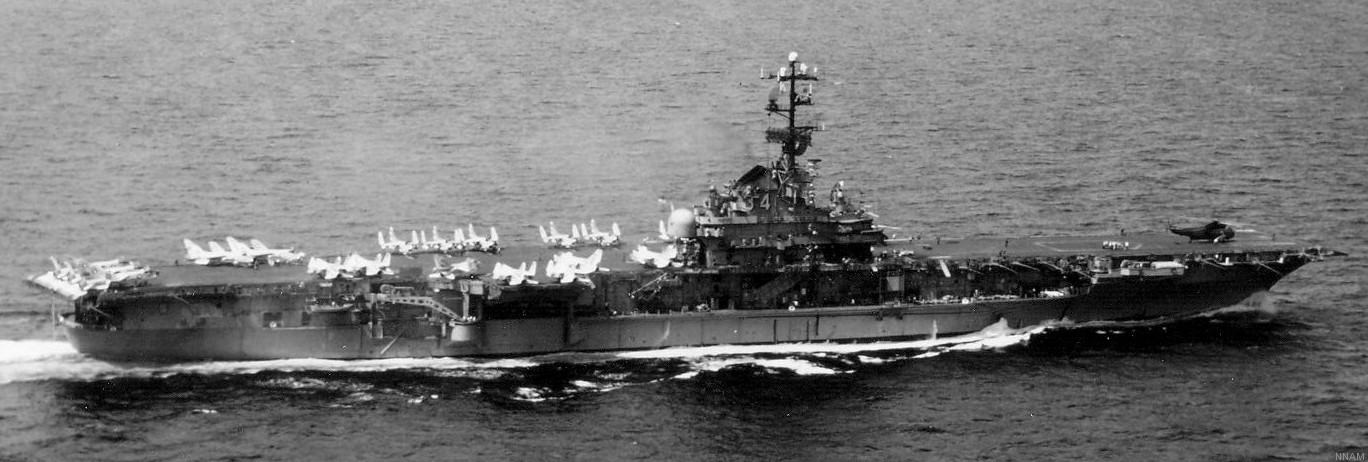 USS Oriskany (CVA 34) with Carrier Air Wing 19 (CVW-19) embarked - Gulf of Tonkin - August 1970 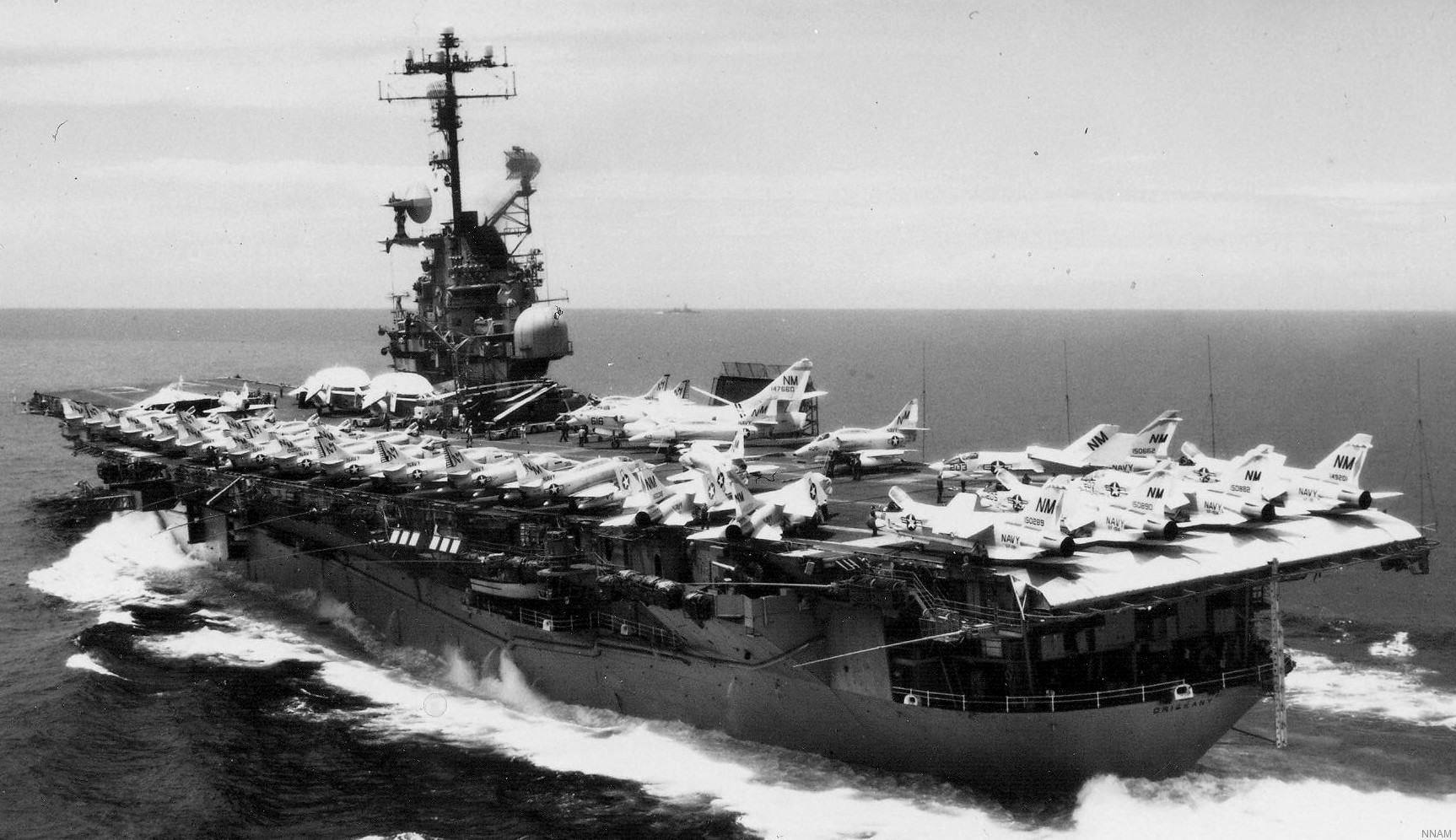 USS Oriskany (CVA 34) with Carrier Air Wing 19 (CVW-19) embarked - July 1969 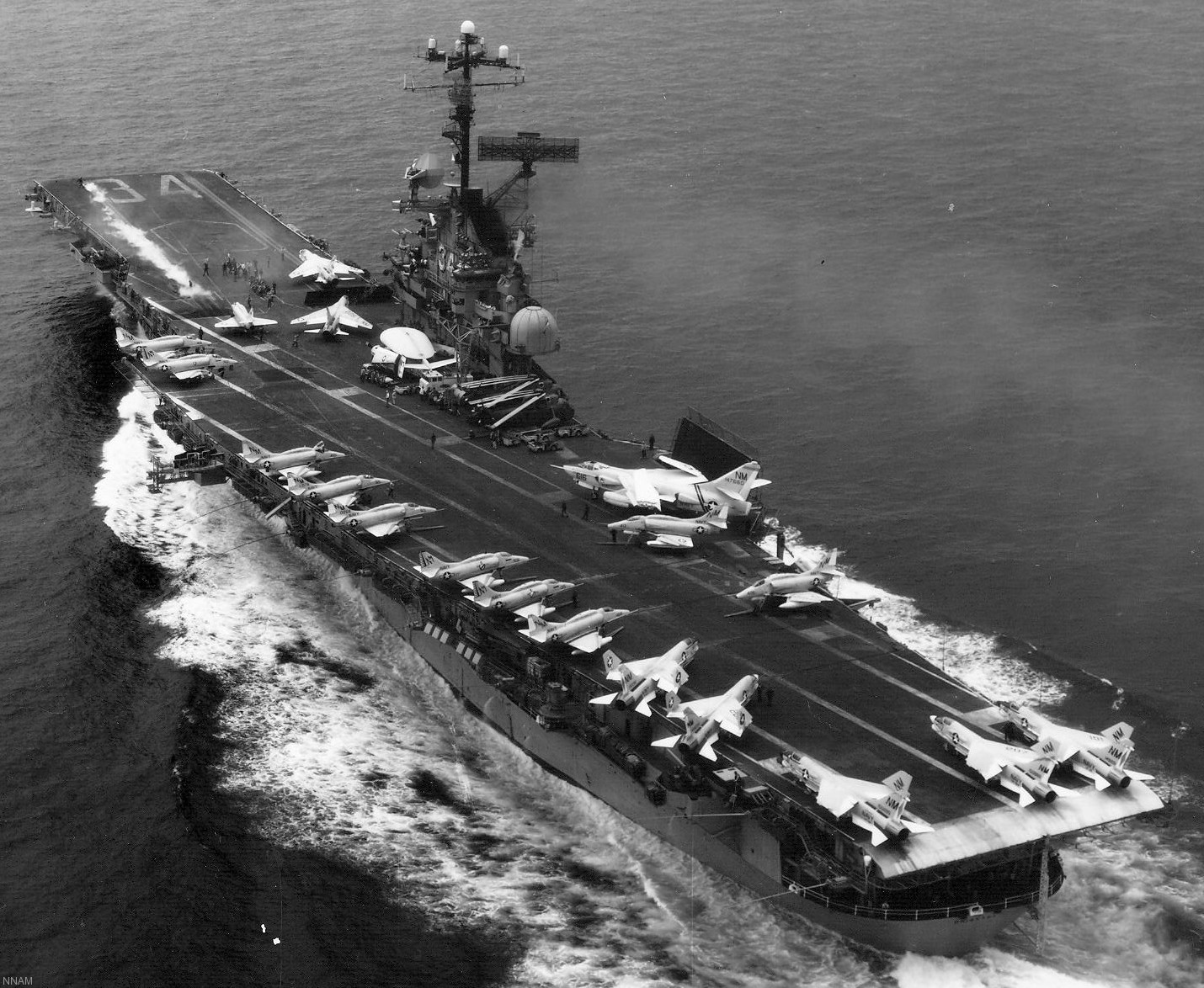 USS Oriskany (CVA 34) with Carrier Air Wing 19 (CVW-19) embarked - July 1969 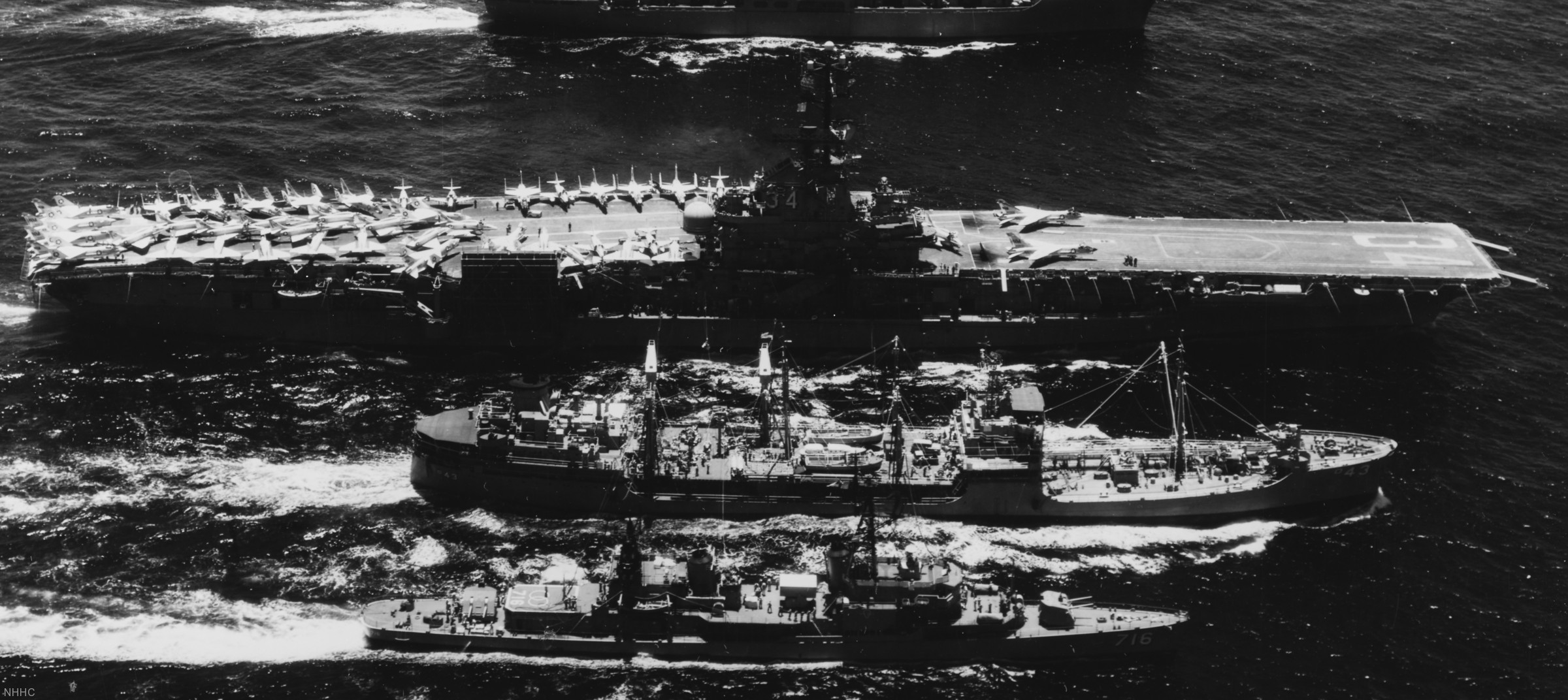 USS Oriskany (CVA 34) with Carrier Air Wing 19 (CVW-19) embarked - May 1969 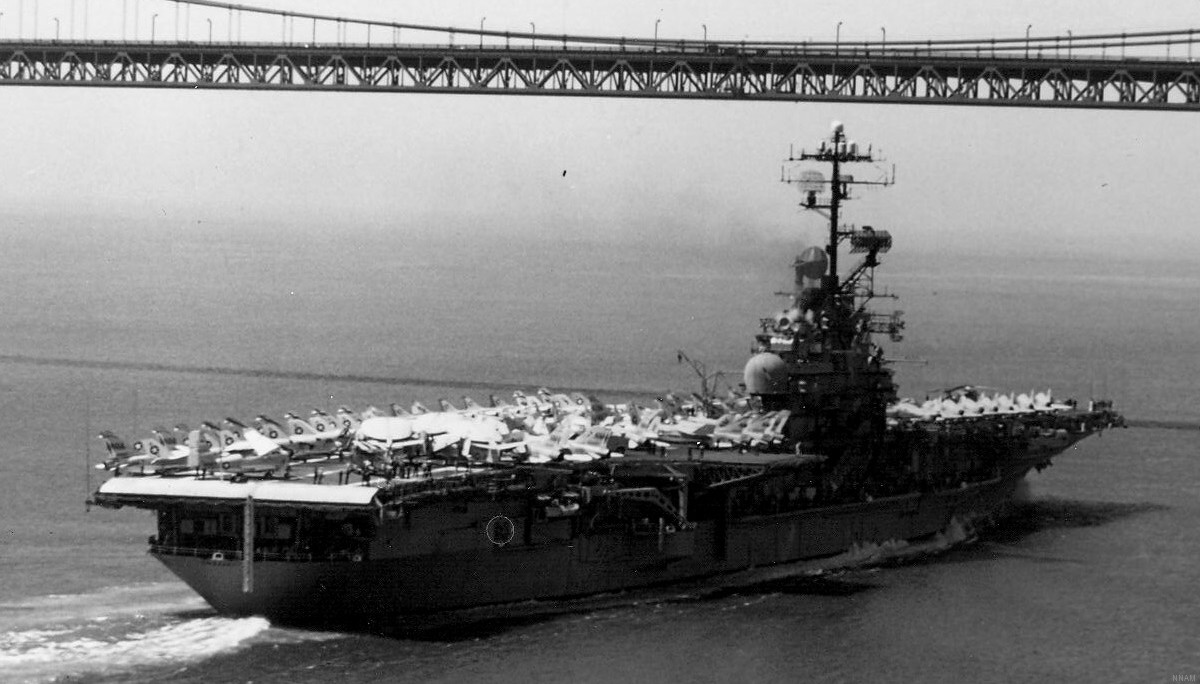 USS Oriskany (CVA 34) with Carrier Air Wing 19 (CVW-19) embarked - San Francisco - April 1969 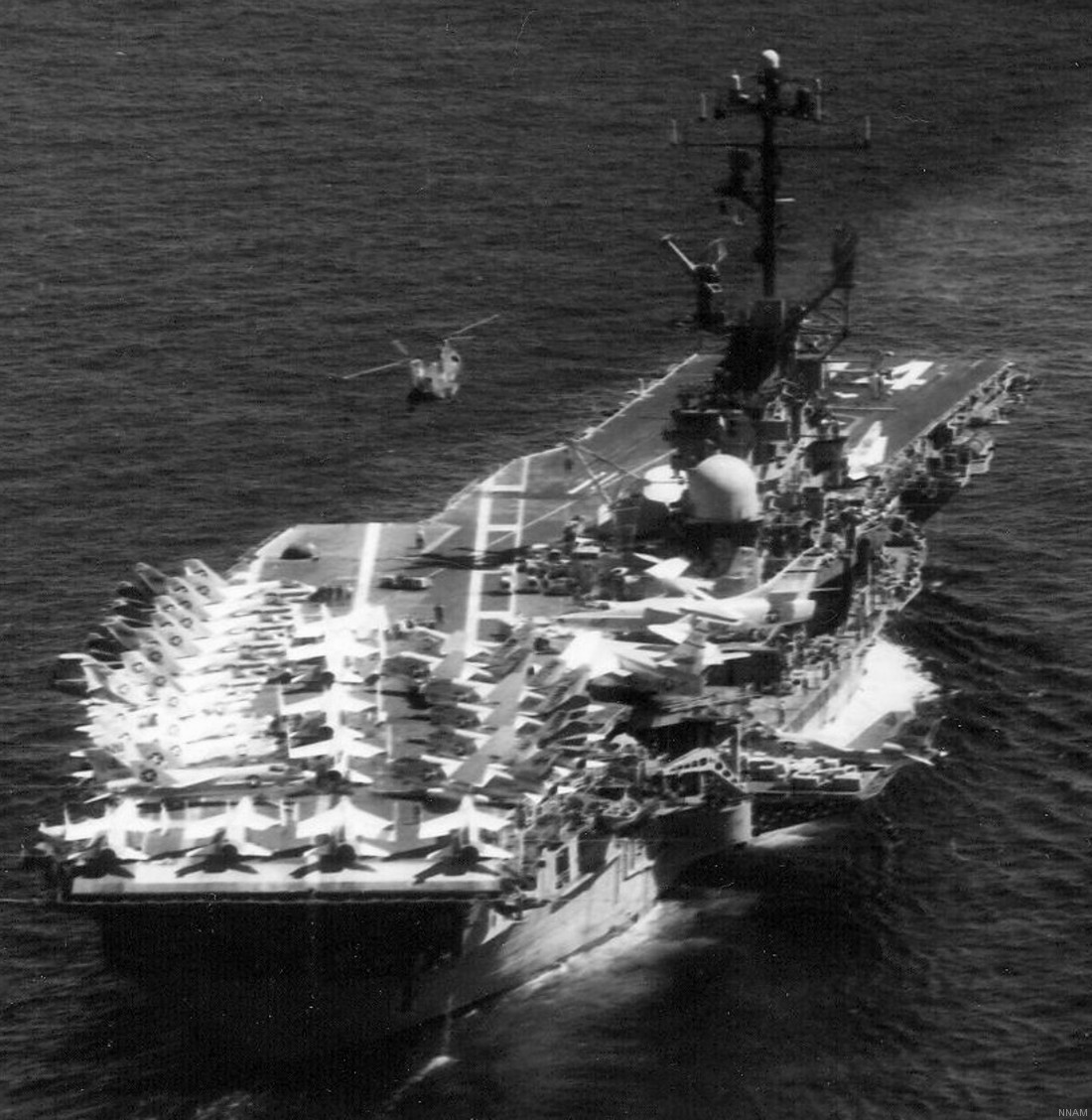 USS Oriskany (CVA 34) with Carrier Air Wing 19 (CVW-19) embarked - late 1960's 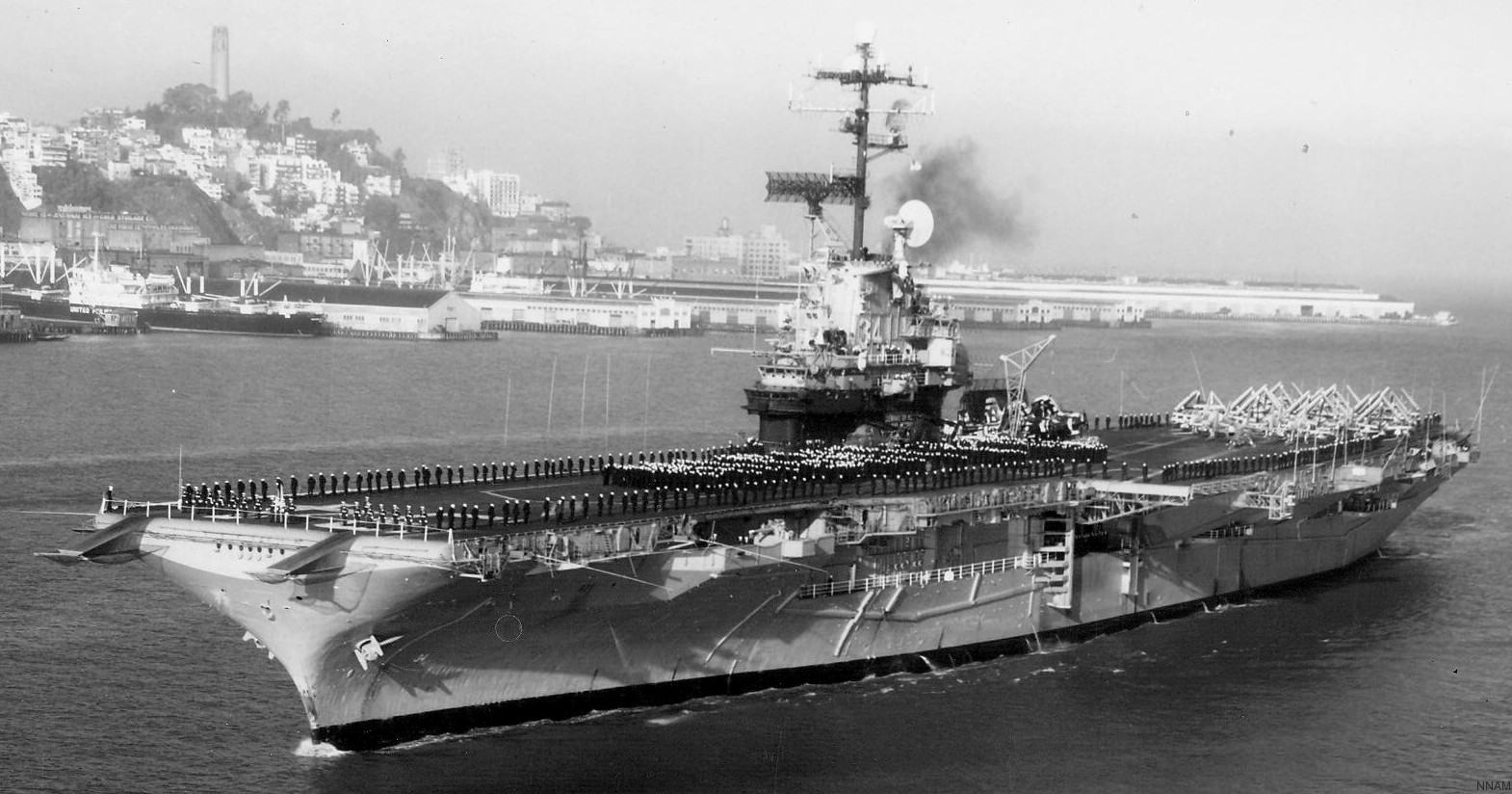 USS Oriskany (CVA 34) returning from a Vietnam War deployment - January 1968 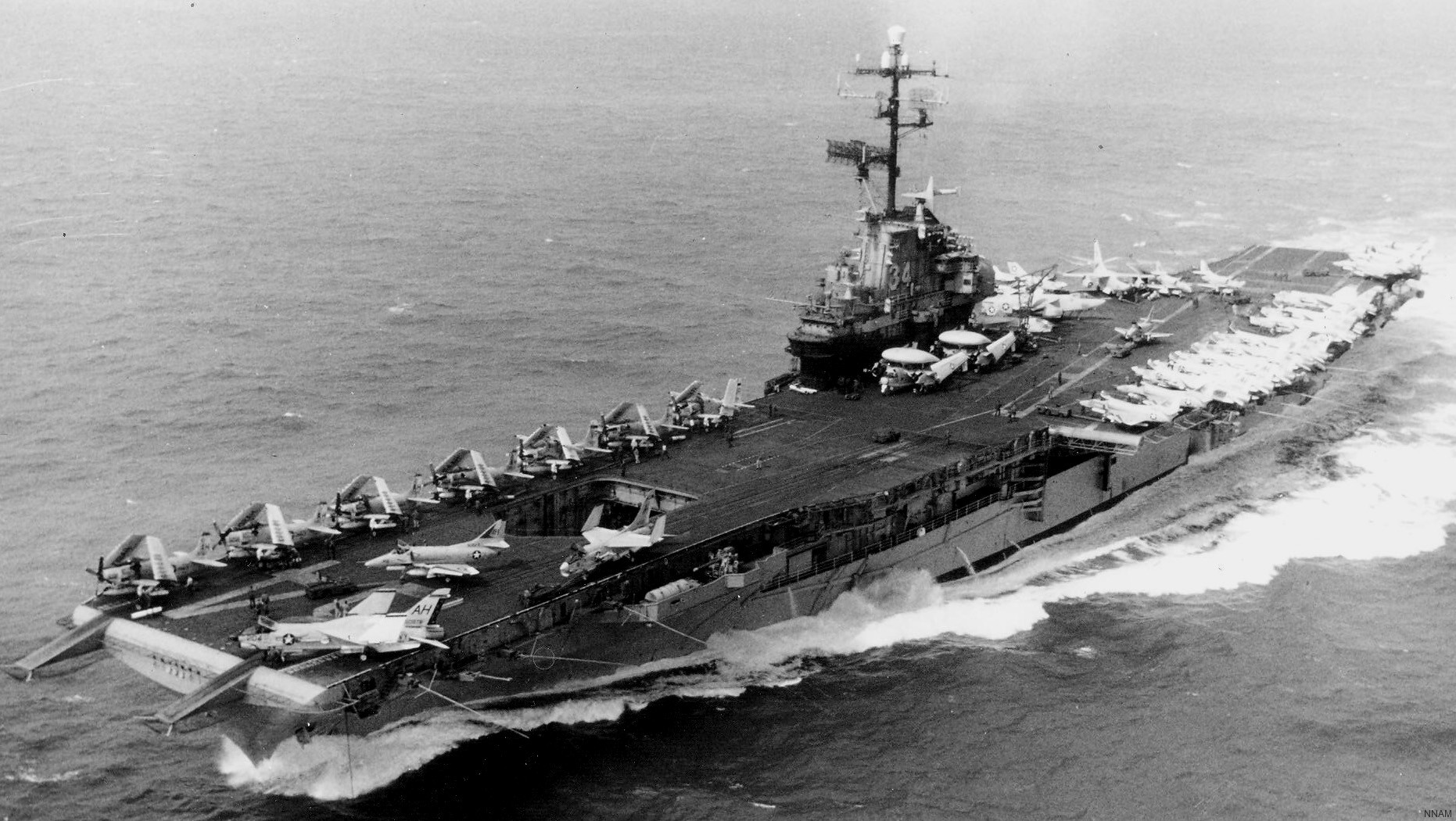 USS Oriskany (CVA 34) with Carrier Air Wing 16 (CVW-16) embarked - January 1968 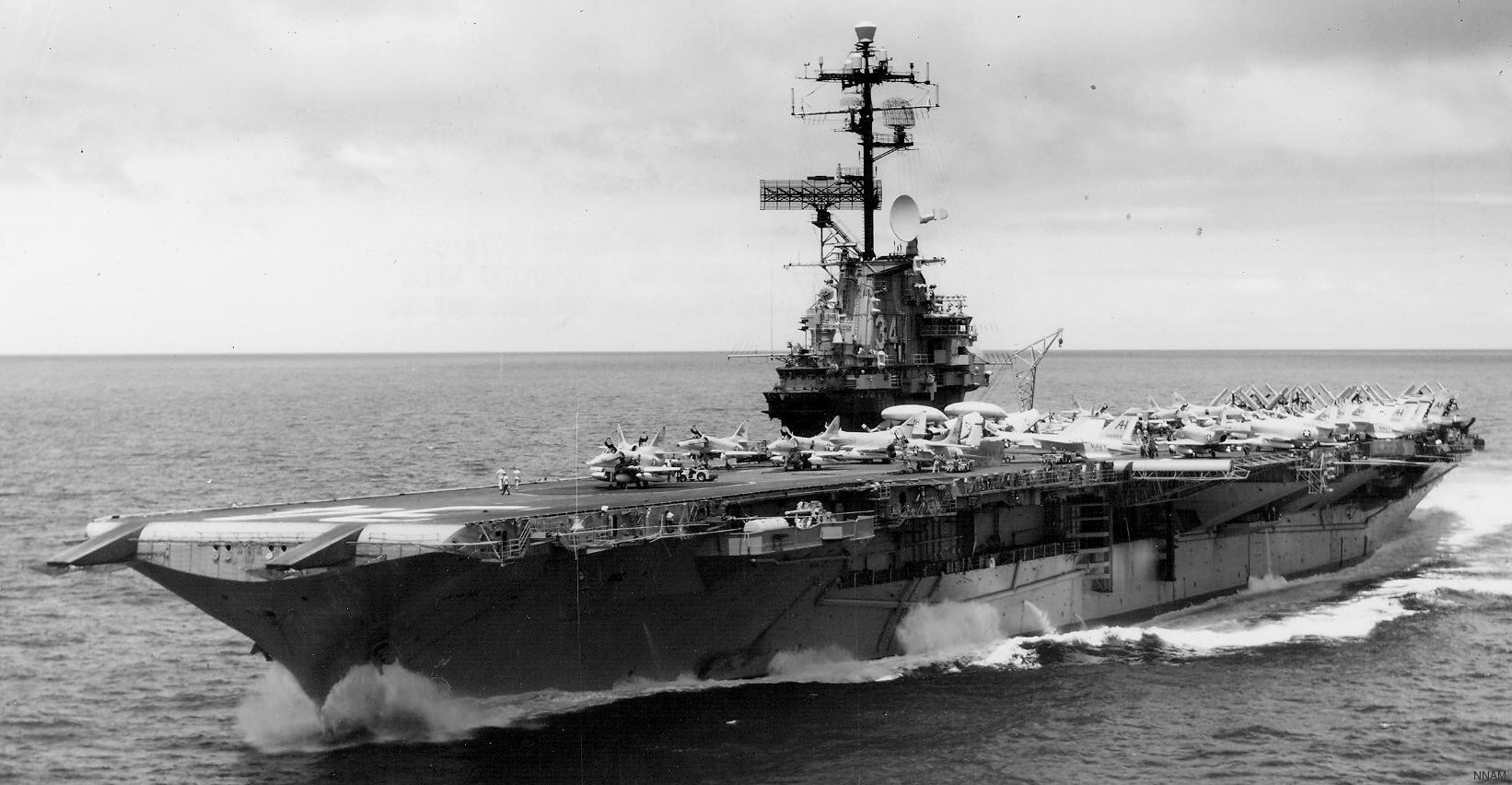 USS Oriskany (CVA 34) with Carrier Air Wing 16 (CVW-16) embarked - June 1967 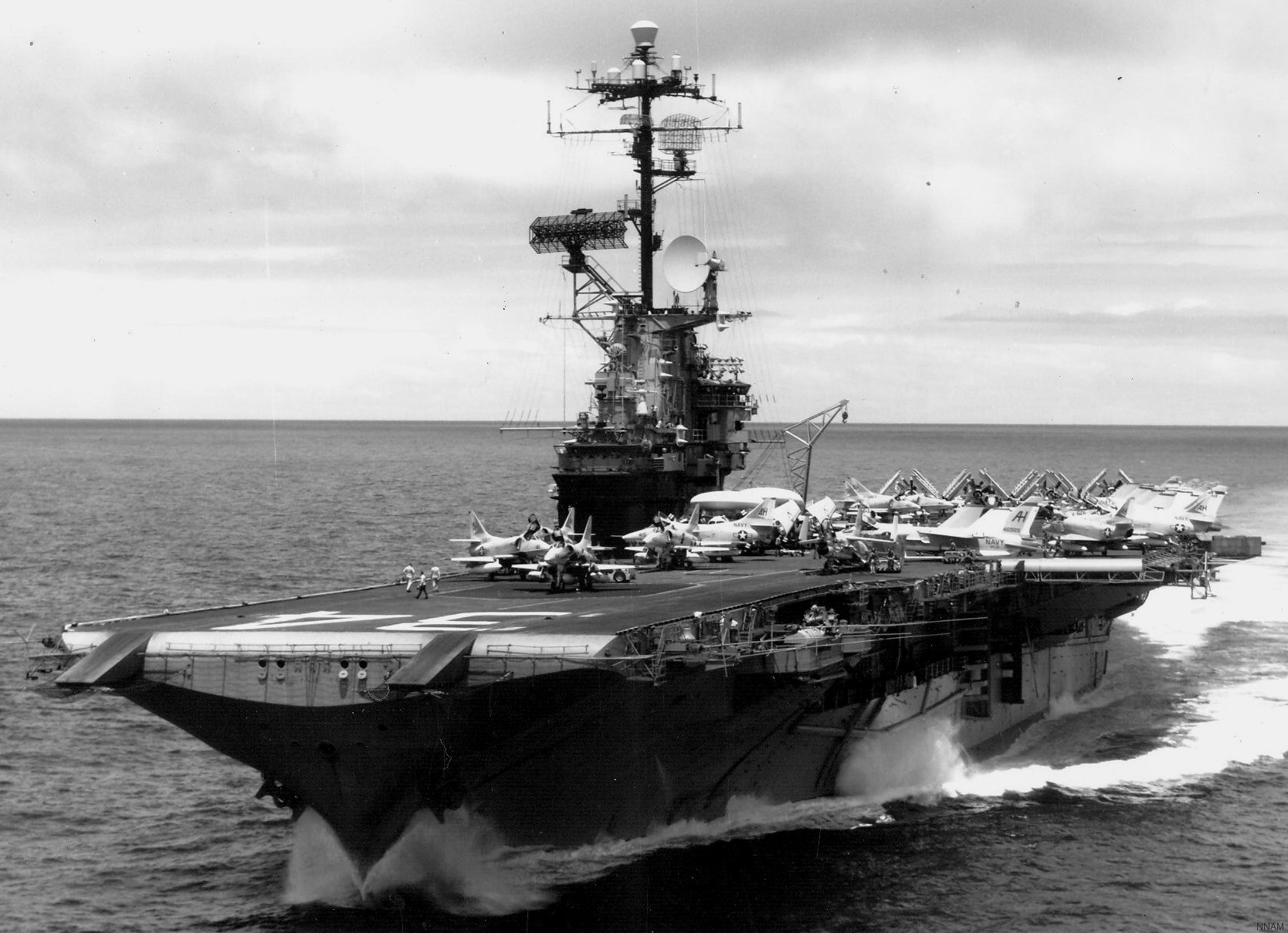 USS Oriskany (CVA 34) with Carrier Air Wing 16 (CVW-16) embarked - June 1967 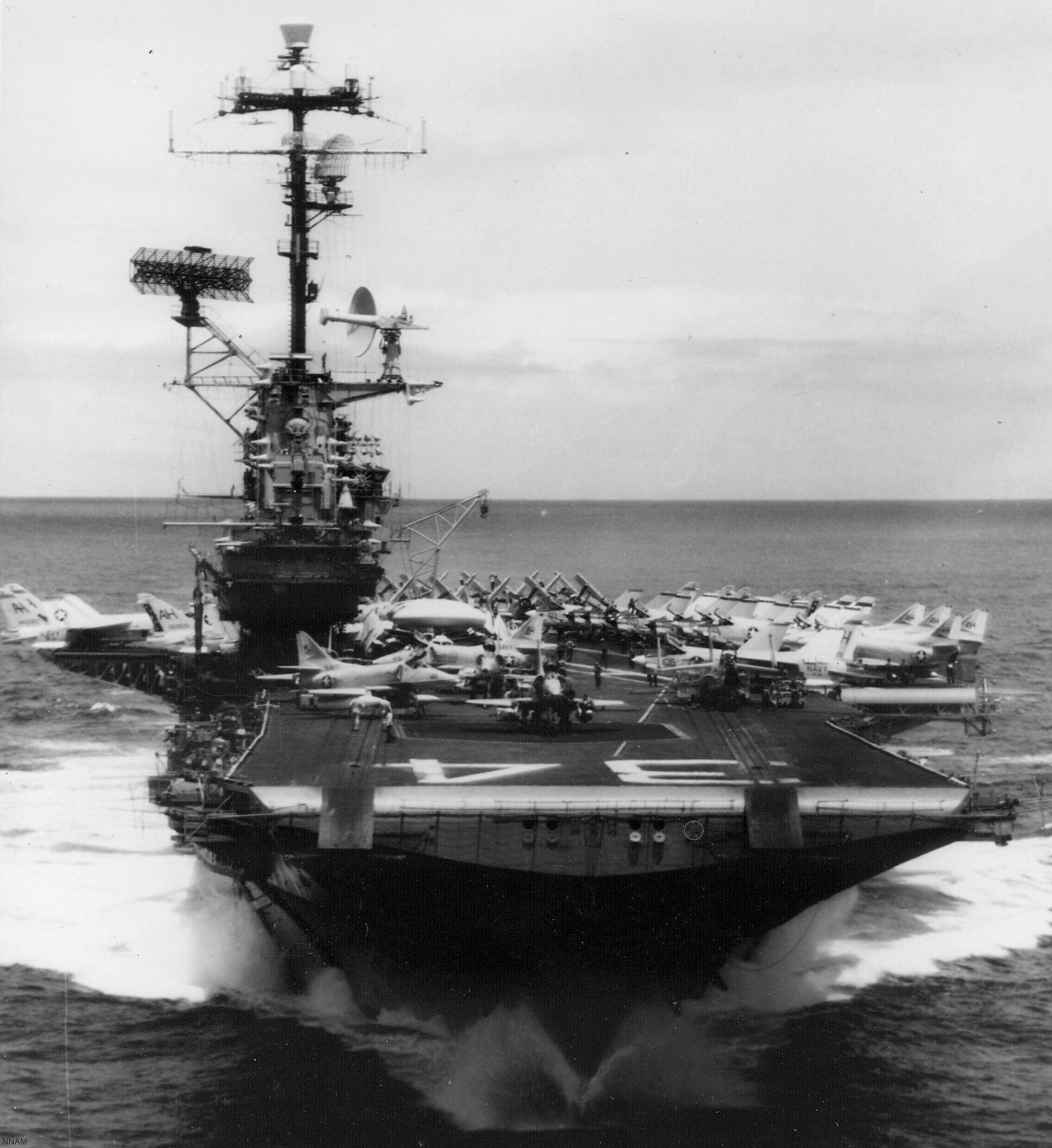 USS Oriskany (CVA 34) with Carrier Air Wing 16 (CVW-16) embarked - 1967 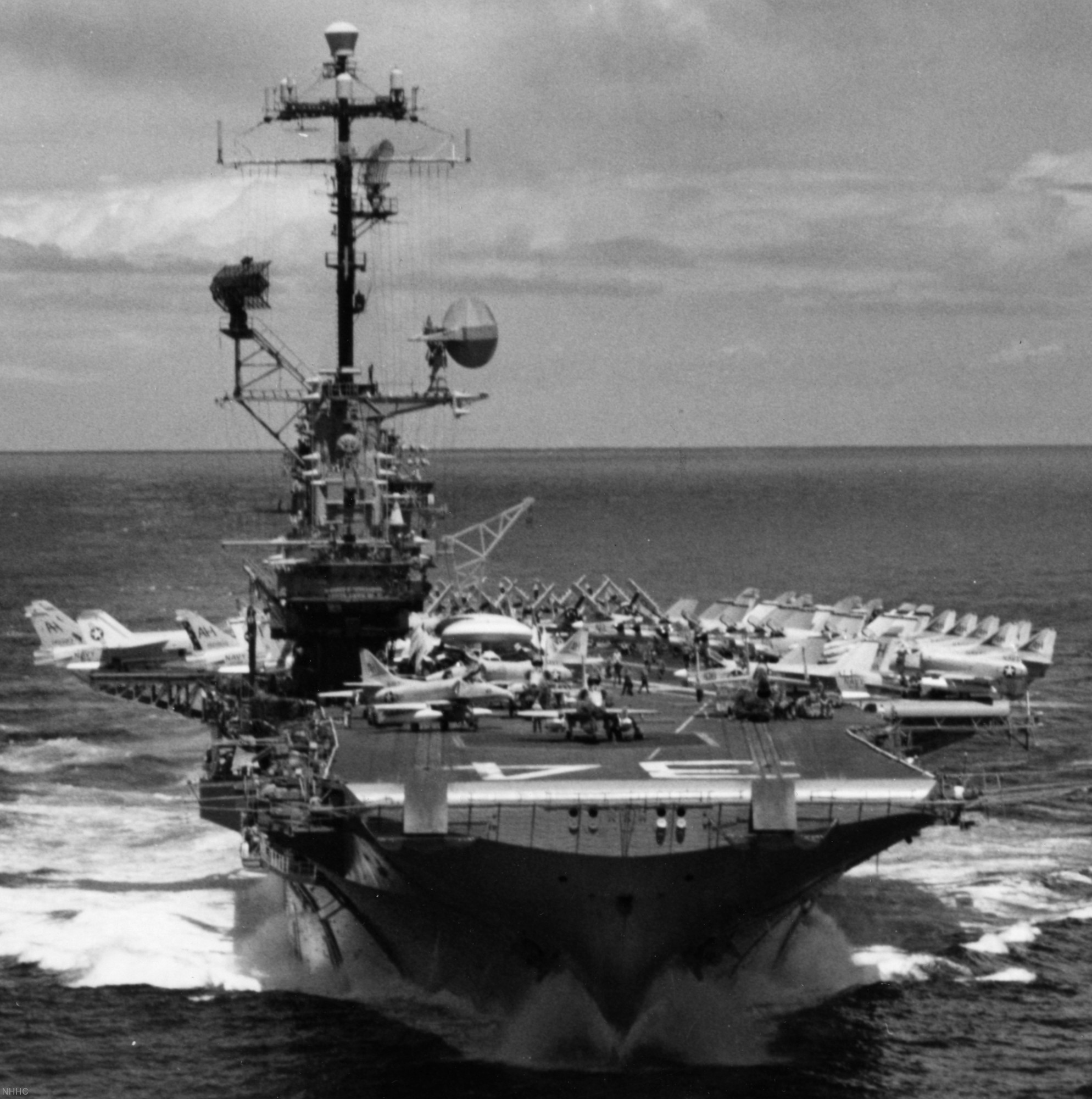 USS Oriskany (CVA 34) with Carrier Air Wing 16 (CVW-16) embarked - 1967 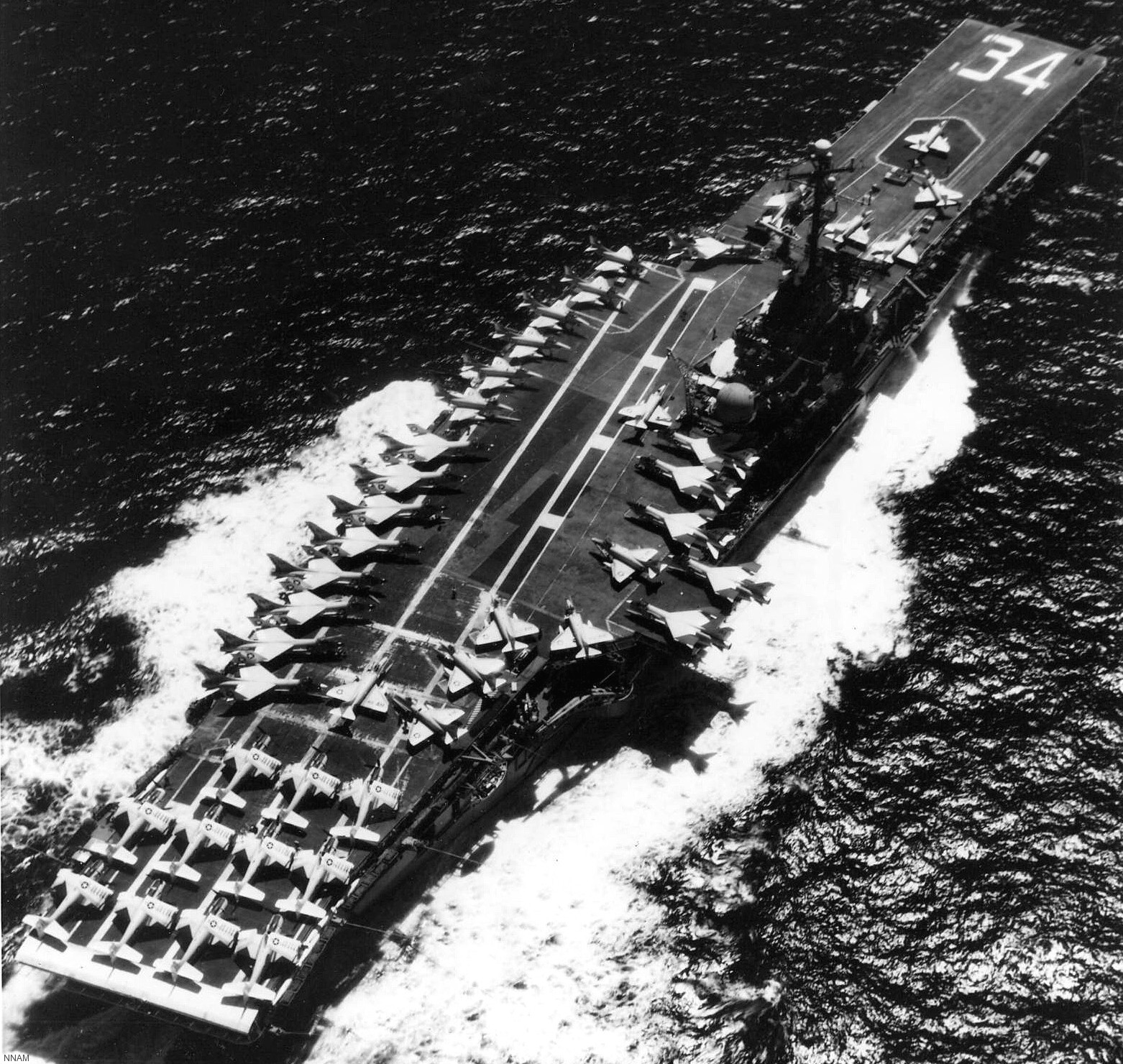 USS Oriskany (CVA 34) with Carrier Air Wing 16 (CVW-16) embarked - 1967 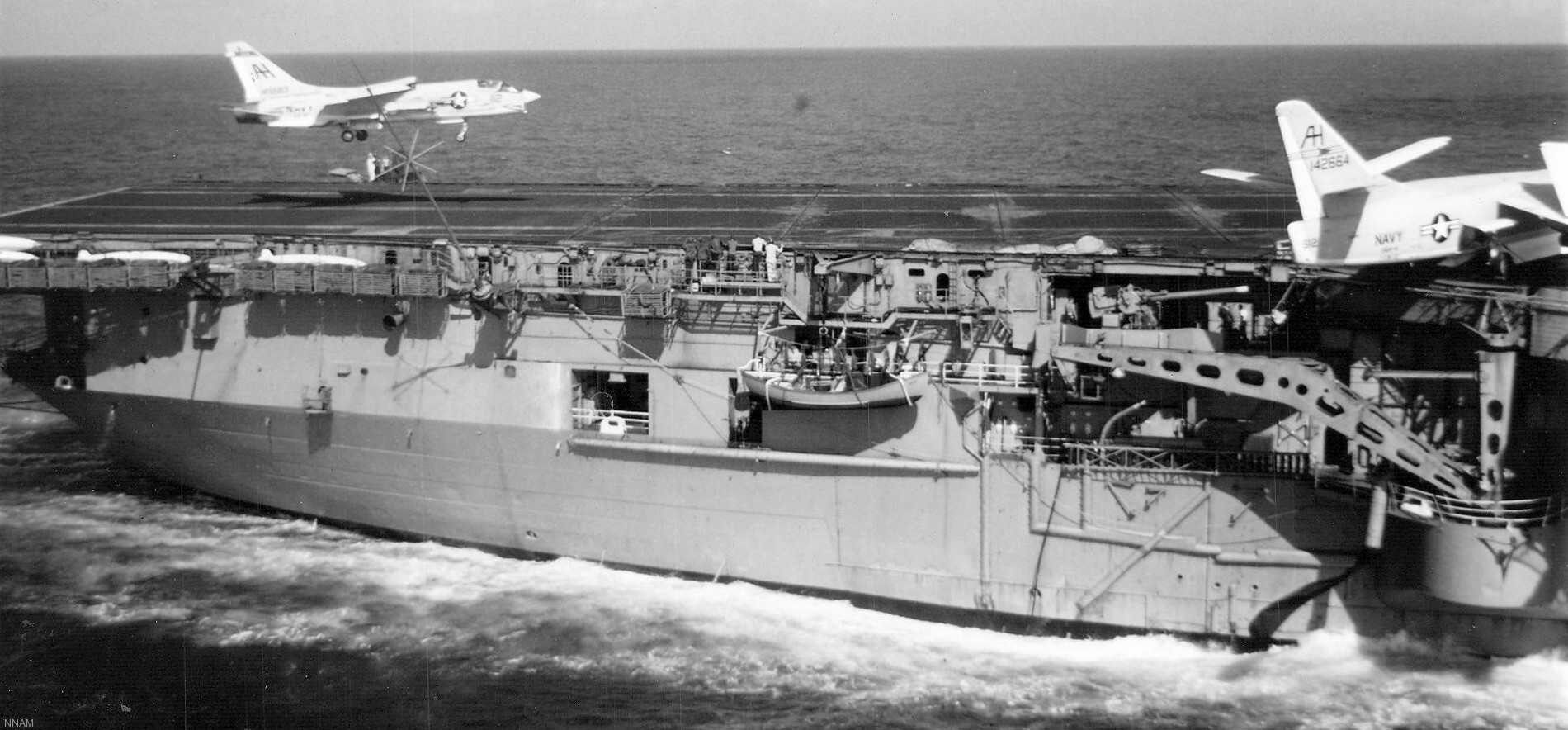 USS Oriskany (CVA 34) with Carrier Air Wing 16 (CVW-16) embarked - 1967 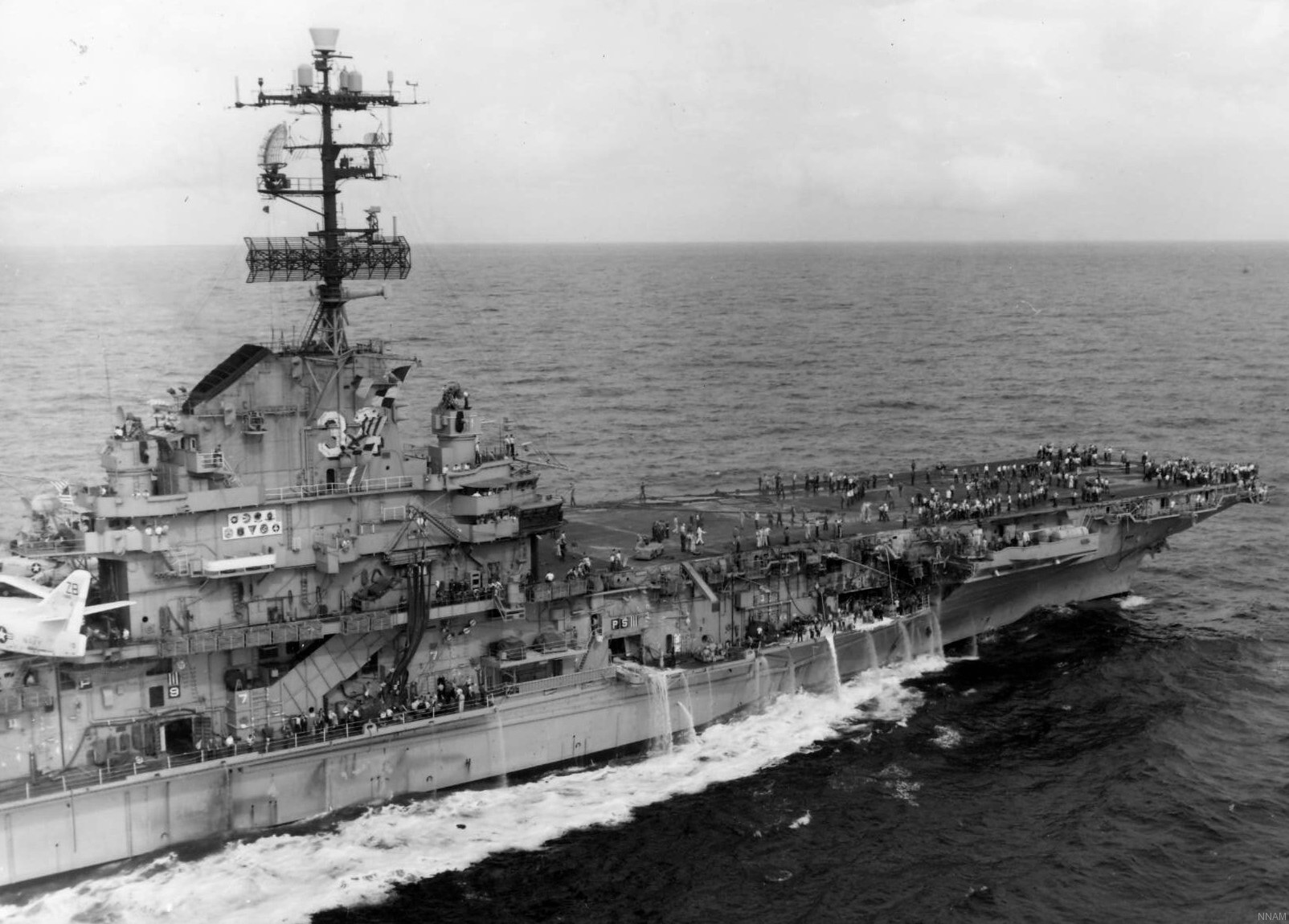 USS Oriskany (CVA 34) with Carrier Air Wing 16 (CVW-16) embarked - October 1966 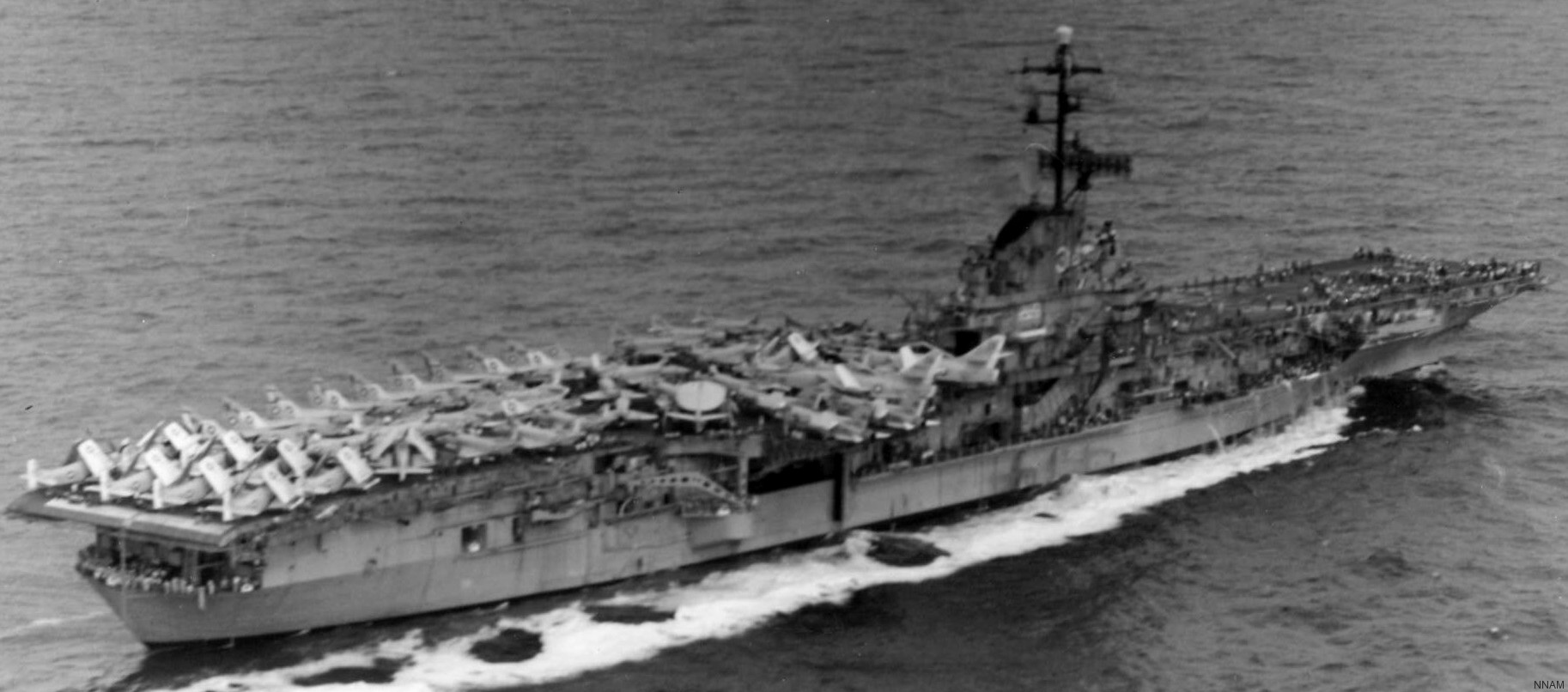 USS Oriskany (CVA 34) with Carrier Air Wing 16 (CVW-16) embarked - October 1966 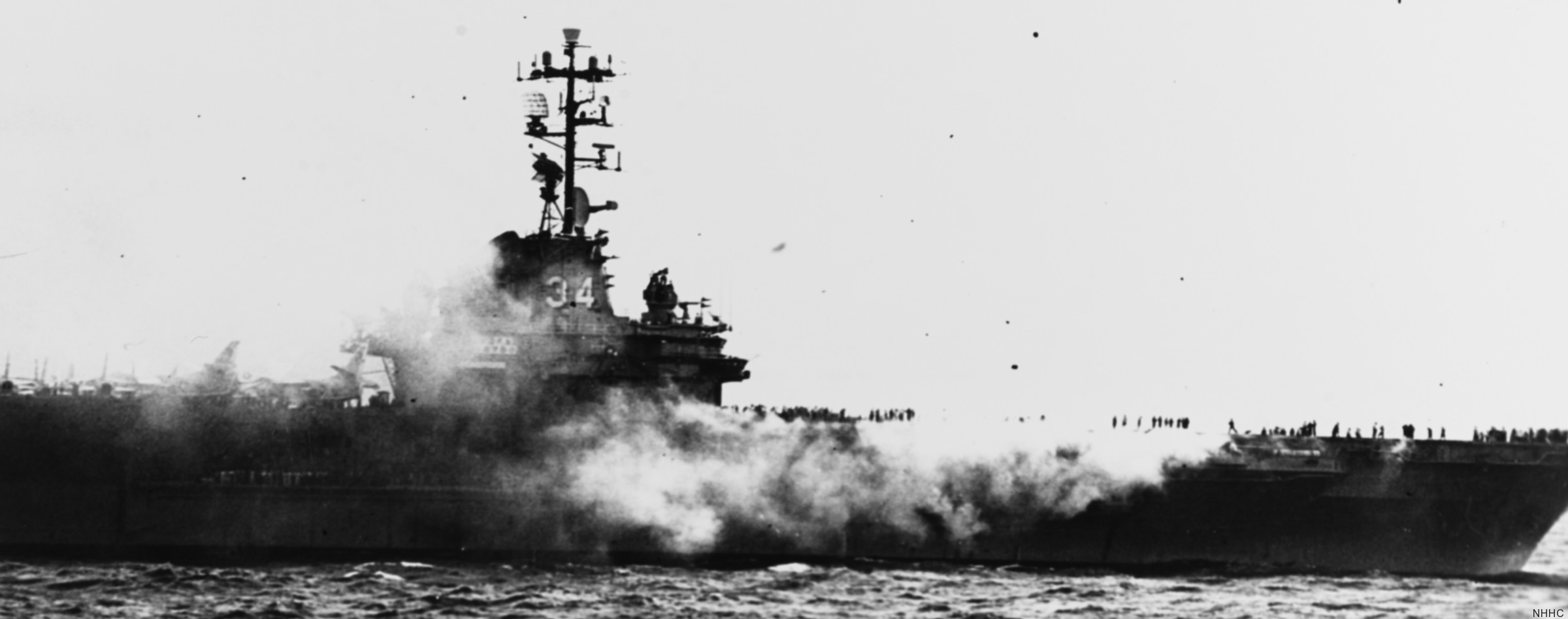 a major fire broke out aboard USS Oriskany on 26 October 1966 after a lit flare was locked in a flare locker. The fire killed 44 people and injured 156 more 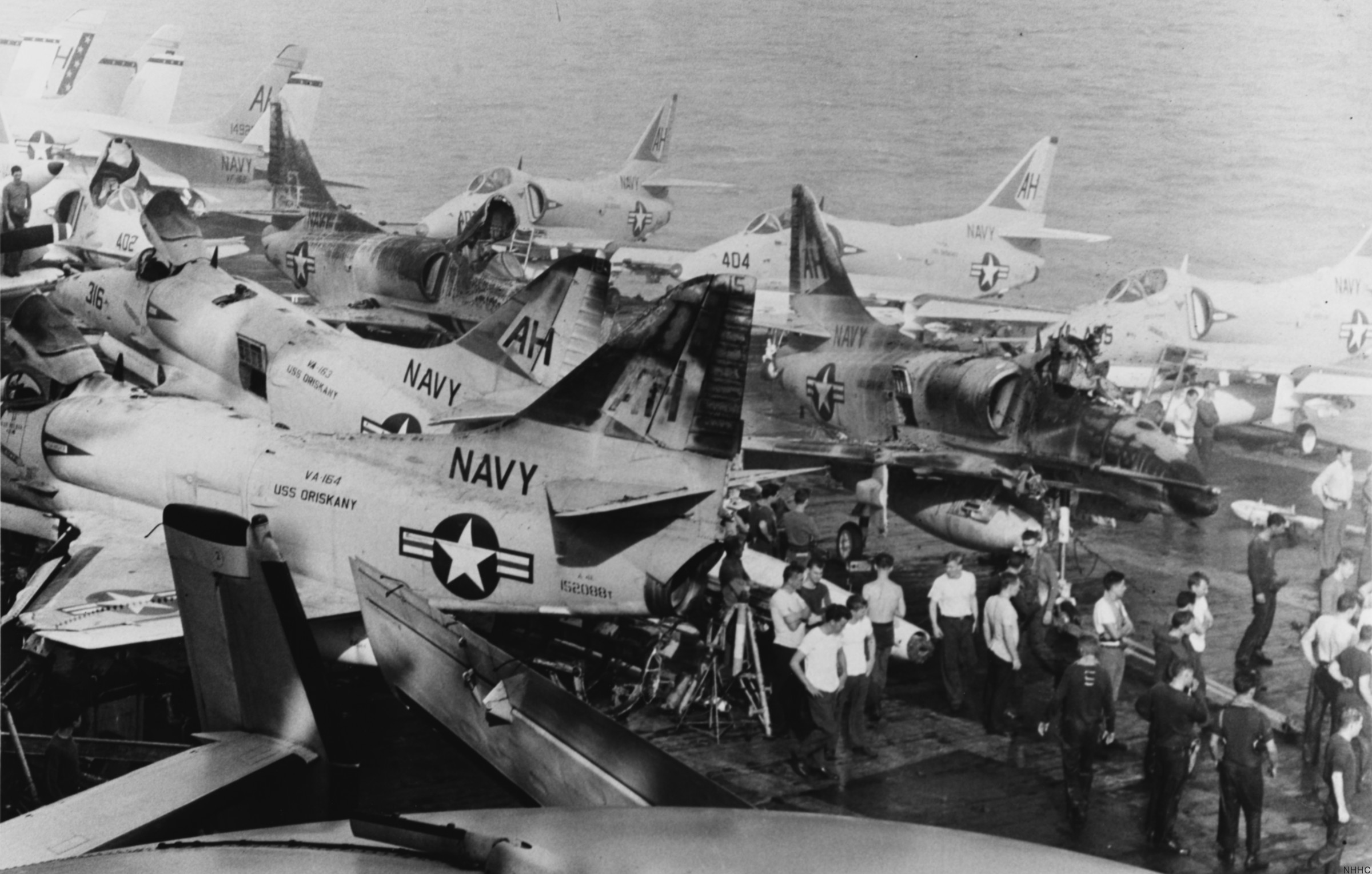 a major fire broke out aboard USS Oriskany on 26 October 1966 after a lit flare was locked in a flare locker. The fire killed 44 people and injured 156 more 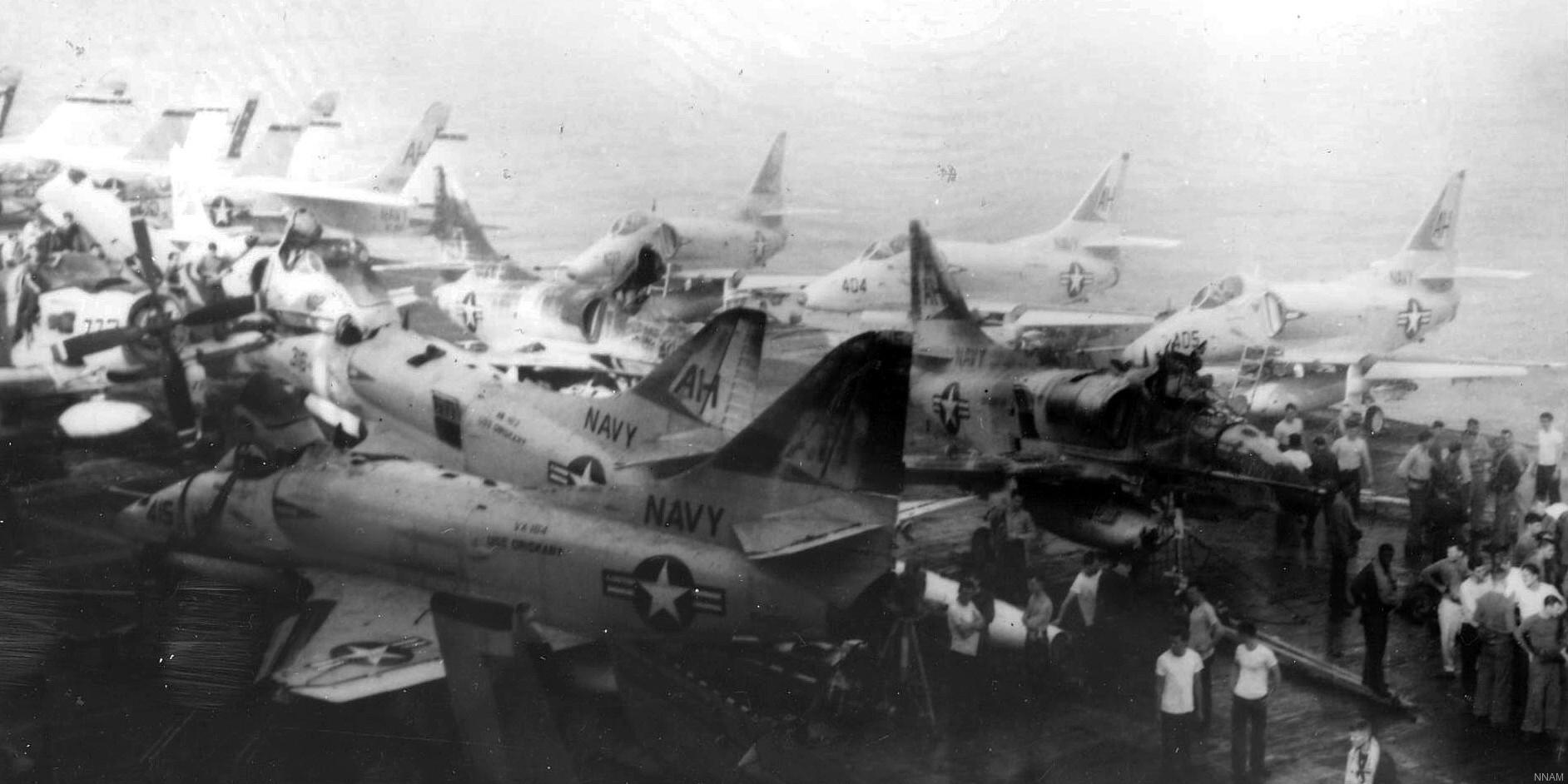 USS
Oriskany (CVA 34) with Carrier Air Wing 16 (CVW-16) embarked -
October 1966 USS
Oriskany (CVA 34) with Carrier Air Wing 16 (CVW-16) embarked -
October 1966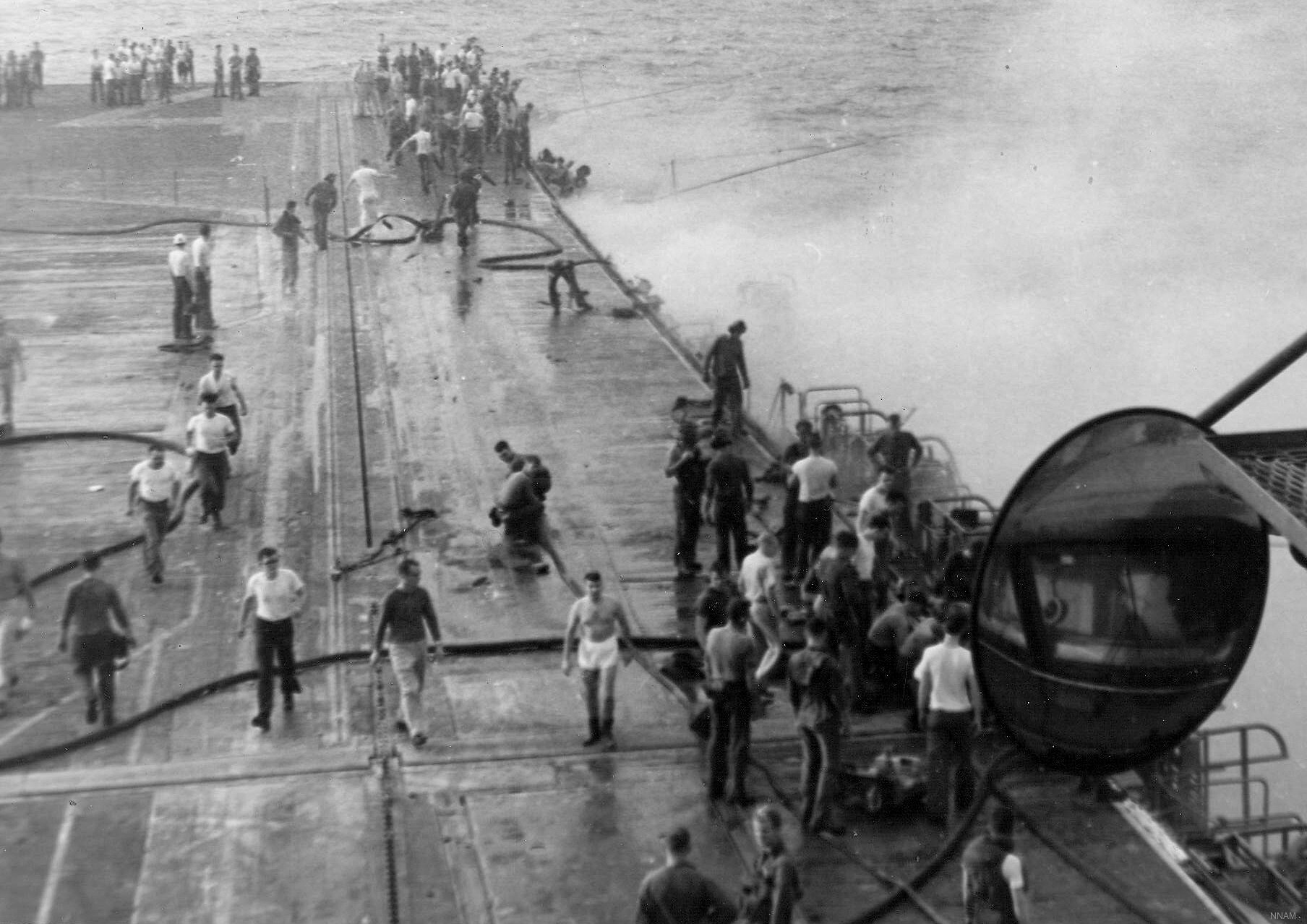 USS Oriskany (CVA 34) with Carrier Air Wing 16 (CVW-16) embarked - October 1966 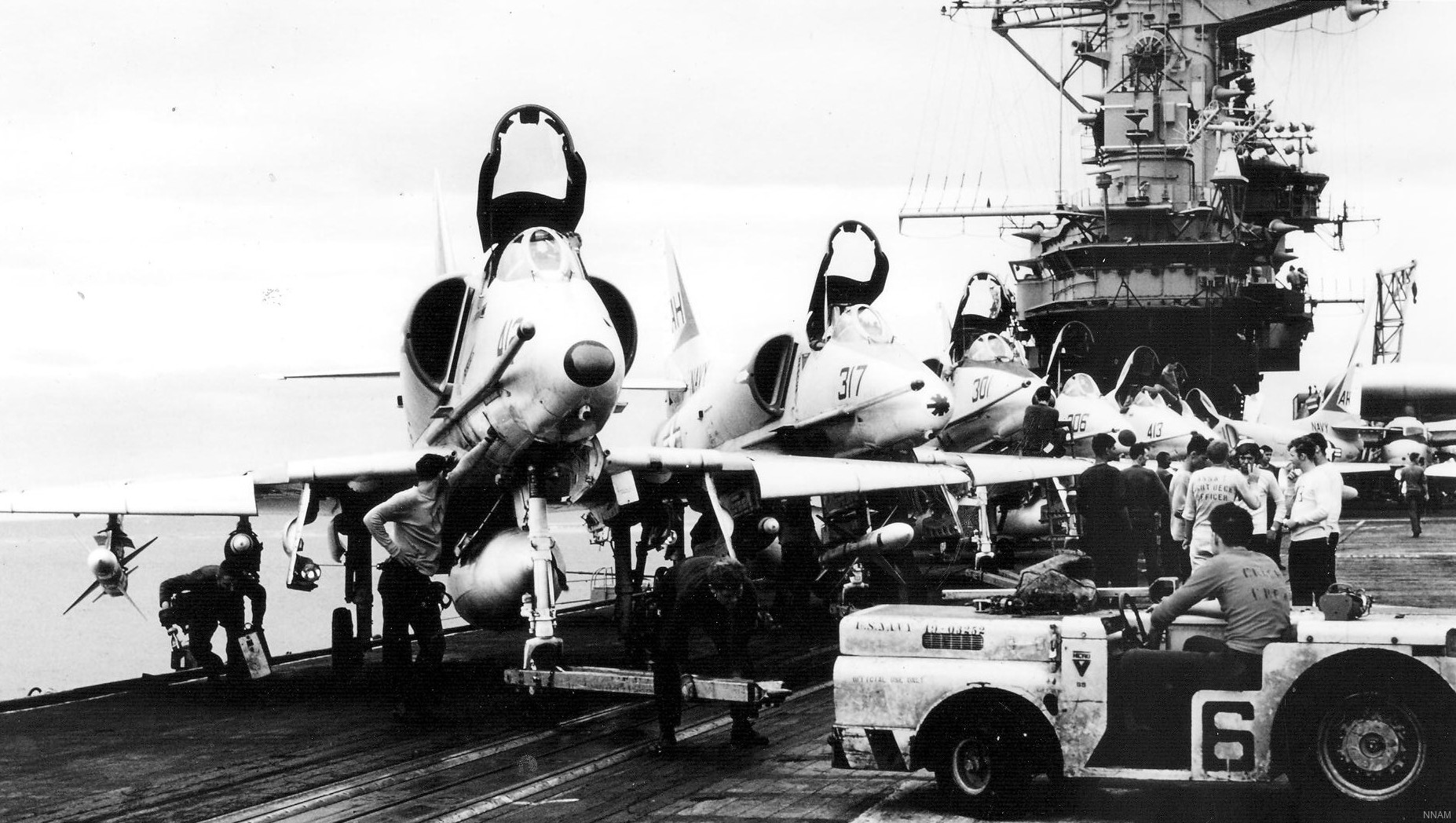 USS Oriskany (CVA 34) with Carrier Air Wing 16 (CVW-16) embarked - September 1966 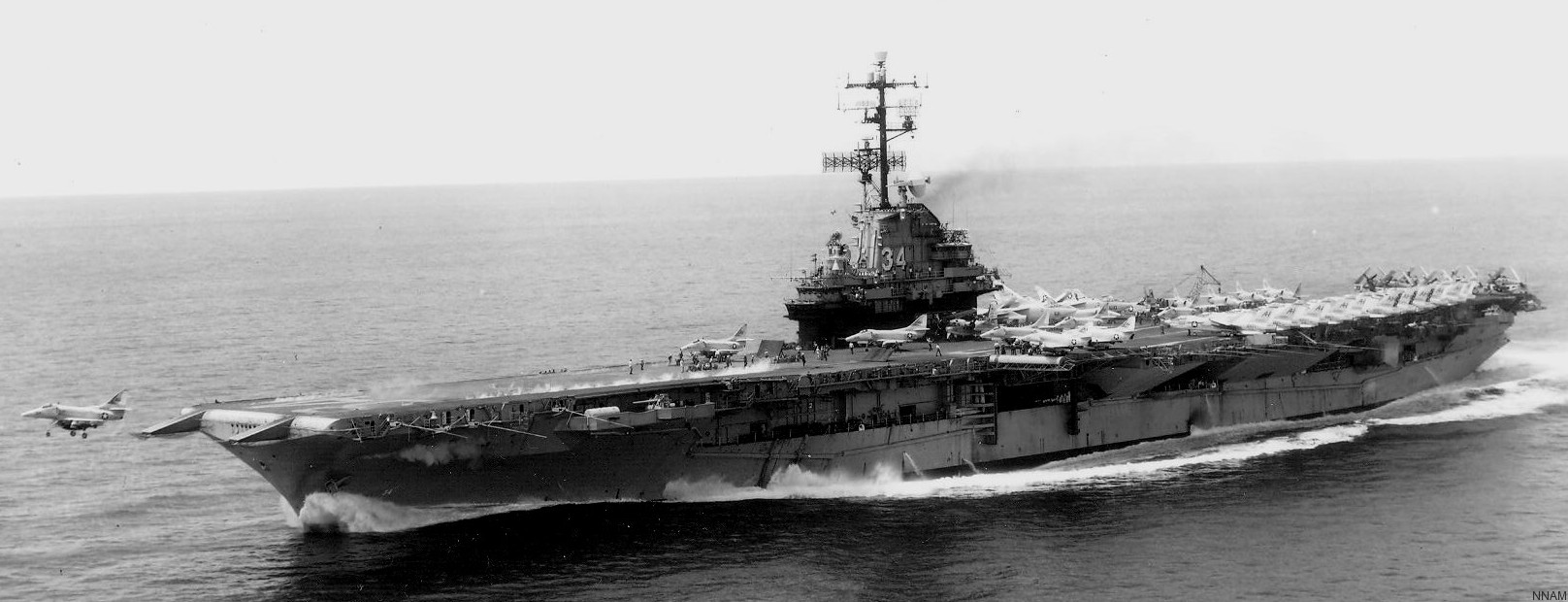 USS Oriskany (CVA 34) with Carrier Air Wing 16 (CVW-16) embarked - August 1966 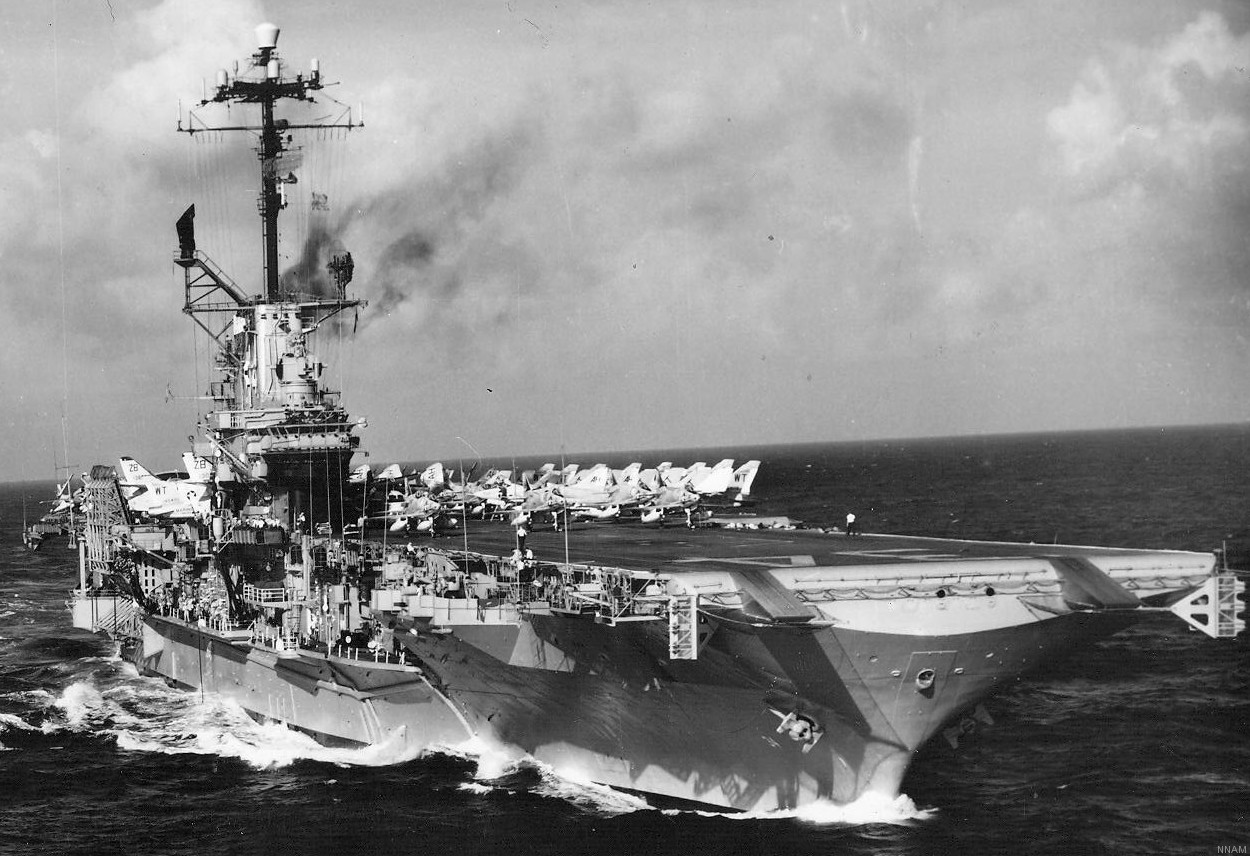 USS Oriskany (CVA 34) with Carrier Air Wing 16 (CVW-16) embarked - April 1966 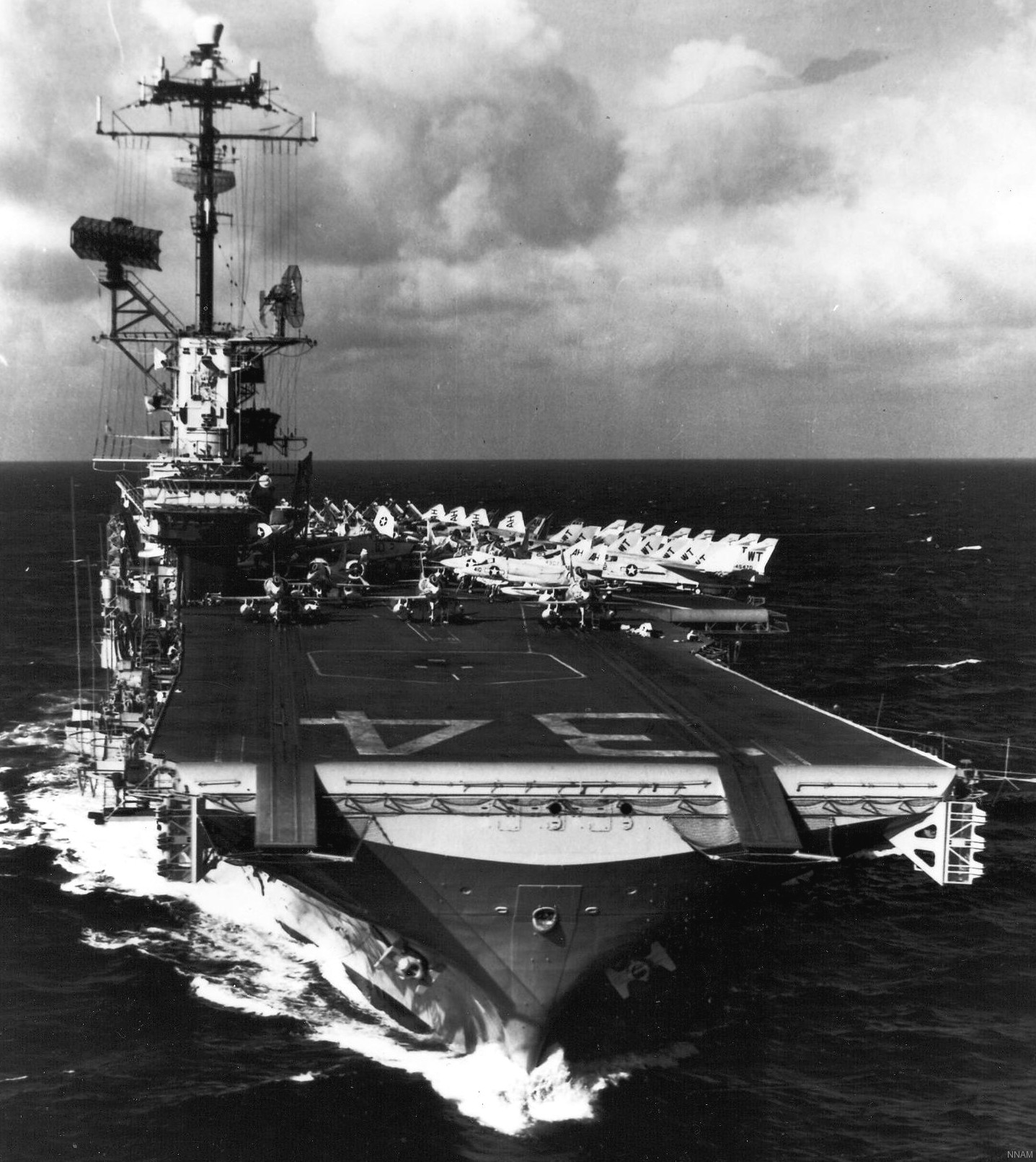 USS Oriskany (CVA 34) with Carrier Air Wing 16 (CVW-16) embarked - May 1965 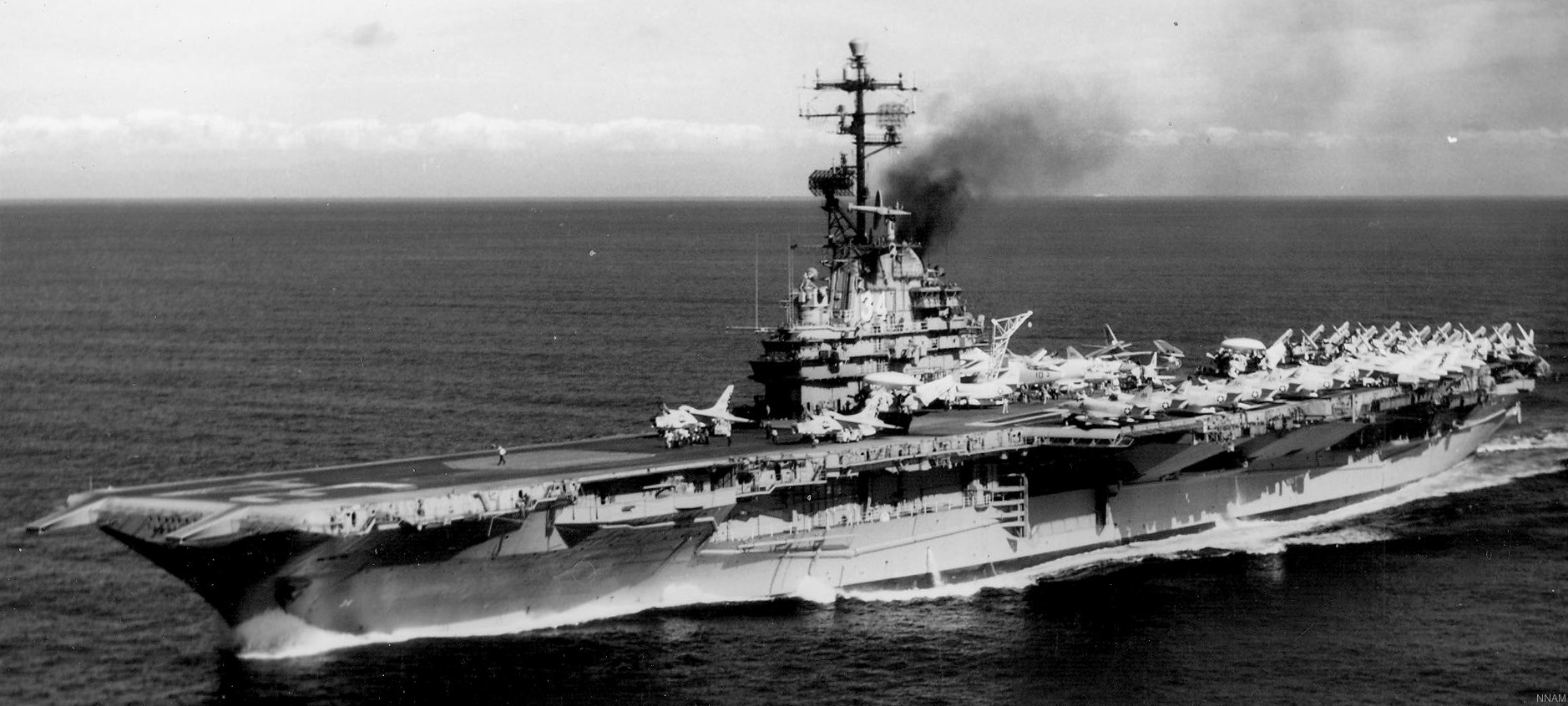 USS Oriskany (CVA 34) with Carrier Air Wing 16 (CVW-16) embarked - January 1965 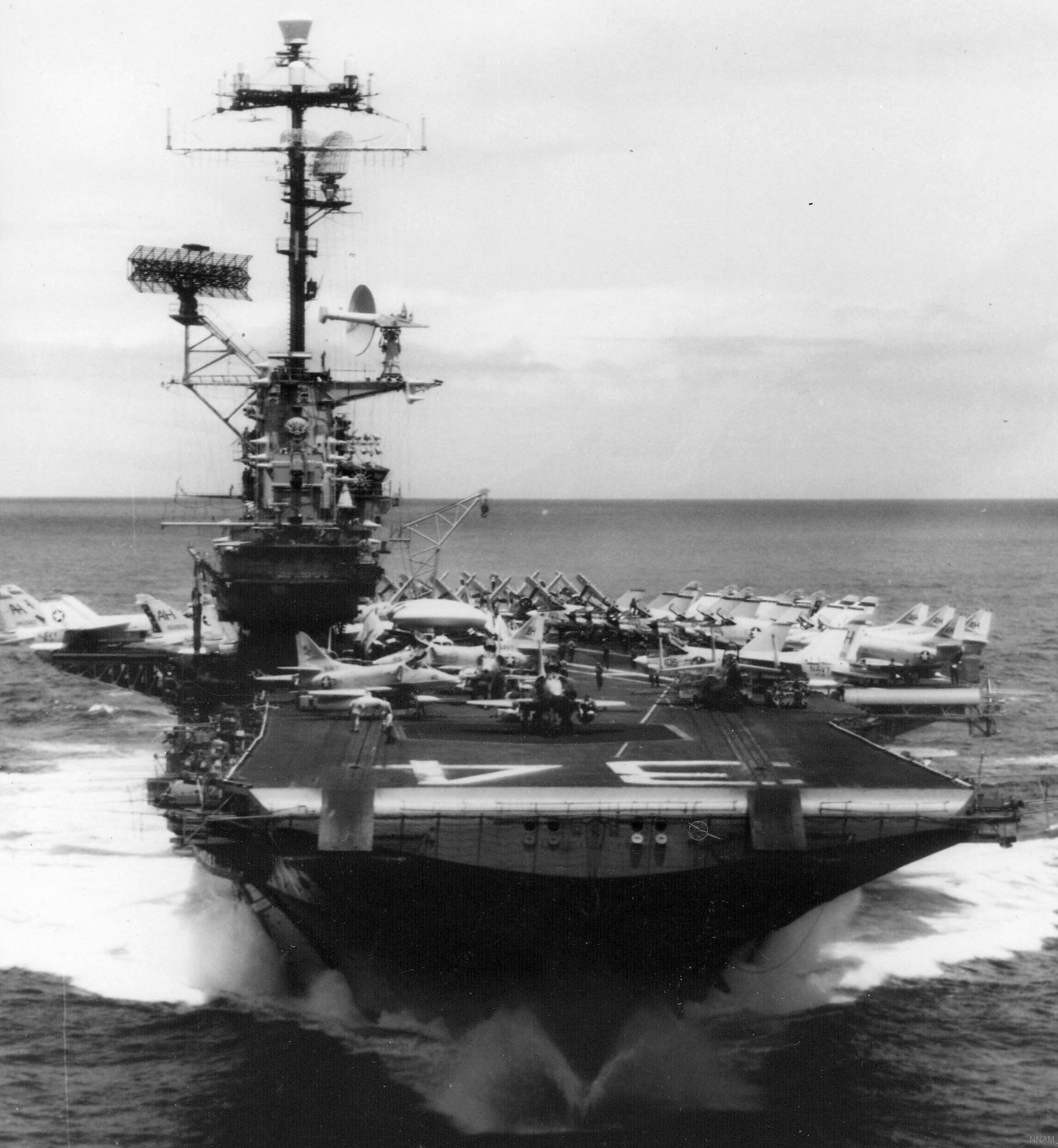 USS Oriskany (CVA 34) with Carrier Air Wing 16 (CVW-16) embarked - 1960's 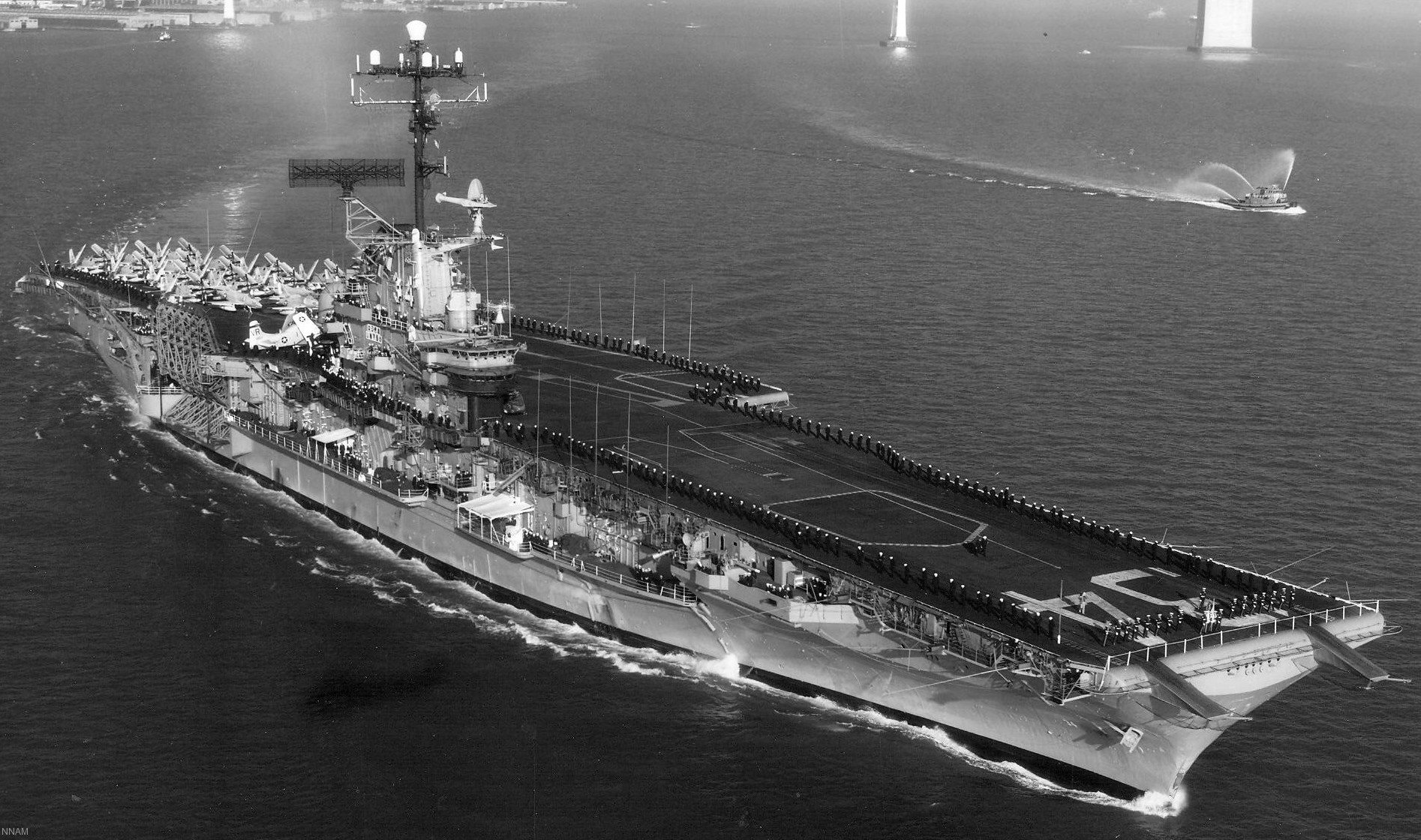 USS Oriskany (CVA 34) with Carrier Air Wing 16 (CVW-16) embarked - early 1960's 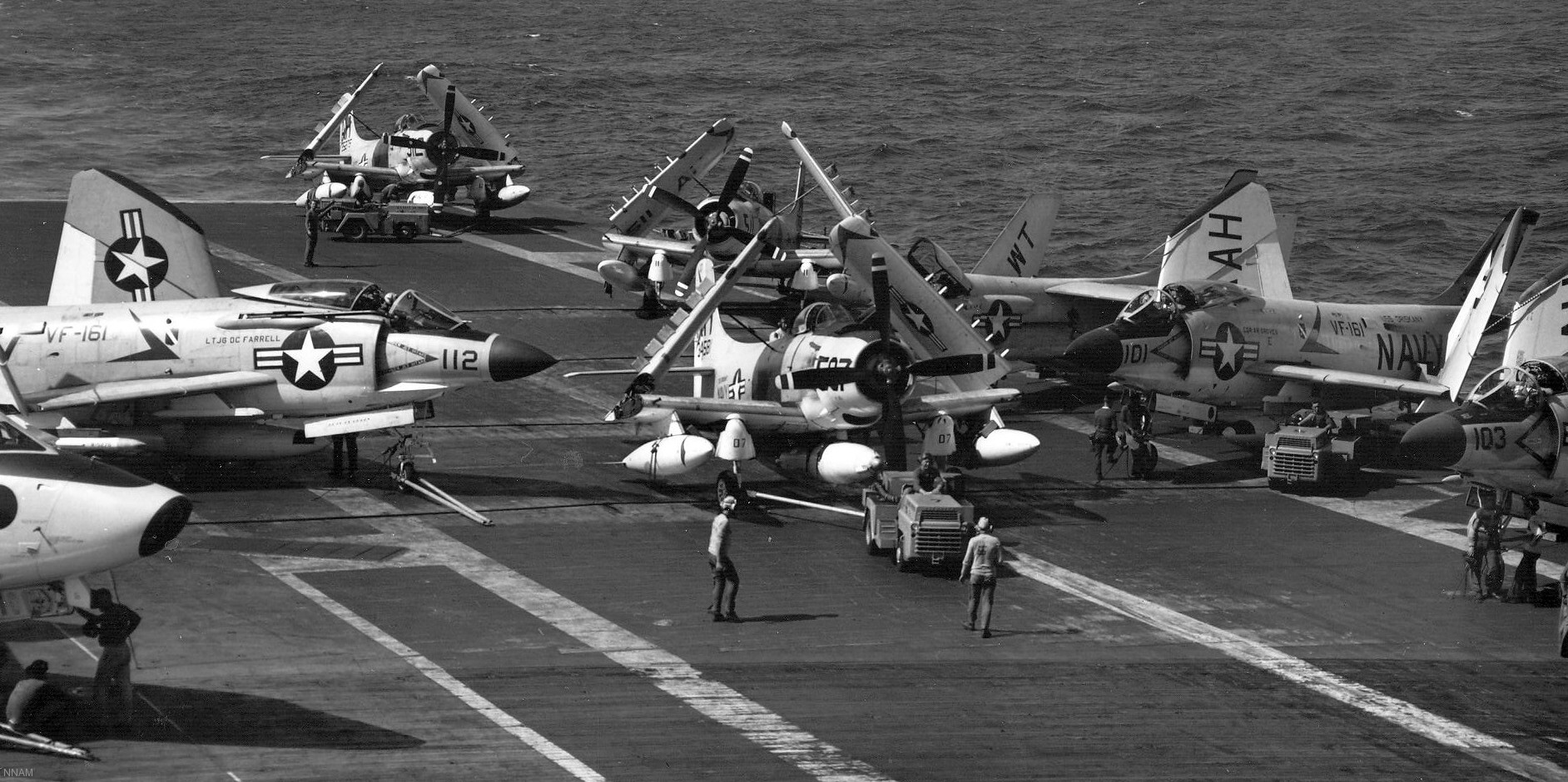 USS Oriskany (CVA 34) with Carrier Air Group 16 (CVG-16) embarked - November 1962 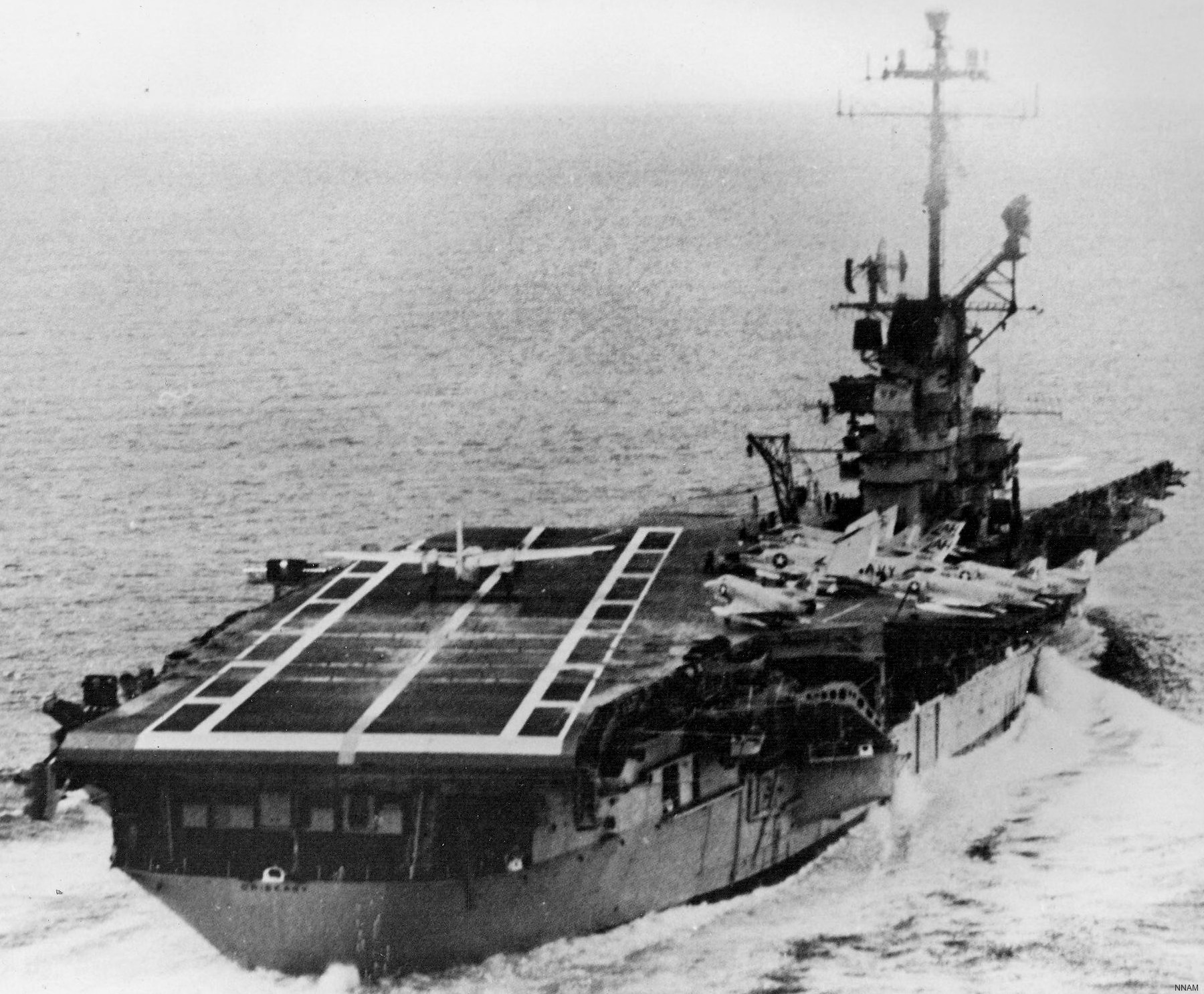 USS Oriskany (CVA 34) with Carrier Air Group 16 (CVG-16) embarked - circa 1962 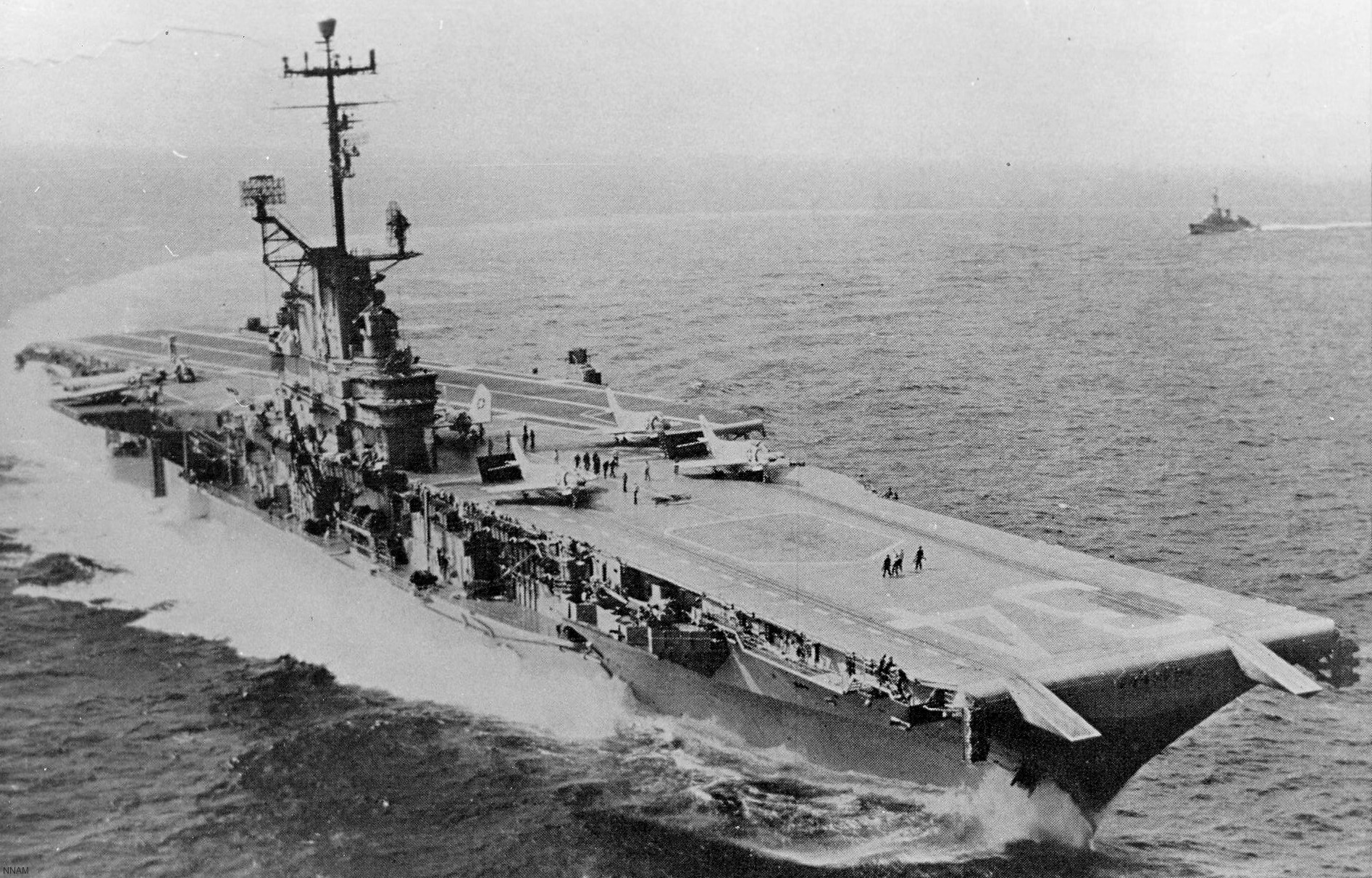 USS Oriskany (CVA 34) with Carrier Air Group 16 (CVG-16) embarked - 1962 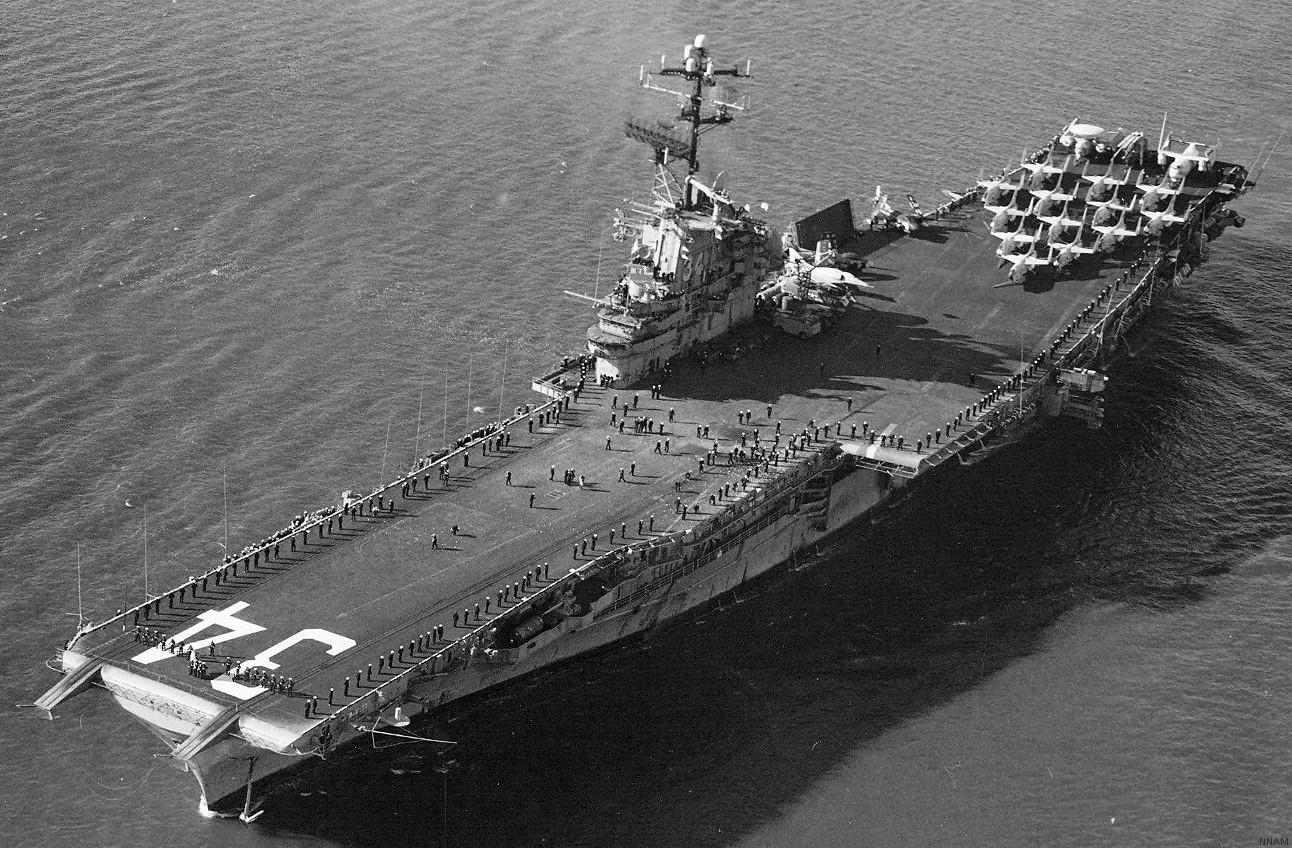 USS Oriskany (CVA 34) with Carrier Air Group 16 (CVG-16) embarked - circa 1962 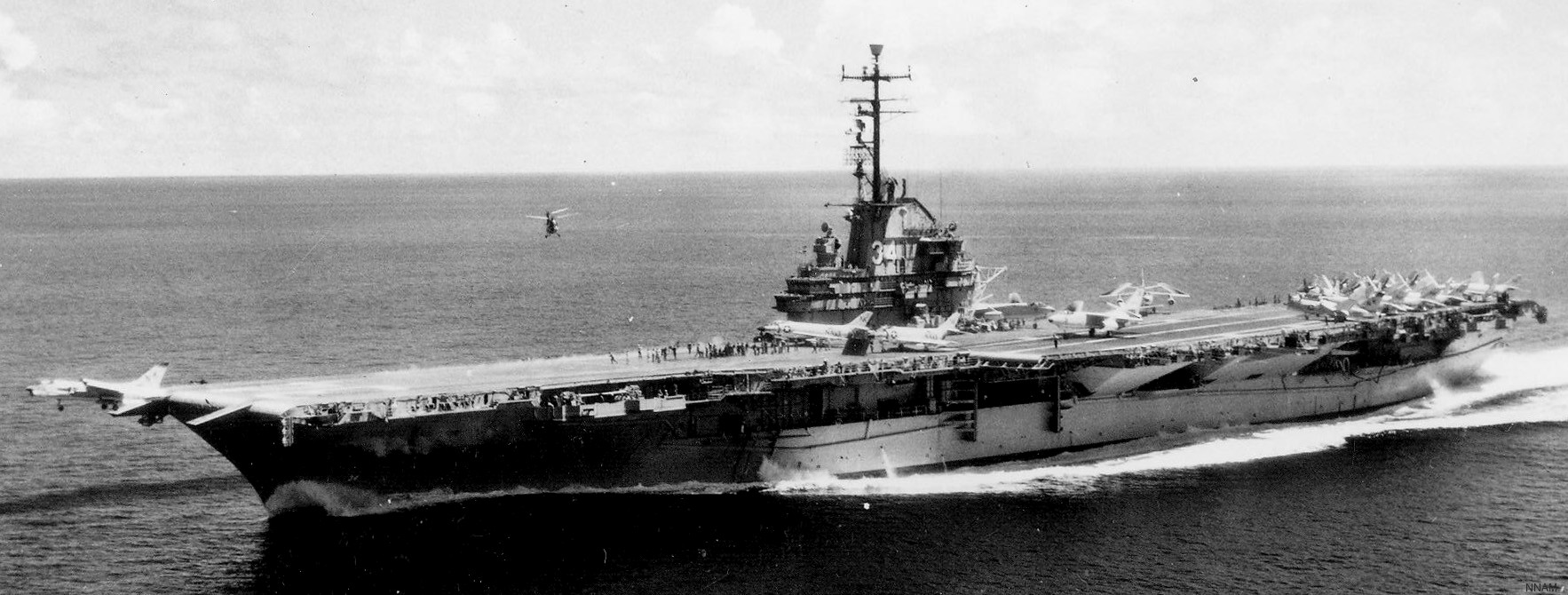 USS Oriskany (CVA 34) with Carrier Air Group 14 (CVG-14) embarked - July 1960 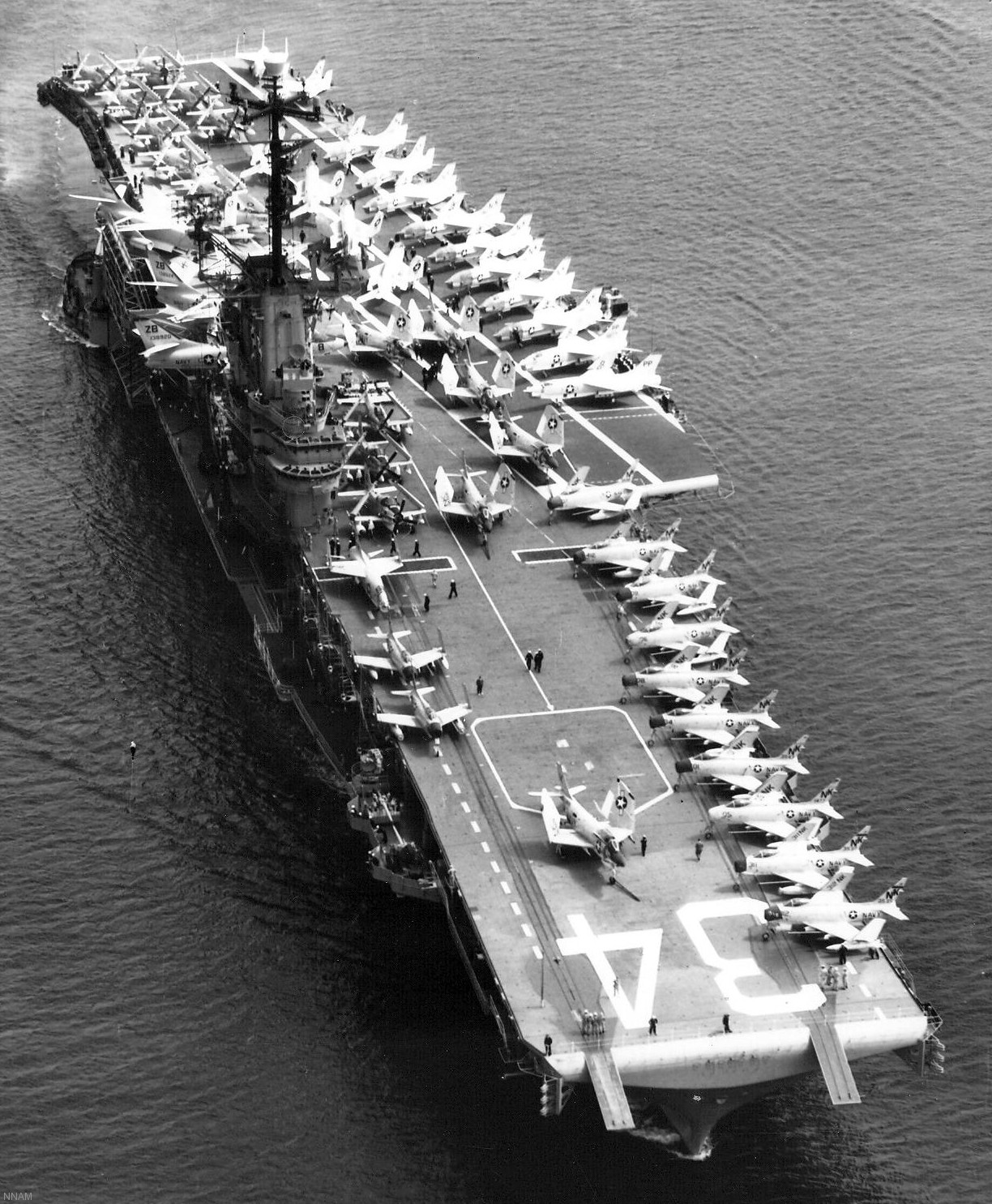 USS Oriskany (CVA 34) with Carrier Air Group 14 (CVG-14) embarked - May 1960 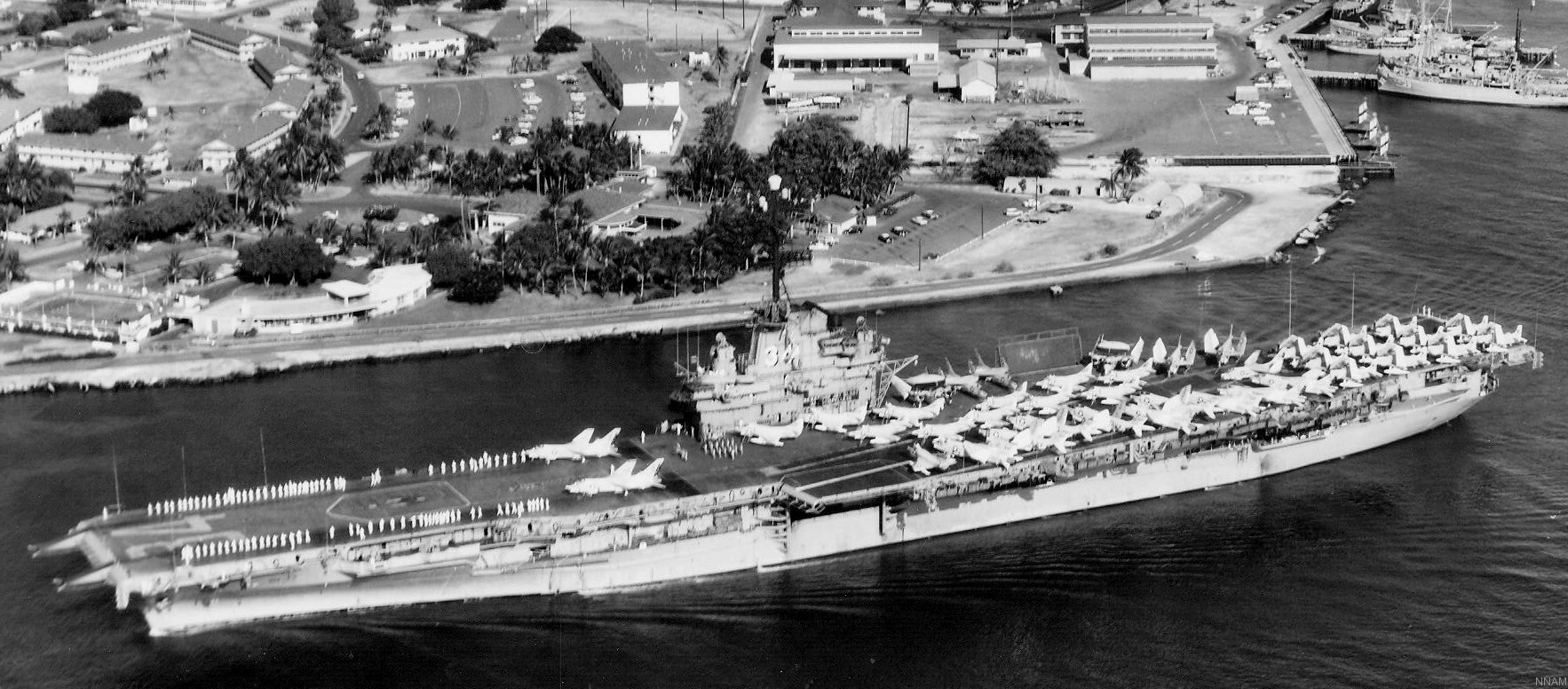 USS Oriskany (CVA 34) - early 1960's 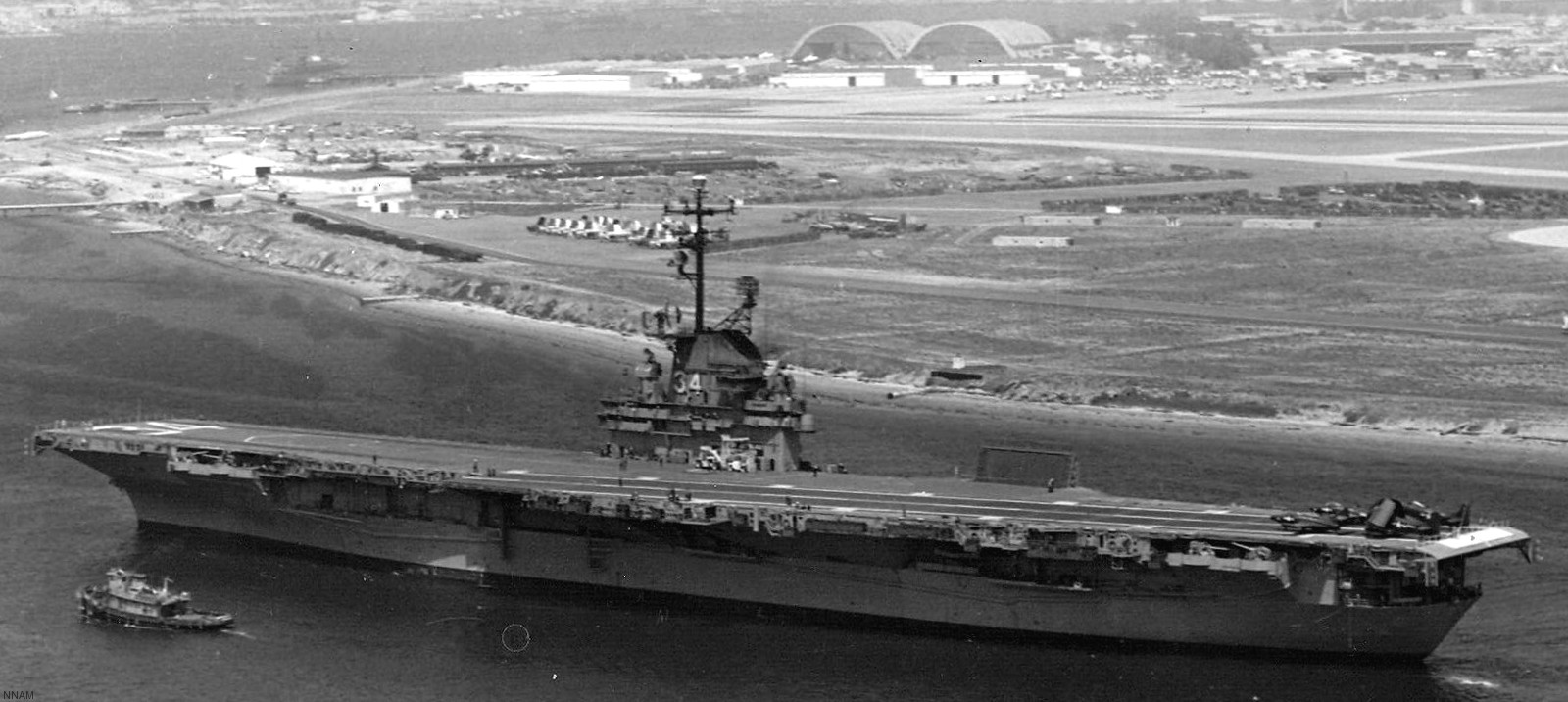 USS Oriskany (CVA 34) at NAS North Island, California - June 1959 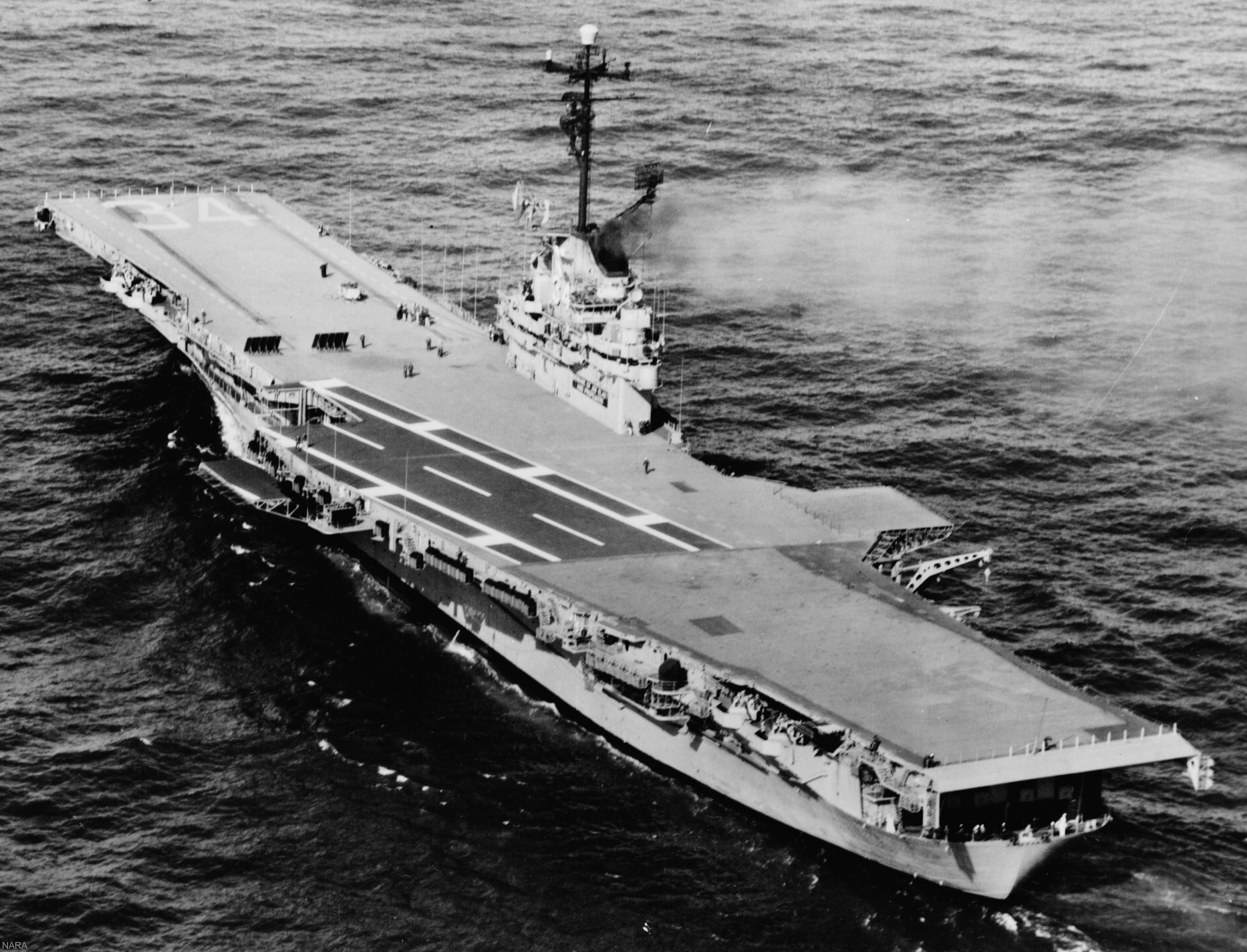 USS Oriskany (CVA 34) after SCB-125A conversion - circa April 1959  USS Oriskany (CVA 34) after SCB-125A conversion - circa April 1959 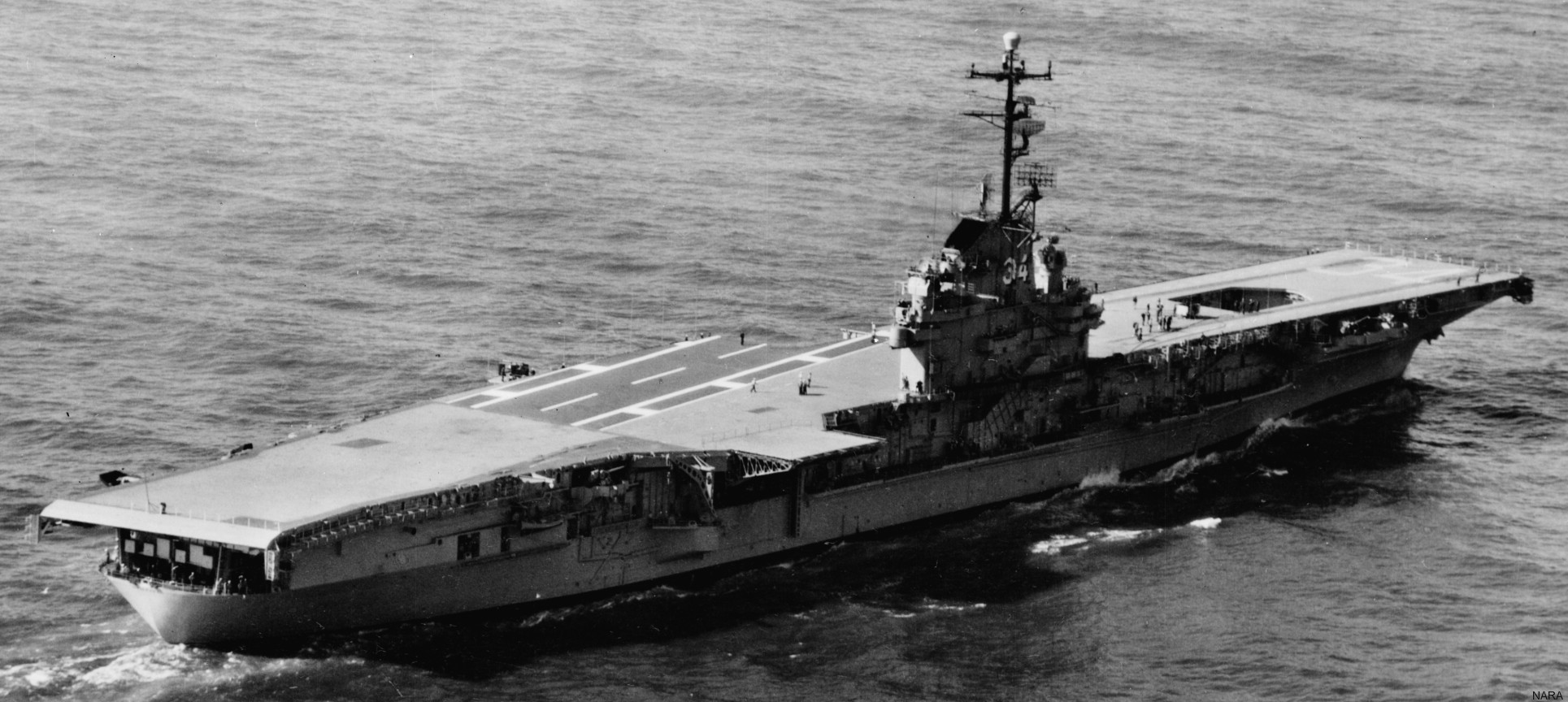 USS Oriskany (CVA 34) after SCB-125A conversion - circa April 1959 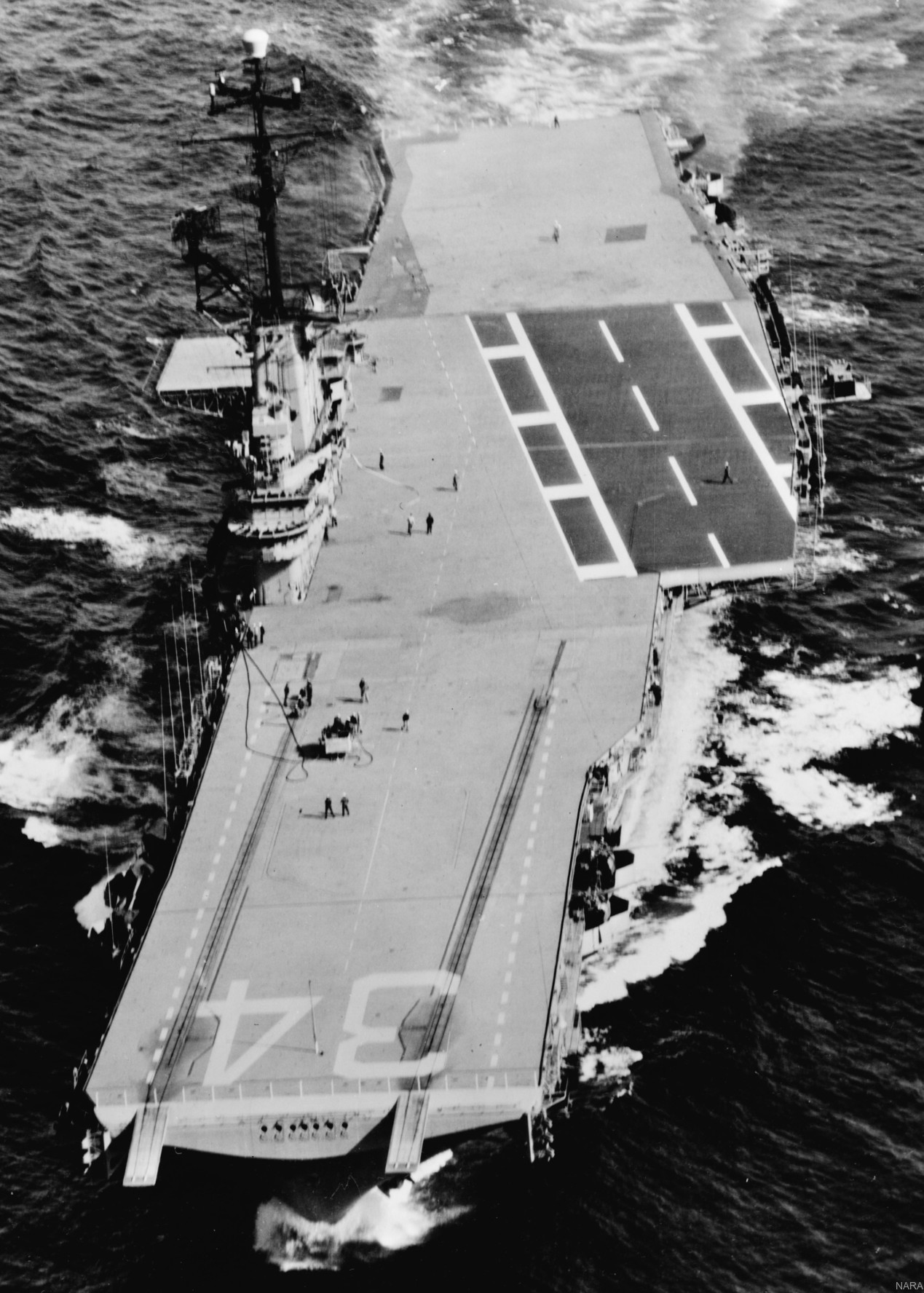 USS Oriskany (CVA 34) after SCB-125A conversion - circa April 1959 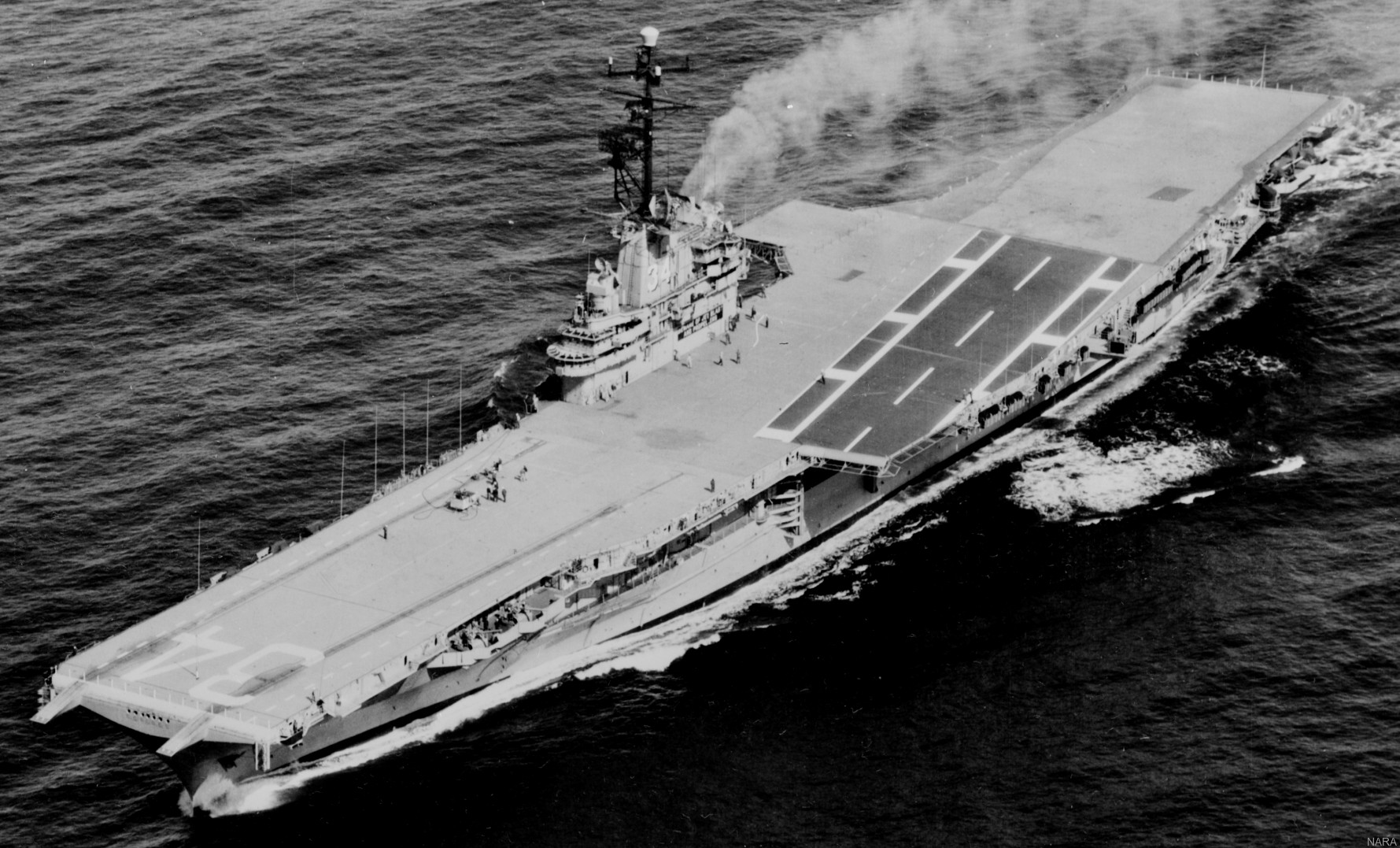 USS Oriskany (CVA 34) after SCB-125A conversion - circa April 1959 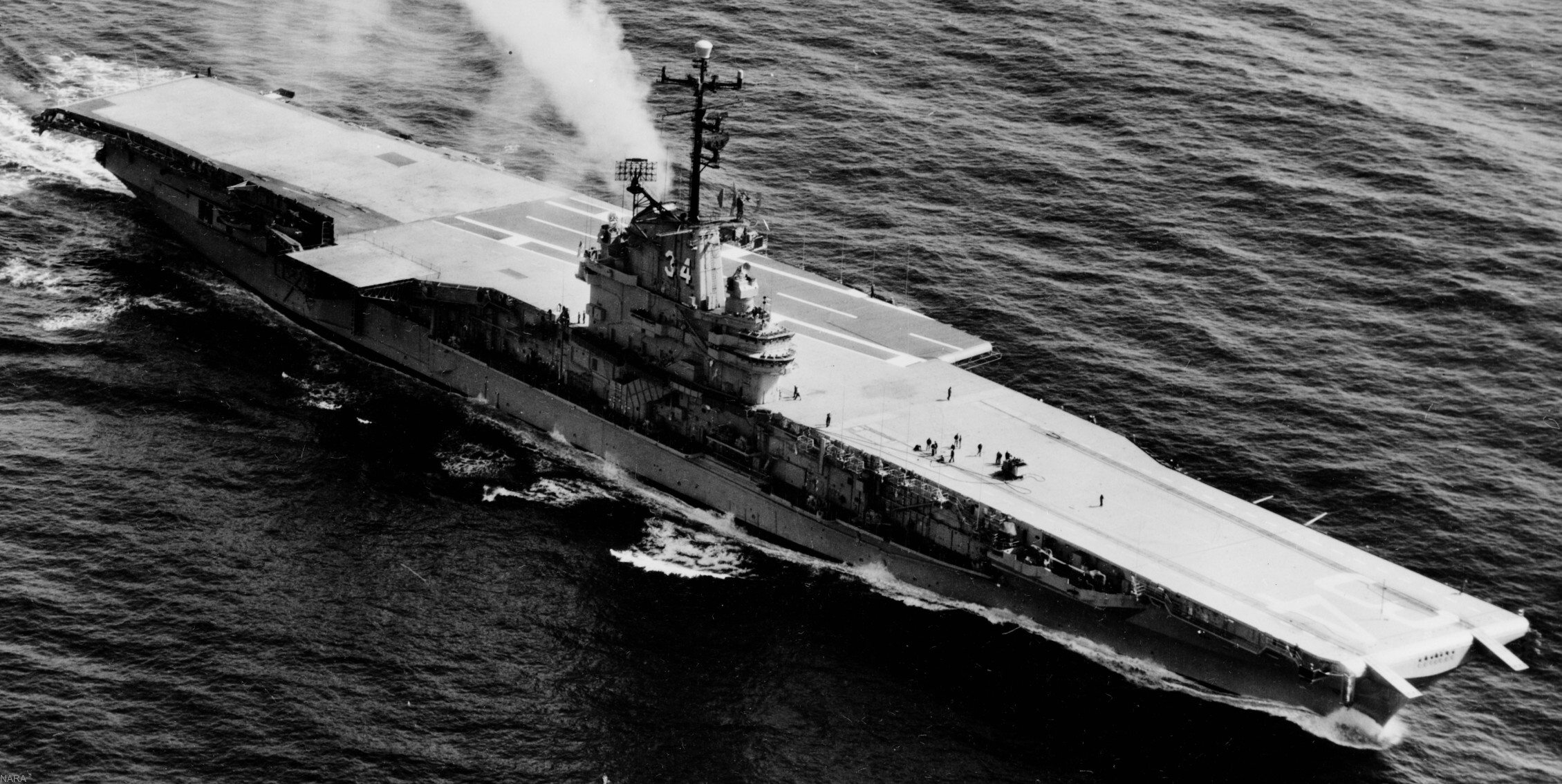 USS Oriskany (CVA 34) after SCB-125A conversion - circa April 1959 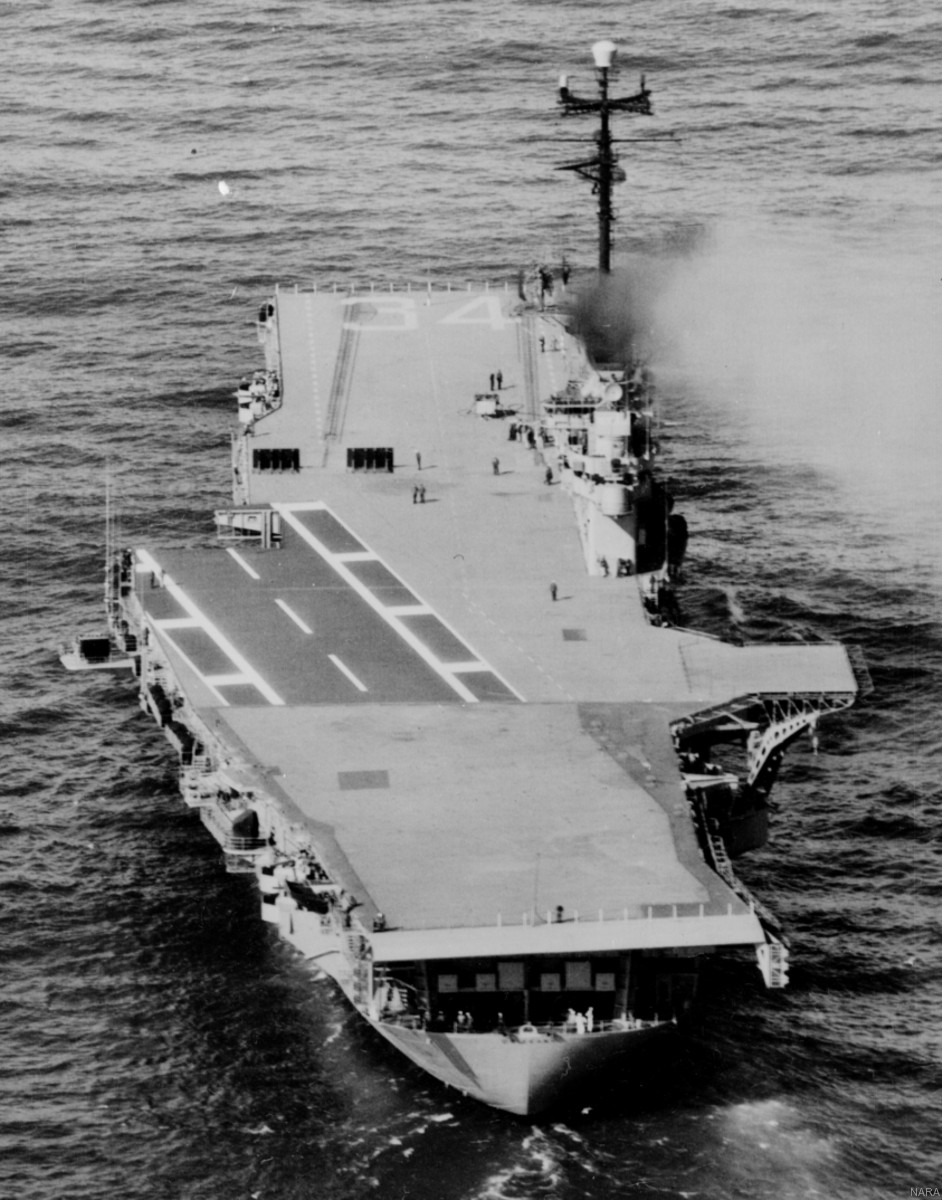 USS Oriskany (CVA 34) after SCB-125A conversion - circa April 1959 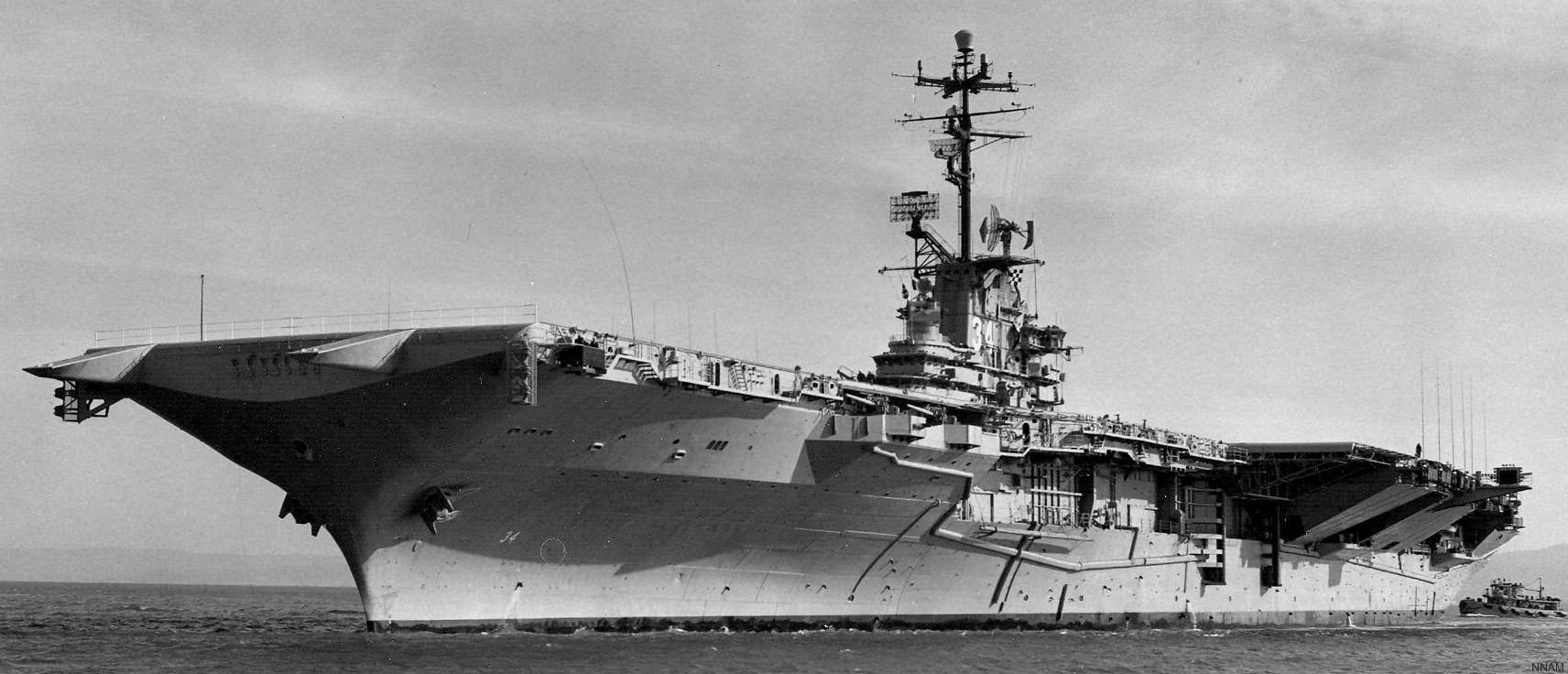 USS Oriskany (CVA 34) after SCB-125A conversion - April 1959 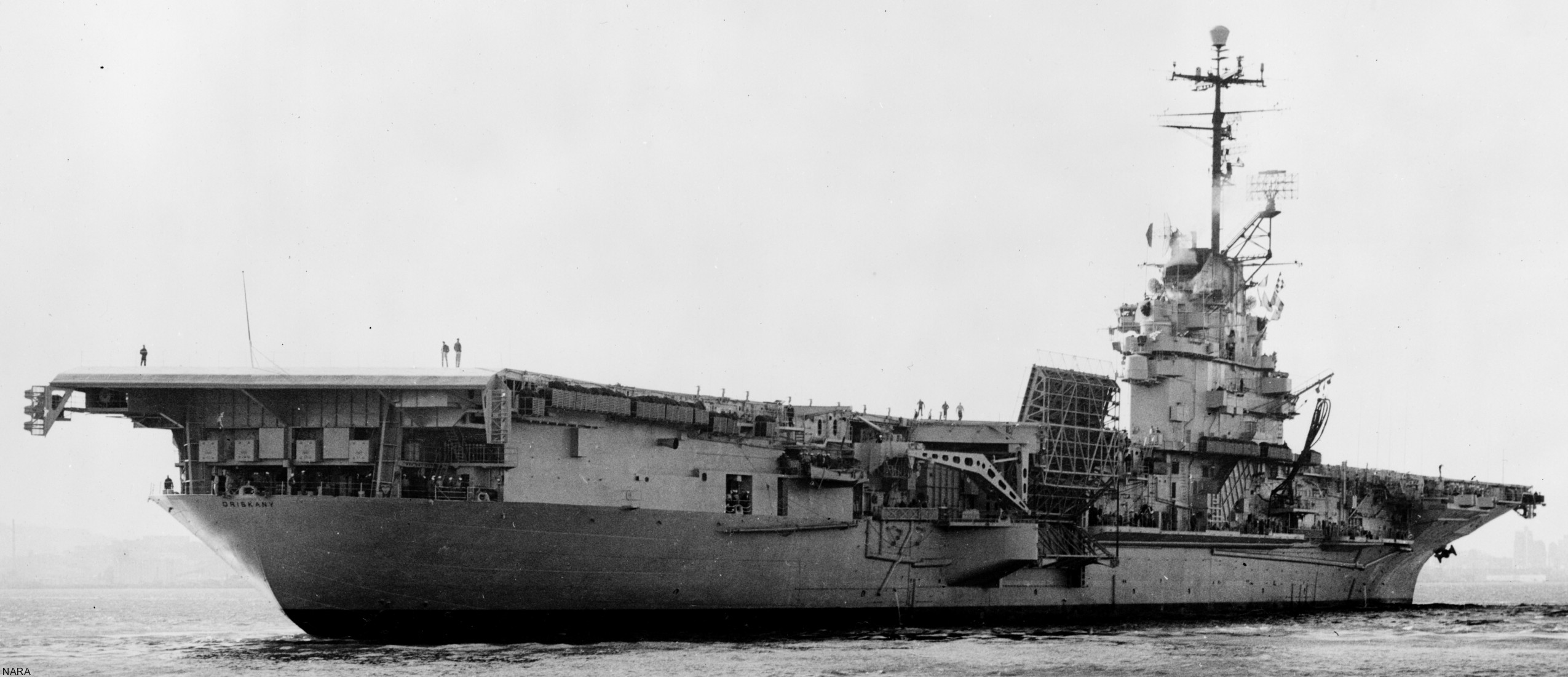 USS Oriskany (CVA 34) after SCB-125A conversion - April 1959  USS Oriskany (CVA 34) after SCB-125A conversion - April 1959  USS Oriskany (CVA 34) after SCB-125A conversion - April 1959  USS Oriskany (CVA 34) after SCB-125A conversion - April 1959 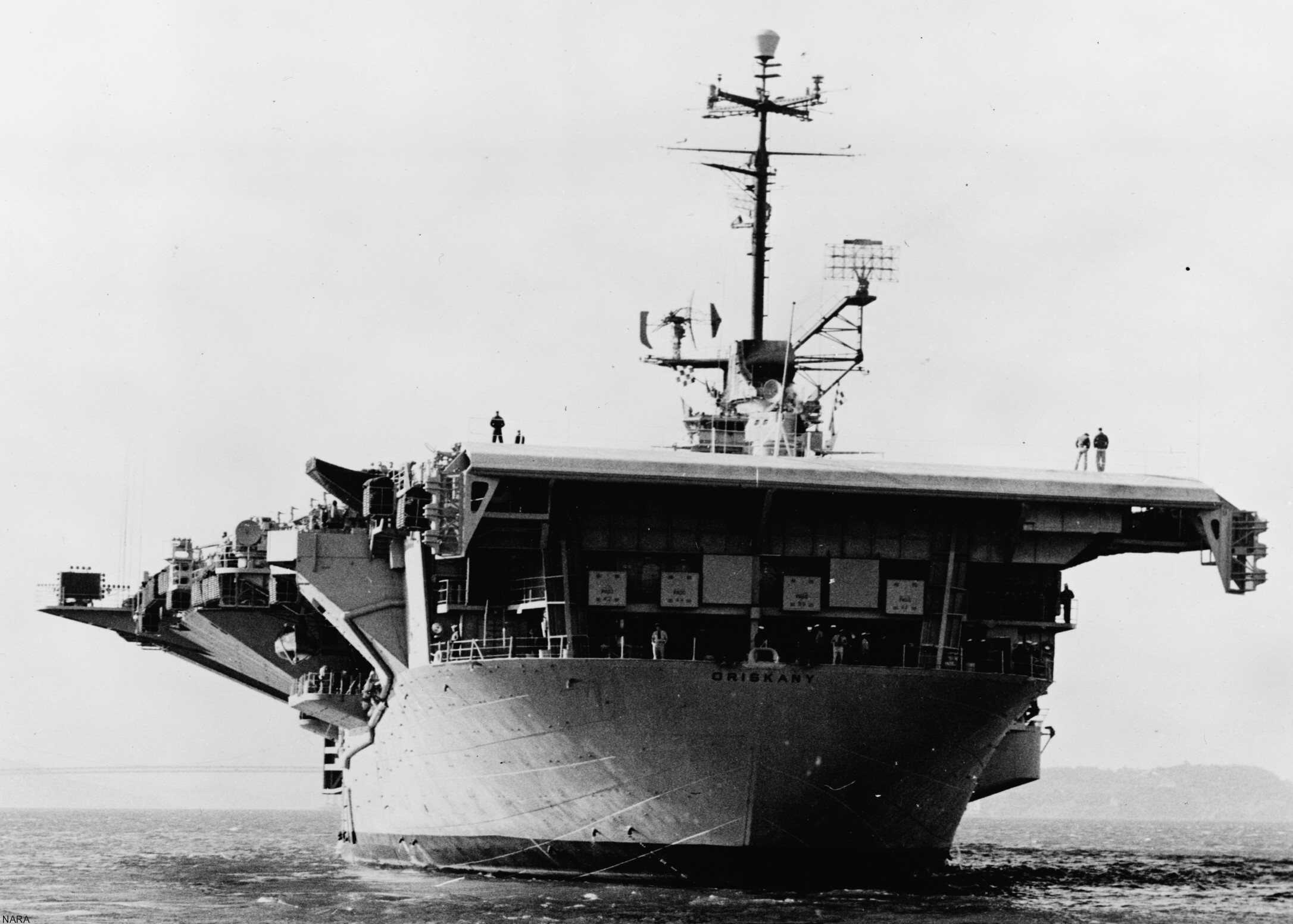 USS Oriskany (CVA 34) after SCB-125A conversion - April 1959 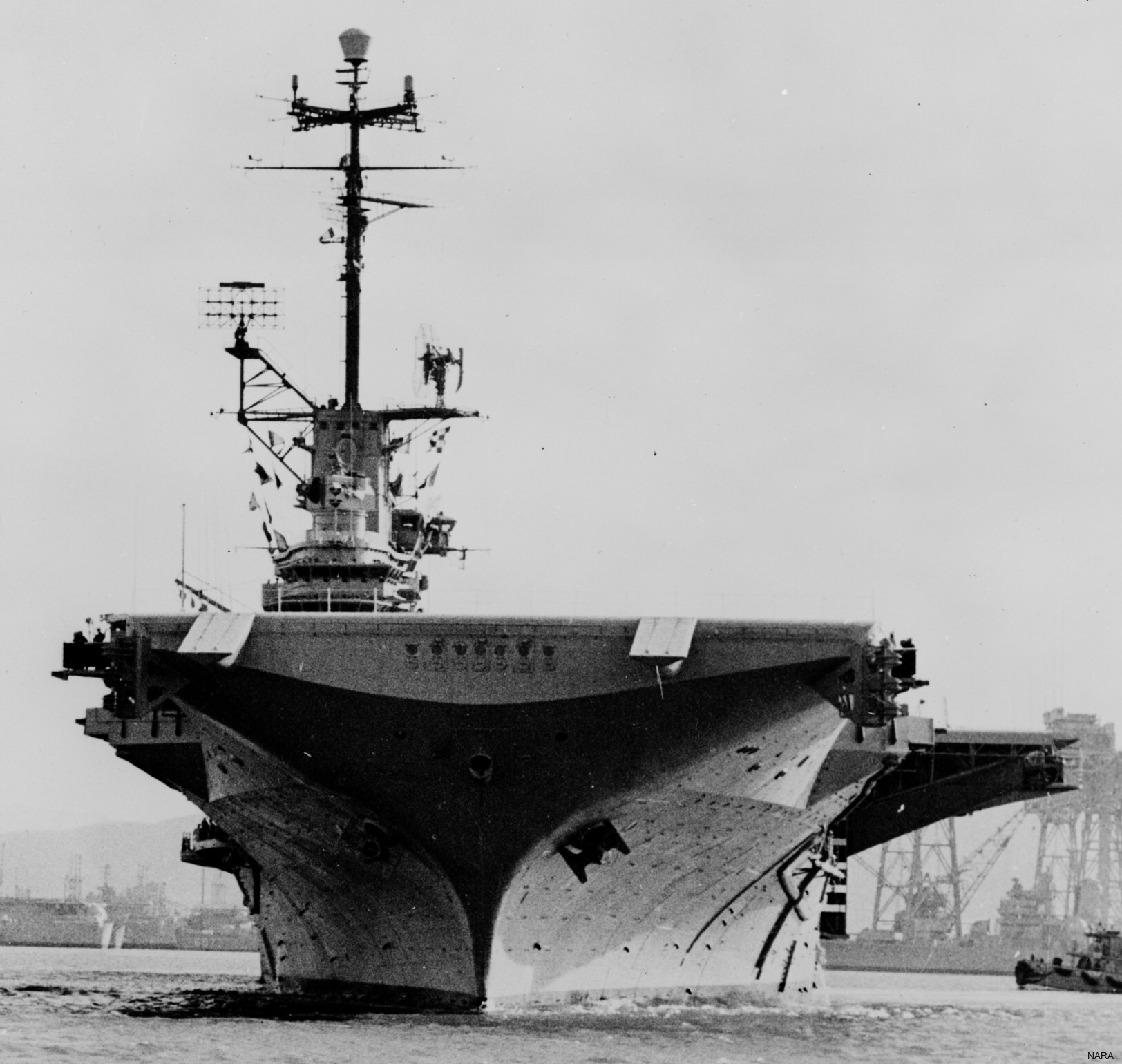 USS Oriskany (CVA 34) after SCB-125A conversion - April 1959 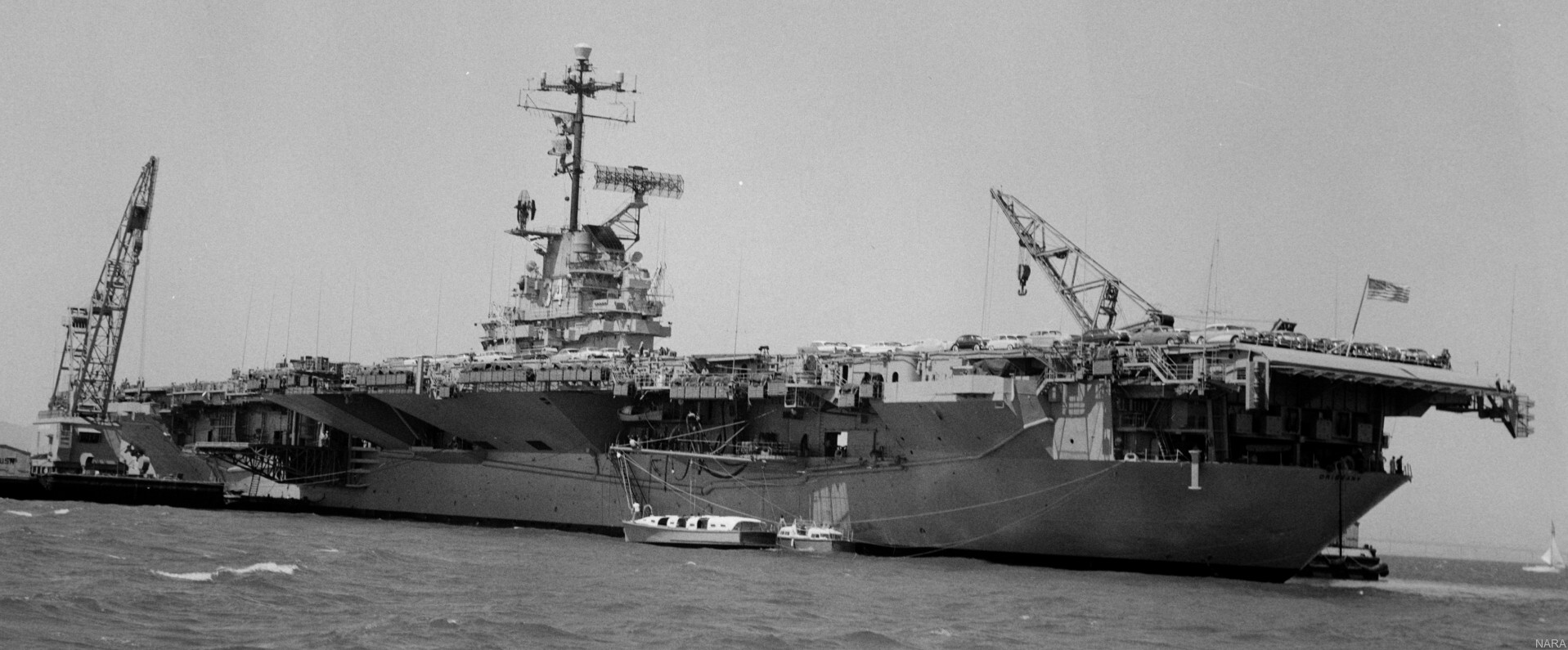 undated 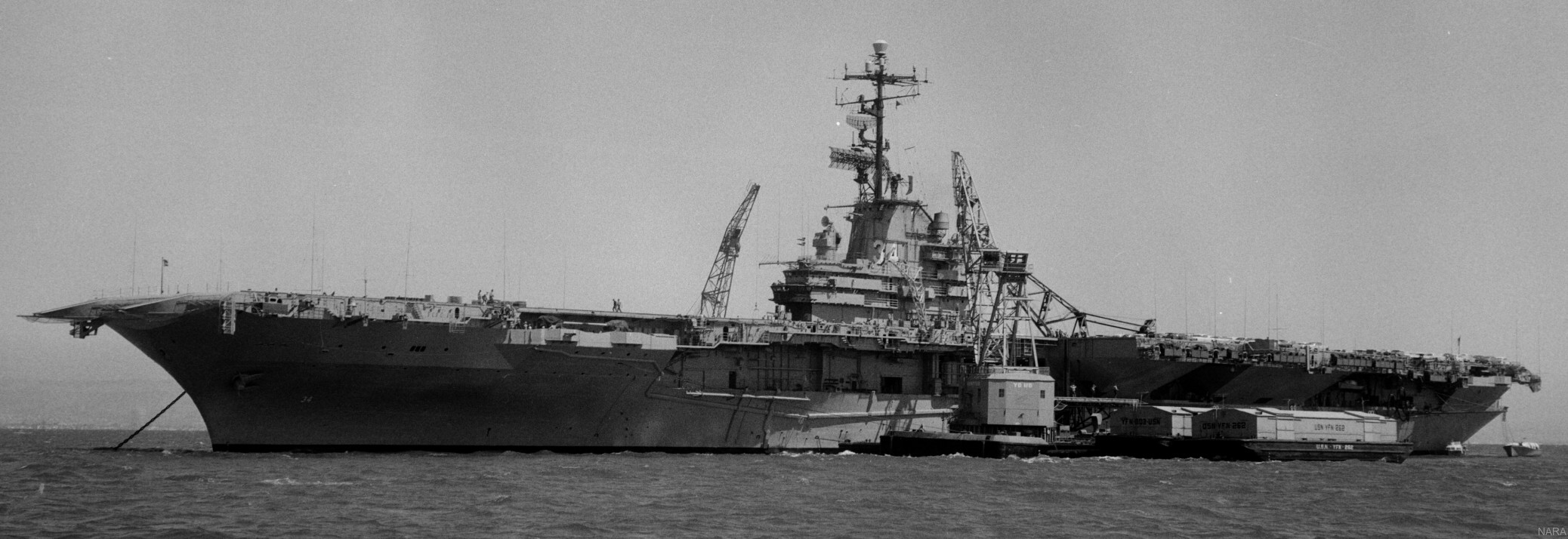 undated  undated  undated  undated 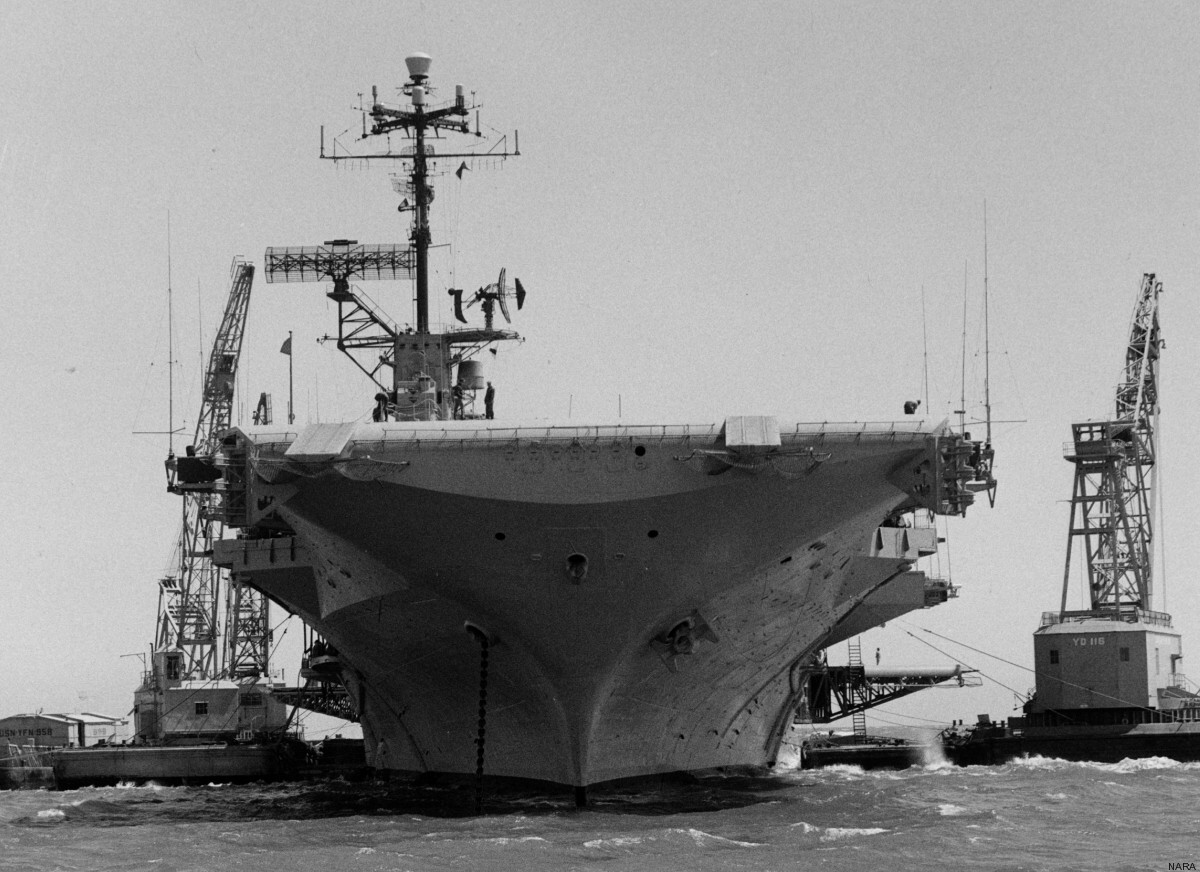 undated 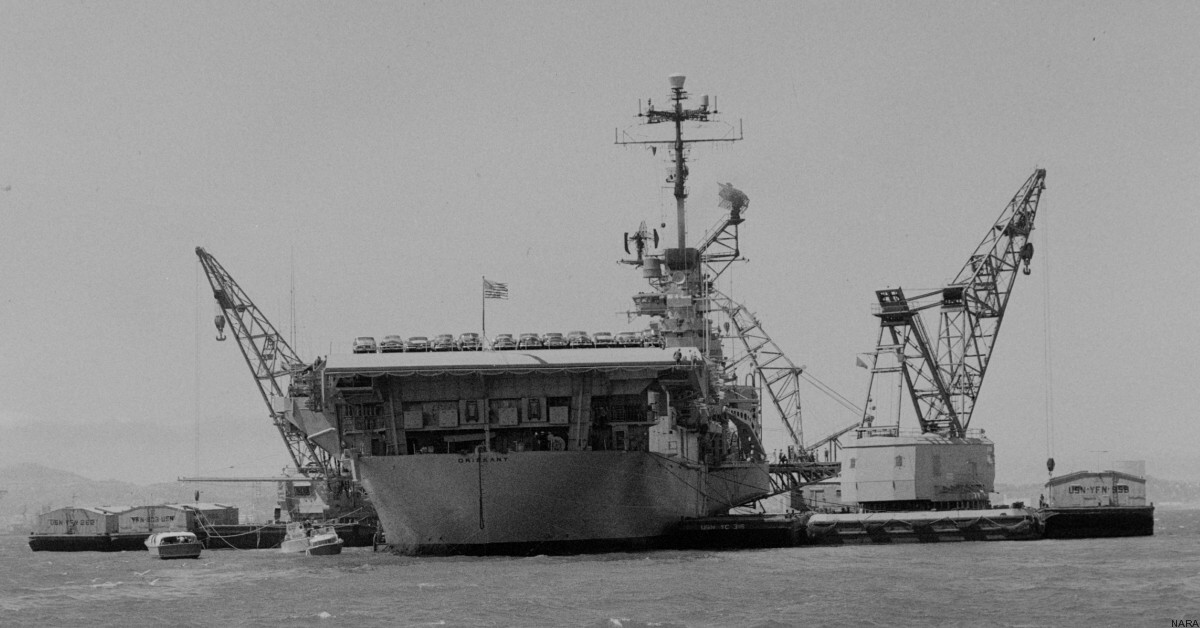 undated 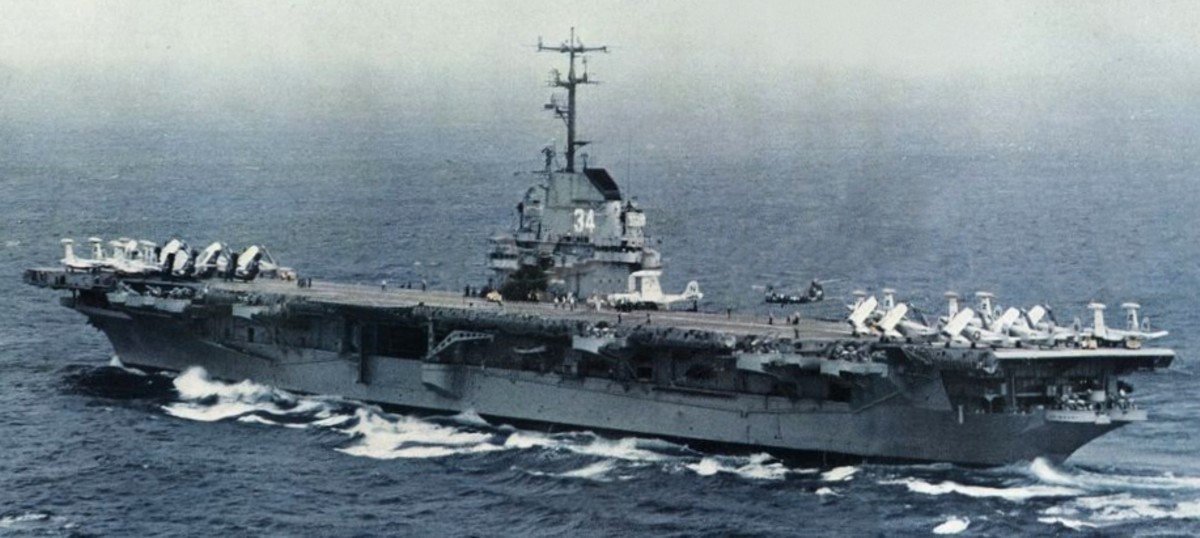 USS Oriskany (CVA 34) with CVG-9 embarked - 1956 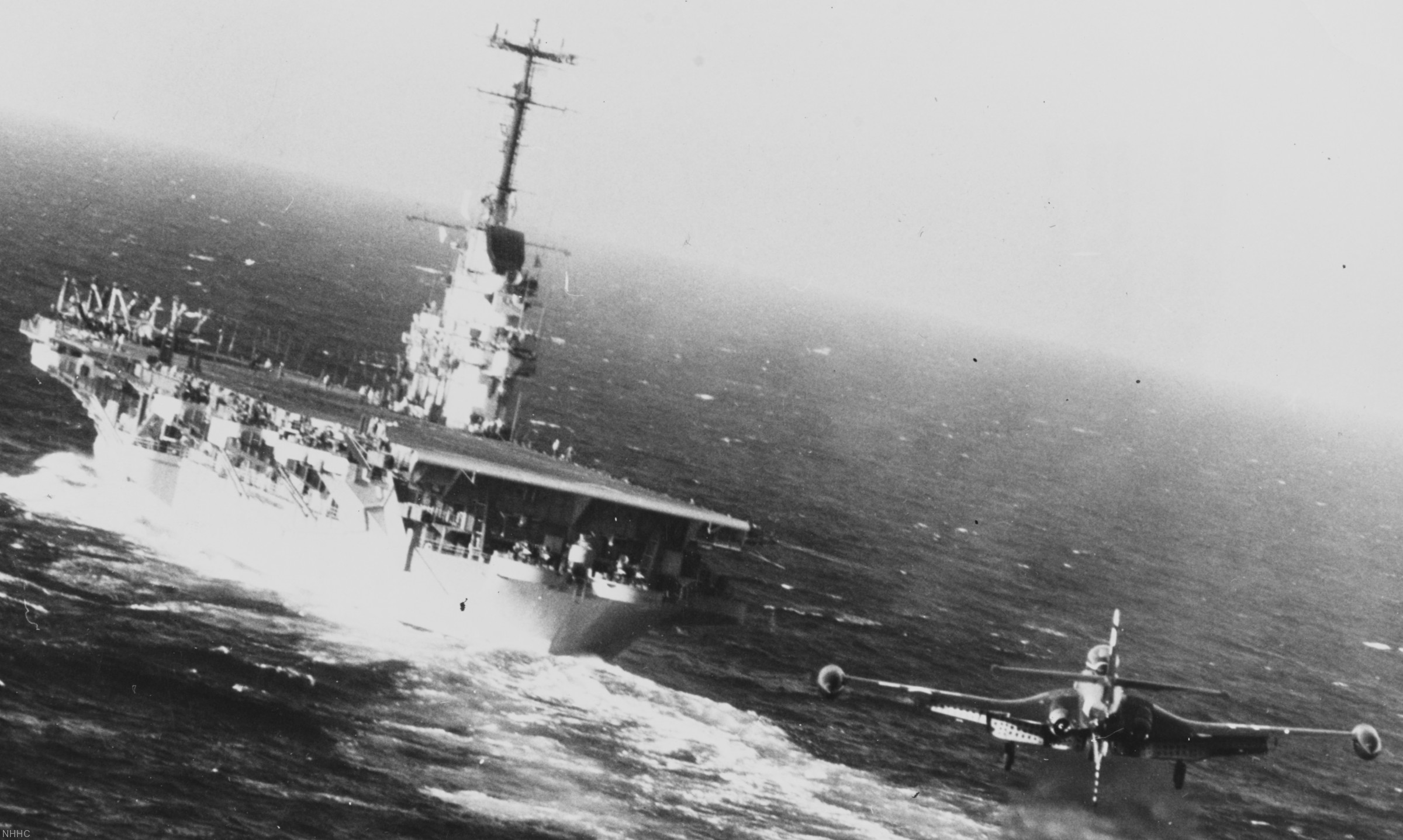 F2H-2P Banshee on her finals to land aboard USS Oriskany (CVA 34) - February 1955 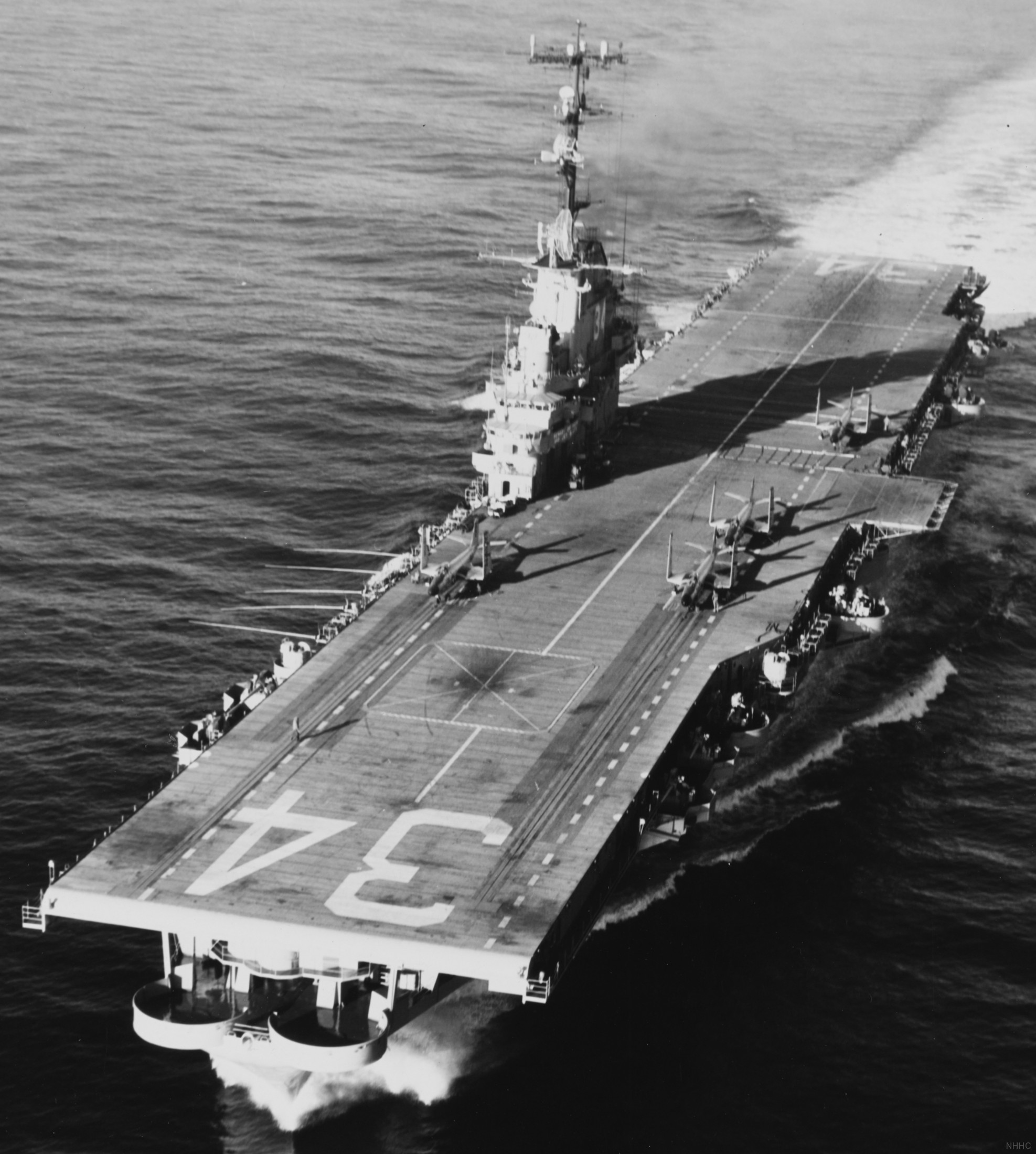 USS Oriskany (CVA 34) off California - January 1955 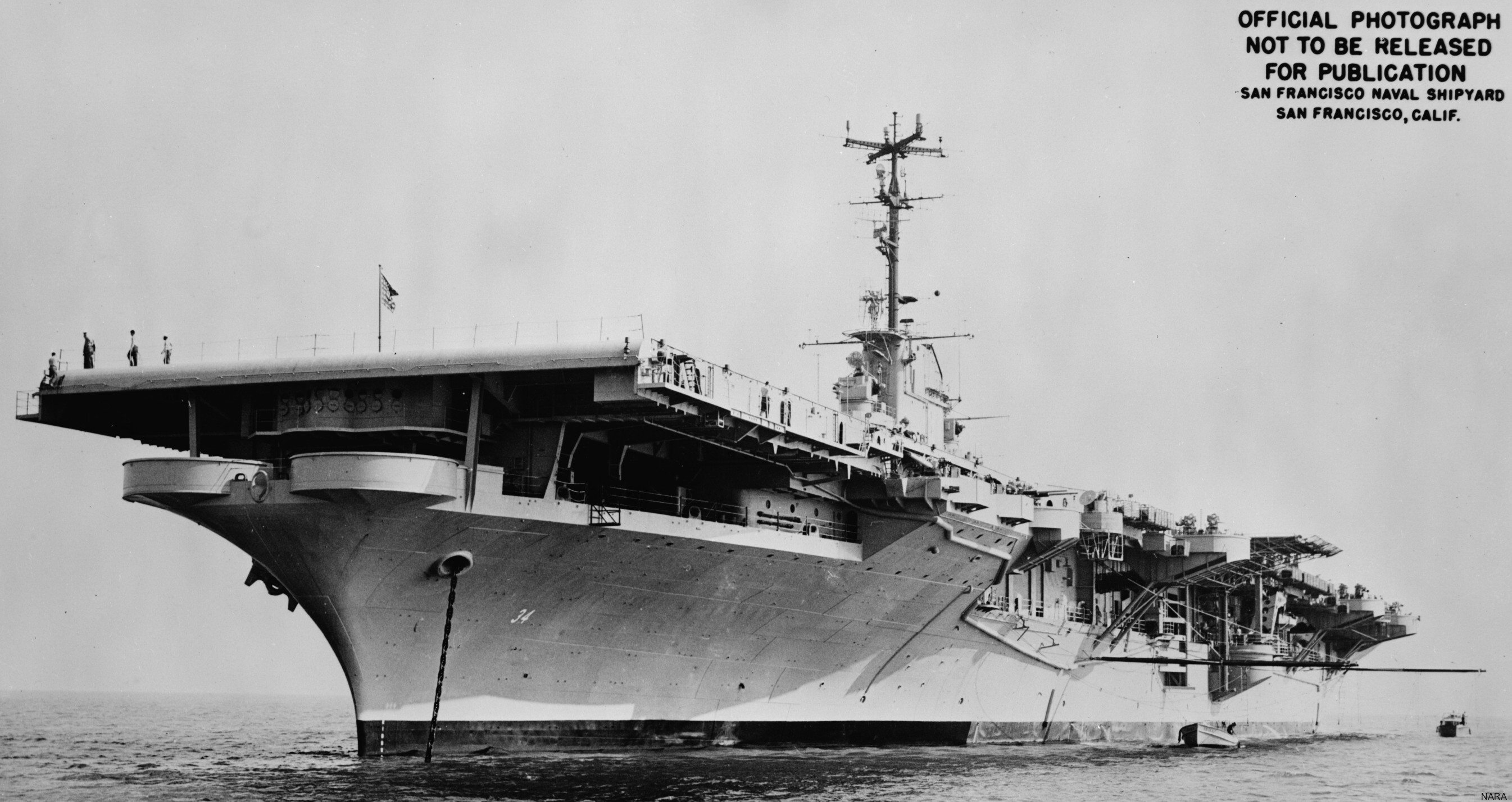 USS Oriskany (CVA 34) after regular overhaul at San Francisco Naval Shipyard - October 1954  USS Oriskany (CVA 34) after regular overhaul at San Francisco Naval Shipyard - October 1954 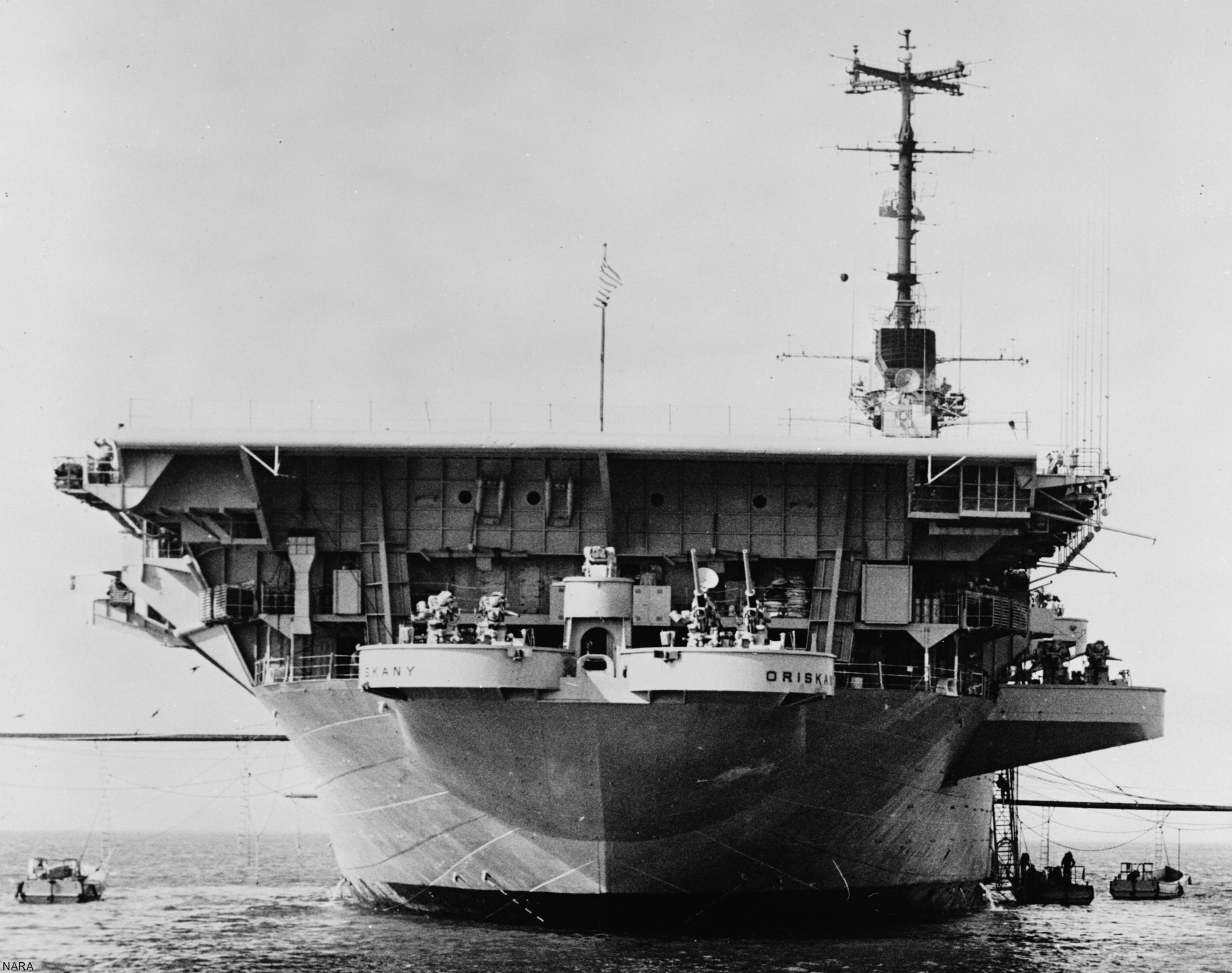 USS Oriskany (CVA 34) after regular overhaul at San Francisco Naval Shipyard - October 1954 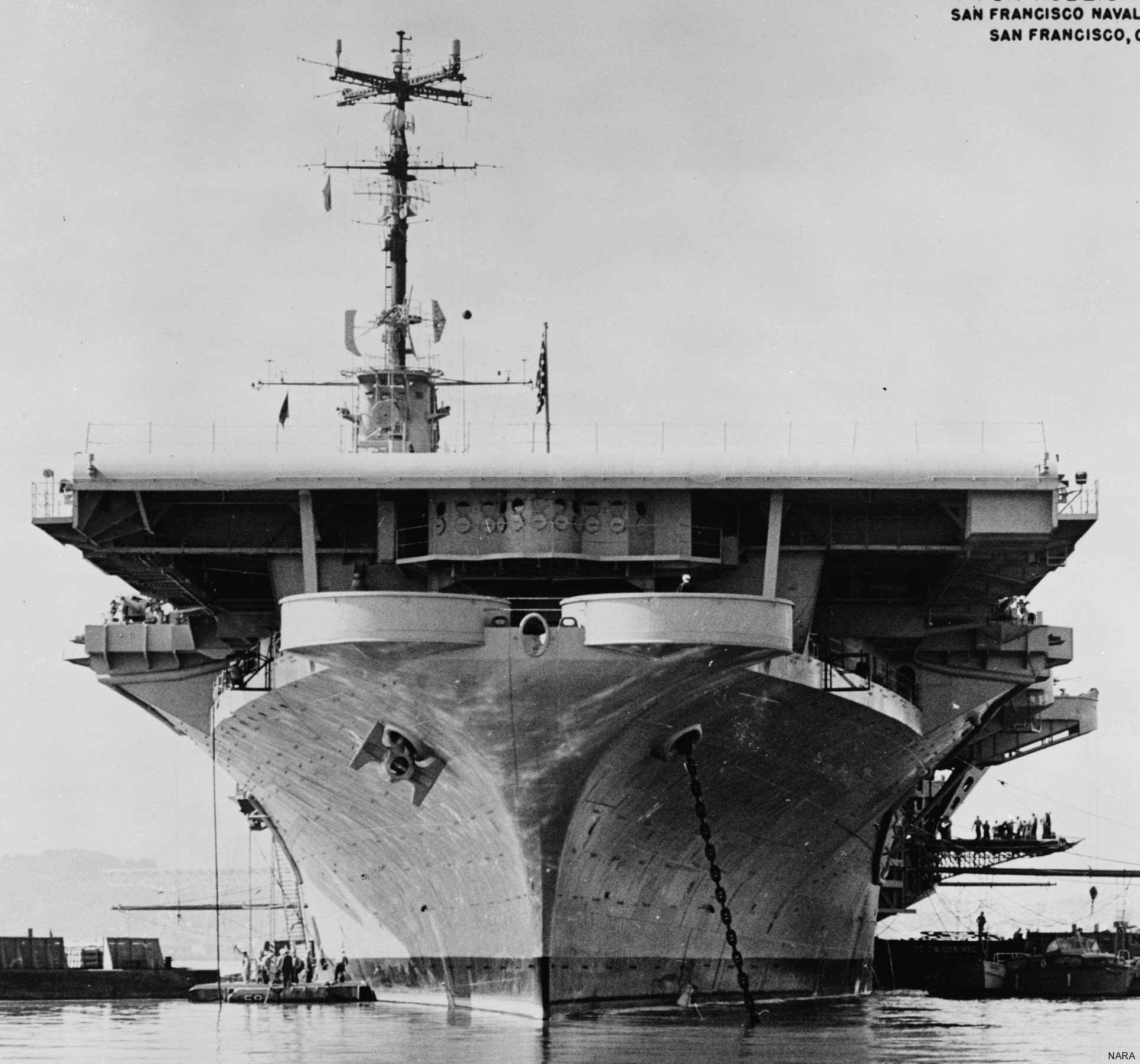 USS Oriskany (CVA 34) after regular overhaul at San Francisco Naval Shipyard - October 1954 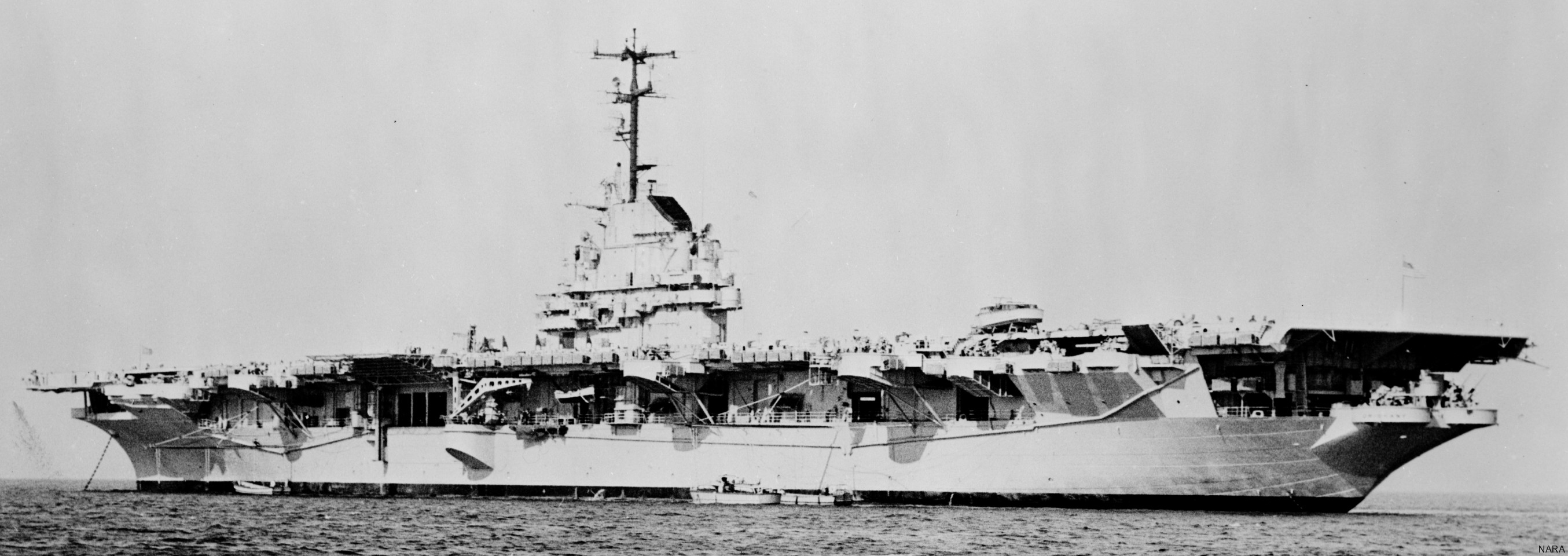 USS Oriskany (CVA 34) after regular overhaul at San Francisco Naval Shipyard - October 1954  USS Oriskany (CVA 34) after regular overhaul at San Francisco Naval Shipyard - October 1954 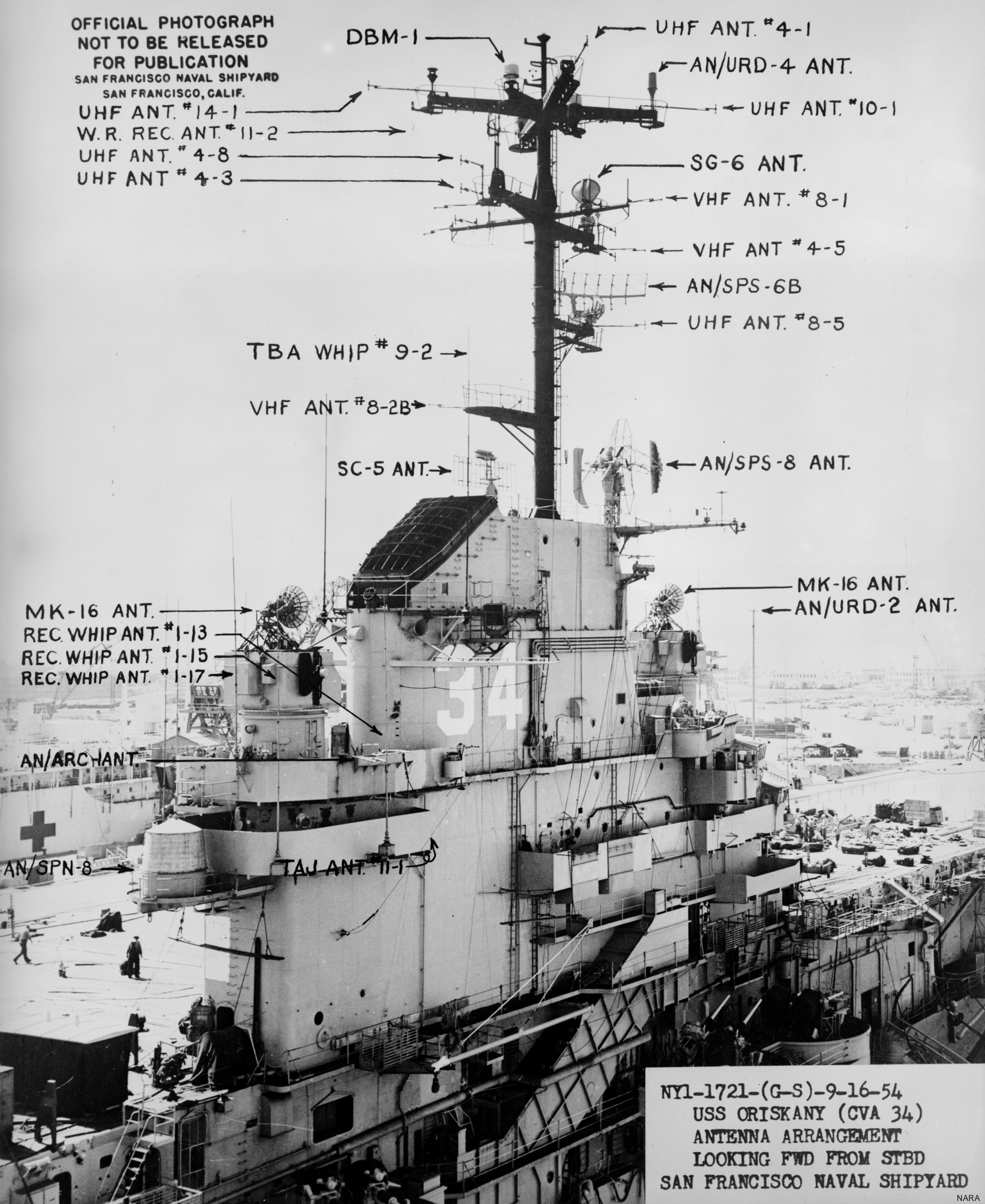 USS Oriskany (CVA 34) at San Francisco Naval Shipyard - September 1954 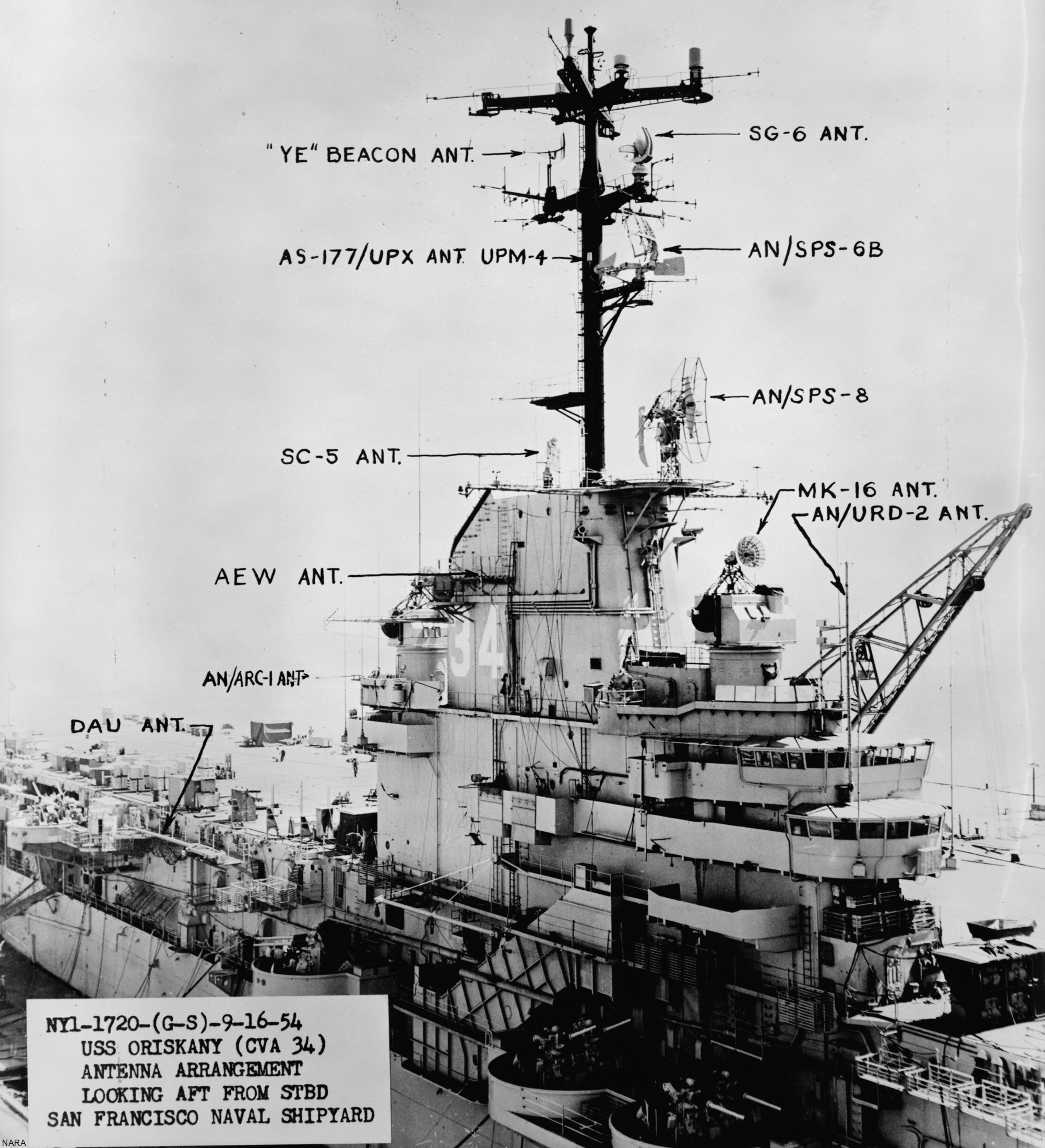 USS Oriskany (CVA 34) at San Francisco Naval Shipyard - September 1954 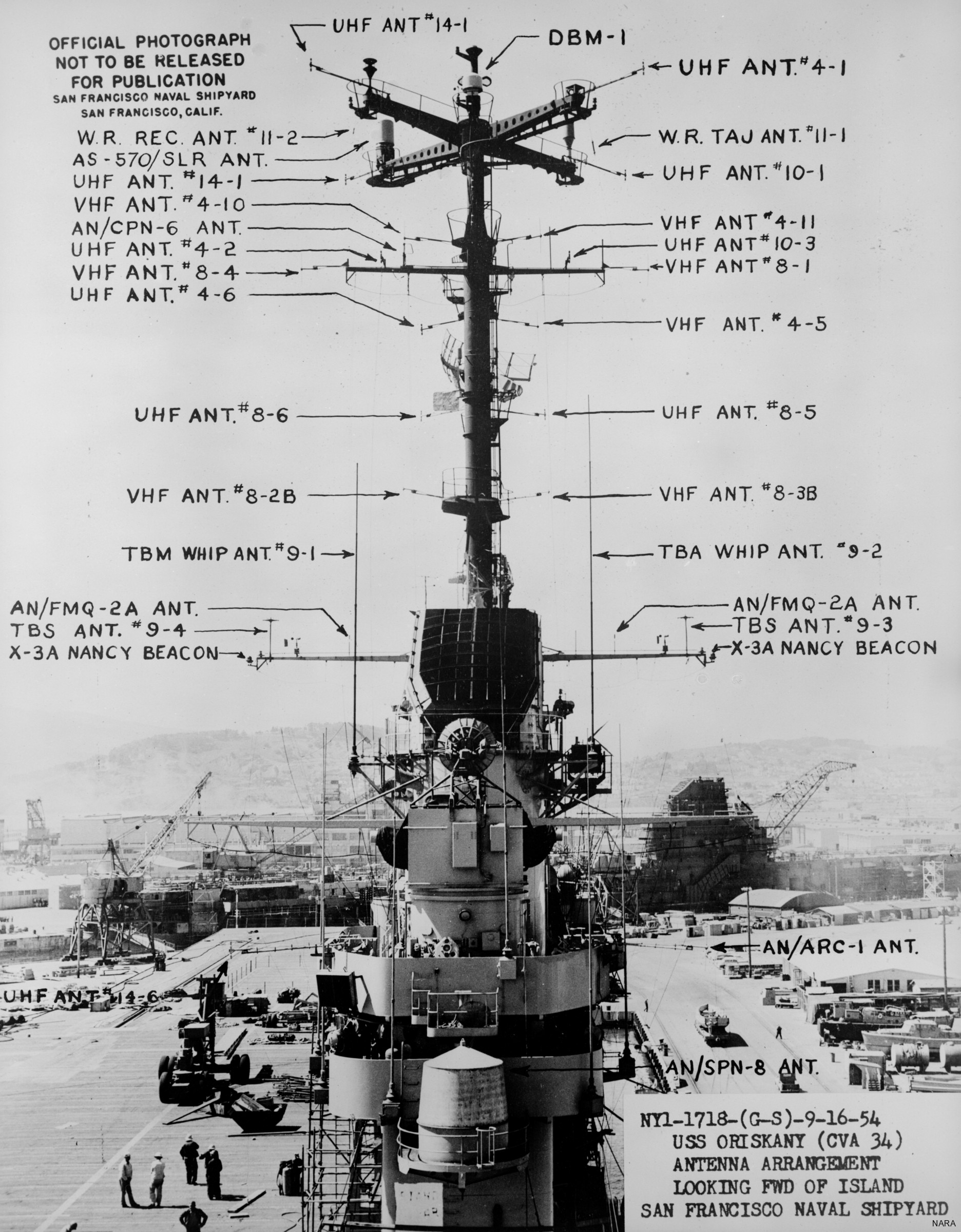 USS Oriskany (CVA 34) at San Francisco Naval Shipyard - September 1954 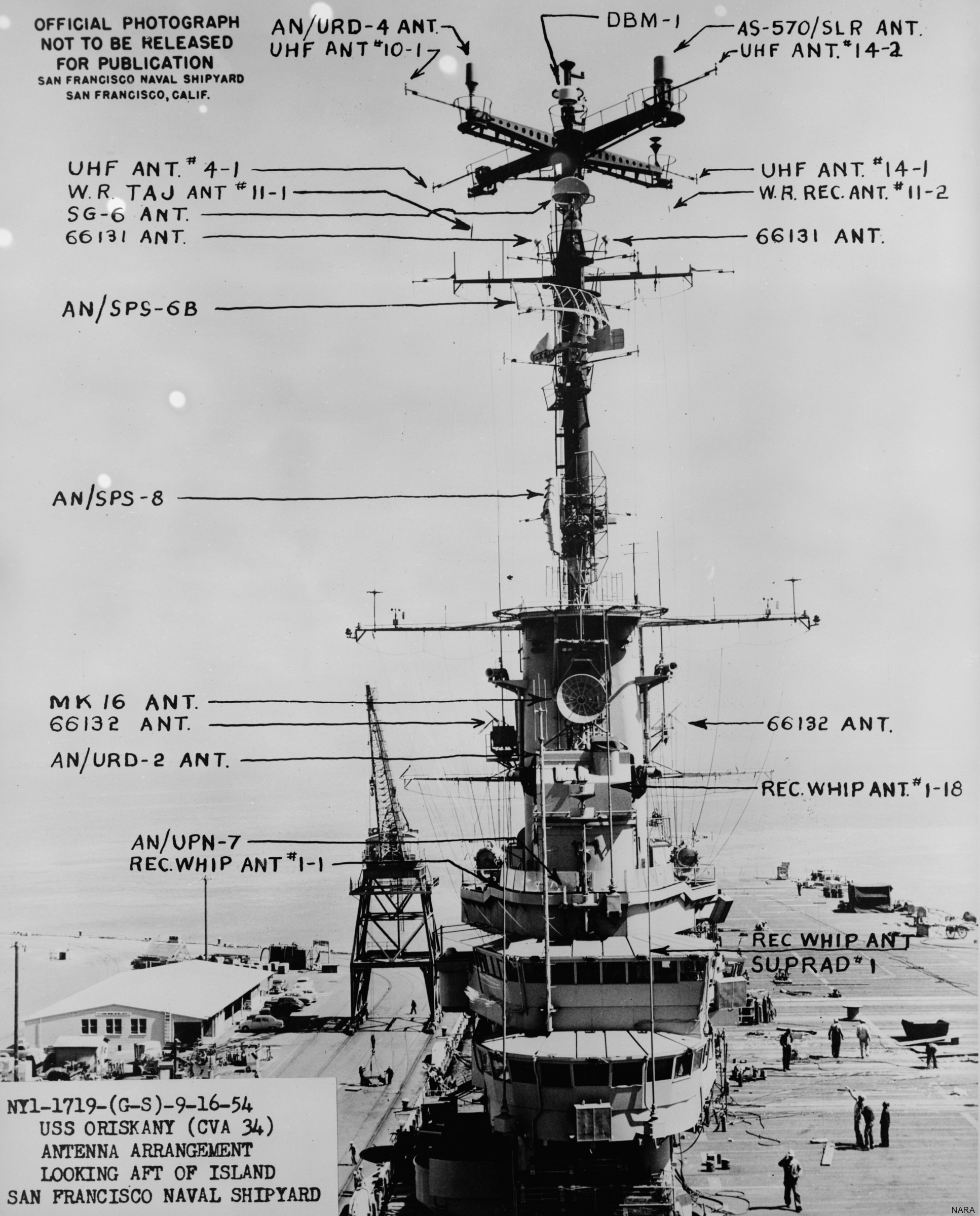 USS Oriskany (CVA 34) at San Francisco Naval Shipyard - September 1954 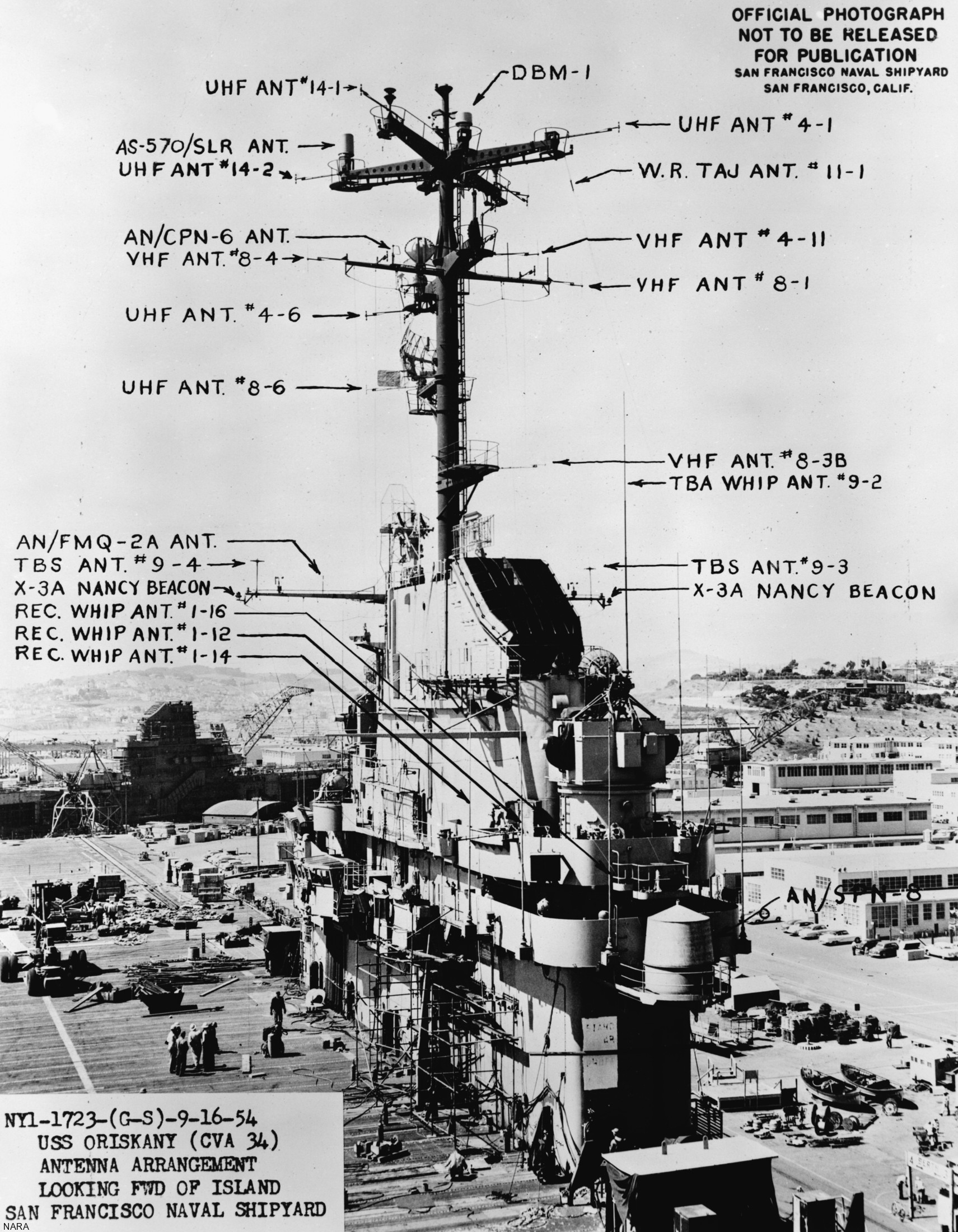 USS Oriskany (CVA 34) at San Francisco Naval Shipyard - September 1954 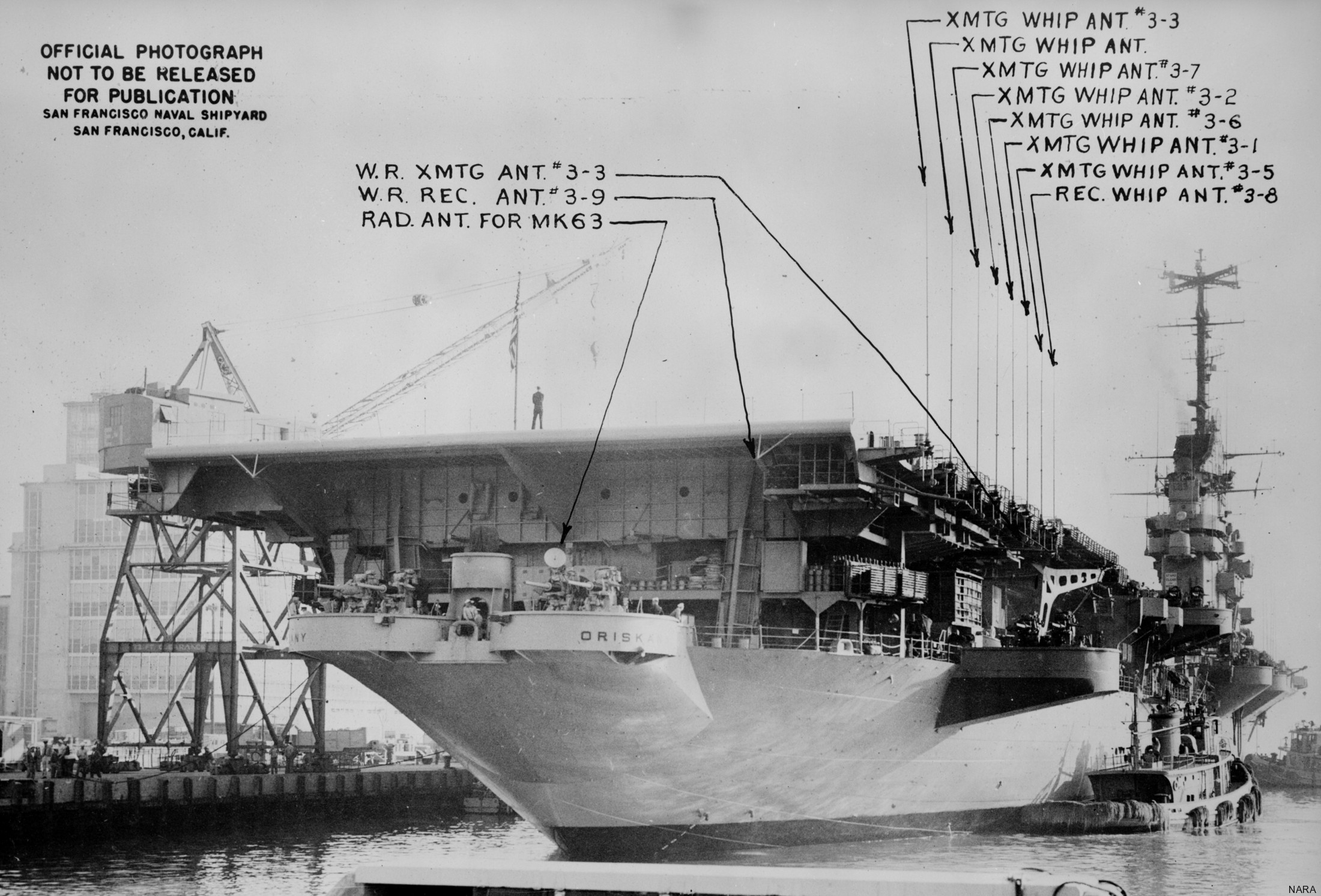 USS Oriskany (CVA 34) at San Francisco Naval Shipyard - September 1954 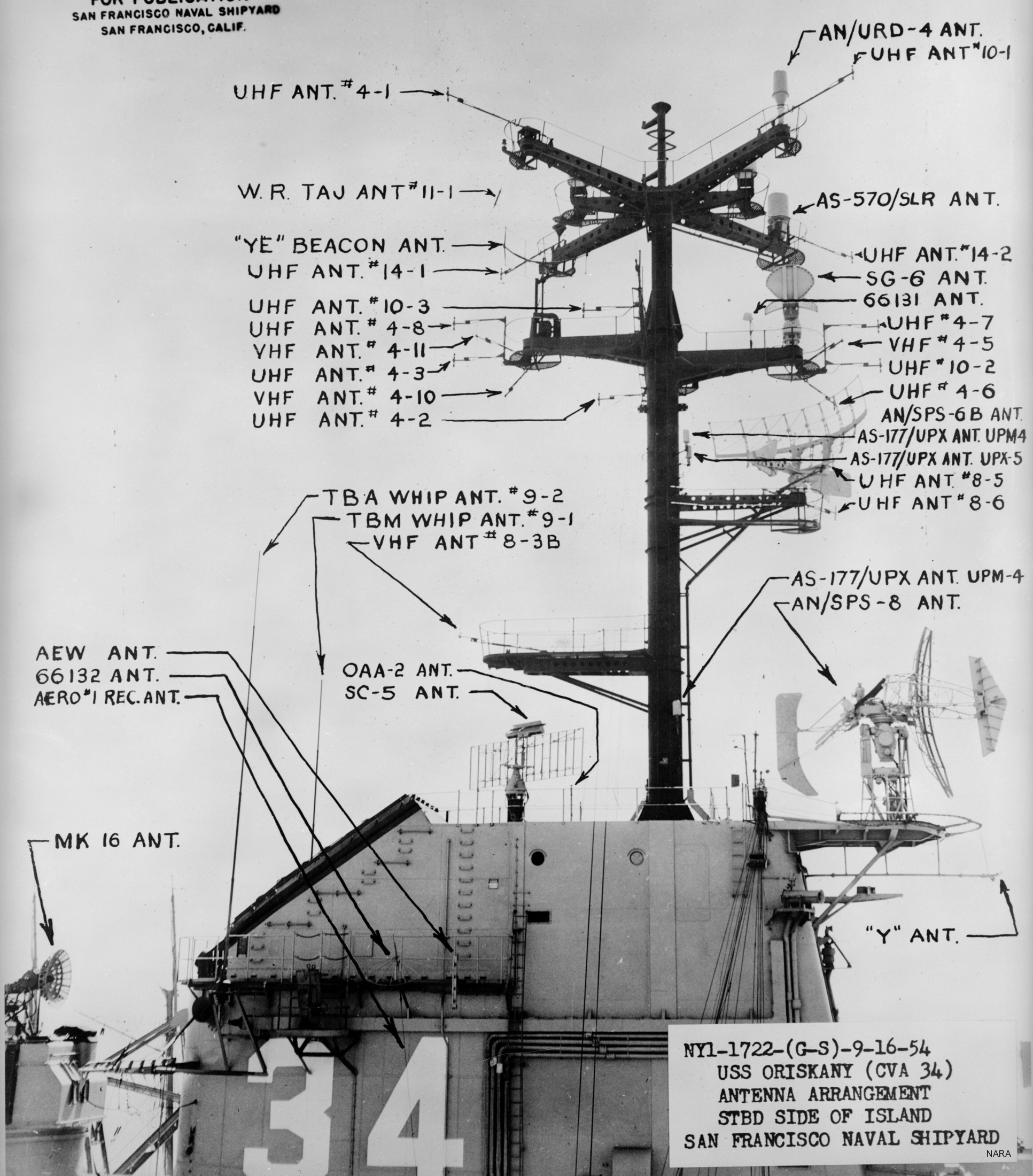 USS Oriskany (CVA 34) at San Francisco Naval Shipyard - September 1954 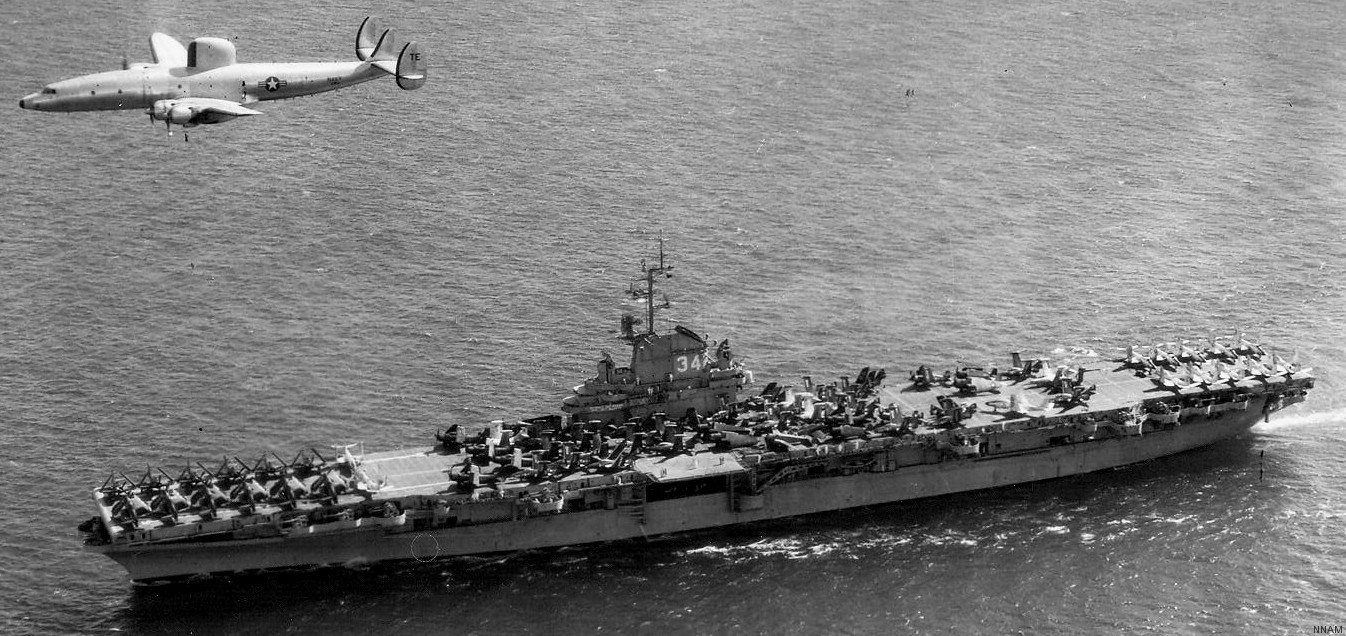 a Lockheed WV-2 Constellation flies over USS Oriskany (CVA 34) with Carrier Air Group 19 (CVG-19) embarked - April 1954  USS Oriskany (CVA 34) with Carrier Air Group 19 (CVG-19) embarked - April 1954 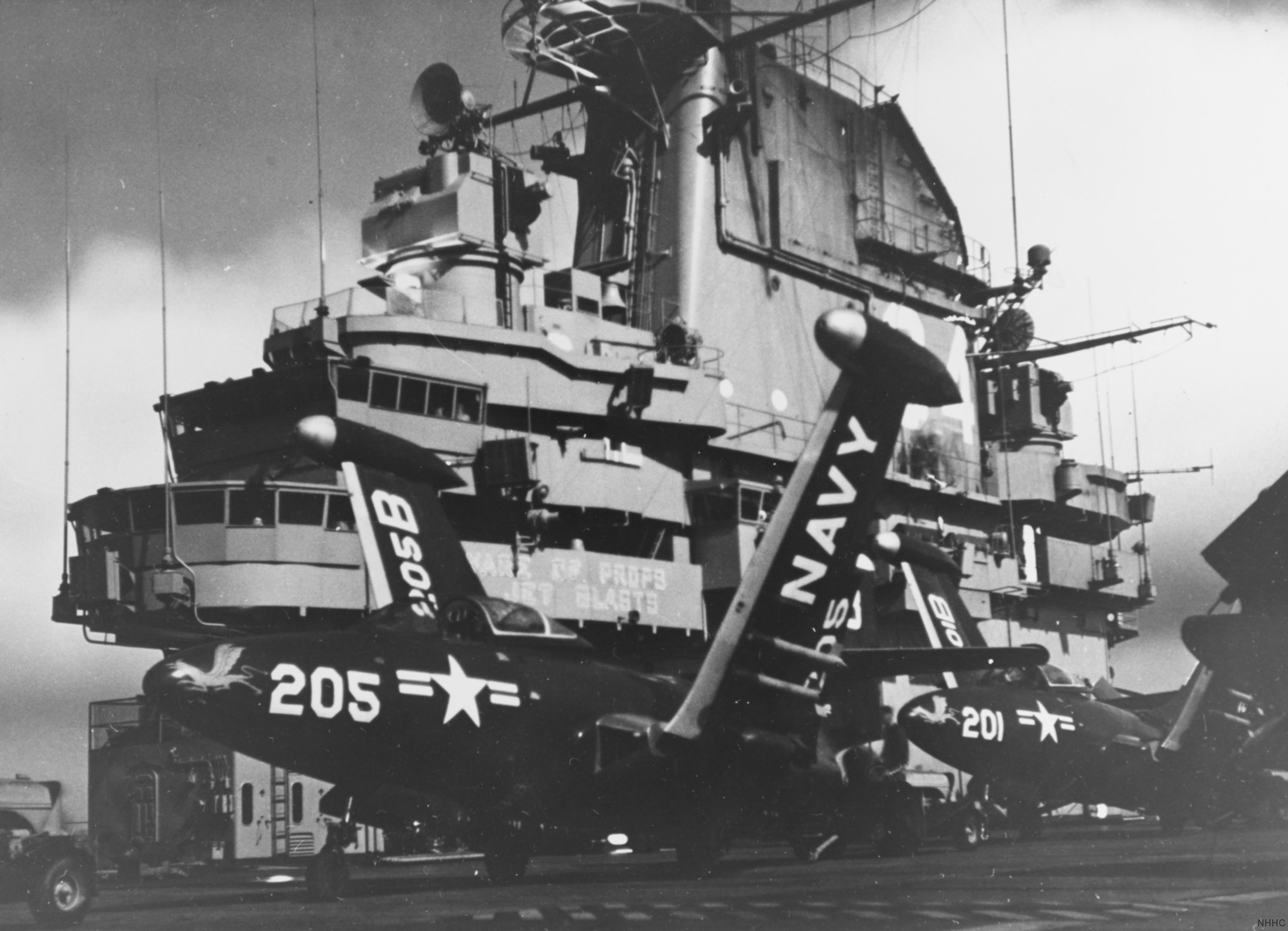 F9F-5 Panther of VF-192 aboard USS Oriskany (CVA 34) - March 1954 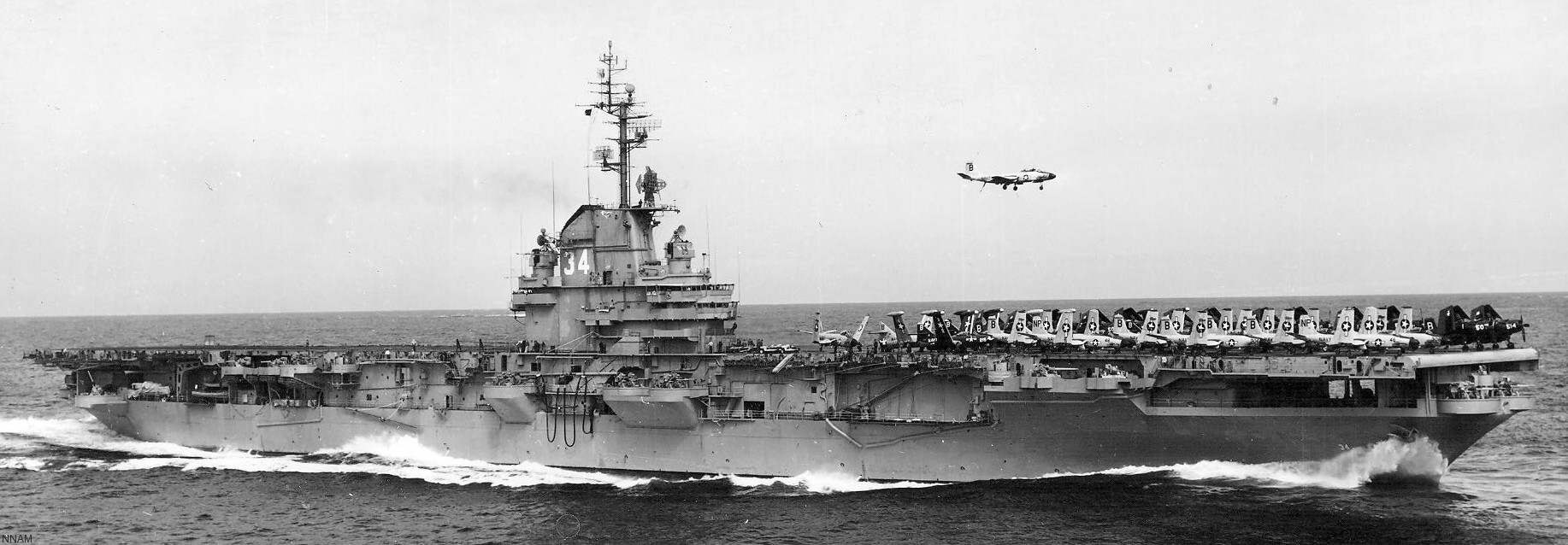 USS Oriskany (CVA 34) with Carrier Air Group 19 (CVG-19) embarked - March 1954 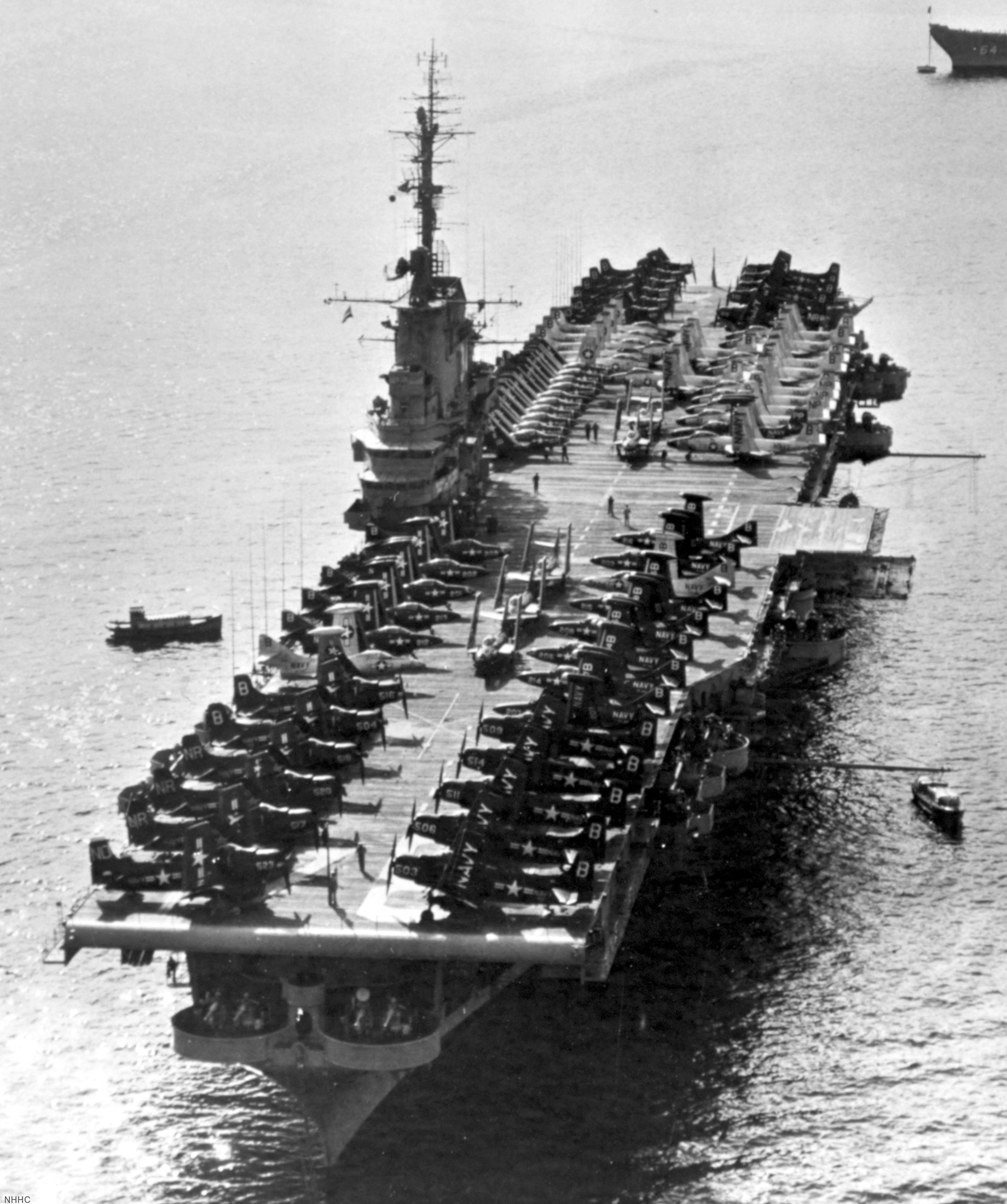 USS Oriskany (CVA 34) with Carrier Air Group 19 (CVG-19) embarked - Sasebo, Japan - October 1953 CV 34 (September 1950 - October 1952) 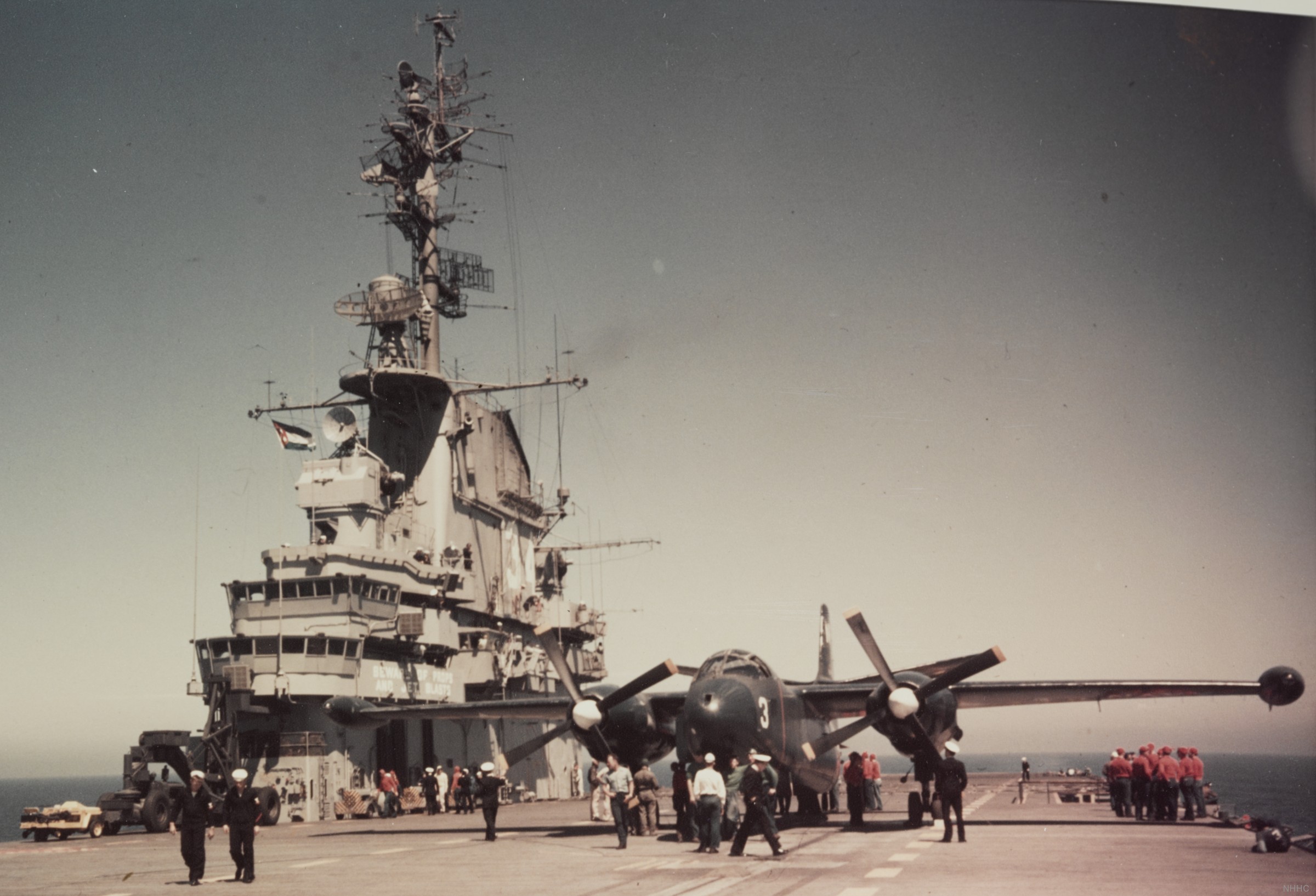 a North American AJ-1 Savage attack aircraft aboard USS Oriskany (CV 34) - August 1952 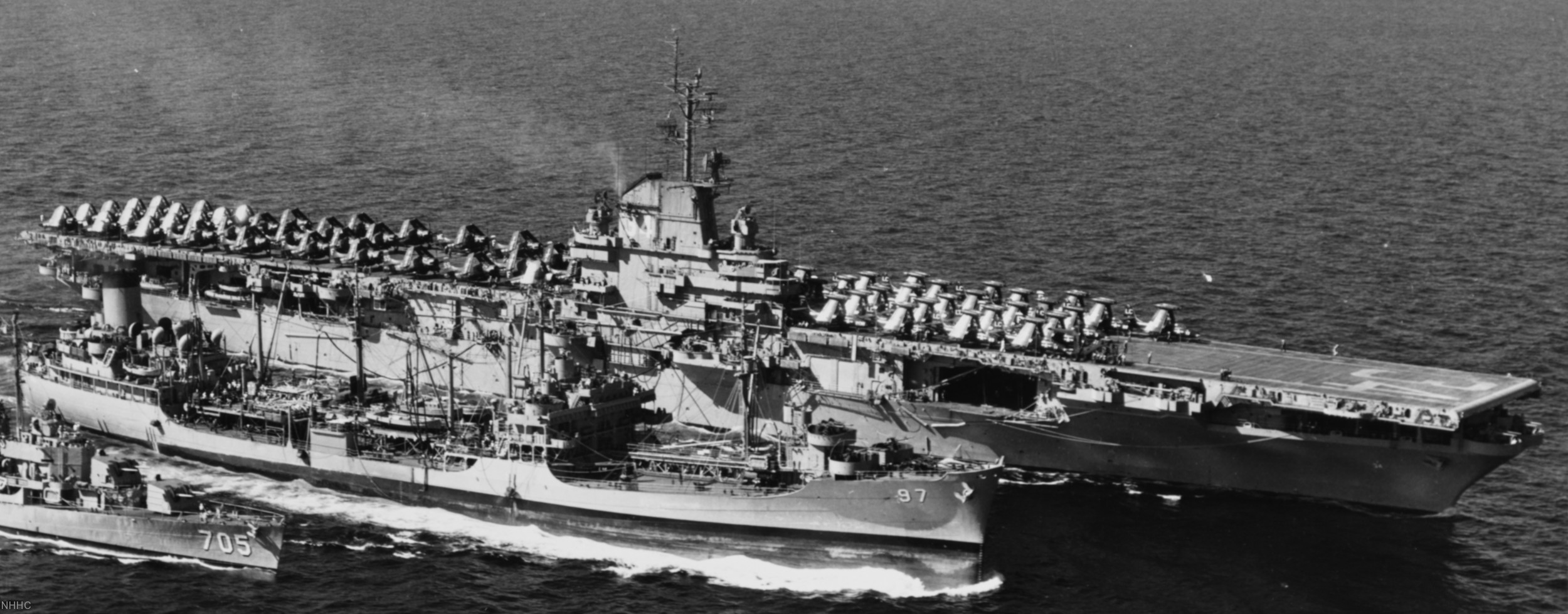 USS Oriskany (CV 34) with Carrier Air Group 4 (CVG-4) embarked - circa 1951 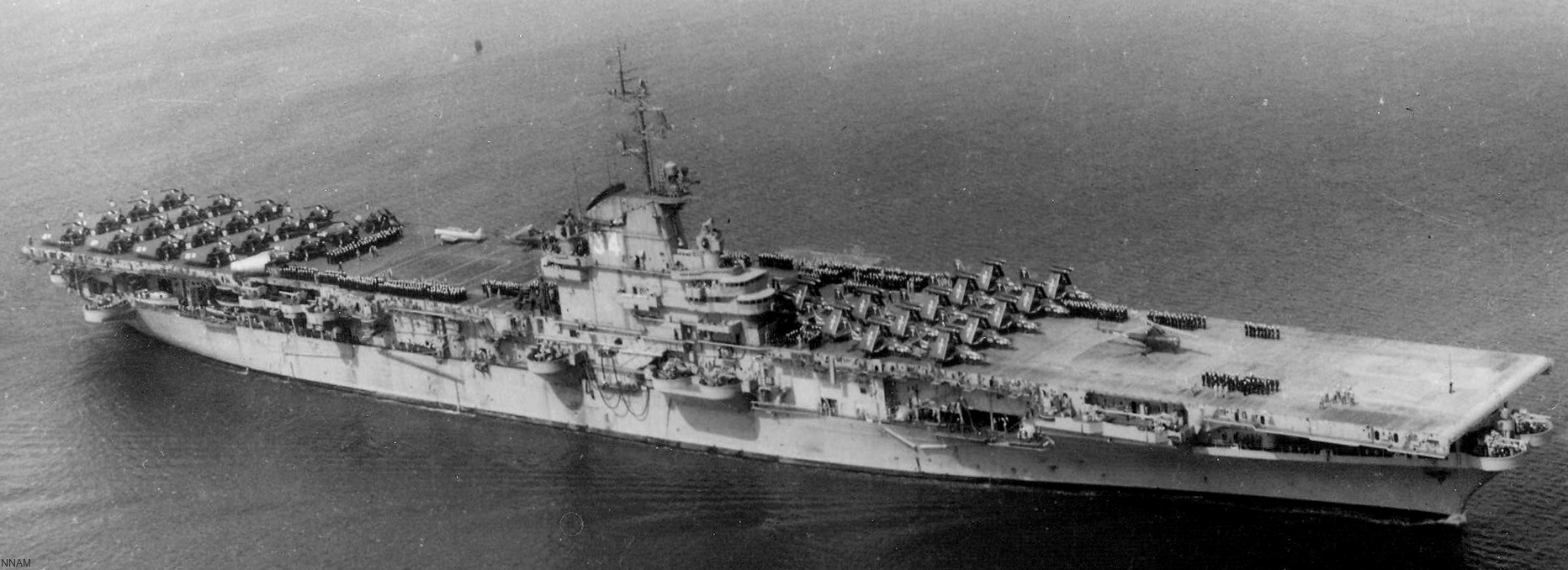 USS Oriskany (CV 34) with Carrier Air Group 4 (CVG-4) embarked - circa 1951 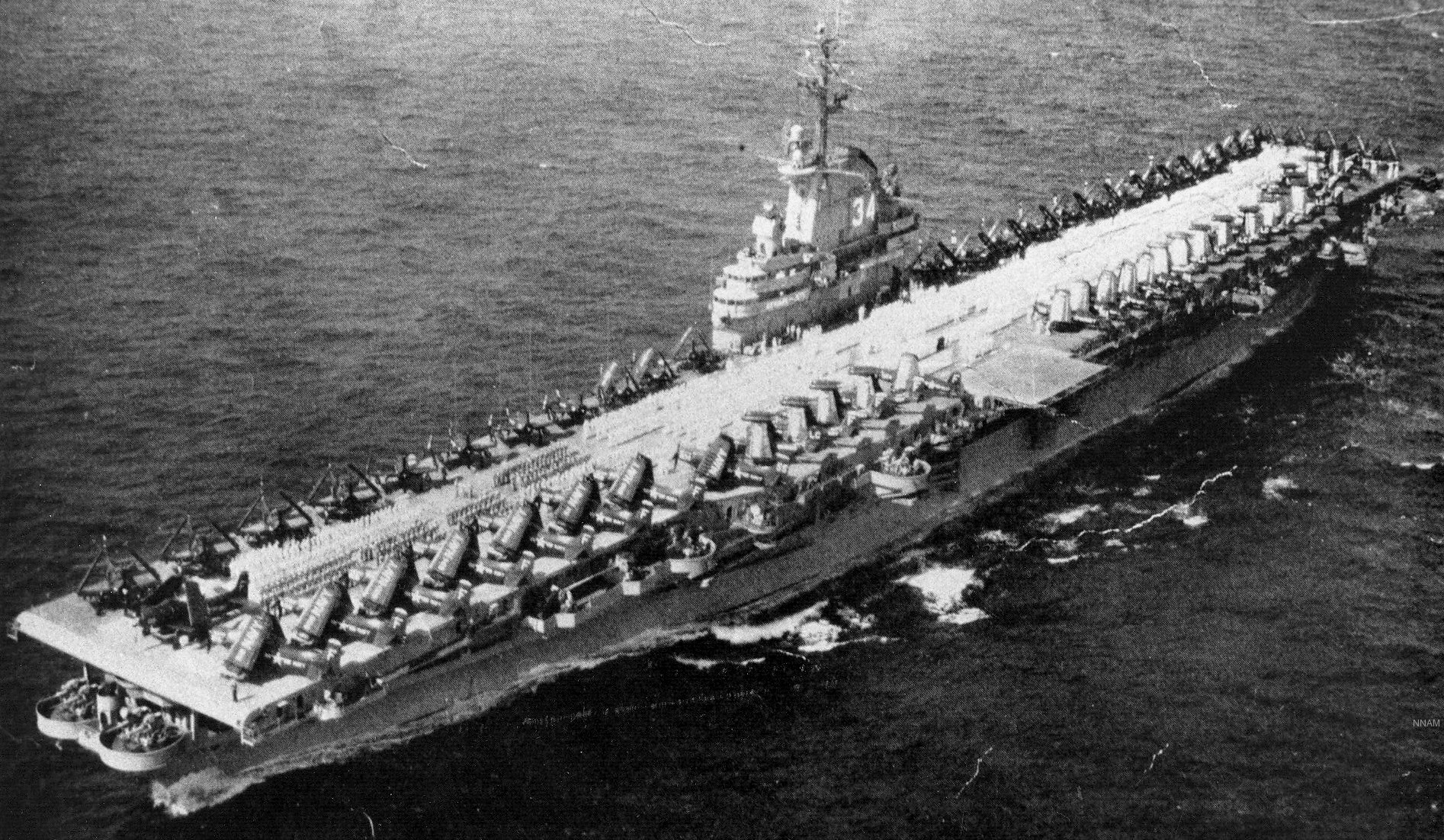 USS Oriskany (CV 34) with Carrier Air Group 4 (CVG-4) embarked - 1951 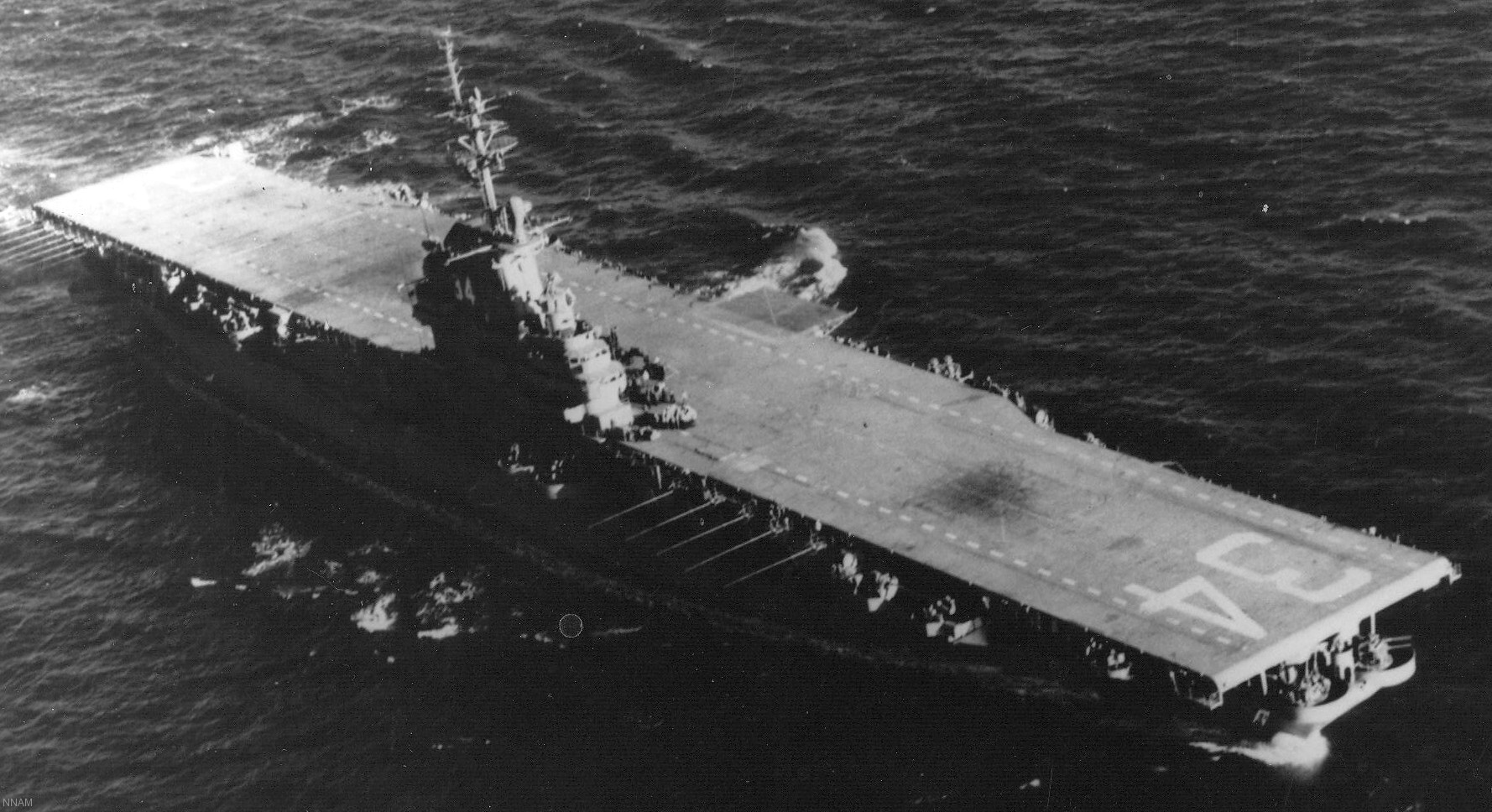 USS Oriskany (CV 34) - 1951  USS Oriskany (CV 34) - 1951 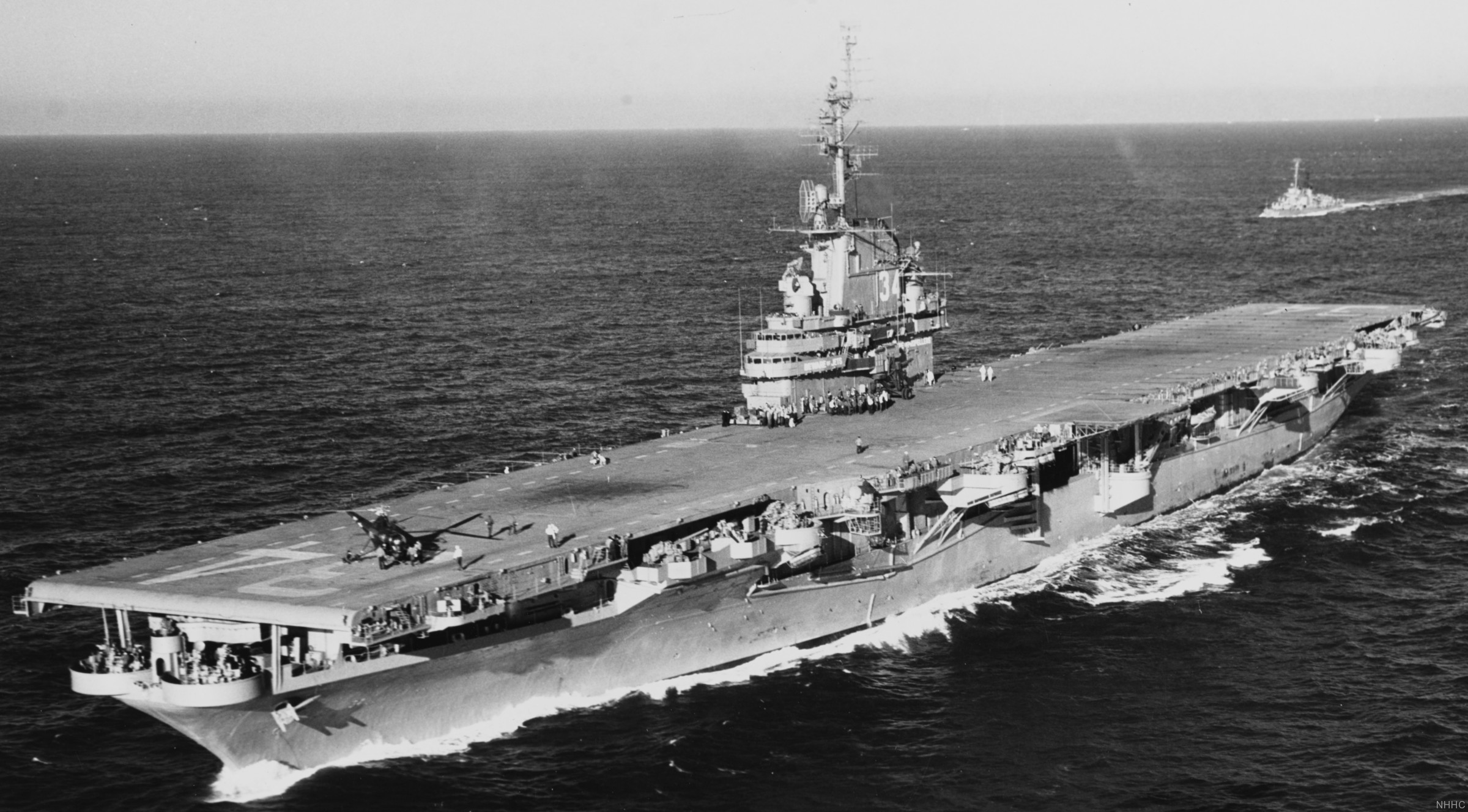 USS Oriskany (CV 34) - 1950 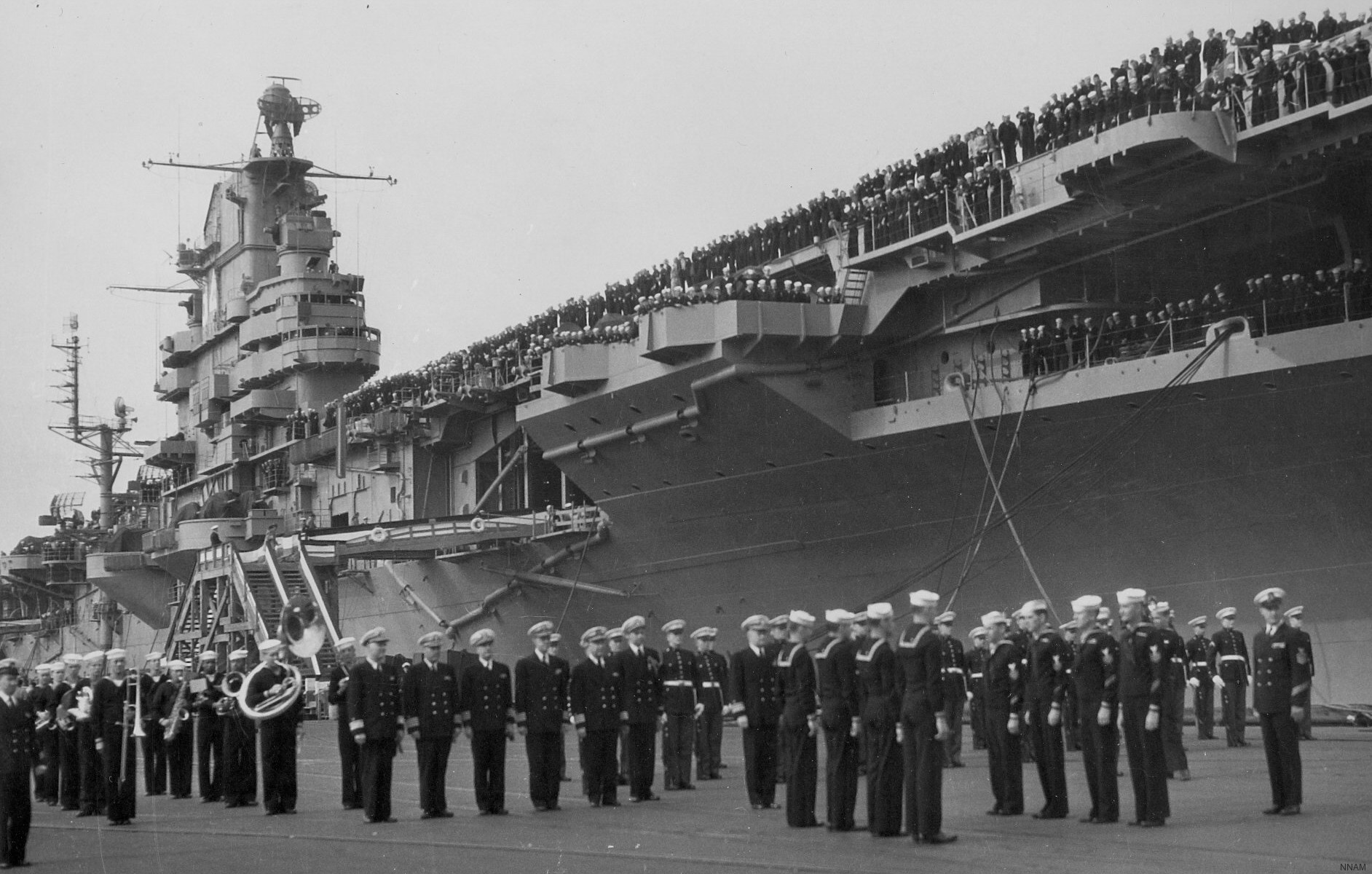 USS Oriskany (CV 34) - commissioning ceremony at New York Naval Shipyard, Brooklyn - September 25, 1950 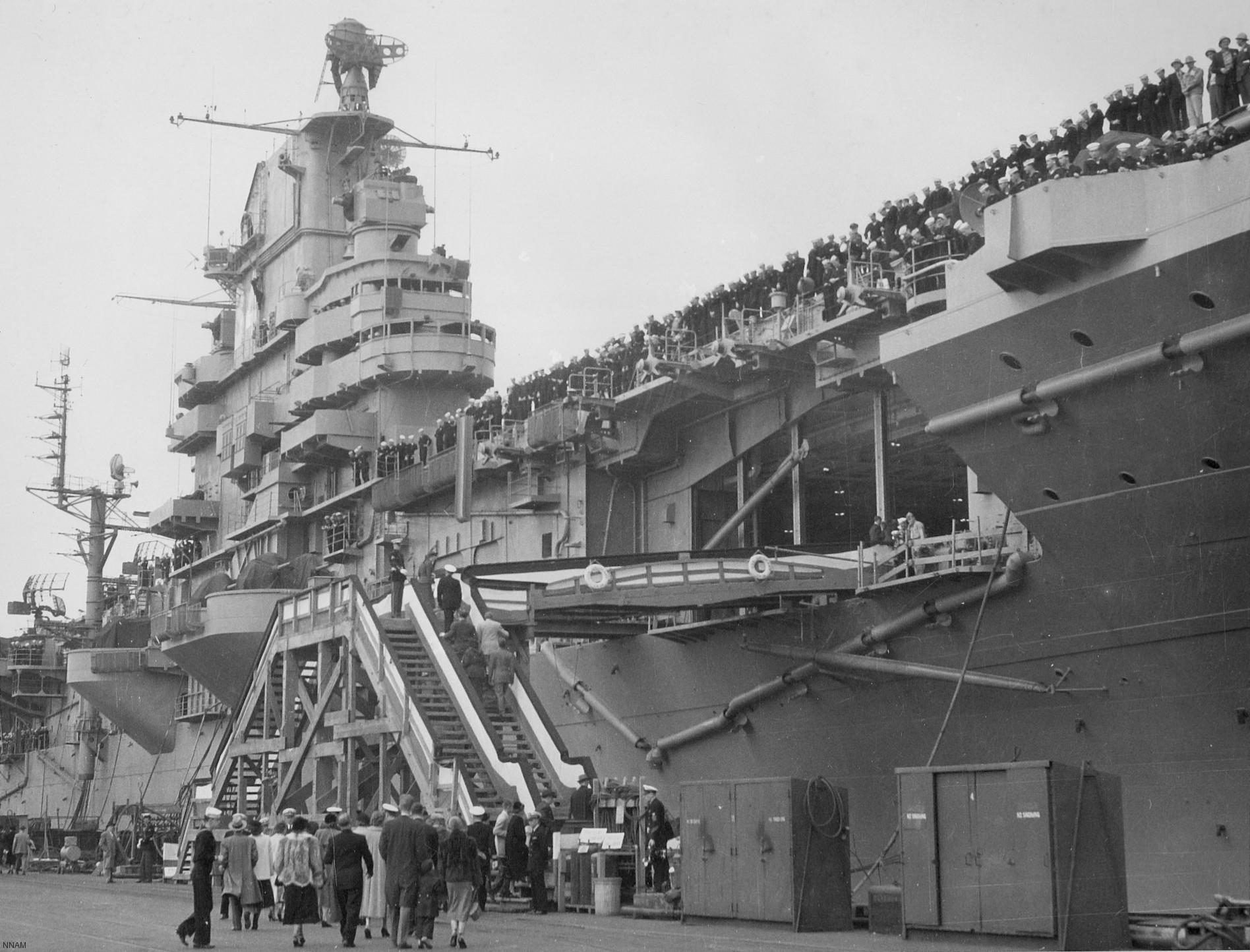 USS Oriskany (CV 34) - commissioning ceremony at New York Naval Shipyard, Brooklyn - September 25, 1950 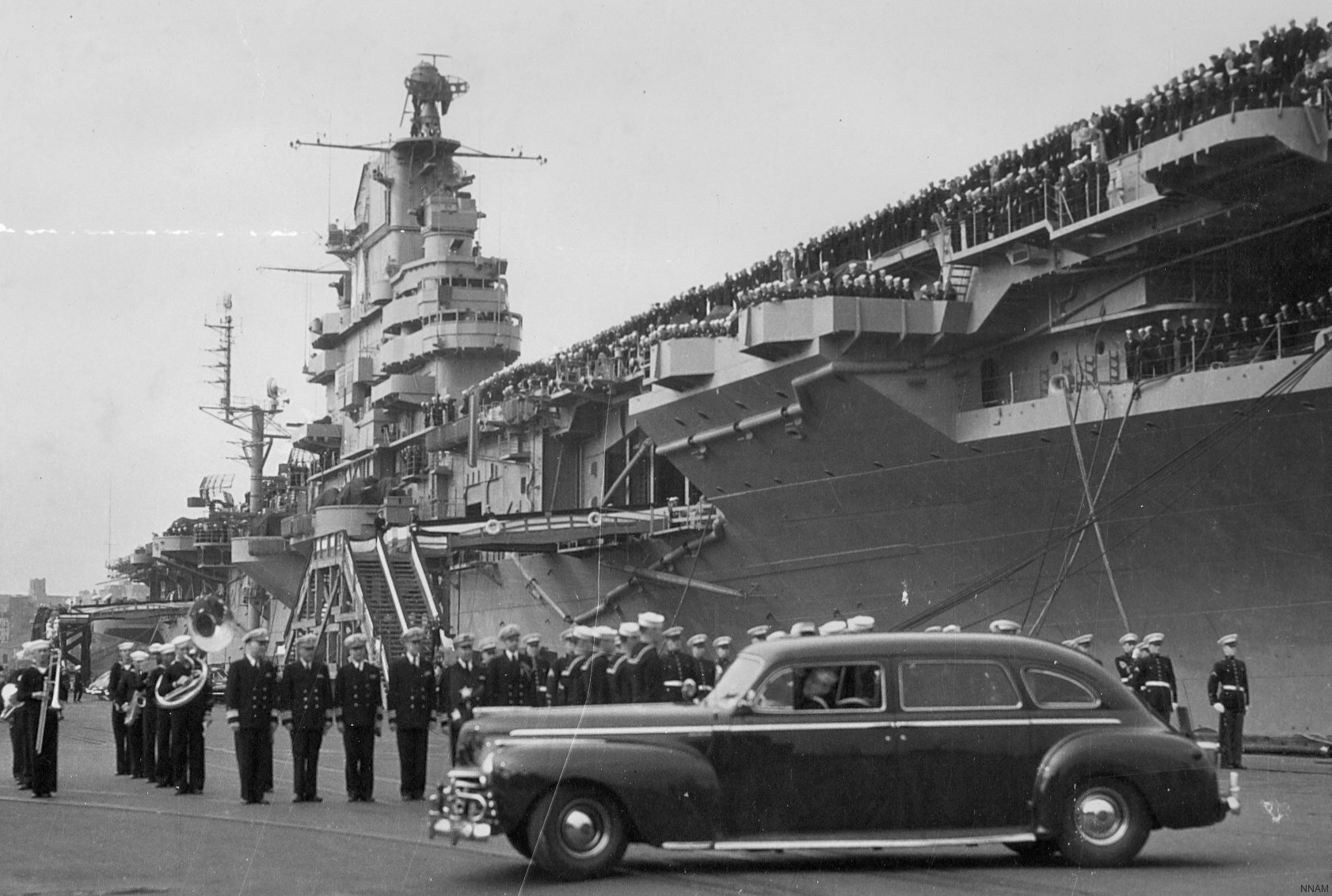 USS Oriskany (CV 34) - commissioning ceremony at New York Naval Shipyard, Brooklyn - September 25, 1950 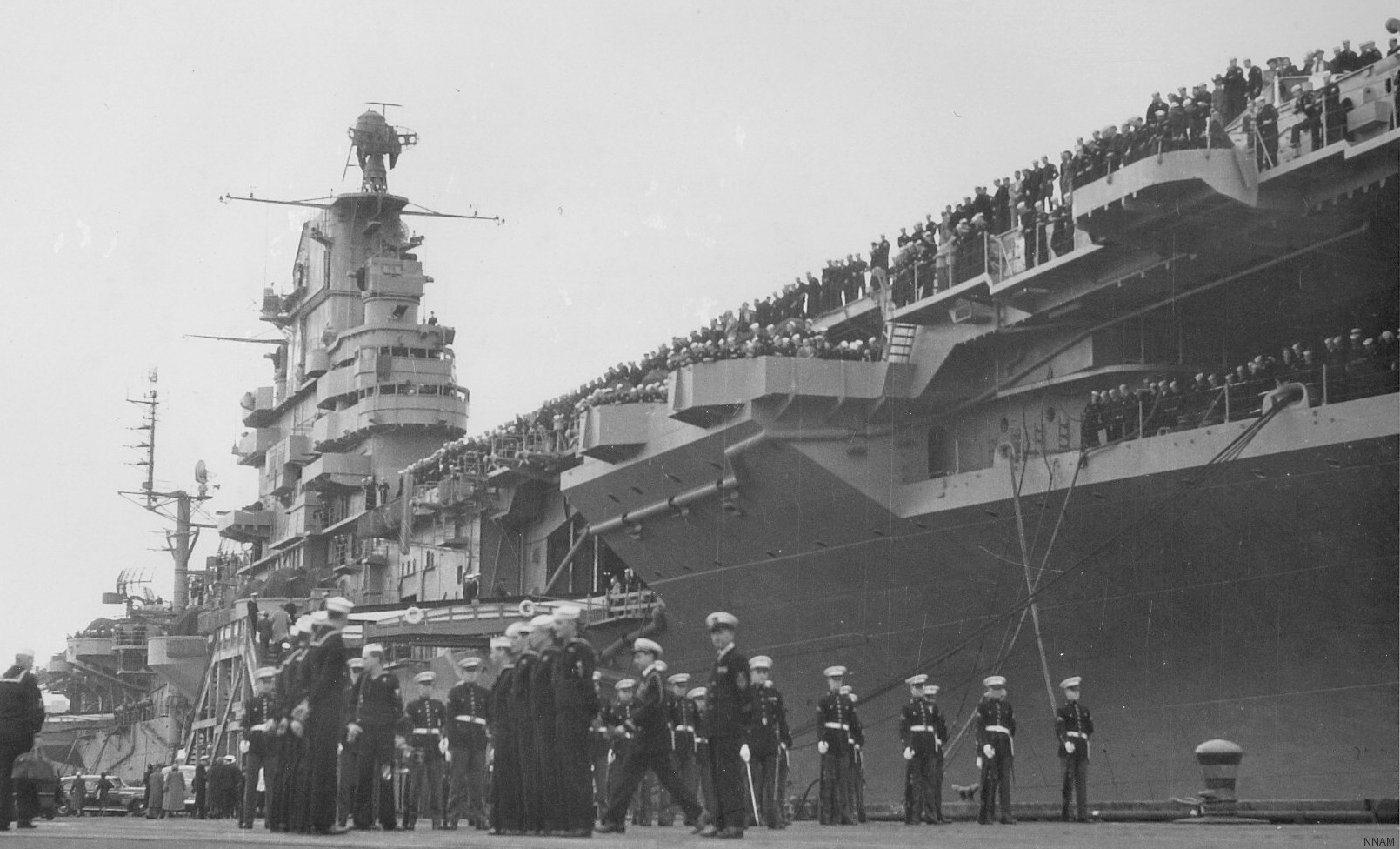 USS Oriskany (CV 34) - commissioning ceremony at New York Naval Shipyard, Brooklyn - September 25, 1950 |
||
|
The Battle of Oriskany on August 6, 1777 ... was one of the bloodiest battles in the American Revolutionary War and a significant engagement of the Saratoga campaign. A party of Loyalists and several Indian allies ambushed an American military party that was trying to relieve the siege of Fort Stanwix. This was one of the few battles in which almost all of the participants were Americans; Patriots and allied Oneidas fought against Loyalists and allied Iroquois in the absence of British regular soldiers. The Patriot relief force came from the Mohawk Valley under General Nicholas Herkimer and numbered around 800 men of the Tryon County militia plus a party of Oneida warriors. British commander Barry St. Leger authorized an intercepting force consisting of a Hanau Jäger (light infantry) detachment, Sir John Johnson's King's Royal Regiment of New York, Indian allies from the Six Nations, particularly Mohawks and Senecas and other tribes to the north and west, and Indian Department Rangers, totaling at least 450 men. The Loyalist and Indian force ambushed Herkimer's force in a small valley about six miles (10 km) east of Fort Stanwix, near the village of Oriskany, New York. Herkimer was mortally wounded, and the battle cost the Patriots approximately 450 casualties, while the Loyalists and Indians lost approximately 150 dead and wounded. The result of the battle remains ambiguous. The apparent Loyalist victory was significantly affected by a sortie from Fort Stanwix in which the Loyalist camps were sacked, damaging morale among the allied Indians. The battle also marked the beginning of a war among the Iroquois, as Oneida warriors under Colonel Louis and Han Yerry allied with the American cause. Most of the other Iroquois tribes allied with the British, especially the Mohawks and Senecas. Each tribe was highly decentralized, and there were internal divisions among bands of the Oneida, some of whom also migrated to Canada as allies of the British. The site is known in Iroquois oral histories as "A Place of Great Sadness."[6] The site has been designated a National Historic Landmark; it is marked by a battle monument at the Oriskany Battlefield State Historic Site. Oriskany, NY: Oriskany is a village in Oneida County, New York, United States. The population was 1,400 at the 2010 census. The name is derived from the Iroquois word for "nettles." The Village of Oriskany is in the Town of Whitestown, southeast of the City of Rome. NY-69 passes through the village, which is south of the Erie Canal. Oriskany is located at 43°9.4′N 75°19.9′W (43.1575,-75.3319). According to the United States Census Bureau, the village has a total area of 0.8 square miles (2.1 km2), all of it land. The village is near the confluence of the Mohawk River and Oriskany Creek. |
||
|
USS Oriskany (CV / CVA 33): Oriskany (CV-34), an attack aircraft carrier, was laid down 1 May 1944 by the New York Naval Shipyard; launched 13 October 1945; and sponsored by Mrs. Ida D. Cannon, wife of the Honorable Clarence Cannon, Congressman of the 9th District of Missouri. Owing to the end of the war and shrinking budgets her construction was suspended 12 August 1947. She remained in a state of preservation until after the outbreak of hostilities in Korea in June 1950, then rushed to completion. She commissioned in the New York Naval Shipyard 25 September 1950, Capt. Percy H. Lyon in command. After fitting out, Oriskany departed New York 6 December 1950 for two weeks of flight deck qualifications for Douglas AD Skyraider attack aircraft in Carrier Air Group (CVG) One, followed by a stop at Newport, R.I., for a Christmas call. The carrier sailed south in early January for flight operations with jet aircraft off Jacksonville, Fla., and to the West Indies for shakedown evolutions out of Guantanamo Bay, Cuba. After returning north to her new home port at Quonset Point, R.I., she steamed to Brooklyn for post-shakedown modifications at the New York Naval Shipyard between 6 March through 2 April. Oriskany departed Quonset Point on 15 May 1951 for a Mediterranean deployment with CVG-4 embarked. Chopping to 6th Fleet near Gibraltar, the aircraft carrier relieved Saipan (CVL-48) at Augusta Bay, Sicily, on 7 May. Over the course of the summer, the warship cruised throughout the Mediterranean, visiting ports ranging from Cannes and Golfe Juan, France, in the west and Izmir, Turkey, in the east. She also stopped at ports in Italy and Greece as well as visiting Tripoli in Libya, which was still under British administration while the United Nations worked to establish an independent Kingdom there. During this cruise Oriskany participated in Operation Beehive, a joint North Atlantic Treaty Organization (NATO) exercise with French, British and American forces. Highlights of this operation included supporting an amphibious landing exercise at Malta and a flyover by a British De Haviland 100 Vampire jet fighter. Oriskany returned to Quonset Point on 4 October 1951 and, after a month of post-deployment leave and upkeep, sailed west to Gravesend Bay, New York, to offload ammunition and to have her masts removed to allow passage under the East River Bridges. Entering the New York Naval Shipyard in mid-November, the aircraft carrier underwent her first major overhaul. Yard work included the installation of a new flight deck to make it easier to operate jet aircraft and modifications to the steering system and bridge layout. Work was complete by 15 May 1952 and the carrier put to sea the next day to take on ammunition at Norfolk 19-22 May. She then got underway to join the Pacific Fleet, steaming via Guantanamo Bay, Cuba; Rio de Janeiro, Brazil; Valparaiso, Chile; and Lima, Peru; before arriving at her new home port at San Diego, Calif. on 21 July. During this transit, Oriskany received a visit from Brazilian President Get-lio Vargas on 20 June during a stop at Rio de Janeiro and, on 29 June, became the first American aircraft carrier to sail around Cape Horn. According to the Oriskany cruise book, the warship, after turning north along the coast of Chile, steamed through seas so rough that the crew had to sit on the mess hall decks to eat. After settling in to her new home port at San Diego, and receiving repairs and maintenance at San Francisco and Long Beach Naval Shipyards that summer, Oriskany conducted carrier qualifications for CVG-102. The Air Group, comprised of two fighter squadrons equipped with Grumman F9F Panther jets, a third fighter squadron with Vought F4U Corsairs, an attack squadron with Douglas AD Skyraiders and a Sikorsky HO3S helicopter squadron, was preparing to join the carrier for a combat deployment to Korea. Oriskany also embarked detachments from four composite squadrons, including photo reconnaissance aircraft and F4U night fighters. In the middle of these evolutions, the warship received a visit from King Faisel II of Iraq, who was on a tour of the United States, and Vice Admiral Harold M. Martin, Commander Air Forces, Pacific Fleet. Oriskany got underway from San Diego on 15 September 1952 and sailed for the combat zone. Just over a week later, during routine flight operations, a Skyraider from VA-923 suffered a mechanical failure forcing Lcdr. Allan H. Gunderson to ditch his aircraft at sea. He was promptly rescued by a Sikorsky HO3S-1 helicopter flown by Lt(jg) Bernard W. Taylor and Airmen J. W. Mills from the HU-1 detachment. During the transit Oriskany was also redesignated an attack aircraft carrier (CVA) on 1 October 1952, a Navy-wide change intended to mark the distinction between anti-submarine carriers (CVS) and the attack versions. She arrived at Yokosuka, Japan, on 17 October. Following operational briefings and other preparations, the aircraft carrier joined Bon Homme Richard (CVA-31) and the rest of Task Force 77 off the east coast of Korea on 31 October. After a few days of familiarization, Oriskany commenced combat operations on 2 November 1952. Owing to the shorter range of her jet aircraft, combat sorties were split between two general target areas, with the piston-engine Corsairs and Skyraiders attacking supply areas near Pyongyang, North Korea, and the Panthers conducted bombing and strafing reconnaissance runs along the east coast north of Wonsan. The focus of attack operations for her first line period was close air support to front line combat forces, interdiction of enemy supply lines and air support for naval gunfire strikes along the coast. Although poor weather cancelled flights for four days in the middle of November, and she held three other replenishment days, Oriskany flew a total of eleven days of combat missions over her two and half weeks on the line. Highlights of her operations included "night heckler" missions, with fighter and attack aircraft strafing and bombing communist truck convoys, air strikes on enemy front line positions, and multiple road and bridge cuts near Yangdok. The most dramatic moment occurred on the afternoon of 18 November 1952, when four Oriskany Panthers on routine combat air patrol (CAP) over TF 77 were vectored to intercept seven enemy MiG-15 swept-wing jet fighters detected by radar. In the resulting fifteen-minute melee, the Panthers shot down two enemy MiGs and damaged two others, with Lt. Royce Williams and Lt (jg). John Middleton from VF-781 receiving credit for the victories. The action was the first multi-jet aerial dogfight by Navy aircraft, and it illustrated the importance of training and experience. These combat operations were not cost free, however, with the Air Group losing two aircraft in combat and four others damaged by ground fire. The first loss took place on 4 November, when VA-923 pilot Ensign Andrew L. Riker's Skyraider was shot down by ground fire south of Wonsan. A second VA-923 pilot, Lt. George A. Gaudette, was killed on 15 November when his AD-3 spun out during a bombing run and crashed into a mountain side. The flight deck gang suffered a death as well on 5 November, when Airmen John M. Guldhorn slipped and fell under the wheels of an F4U Corsair and was killed. Returning to Yokosuka on 19 November 1952, the aircraft carrier spent the next two weeks repairing and maintaining the warship and embarked aircraft and loading supplies and ammunition for another line period. Oriskany resumed combat operations on 4 December with strikes near Pyongyang, an evolution that saw one Skyraider severely damaged by anti-aircraft fire. The pilot, Ensign Willis E. Radebaugh of VA-923, managed to keep the plane aloft until back over friendly territory and parachuted to safety. Two days later another pilot ditched at sea off Hungnam after his Corsair was damaged by ground fire. Lt. William P. Hughes, VF-874, was rescued by a small boat from Rooks (DD-804) after spending about forty-five minutes in a life raft. Air attacks during the first week on station included supply dumps, trucks, rail cars and dock facilities near Pyongyang, Wonsan and Sinpo. After replenishment on 7 December, the campaign against North Korean railroads continued along the northern cost of the peninsula, with box cars strafed and bridges and rail lines cut near Hungnam and Hyesanjin, the latter city near the Manchurian border. In the midst of combat operations on 9 December, Oriskany also received a visit from Capt. James A. Van Zandt, USNR, member of the House of Representatives from the 22d district of Pennsylvania and a member of the Armed Services Committee. After replenishing again on the 11th, the air group spent three days pounding targets near the frontline near Kilchu, helping to relieve pressure on friendly ground forces in the area. On 16 December, despite abysmal weather, the entire air group conducted a major strike on railroad facilities at Hyesanjin. The campaign against North Korean supply lines along the east coast continued for another week, with many strikes rewarded by numerous secondary explosions. VA-923 lost a third pilot, however, when LT(jg) James A. Hudson's Skyraider failed to pull out of a near vertical dive and crashed near Songjin. The intensity of the campaign was also illustrated by the thirteen additional planes damaged by ground fire. Oriskany returned to Yokosuka on 27 December. The warship carried out a third line period beginning on 10 January 1953. High seas and inclement weather prohibited combat operations for the next four days and it was not until the 15th that Oriskany aircraft began attacking enemy targets. Over the next three days, jets and "props" bombed and strafed supply concentrations, enemy bivouac areas and logistic routes in the Wonsan area, teaming with two other aircraft carriers and surface forces for an all-out bombardment of the Wonsan area. Later in the month enemy positions were targeted up the east coast of North Korea, ranging as far north as Chongjin. Aircraft also targeted enemy trenches and gun positions near the front lines in support of friendly troops. On 26 January, a Corsair piloted by Ens. David L. Brenner was hit by ground fire and forced to ditch off Hungnam. Although suffering from shock and, as put by his rescuers, "an over-indulgence of sea water," he managed to get into the rescue sling and was successfully picked up by Lt. William W. Wear and 1st Lt. James W. Wood flying in a Sikorsky HO3S-1 from Los Angeles (CA-135). Oriskany's aircraft continued to pound enemy targets through the end of the month, though February began on a grim note when Cdr. John C. Micheel, Commander of VA-923, died in a Skyraider crash on the 1st after enemy ground fire sheered off a wing of his aircraft. Two days later a second pilot ditched his aircraft, this time a Panther from VF-781 that put down in Wonsan harbor. The pilot was rescued by friendly boats. In the first week of February, aircraft began to focus on supply targets near the front lines, a task that continued until 11 February when Oriskany returned to Yokosuka. During the latter operations, the Air Group and component squadrons were all redesignated, with CVG-102 becoming CVG-12 and, for example, VA-923 becoming VA-125. Following a brief upkeep period in Japan, Oriskany put to sea on 1 March 1953 for her fourth line period, Rear Admiral Robert F. Hickey, Commander, Carrier Division Five, embarked. The carrier began combat operations on 4 March 1953 with a small strike on a supply depot south of Wonsan. The next day Oriskany launched a major attack on Hungnam and a series of "heckler" and armed reconaissance runs along the east coast. On the 6th, the "props" turned to bombing depots, trenches and bunkers south of Wonsan and near Hamsong. In the middle of these strikes one F4U piloted by Lt. Edwin L. Kummer, VF-124, developed engine trouble shortly after take off. Aborting the mission, Kummer tried but was unable to jettison all his ordnance, as one 250-pound bomb "hung-up" on the bomb rack. Hung ordnance was an infrequent but not unusual problem at that time and Kummer was given permission to land. Unfortunately, as his Corsair hit the deck, the general purpose bomb broke loose, bounced up the flight deck and exploded over the No. 3 elevator, killing two Sailors and wounding fourteen others. One of the men killed was Photographer Airman Thomas L. McGraw, killed while filming landing operations, while the other was Aviation Electrician Airman Thomas M. Yeager, who died working on a tied down Panther. The explosion riddled the hangar deck below with shrapnel, piercing many of the parked aircraft and flooding the hangar bay with gasoline. Firefighting teams quickly extinguished the fire and isolated the hangar deck, preventing the fire from spreading into the ship. At the same time, Airman Richard D. Donovan, then serving as "hotsuit man," ran through the flames, cut the unconscious pilot from his harness and pulled him to safety. Damage repair crews put the aircraft carrier back in business within hours and Oriskany began launching airstrikes again on 8 March, targeting railroad tracks, bridges and facilities. On the 13th, Ens. David B Place's Skyraider was damaged by ground fire near Kowan and he ditched in Wonsan harbor. He was rescued in less than 15 minutes by a Sikorsky HRS-2 helicopter crewed by Lt. Richard G. Brand and AD2 R. L. Welch from LST-735. Starting on the 16th, the air wing shifted attacks against enemy troop positions behind the front lines, demolishing trenches, gun positions and supply points. After a massive single day strike on Chongjin on 21 March, the air wing shifted back south to the front line, bombing supply and support areas. Tragedy struck on the 22d in the midst of these operations when an F9F-5 splashed into the water and burst into flames just after catapulting off the flight deck, killing Lt(jg) Ralph N. Mew. In between bouts of poor weather, CVG-12 pilots continued bombing enemy rail lines, troop concentrations and gun positions for the next week. The highlight of this phase of the deployment was a volunteer three-plane strike on 27 March against a heavily defended highway bridge south of Hamhung that demolished sixty yards of bridge at the center. Besides the two plane losses noted above, the toll on aircraft continued during this line period, with fifteen aircraft damaged by enemy ground fire and another that rolled overboard in rough seas. On 29 March 1953, Oriskany turned south and sailed to Hong Kong for some well deserved rest and recreation. While the ship was enroute to that port on the 31st, a plane handler was accidentally blown overboard by a taxiing jet aircraft. Luckily, Lt(jg) Bernard W. Taylor, the pilot of the Sikorsky HO3S-1 helicopter on plane guard station, spotted AN Joseph Sheppard fall into the water and the airmen was rescued in under a minute. Departing that port on 8 April, the warship returned to Korea and commenced her fifth tour on the line starting on the 11th. Air strikes focused on close air support missions in support of friendly ground troops, part of an intensifying United Nations' bombardment effort during the truce negotiations at Panmujon. Planes bombed and napalmed trenches, bunkers and gun positions. In between these operations the aircraft returned to Chongjin for logistical strikes and conducted target of opportunity attacks on enemy trains and trucks. On 13 April, a Panther from VF-122 suffered an engine flame out during a photo reconnaissance mission and tried to ditch at sea. The sea state was too rough, however, and LT(jg) Roy Taylor was killed when the plane broke apart on impact. A second F9F-5 was lost on 20 April when flak damage put the jet in an uncontrolled spin and it splashed into the sea, killing Ens. Randolph T. Scoggan, VF-121. Another nine aircraft were damaged by enemy ground fire. The 21st of April, the last day of the tour, was "Boy-san Day," when pilots got to select their own targets. Four pilots decided to return to the Hamhung highway bridge and successfully took down three complete sections following hits by six 1,000-pound bombs. Relieved by Valley Forge (CVA-45), Oriskany departed Korea on 22 April, touched at Yokosuka, and then sailed for home on 2 May, arriving at San Diego on 18 May. Following voyage repairs and readiness training along the California coast that summer, Oriskany departed San Francisco on 14 September 1953 for her second cruise to the Far East, arriving at Yokosuka on 15 October. Although the Korean truce was holding, the atmosphere was anything but peaceful, with tensions between the United States and the Soviet Union running high. The Chinese communists were also on a hair trigger, as was attested by numerous attacks on American reconnaissance aircraft in the region. The aircraft carrier flew thousands of air patrol and routine training sorties over the winter as the warship patrolled in the Sea of Japan, the East China Sea, and in the Philippines. Oriskany also played host to various Hollywood notables filming The Bridges at Toki-Ri, including William Holden, Mickey Rooney, Frederick March and director Mark Robsen. The ships' crew and airmen starred with the carrier as background for the film, and many played bit parts and crowd scenes. In March 1954, the aircraft carrier provided air support for Marine amphibious assault exercises at Iwo Jima, the largest such operation since the close of the Korean War. During these evolutions, Oriskany crewmembers witnessed a spectacular jet crash on 31 March, when a McDonnell F2H-3 Banshee came in too low and crashed the beginning of the flight deck. Breaking in two, and enveloped in a huge fireball, the forward half of the jet careened across the deck, trailing fire and debris. Fire fighters got to the scene almost immediately and helped Lt. Frank J. Repp climb out of the cockpit without a scratch. Following the exercises off Iwo Jima, the aircraft carrier steamed for home. Shortly after arriving in San Diego on 22 April 1954, Oriskany sailed north to the San Francisco Naval Shipyard for a six-month modernization overhaul. The yard work included the installation of a new jet fuel system, improved arresting and barricade gear for the flight deck and the usual equipment modifications and repairs. The aircraft carrier departed San Francisco on 22 October and spent the winter months on shakedown and refresher training evolutions off California. Upon completion she spent the holidays in her new home port of Alameda and commenced local operations. In February 1955, Oriskany "officially adopted" Alameda Girl Scout Troop 61, and volunteers from the crew helped refit and paint the troop sailboat, which was redesignated "Mariner Scout Ship No. 34" to coincide with Oriskany's hull number. In a more serious light, the aircraft carrier carried out qualifications for her aircraft squadrons in early March, following which she got underway for her third Far East deployment. Arriving at Yokosuka on 2 April 1955, Oriskany operated with the Fast Carrier Task Force of 7th Fleet in the western Pacific, sailing in the South China Sea and waters off Japan and the Philippines. During the six weeks after her arrival in Japan, U.S. Navy ships finished up Operation "Passage to Freedom," the post-Geneva Accords evacuation of Vietnamese who did not wish to live in communist-controlled North Vietnam. Over the course of the ensuing summer, Oriskany flew thousands of sorties in support of overseas presence operations off China and visited widely in the Far East, including Hong Kong, Manila and ports in Japan and Okinawa. At the very end of the cruise, a PV2 Neptune reconnaissance plane from VP-19 based out of Japan was shot down by Soviet MiG fighters off the coast of Siberia. The aircraft successfully ditched and nine of ten crewmen were saved. Although tensions spiked immediately thereafter, it was not enough to keep Oriskany in the region and she sailed for home three days later, arriving at Alameda on 21 September. The aircraft carrier also won the coveted Battle Efficiency ("E") Award, having carried out a high tempo of operations with 5,978 sorties during this cruise. Three days after arriving home, in a ceremony attended by the mayors of Alameda and Oakland as well as Congressman George P. Miller, 8th District of California, the crew presented Girl Scout Troop 61 with a new sailboat: a small sampan purchased in Hong Kong, painted a vivid red and black and equipped with a four-cylinder engine and even running lights! The little craft was christened by Congressman Miller, who broke a bottle of ginger ale across the sampan's bow. Following voyage repairs and refresher training, the attack carrier carried out qualifications for the pilots of CVG-9 and other pre-deployment evolutions over the winter. She put to sea from Alameda on 11 February 1956 for her fourth western Pacific deployment. The cruise was relatively uneventful and Oriskany returned to San Francisco on 13 June to prepare for a major modernization program. As part of the Essex-class modernization program approved in May 1954, Oriskany entered San Francisco Naval Shipyard on 1 October, decommissioning there on 2 January 1957. Over the ensuing 26 months, shipyard workers stripped and completely rebuilt the flight deck to include an angled launch station, installed an enclosed hurricane bow, built a larger combat information center with much improved electronics and improved the crews' messing and living quarters. For part of the overhaul the ship moved north to Bremerton, Wash., where workers at the Puget Sound Naval Shipyard installed newer, much more powerful steam catapults. Oriskany recommissioned at the San Francisco Naval Shipyard on 7 March 1959, Capt. James M. Wright in command. Four days later she departed for shakedown out of her new home port of San Diego with Carrier Air Group 14 embarked. Refresher and familiarization operations continued along the west coast into the new year and it was not until 14 May 1960 that she again deployed to the western Pacific. International relations were tense owing to the successful Soviet shoot down of an American U2 flight two weeks previously, with the Chinese communist government ratcheting up tensions by releasing anti-American communiques and increasing shelling of Chinese Nationalist positions in the Taiwan Strait. Marked by a series of strike exercises near Japan and Okinawa, the deployment proved useful in familiarizing the crew with the newer, more powerful jet aircraft of CVG-14, as the warship embarked two fighter squadrons of McDonnell F3H-2 Demon jets, three attack squadrons of North American FJ-4B Fury jets as well as the workhorse AD-6 Skyraider piston-engine planes. The deployment lasted longer than usual and Oriskany did not return to San Diego until 15 December. Following voyage repairs, she entered San Francisco Naval Shipyard 30 March 1961 for a five-month overhaul that included the first aircraft carrier installation of the Naval Tactical Data System (NTDS), which was intended to help collect, track and evaluate tactical data for the increasingly complex task of modern air combat. Oriskany departed the shipyard 9 September for underway training out of San Diego with CVG-16. Workups and refresher training continued into the new year and it was not until 7 June 1962 that she again deployed to the Far East. As in her previous deployment, the constant exercises and high-tempo operations familiarized the crew with new aircraft, this time LTV F-8A Crusaders and the Douglas A4D Skyhawk, the latter being the jet replacement for the venerable Skyraider. While in the Far East, the carrier also served as flagship for Rear Admiral Paul Masterson, Commander, Carrier Division One. Oriskany returned to San Diego on 17 December. In addition to routine training the following spring, Oriskany also received a new aircraft landing system called the Pilot Landing Aid Television (PLAT), which filmed landings for review as a way to improve technique. In May 1963 the aircraft carrier also embarked new rescue helicopters, when a detachment of Kaman UH-2A Sea Sprites came onboard. The highlight of the summer, however, was on 6 June, when President John F. Kennedy visited the warship for an operational readiness demonstration. Oriskany, with CVG-16 embarked, stood out of San Diego on 1 August for her sixth Far East cruise, steaming to Subic Bay and thence to Iwakuni, Japan, by mid-month. On 31 August, upon word of unrest brewing in South Vietnam, Oriskany stood out from Iwakuni and steamed to the South China Sea, arriving there after the coup d'etat that overthrew President Ngo Dinh Diem. The carrier remained off Vietnam, where VF-161 flew patrols in F3H Demons, until the end of November when Oriskany sailed to Yokosuka, Japan, for 18-days of yard availability. Following minor repairs there, the warship visited Sasebo, where the wing put on an airshow for Vice Admiral Masao Yamashita, Japanese Maritime Self Defense Force. In January the carrier steamed south, visiting Hong Kong and Subic Bay, Philippines, before commencing training exercises in the South China Sea. On 12 February, the carriers' medical department came to the rescue of a Sailor from Pyro (AE-59), who was suffering from a severe case of appendicitus. Transferred by highline in the middle of the night, Oriskany surgeons removed his appendix without incident. The operation was evidently a clear success, as the next morning the sailor asked to be transferred back to the ammunition ship so he wouldn't miss Pyro's scheduled visit to Hong Kong. Oriskany returned to San Diego on 10 March 1964. Following a four-month overhaul at Puget Sound Naval Shipyard that summer, during which the aircraft carrier received a new weapons loading system, a fresh coat of paint inside and the usual assortment of voyage repairs, Oriskany returned to San Diego for refresher training and qualifications for Carrier Air Wing (CVW) 16. While VA-152 squadron was equipped with the old familiar A-1 Skyraider, the two other squadrons, VA-163 and 164. fielded jet-powered Douglas A-4 Skyhawks. The two fighter squadrons, VA-162 and VMF-212, were comprised of LTV F-8 Crusaders. Detachments of helicopters as well as reconnaissance and early warning aircraft filled out the air wing. During this period her flight deck was also used to test the Grumman E-2A Hawkeye, the Navy-s new airborne early warning aircraft. The aircraft carrier also received visits from foreign military officers in the fall of 1964, with 14 students from the Amphibious Warfare School at Coronado, Calif., visiting the ship on 7 October and 80 officers from the Brazilian National War College observing air operations on 13 October. After a holiday stand down, the carrier resumed pre-deployment training in January 1965 that culminating in her participation in Exercise "Silver Lance," a large amphibious landing exercise carried out between 23 February and 8 March. Oriskany departed San Diego on 5 April 1965 for her seventh Far East deployment, arriving at Subic Bay via Pearl Harbor on 27 April. From there the carrier sailed to the South China Sea where she joined two other carriers off the coast of Vietnam. Aircraft carriers had been off South Vietnam since early 1964, and had conducted retaliatory air strikes against the North Vietnamese communists at times that fall and winter. But after a series of attacks by communist Viet Cong guerillas on American forces in South Vietnam in early 1965, President Lyndon B. Johnson ordered both a troop buildup in the south and a sustained bombing campaign against North Vietnamese military targets in the north. Elements of the 9th Marine Expeditionary Brigade landed at Da Nang on 8 March, which began a major troop buildup in South Vietnam, and the aircraft carriers of Task Force 77 (TF 77) began their part in Operation "Rolling Thunder" a week later.- Assigned to either "Yankee" or "Dixie" Stations, carriers in TF 77 launched aircraft for interdiction missions against North Vietnamese targets or conducted close air support against Viet Cong targets in the South. Oriskany began her first line period on 8 May, mainly "in-country" missions over South Vietnam against Viet Cong positions in the central highlands but also seven days of strikes against enemy lines-of-communication in North Vietnam and Laos. The first operational loss of the cruise took place on 25 May, when a catapult bridle failure crushed the nose landing gear of an A-3B Skywarrior tanker, sending the aircraft over the side. The four crewmen ejected and, with the pilot LCdr. Richard B. Walls and Lt(jg) Gerald D. Adams suffering from broken legs, Oriskany's plane guard Sea Sprite, commanded by Lt(jg) Woodrow W. Beck, piloted by Lt (jg) James R. Welsh and crewed by ATN3 Michael D. Wolack, dropped rescue diver AMS1 J. A. Garbutt to help them into the rescue harness. The UH-2A picked up three of the crew, while the fourth was rescued by Boyd (DD-544). Following a short stop in Subic Bay 3-9 June, the carrier returned to "Dixie Station" for a week of on-call missions in the south. On the 18th she shifted north for two weeks of strikes from "Yankee Station," interdicting the roads, bridges and rail lines feeding the "Ho Chi Minh" supply trail from Hanoi to Laos and south to Viet Cong supply depots in South Vietnam. These attacks introduced Oriskany's airmen to the heavy anti-aircraft protection provided to North Vietnamese installations, particularly around key bridges and other transport nodes. A raid on the Nam Dinh fuel storage facility illustrated the dangers, with one aircraft severely damaged by flak. With enemy defenses quickly growing in strength, Soviet and Chinese anti-aircraft guns arrived in Hanoi by the hundreds every month, routine Skyraider operations in the north became too dangerous and VA-152 concentrated on rescue combat air patrol (ResCap) and armed reconnaissance missions to the south. As the Skyraiders were equipped with APR-23 radar detection equipment, four planes were detached in June to help with pilot rescue operations out of Udorn, Thailand. A second operational loss took place on 30 June, when LCdr. Eric H. Schade, Jr.'s VA-152 Skyraider splashed after his catapult shot owing to engine failure. He escaped the plane and was picked up by Perkins (DD-877), who returned him to Oriskany, in exchange for 35 gallons of ice cream.The first few weeks of July saw the carrier return to "in-country" operations in the south, lasting until the 18th when Oriskany sailed for Japan. Tragically, that day saw the first fatal operational loss, when Lt. Malcolm A. Avore's VA-163 Skyhawk flamed out just after takeoff and splashed into the sea. Yet another VA-152 Skyraider was lost to engine failure on 21 July; the pilot successfully ditched about 10 miles from the aircraft carrier and was recovered by an Oriskany helicopter. Following arrival in Yokosuka on 24 July 1965, Oriskany underwent a short refit before getting underway on 5 August to return to the war zone.- Combat missions began on 10 August with strikes against heavily defended North Vietnamese barracks complexes; the days fatal loss coming not from ground fire but mechanical failure when Lt(jg) Lawrence S. Mailhes' VA-152 Skyraider splashed in the Tonkin Gulf. Owing to frequently poor weather, the air wing flew mostly armed reconnaissance and interdiction missions that month with major strikes planned for breaks in the weather. One such strike was the attack on a suspected Surface to Air missile (SAM) site at Kep northeast of Hanoi, whose heavy defenses damaged three jets in mid-August. It was a preview of things to come. The first combat loss for the air wing took place on 26 August, when Lt (jg) Edward A. Davi'- Skyraider was hit by ground fire after making a rocket attack near Loc Xa. Davis bailed out and was captured by the North Vietnamese. The first pilot killed in action took place on 29 August during a ResCap mission. Lt. Edd D. Taylor, flying a Skyraider in a tight search pattern after receiving signals from an Air Force emergency beacon, was killed after his plane took heavy automatic weapons fire and crashed into a ridge line. A second loss took place that same afternoon, when Lt. Henry S. McWhorter was killed after his VFP-63 (Det G) Crusader was hit by 30mm anti-aircraft gun fire. An increasing focus on finding enemy SA-2 Guideline SAM sites, part of Operation "Iron Hand," meant even more sorties against heavily defended locations in September 1965.- During a strike on the primary North Vietnamese truck route along Rte 1A at Ha Tinh on 6 Sep, heavy ground fire damaged one Skyhawk, which landed safely on Oriskany, and set fire to another. Lt. James L. Burton managed to guide his burning Skyhawk out to sea and bailed out just before his jet exploded. He was recovered by an Air Force HU-16 and returned to the ship via Da Nang. One of the most successful missions of the cruise took place two days later, when Cdr. James B. Stockdale, then commander of CVW-16, led a six-plane mission that found and destroyed an 18-truck convoy northeast of Thanh Hoa. During that strike, however, an RF-8A Crusader piloted by LT (jg) Robert D. Rudolph took heavy 37mm fire just after crossing the beach, caught fire and rolled inverted into a dive. Although his wingman did not see the plane crash, he did not see a parachute and the pilot was presumed killed. More bad news followed on 9 September when Cdr. Stockdale led a two-plane Snakeye bombing attack against enemy railroad equipment. Immediately after the bomb run Stockdale's Skyhawk took heavy damage and he bailed out, landing in a heavily populated area. Captured almost immediately, Cdr. Stockdale remained a prisoner of the North Vietnamese until 12 February 1973. Oriskany departed "Yankee Station" on 11 September and sailed to Subic Bay for repairs and then on to Hong Kong for rest and recreation. Back on station on 30 September 1965, the air wing resumed interdiction strikes on North Vietnamese logistics routes. During one strike against bridges north of Hanoi on 5 October, an F-8E on barrier combat air patrol (BarCap) came under attack from two or three enemy SAM launchers. One of the "flying telephone poles" detonated aft of the Crusader, setting LT(jg) Robert F. Adams aircraft on fire. Adams turned seaward and ejected when "feet wet," and was rescued by a helicopter from Galveston (CLG-3). Two days later VA-163 strikes finally dropped the Vu Chau highway bridge. A second bridge, this time on the Dong Phuong highway north of Thanh Hoa, was destroyed on 9 October and, after two SAMs sailed overhead, the attackers inflicted heavy damage on the launch site. Continuing the anti-bridge campaign on 17 October, CVW-16 joined with planes from Independence (CVA-62) to launch a coordinated strike against the Thai Ngyen highway bridge near the Chinese border. Although no Oriskany planes were shot down, two Independence pilots bailed out over the target. Four Skyraiders on ResCap tried to cover a helicopter rescue mission but heavy ground fire, including the firing of SA-2s, drove off the aircraft. In addition, a VMF-212 Crusader was lost owing to mechanical failure, but the pilot was rescued. The aircraft carrier then spent 19-27 October at Subic Bay and Hong Kong. Returning to combat missions on 28 October 1965, Oriskany-s attack aircraft spent the next two and a half weeks of November mainly conducting armed reconnaissance and interdiction strikes, with the Skyraiders' focused on ResCap missions. In between these routine activities, the air wing participated in six major strikes. In the first, an unusual "Iron Hand" mission, Lcdr. Trent R. Powers, Executive Officer of VA-164, flew a Skyraider to an Air Force base at Takhli, Thailand, on the 30th. There, he joined up with eight Air Force F-105D Thunderchief fighter bombers for a strike against enemy SAM sites north of Hanoi. As his Skyraider was equipped with the APR-23, and the Air Force "Thuds" were not, Powers acted as pathfinder for the mission launched on the 31st. Arriving in the target area, the jets and the single piston aircraft attracted a flurry of enemy SA-2s before diving on the target. The "flying telephone poles" all missed, but heavy flak cut Powers' Skyraider into pieces as he attacked. Somehow he survived and other pilots witnessed a good chute as he floated down into enemy captivity. Lcdr. Powers later died in enemy hands and his body was not returned until 25 September 1987. On 5 November, the attack squadrons tried to blow the Hai Duong rail road bridge east of Hanoi. The strike failed, costing VMF-212 one aircraft piloted by Capt. Harlan P. Chapman who parachuted to earth and was captured after his F-8E took heavy 57mm anti-aircraft fire. Two days later the attack squadrons successfully attacked their nemesis, SAM batteries near Nam Dinh, but lost a VA-152 Skyhawk in the process. Luckily, Lcdr. Charles G. Wack managed to get his burning jet over the sea and parachuted to safety. He was picked up by an Air Force HU-16 helicopter. The toll on men and planes continued, with another VA-152 Skyraider lost on the night of 9 November 1965 when LCDR Paul G. Merchants' aircraft lost engine oil pressure owing to small arms fire while on an armed reconnaissance mission. He turned for the beach but the engine stalled enroute and he glided across the shoreline before safely ditching in the Tonkin Gulf. Lcdr. Merchant was then rescued by a UH-2 helo from Gridley (DLG-21). By 10 November, poor weather socked in the entire region and the air wing only managed two days of combat flights over the next week, although both proved deadly. On the 13th, during an armed reconnaissance mission, Cdr. Harry T. Jenkins Skyhawk from VA-163 burned after taking anti-aircraft fire; though he managed to parachute safely to the ground he was quickly captured. Four days later, during a repeat attack on the Hai Duong bridge, the air wing lost four aircraft, the worst day for CVW-16 during the whole cruise. First, while crossing the beach, a Crusader from VMF-212 lost electrical power after being hit by 37mm anti-aircraft fire. The pilot, Capt. Ross C. Chaimson, flew back to "Yankee Station" and ejected safely. He was rescued by a UH-2 helicopter from Bon Homme Richard. During the attack, an A-4E from VA-163 lost its right wing stabilizer to 37mm ground fire and Lcdr. Roy H. Bowling ejected, only to be captured shortly thereafter. Then, a VA-152 Skyraider on ResCap over Bowlings' crash site was set on fire by enemy small arms. Lcdr. Jesse J. Taylor tried to ditch at sea but the plane exploded about 3 miles offshore and he was killed. Finally, VMF-212 lost a Crusader to mechanical failure though the pilot was recovered safely. The "ResCap" Skyraiders remained busy in early November, providing air cover for the successful rescue of seven Air Force and Navy pilots. One Skyraider even got credit for sinking a North Vietnamese junk that was trying to capture a downed pilot. Flying such close air support was also dangerous, and over half-a-dozen "Spads" were badly shot up, two crash landing "wheels up" at Da Nanag and a third, flown by Cdr. Albert E. Knutson, commander of VA-152, took 26 anti-aircraft bullet and shell hits during an unsuccessful rescue attempt on 13 November. A final strike by CVW-16 took place on 25 November and, as put by the command history for VA-163, "To everyone's great relief, the last strike of the cruise was a milk run." In combat operations that brought Oriskany and embarked CVW-16 the Navy Unit Commendation for exceptionally meritorious service between 10 May and 6 December 1965, the aircraft carrier conducted over 12,000 combat sorties, a record never achieved before by any carrier during a single combat deployment, and delivered nearly 10,000 tons of ordnance against enemy forces. The air wing also racked up some impressive pilot statistics, with Cdr. Knutson from VA-152 flying 116 combat missions during his tour. The cost was heavy, with 22 planes lost in combat or accident and six pilots killed and another six made prisoner. After a short stop for a badly needed rest and minor repairs, Oriskany departed Subic Bay on 30 November and returned to San Diego on 6 December. Following leave and upkeep, and after a period of restricted availability at NAS North Island between 3 January and 28 February 1966, Oriskany conducted refresher training with the Fleet Training Group, San Diego, in March. Pre-deployment readiness evaluations and exercises followed in April, including carrier qualifications with CVW-16. The air wing squadrons were the same as the 1965 cruise except for the Marine Squadron, which was replaced by VF-111. Oriskany again stood out of San Diego for the Far East on 26 May 1966, stopping at Pearl Harbor for an air wing exercise in early June. While enroute to Japan the following week, CVW-16 aircraft intercepted three Soviet Bison bombers and kept them under surveillance as they flew near Guam. Following a liberty stop in Yokosuka starting on 14 June, Oriskany got underway on the 20th, steaming south to Subic Bay to finish inchop before arriving on "Dixie Station" off South Vietnam on 30 June. The first eight days of strikes focused on "in-country" strikes in the south, coordinating their attacks on Viet Cong camps and supply caches as directed by special operations personnel. On 8 July 1966 the aircraft carrier moved north to Yankee Station, beginning interdiction strikes into the more heavily defended north. During the first major attack on 12 July, a strike on the Dong Nahn fuel storage area north of Hanoi, the Skyhawks of VA-163 and 164 bombed and destroyed two large storage tanks and fired Shrike anti-radar missiles at nearby SAM sites. One of the overhead Crusaders, piloted by Lt(jg) Robert F. Adams of VF-162, caught fire after being hit by ground fire and he bailed out over rough jungle terrain. Four Skyraiders on ResCap, vectored in by Adams' wingman, suppressed nearby enemy ground troops enough for an SH-3 Sea King helicopter from HS-6, piloted by Lt. William Waechter, to arrive overhead, drop a "jungle penetrator" line through the trees and pull the pilot to safety. Adams later said "It was kind of a rough ride up through the trees but I was more than happy to accept the few bruises I got than to sit on the ground and enjoy the not so pleasant possibilities." Adams was the first Navy pilot in the war to be shot down and rescued twice, having first bailed out of a Crusader the previous October. Meanwhile, further south, Skyhawks dropped a span of the Xom Coi highway bridge and shot up barges in the river. Two days later, during a strike on a rail yard near Nam Dinh on 14 July, the air wing had its first encounter with enemy fighter aircraft. A flight of three VF-162 F-8E Crusaders flying top cover for the strike were jumped by two MiG-17 Fresco fighters. In a brief duel, one jet on each side was damaged by enemy cannon fire and the crippled Navy F-8E, piloted by Cdr. Richard M. Bellinger, attempted to make Da Nang. Damage and lack of fuel forced him to eject some 40 miles out but he was quickly rescued by an Air Force helicopter. Interdiction and armed reconnaissance missions continued throughout the month, even as ground anti-aircraft intensity continued to grow. Navy pilots continued developing tactics to avoid flying into SAM envelopes, such as the technique of running in on targets at tree-top level, a risky tactic used during the 23 July Skyhawk raid on Dong Nhan, made even more dangerous by heavy thunderstorms. Four days later it was the turn of VA-152 to shine, when two Skyraiders , led by Lcdr. James O. Harmon, sortied to help rescue a downed Air Force pilot. Proceeding to the crash site near Dong Hoi, the "Spads" escorted an Air Force helicopter into the area, suppressing enemy small arms fire during the approach. Spotting the pilot, who was about to be captured, the two Skyraiders strafed nearby enemy positions until the helicopter could drop in and pick him up. On 28 July, during an "Iron Hand" mission, three Skyhawk's from VA-164 detected a SAM radar emission and closed for a Shrike missile attack. Multiple SA-2 launches followed and Ens. George P. McSwain Jr.'s Skyhawk was mortally damaged. He survived bail out but was captured soon after. Two other aircraft were lost to ground fire during this line period and although both pilots survived, Lt. Terry A. Dennison's of VF-162 was captured and later died in North Vietnamese custody. A third aircraft crashed during a night aerial refueling attempt on 29 July, killing Lt(jg) Donovan L. Ewoldt. The aircraft carrier departed "Yankee Station" that same day and put in to Subic Bay for rest and upkeep 30 July to 3 August. Returning to Yankee Station on 4 August, Oriskany began a month of combat operations starting on the 7th. In what was by now normal routine, the first few days of missions were invariably armed reconnaissance and other "warm up strikes." Unfortunately the line period began badly, when Lt. Charles L. Fryer's Skyraider took heavy ground fire while attacking a train near Qui Vinh. Damaged and on fire the plane crashed in the water off Cape Bouton, killing the Lieutenant. Another reconnaissance mission over various coastal islands cost another aircraft on 11 August, a VF-111 Crusader piloted by Ltjg. Cody A. Balister, that splashed owing to hydraulic failure. The pilot ejected safely and was picked up from an island by an SH-3 helicopter from Chicago (CG-11). The first large air strike took place that same day, with a successful 14-plane attack on the Giong POL storage area. Two days later, an 8-plane night strike hit river traffic near Hon Gay, setting close to a dozen fuel barges on fire and sinking two enemy PT Boats by the light from the flames. During one attack run on a barge a VF-111 Crusader piloted by Lcdr. Norman S. Levy caught fire. The pilot arced out over the sea and ejected when the plane reached 3,500 feet. He was later picked up by Navy helicopter, and given a medical check in Towers (DLG-9) before being returned to Oriskany. Over the next few days, additional armed reconnaissance missions destroyed supplies and munitions in trains and trucks, and on 18 August, the "Spads" of VA-152 hit the jackpot. After following tire tracks into a wooded area, a Skyraider piloted by Lcdr. Eric H. Schade fired several zuni rockets into the trees "on a hunch." The pilot was rewarded by a series of explosions, while "every rocket and strafing run added more secondaries." Smoke from burning fuel and ammunition rose 6,700-feet in the air. The resulting burnt out swath of jungle was thenceforth known as "Eric's Truck Park." Also on the 18th, the air wing lost yet another Crusader, this time from VF-162. During a strike on a barge, Lcdr. Demetrio A. Verich's F8E caught fire after being hit by debris from ground explosions. He maneuvered the sluggish plane out to sea, ejected and was safely picked up by an SH-3. These types of logistics strikes continued for the next two weeks, with both "Spads" and jets focusing their strikes on truck parks, trains and barges. Before the line period ended in early September, CVW-16 lost five more planes to operational causes and three more planes in combat, two to flak (though both pilots were recovered) and one to enemy aircraft. In the latter case, Air Force Capt. Wilford k. Abbott, flying a VF-111 Crusader off Oriskany, was ambushed and shot down by an enemy MiG jet fighter near Hanoi. He survived and was captured by the North Vietnamese. The only fatality during this latter period took place on 25 August, when Lt(jg) William H. Bullard's VA-164 Skyhawk splashed at sea shortly after a night catapult launch. Following five days at Subic Bay for rest and recreation, Oriskany sailed for Hong Kong for liberty on 15 September 1966. While underway, the aircraft carrier conducted cross-deck operations with British carrier Victorious and, on the 16th, helped rescue the crew from the British freighter August Moon, then aground on Pratas Reef in the South China Sea owing to a heavy storm. Despite high winds and heavy seas, the three UH-2B helicopters from the HC-1 detachment in Oriskany flew rescue operations, plucking 44 crewmen from the stricken cargo ship. During the operation one helicopter was engulfed by a huge 65-foot wave, knocking the bird into the sea. Quick reactions from the other helicopters saved all three crewmen and the entire operation came off without loss of life. After liberty in Hong Kong between 17-22 September, Oriskany returned for her third line period of this tour. The first multi-plane strike took place on the 27th, with an attack on island groups east of Haiphong that sank one enemy PT boat. Two days later, the air wing carried out a time-sensitive strike on an occupied SAM site, destroying an SA-2 launcher and receiving the Carrier Division Commander's "Prize for SAM Busting" for that line period. Following a major strike on Phu Ly on 1 October, the air wing returned to that complex on the 9th to attack a rail road bridge and marshalling area. During the attack, Cdr. Richard M. Bellinger of VF-162 intercepted an enemy MiG-21 Fishbed jet fighter and fired two heat-seeking Sidewinder missiles, one of which scored a lethal hit that sent the MiG-21 crashing in flames. The kill was particularly satisfying for Cdr. Bellinger, as he had been forced to eject during another MiG encounter three months previously. Over the next two weeks, the air wing launched strikes against ammunition dumps, rail lines and bypasses. During the first three and a half weeks of October, the air wing lost four planes to combat operations and two to operational loss, including four fatalities. VA-152 suffered three of the fatalities, with Lt(jg) James A. Beene lost at sea owing to mechanical failure during a thunderstorm and Lt. John A. Feldhaus and Ens. Darwin J. Thomas to enemy flak. A Crusader from VF-162 and a Skyhawk from VF-164 were also lost to ground fire, and while the former pilot was rescued, Lt. Frank C. Elkins was killed on 14 October when his aircraft crashed while trying to avoid a surface-to-air missile. Combat operations came to a sudden halt on the morning of 27 October 1966 when a mishandled magnesium parachute flare ignited in the forward ready service locker. The three-foot long flare, burning at 5400 degrees Fahrenheit, set off the roughly 700 other flares inside the locker. The resulting explosion blew out the steel bulkheads of the flare locker, instantly killing five Sailors, setting two nearby helicopters on fire and spreading flaming debris into the forward berthing areas. Smoke and flames quickly spread into passageways and ventilation systems, trapping dozens of officers in their staterooms. The automatic sprinkler system opened up, dumping curtains of water into the hangar but the magnesium continued burning, sending gouts of flame and a dense, acrid smoke deep into the forward section of the ship. In the hangar bay, teams play water over piles of steaming ordnance, desperately cooling bombs and aviation gasoline tanks as other Sailors drag planes clear or jettison bombs over the side. Damage control teams spray water into the forward berthing areas too, protecting rescue teams who don OBA (self-contained oxygen breathing apparatus) and venture into the super-heated passageways, dragging out burned, asphyxiating Sailors from their staterooms. Down below, tons of water collected in void spaces and compartments, trapping other sailors in darkness when their compartment power failed. Over the next seven hours, fire fighters and rescue parties slowly pushed black the flames, rescued survivors still trapped in compartments and recovered the wounded and the dead. The final tally was 35 officers (many of them pilots) and 8 enlisted men dead, with 38 others injured. The air wing lost two UH-2A helicopters and a Skyraider destroyed, with another three A-4s damaged, while the ship itself suffered heavy fire damage. Oriskany retired to Subic Bay on 28 October, where injured crewmen were transferred to waiting aircraft for flights to the United States that evening. The aircraft remained at Subic Bay for repairs until departing for San Diego on 2 November, arriving there on the 16th. Oriskany got underway five days later, entering San Francisco Bay Naval Shipyard for overhaul and extensive fire-damage repairs on 23 November 1966. Yard work was completed on 23 March 1967 and the warship shifted to Alameda for sea trials in April and refresher training with CVW-16 in May. Owing to the frenetic pace of both yard repairs and crew training, the aircraft carrier completed all deployment preparations by early June and sailed for her ninth western Pacific tour on the 16th. After short stops at Pearl Harbor and then Cubi Point, Philippines, where Commander, Carrier Division Nine, broke his flag on board on 9 July, Oriskany sailed to "Yankee Station" in the South China Sea. There, the aircraft carrier joined the ongoing interdiction campaign against the North Vietnamese road and rail network. As the attacks were nationwide in scope, even persistent strikes were unable to overload any critical element of the transportation system and the North Vietnamese adjusted routes in response to most strikes in a short period of time. One counter-method was the widespread use of Mark 36 Destructor magnetic-influence mines, intended to close roads and river ways by seeding chokepoints with the aerially-dropped mines. During the summer of 1967, Navy aircraft dropped these mines all around Hanoi and Haiphong, hoping to destroy all bulk rail lines and isolate river and road traffic into and out of those cities. These attacks, flying into the teeth of the North Vietnamese air defense system, took a heavy toll on Oriskany's planes, beginning with heavy damage to a VA-164 Skyhawk during the very first strike on 14 July. With the nose cone of the plane shot off, Lt(jg) Laurence J. Cunningham had great difficulty flying the aircraft but managed to steer the crippled bird out to sea and to within sight of Oriskany before ejecting. He was quickly picked up by one of the carriers Seasprites. Losses stayed high through the rest of July. The day after Cunningham's rescue, a VA-152 Skyraider crashed after being hit by small arms fire during an anti-shipping strike, killing Lt(jg) Robin B. Cassell. On the 16th, during a late afternoon strike on the Phu Ly railroad yard, Lcdr. Demetrio A. Verich's Crusader exploded after being struck by a SAM. Amazingly, Verich managed to eject safely and descended with a good chute onto a densely foliated ridge. Although no SAR effort was launched that evening owing to darkness, the following morning Oriskany jets and "Spads" escorted a Sea King on a hazardous two-hour 100-mile round trip inland to successfully pick up Verich just after dawn on the 17th. Later that morning, however, the SAR teams had to do it all over again. During a strike against a rail road bridge south of Hanoi, two Skyhawk's received fatal damage over the target from intense enemy antiaircraft fire. Both pilots bailed out alive and almost two dozen aircraft closed to support the SAR effort. Lt(jg) Larry J. Duthie landed through trees along a ridge, quickly moving one hundred yards up the hill to avoid capture. Enemy forces closed his position but were kept pinned by strafing from supporting Skyraiders. Despite losing most of his equipment during his descent, Duthie still retained his radios and contacted the approaching Navy Sea King. Enemy small arms fire mortally wounded one helicopter crewman, however, driving away the bird which returned back to Worden (DLG-18). A short time later an Air Force "Jolly Green" helicopter managed to approach and pluck Duthie out from beneath the forest canopy. Meanwhile, less than five miles away, a good chute and "beeper" contact from the second pilot, Lcdr. Richard D. Hartman, allowed a second rescue effort but persistent MiG alerts and damage to the rescue helicopter ended the search at dusk. During the night Hartman evaded discovery and managed to contact Oriskany aircraft at 0525 the following morning. A waiting rescue mission went feet dry five minutes later and within an hour Skyraiders and Skyhawks began pounding enemy antiaircraft positions with napalm and rockets. As the Sea King, from HS-2 embarked on Constellation (CVA-64), closed Hartman's position, however, an enemy flak site opened up on the helicopter, which burst into flames and crashed, killing all four crewmen. No further SAR efforts launched and, although Hartman remained free for another day, he was finally captured hiding in a cave. To compound the tragedy, Hartman later died in enemy captivity. Before the end of the month, the air wing lost three more aircraft to combat damage. On 19 July, Cdr. Herbert P. Hunter, Jr., Executive Office of VF-162, received ground fire that heavily damaged the port wing of his F8E Crusader. Unable to refuel or jettison ordnance he attempted an emergency landing on Bon Homme Richard. The aircraft hit hard, missed the arrestor cables and crashed over the side, killing Cdr. Hunter. On the 25th, a Skyhawk crashed while strafing a truck convoy, killing Lcdr. Donald V. Davis.- Lastly, during a multi-plane strike on the Tranh Lang petroleum complex northwest of Haiphong on the 31st, a SAM mortally damaged another VF-162 Crusader. Lt(jg) Charles P. Zuhoski bailed out of his burning plane safely but was quickly captured once he hit the ground. Another three aircraft were also lost to operational accidents in July, including a KA-3B Skywarrior tanker that suffered a dual flame out over the South China Sea on the night of 27 July. All three crewmen bailed out but only one, Lcdr. Michael W. Kavanaugh, was spotted by a patrolling VP-1 aircraft. He was later rescued by a boat from the American merchant ship SS Fairport but Ens. Bruce M. Patterson and AE2 Charles D. Hardie were never seen again. In the midst of these operations, Oriskany also responded to a call for medical assistance from Forrestal (CV-59) after that aircraft carrier suffered a catastrophic series of fires and explosions on 29 July. By happenstance, one of Oriskany's Seasprites, piloted by Lt. David E. Clement, was flying temporary plane guard aft of Forrestal when the initial fire broke out. Closing to investigate, the UH-2A proceeded down the port side and, as she passed abeam the port fantail, "a horrendous explosion shook the helicopter and appeared to engulf the whole stern of CVA-59." Skimming into the wake of the stricken carrier, the crew quickly spotted Sailors in the water. Dropping a swimmer, AN Albert E. Barrows, the helicopter hovered as he tried to get the shocked and burned survivors in the rescue sling. The hover was difficult owing to the close proximity of the ship, the continuing explosions that shook the helicopter and scattered flaming debris everywhere. Despite the difficulty of handling the survivors "because their burned skin kept coming off," the crew managed to rescue five Sailors from the water. The helicopters, pushing their flying limits owing to overheating due to heavy loads, then transferred medical personnel and firefighting equipment to the stricken carrier, dodging explosions, flying shrapnel and landing on a badly listing, debris covered deck. The birds then evacuated many of the Forrestal's injured Sailors who were triaged in Oriskany before eventual transfer to hospital ship Repose (AH-16). Returning to the line for another week of operations, CVW-19 suffered another pilot killed, when a SAM knocked down Lt(jg) Ralph C. Bisz's Skyhawk near Haiphong on 4 August. In 1988, the Socialist Republic of Vietnam repatriated remains to the United States from Hai Hung Province and, in 2007, advanced mitochondrial DNA analysis by the Armed Forces DNA Identification Laboratory obtained verifiable mtDNA that allowed the Joint POW/MIA Accounting Command (JPAC) to identify the remains of Lt(jg) Bisz. Following liberty at Cubi Point, Oriskany returned to Yankee Station for her second line period on 18 August. The ensuing two weeks of strikes again focused on interdiction strikes, including attacks on the Hanoi thermal power plant and rail road bridges south of Haiphong. As aerial photographs revealed an immense buildup of supplies in the port of Haiphong, but the existing rules of engagement prevented the bombing of the Soviet and communist Chinese munitions stacked in open storage, the carriers struck at the transport routes out of the city instead. Beginning on 31 August, CVW-16 began a "donut" interdiction strategy around Haiphong, striking rail and road bridges and seeding the waterways with mines in order to slow the movement of supplies out of the city. The first heavy attack was costly, with three Skyhawks lost to a coordinated four SA-2 missile launch during the same 31 August strike on Haiphong. While pilots Lt(jg) David J. Carey and LCdr. Hugh A. Stafford both ejected from their burning jets and were captured, Lcdr. Richard C. Perry managed to coax his damaged Skyhawk before ejecting over the Gulf of Tonkin. Tragically, Perry either died of wounds suffered from the missile explosion or died during the ejection, as the rescue helicopter saw him hanging limp and without a life vest when he hit the water. A diver went in the water to assist in any case, found Perry dead and, unable to cut him free from the tangled parachute, was forced to abandon him owing to intense enemy mortar fire. Three other aircraft were lost to accidents over the next two weeks, but all three pilots were rescued. Toward the end of the month, poor weather began hampering strike operations and the planes switched to small night raids and armed reconnaissance missions, both of which were greatly assisted by the radar capabilities of attached E-1B Grumman Tracers. On 15 September Oriskany turned north and sailed for Japan, arriving in Yokosuka on the 19th. There, she underwent a Board of Inspection and Survey review in preparation for a planned overhaul the following year, before returning to line duty off Vietnam on 5 October. As the Skyhawks continued bombing bridge targets around Haiphong, the North Vietnamese shifted cargo away from the interdicted land routes to barge traffic in the Red River delta. This river traffic then fell prey to the prowling "Spads" of VA-152 which, in October alone, destroyed 64 logistics craft and shot up another 75. The Skyhawks and Crusaders continued their strikes against North Vietnamese installations as well, targeting airfields at Kien An and Phuc Yen as well as power plants in Hanoi and Uong Bi. Losses were again heavy, with ten planes lost in combat during "Black October," mostly Skyraiders that fell to antiaircraft guns during attack runs. Two pilots were killed in those attacks, with Lcdr. John F. Barr of VA-164 dying on 18 October after his Skyhawk exploded in midair and Lt(jg) Frederic W. Knapp of VA-164 killed on 2 November. A third pilot, Lt. Jeffrey M. Krommenhoek, was initially listed as MIA after a strike on Phuc Yen airfield on 25 October but was later declared killed-in-action. Of the four planes lost to SAMs, the first two killed both Skyhawk pilots, with Lt. David L. Hodges of VA-164 downed on 7 October and Lt(jg) James E. Dooley of VA-163 on 22 October, the latter's plane splashing in the mouth of the river east of Haiphong. Another two aircraft fell to SA-2s south of Hanoi on 26 October. The pilots survived bailout but no SAR was initiated owing to the heavy populated area. Both Lcdr. John S. McCain and Lt(jg) Charles D. Rice remained in enemy captivity until March 1973. Unusually, only two pilots were rescued following these losses. The first was Lt(jg) Laurence J. Cunningham, who ejected for the second time this cruise on 11 October (having first been rescued on 14 July) but had the good fortune to again splash in the Tonkin Gulf. He was rescued by a helicopter from Fox (DLG-33) after 15 minutes in a life raft. A second pilot also ejected over water after his Skyraider was damaged on the 24th. Following a short rest period at Yokosuka between 6-15 November, Oriskany returned to "Yankee Station" five days later. Oriskany's fourth line period began on 20 November 1967 with monsoon weather in full force, with the entire region socked in with low, thick clouds. The weather curtailed many strikes, although a few low visibility mine-dropping missions were carried out using radar targeting guidance from the E-1B Tracers. Of the two completed major strikes, one hit the Nui Long cave storage area and the other dropped a span of the Haiphong highway bridge. VA-152 also kept up their coastal reconnaissance raids, sinking 21 logistics craft and damaging another 34. Losses were accordingly light, with only one VF-111 Crusader shot down by antiaircraft fire on 5 December and the pilot was rescued. That same day, one of the carriers' plane guard helicopters came to the aid of their brethren after Ranger's plane guard helicopter splashed. Oriskany's Seasprite sprinted to the wreck location and, as the survivors in the water popped smoke, easily picked up all four crewmen without incident. The highlight of the line period was another air-to-air combat engagement, when Lt. Richard E. Wyman of VF-162 pursued an enemy MiG-17 Fresco on 14 December 1967. After a 15-minute dog fight, Wyman managed to close and fire a Sidewinder missile into the North Vietnamese fighter, sending it cart wheeling in flames into a rice paddy. Two days later, Oriskany took another break owing to bad weather, steaming to Subic Bay, then Cubi Point and on to Hong Kong for the holidays. She returned to "Yankee Station" for her fifth and final line period of the tour on the last day of the year. Poor weather again limited most major strikes and even armed reconnaissance targets were fewer as the weather hampered North Vietnamese logistics efforts. Still, four planes were lost to enemy antiaircraft fire, with Lt(jg) Richard W. Minnich and Lt(jg) Ralph E. Foulks, Jr. both killed in early January. Of the two pilots rescued, both managed to shepherd their damaged birds out over the sea, one of which glided all the way from Laos where the Skyhawk had been hit by 23mm fire. The aircraft carrier turned for home on 15 January 1968, having completed 122 days of combat operations over North Vietnam.- During the combat tour, CVW-16 suffered perhaps the highest loss rate of any naval air wing during the Vietnam conflict, losing half of assigned planes, 29 to combat damage and another 10 to operational causes, and had 20 pilots killed and another 9 taken prisoner. One contribution to this heavy loss rate was the air wings' unrelenting pace, as the pilots flew over 9,500 missions, including 181 air strikes into the heavily defended Hanoi-Haiphong corridor. Another contribution was the existence of safe havens for trucks and munitions within Haiphong in particular, as that meant targeting the flow of supplies in more heavily protected chokepoints further south. Oriskany returned to Alameda on 31 January and, after leave and upkeep, the crew began preparations for an upcoming nine-month overhaul. The warship entered San Francisco Naval Shipyard on 8 February to have new electrical generators, air conditioning and water distillers installed. The aircraft carrier also received repairs to her flight elevators, had her boilers refurbished in addition to the usual hundreds of post-deployment routine maintenance fixes. With yard work complete in the fall, the crew conducted refresher and pre-deployment training over the winter. In early 1969, Oriskany embarked a new air wing for familiarization and qualifications in preparation for her fourth deployment to Vietnam. In contrast to her previous air wing, CVW-19 did not include any Skyraiders, having two squadrons of F-8J Crusaders in VF-191 and VF-194, and three squadrons of A-4 Skyhawks in VA-23, VA-192 and VA-195, as well as the usual detachments of reconnaissance, tanker and early warning aircraft. Oriskany sailed from Alameda on 16 April 1969, chopped in theater on 5 May and began her first line period at Yankee Station on 16 May. There, the aircraft carrier began combat operations in a much more restricted environment than the previous deployment. Previously, in April 1968, President Johnson had restricted armed attacks south of the nineteenth parallel, which limited strikes to the southern third of North Vietnam. Following a massive six-month interdiction effort that shut down all North Vietnamese rail traffic out of Haiphong, closed two inland waterways and eliminated virtual all coastal shipments, the air campaign was suspended on 1 November 1968. Domestic political considerations, mainly the upcoming presidential elections, played the critical role in this decision as President Johnson was leaving office. With Rolling Thunder strikes ended, the aircraft carriers at Yankee Station shifted operations to Viet Cong and infiltrating North Vietnamese Army targets in South Vietnam and against the logistics supply routes in enemy-occupied Laos, the so called Ho Chi Minh Trail. The new administration of President Richard M. Nixon fully supported bombing operations against the trail, as it would relieve pressure on the South Vietnamese Army as American ground forces began withdrawing from the war. Called Operation "Steel Tiger," strike operations over Laos began in late May 1969 against what were essentially time-sensitive targets. Aircraft arrived over communist logistics routes in eastern Laos and were directed by forward air controllers against primary and secondary targets of opportunity. While Laos was the target of most missions, about 30% of CVW-19s total effort was directed at I Corps' area in South Vietnam. In addition, the air wings' RF-8G reconnaissance aircraft still flew the dangerous but vital "Blue Tree" photographic missions over North Vietnam. Oriskany's first line period was short, lasting only until 3 June. Following a week or so at Subic Bay, the aircraft carrier returned to the line on 16 June. Enemy defenses in Laos were sparse in comparison to North Vietnam and aircraft mostly encountered small caliber antiaircraft fire. Indeed, the only pilot loss of the cruise took place on 20 July, when Lt. Stanley K. Smiley's Skyhawk crashed and exploded after being hit by small arms fire. The second line period ended on 30 June and, after ten days at Subic, the warship's third line period took place between 13-30 July. After a fourth line period between 16 August and 12 September, Oriskany steamed north to Korea to fly intermittent reconnaissance escort missions into early October. Following a fifth line period off Vietnam between 8-31 October, the aircraft carrier turned for home, arriving at Alameda via Subic Bay on 17 November. Following a dry dock period at San Francisco Naval Shipyard over the winter, where the aircraft carrier was modified to support A-7 Corsair II aircraft, Oriskany embarked CVW-19 that spring for refresher operations. In contrast to previous deployments, she carried only four combat squadrons, VF-191 and VF-194 equipped with the familiar F8 Crusaders and VA-153 and VA-155 equipped with the new, snub-nosed Corsair II attack aircraft. Commencing her fifth Vietnam deployment on 14 May 1970, Oriskany inchopped on 1 June and began combat operations at Yankee Station on the 14th. Like her last deployment, Oriskany launched strikes against North Vietnamese logistics targets in eastern Laos, initially targeting storage areas, bunkers and lines of communication in conjunction with strikes by the Seventh Air Force. Equipped with better electronics gear, the Corsair II aircraft proved especially useful during night raids on the Ho Chi Minh trail. The missions remained dangerous, however, with a Corsair II from VA-155 lost in a failed catapult shot on 25 June and a VA-153 Corsair II crashing in Laos on 28 June. In the latter case, the aircraft, flown by Cdr. Donald D. Aldern, then Commander, Air Wing Nineteen, exploded during a night attack run, presumably after taking flak damage- During this phase of the deployment, the aircraft carrier conducted three line periods (14-29 June, 13-21 July, 3-25 August and 18 September to 13 October) and launched over 5,300 sorties. During the latter line period, a VF-191 Crusader returning from a night combat air patrol on 6 October crashed the flight deck and exploded, killing Lt. John B. Martin. In November, as part of the Navy's efforts to reduce costs, the number of aircraft carriers off Vietnam was reduced to one, meaning that Oriskany's sole focus in her fourth line period 7-22 November was missions over Laos. In that effort, she joined the Seventh Air Force in strikes against four identified bottleneck points along the Ho Chi Minh trail. The carrier suffered another deadly accident on 14 November, when an RF-8G Crusader from VFP-63 skidded off the flight deck after a failed catapult launch, killing Lt. Joseph R. Klugg. Then, in an unusual assignment, Oriskany flew 14 diversionary sorties over North Vietnam early on 21 November in support of the Son Tay POW rescue mission and another 48 missions during retaliatory strikes later that day. The aircraft carrier turned for home the next day, arriving in Alameda on 10 December. In a by now familiar pattern, Oriskany underwent a restricted availability at Hunter's Point Naval Shipyard in San Francisco during January 1971, receiving a much looked for upgrade in the SPN-41 all-weather carrier landing system. Refresher training passed uneventfully in March and on 14 May the aircraft carrier departed Alameda for her sixth Vietnam deployment. While steaming across the Pacific via Pearl Harbor, however, the normally uneventful crossing was livened up by the appearance of four Tupolev TU-95 Bear strategic bombers east of the Philippines. Oriskany fighters intercepted and escorted the aircraft as they flew through the region. Like the previous year, CVW-19 carried out strikes against communist logistics targets in Laos during five line periods off Vietnam: 16 June - 10 July, 25 July - 7 August, 5-26 September and 4-19 November. In between line periods, however, other duties began to intrude, subtly but surely indicating the Navy's focus was shifting away from Vietnam. In mid-August, for example, the aircraft carrier took part in a transit exercise against an American nuclear-powered submarine. This was followed by a strike exercise against the Okinawa Air Defense network on the 26th. Then, between her last two line periods, Oriskany carried out exercises in Philippine waters with HMS Glamorgan 26-27 October, indicating a renewed multi-national focus in response to the growing threat of the Soviet Navy in the 1970s. The main mission of the deployment, however, remained strike operations in Laos and while there were no combat losses during the cruise, CVW-19 did lose four aircraft to operational accidents. Two cases were fatal, with Cdr. Charles P. Metzler killed when his Crusader inverted and splashed while in a landing holding pattern on 21 June and Cdr. Thomas P. Frank drowned after ejecting from his stricken Corsair II following a catapult launch failure on 1 November. A week later, Oriskany aircraft took part in Operation Proud Deep, the successful 7-8 November strike (the largest in three years) against three North Vietnamese airfields whose fighters were beginning to worry Air Force planners. Following these last missions, Oriskany sailed south to Singapore for eight days of upkeep. Toward the end of the transit, the aircraft carrier crossed the equator and close to 2,000 Pollywogs became Shellbacks, thus "joining the realm of King Neptunus Rex." Departing Singapore on 3 December, the warship steamed across the Pacific and arrived at Alameda via Subic Bay on the 18th for leave and upkeep. As per her custom, Oriskany entered Hunters Point Naval Shipyard, San Francisco, on 17 January 1972 for her winter restricted availability. Refresher training followed in April and she embarked CVW-19 for qualifications in May. Events in Vietnam meanwhile, forced the warship into feverish preparations for deployment and she sailed for her seventh Vietnam tour on 5 June 1972. Following refueling stops at Pearl Harbor and Guam, the aircraft carrier arrived at Subic Bay on 21 June. Three days later, after loading her last combat supplies, Oriskany sailed through heavy seas caused by typhoon Ora towards Yankee Station. On 28 June, however, the aircraft carrier collided with ammunition ship Nitro (AE-23) during an underway replenishment evolution. The collision put the number three aircraft elevator out of service but did not mission disable the carrier, so Oriskany took her place on the line that same day. There she joined six other aircraft carriers for Operation Linebacker, the largest bombing offensive against North Vietnam in five years and the largest gathering of aircraft carriers in a combat zone since World War II. Triggered in response to the North Vietnamese invasion of South Vietnam from sanctuaries in Cambodia, navy and Air Force aircraft mined Haiphong harbor, dropped railroad and highway bridges with new precision-guided bombs and otherwise sought to isolate the southern battlefields from their supply sources in the north. In addition, the harbor mines and bridge strikes cut off the flow of foreign aid, and patrolling aircraft hunted small craft trying to shuttle supplies down the North Vietnamese coast.-Oriskany's first combat loss took place on 17 July, when Lt. Leon F. Haas was killed when his Corsair II crashed while conducting a night armed reconnaissance mission in the Tonkin Gulf. Four days later, the aircraft carrier herself suffered a major accident, when a screw and shaft section on number one main engine fell off. She spent 28 July to 11 August in dry dock at Yokosuka, Japan, for repairs, having number three elevator fixed as well. Returning to Vietnam for the second and third line periods of the 1972 tour, 16 August - 1 September and 11-29 September, Oriskany and CVW-19 continued pounding targets in Quang Tri province south of the DMZ, playing their role in stopping the North Vietnamese Army offensive into South Vietnam. A spate of losses struck the air wing in late September, the first being a VA-155 Corsair II that suffered complete engine failure during a patrol over the Gulf of Tonkin. The pilot was able to eject safely and was quickly rescued by a helicopter from Long Beach (CGN-9). Four days later, another VA-155 Corsair II, piloted by Lt. Daniel V. Borah, was shot down by small arms fire near Quang Tri and the pilot was captured. Then, on the 26th, a third VA-155 Corsair II conducting an attack near the DMZ had the dubious distinction of running into a bomb dropped by an Air Force B-52 a mile overhead. Despite major damage to the vertical fin stabilizer, the pilot managed to coax the crippled plane to a safe landing at Da Nang airfield. Finally, on the morning of 27 September, a VF-194 Crusader crashed while trying to take off from the wet runway at Da Nang airfield, killing Lt. Richard B. Lineberry. Following a short upkeep period at Subic Bay, Oriskany returned to Vietnam for her fourth line period, 8-31 October. During the month, the pace of air strikes on storage areas and supply routes slowed as peace negotiations in Paris crept forward and then stopped as President Nixon formally ended Operation Linebacker on 23 October. The timing proved fortunate in one respect, as Oriskany lost a second screw, this time from number two shaft, on the 24th, and so diverted to Yokosuka in early November, arriving there on the 3rd. Following the completion of repairs on 20 November 1972, the aircraft carrier returned to "Yankee Station" for her fifth line period, 25 November - 18 December. Although peace talks in Paris had stalled, Oriskany's aircraft continued to pound communist targets in South Vietnam as allowed by weather. The warship withdrew to Subic Bay for upkeep on the same day President Nixon began Operation "Linebacker II," a massive bomber-heavy series of raids on North Vietnam intended to kick start peace negotiations. The aircraft carrier joined the tail end of the so-called "Christmas bombing" campaign, for her sixth line period, 27 December - 30 January 1973. Attacks were then restricted to enemy targets south of the 20th parallel for the first two weeks of January and then below the 17th parallel starting on the 16th. With the Paris Peace Accords signed on 27 January, Oriskany's aviators finished up their last strikes over South Vietnam that same day. After a short rest period at Cubi Point in early February the aircraft carrier conducted one final combat line period, 11-22 February, when CVW-19 bombed enemy targets in Laos in a last effort to assist indigenous allies there against communist infiltration. Following upkeep at Cubi Point 8-14 March, Oriskany sailed for home, arriving at Alameda on the 30th after completing 169 days on the line, her longest and what proved to be her last combat tour. After her usual fast-paced refit and training cycle, Oriskany got underway for the Far East on 18 October. After arrival at Subic Bay on 5 November, the aircraft carrier began preparations for operations in the Indian Ocean, a change of pace from her last seven tours off Vietnam. The aircraft carrier sailed south, transited the Straits of Malacca and rendezvoused with Hancock (CV-19) in the Indian Ocean. The two carriers conducted training operations there, and Oriskany visited Mombasa, Kenya, 22-27 December, before returning to the South China Sea in January 1974. The carrier then conducted various type training exercises out of Subic Bay in February and March, primarily concentrating on day and night flight operations in conjunction with other 7th fleet units. Following a series of three Fleet exercises in April, the warship visited Manila in May before sailing for home, arriving at Alameda on 5 June. Two months later, the warship entered Long Beach Naval Shipyard on 15 August for an extended availability that lasted until 9 April 1975. Following refresher operations with CVW-19, Oriskany sailed on her fifteenth and final western Pacific deployment on 16 September. The carrier conducted war at sea and other exercises out of Subic Bay before returning home on 3 March 1976. Owing to defense budget cuts, as well as wear and tear on the old carrier, Oriskany was tapped for inactivation on 15 April and soon decommissioned on 30 September 1976. Towed to Bremerton, Wash., the old carrier remained in reserve until struck from the Navy list on 25 July 1989 for use as a museum ship or scrapping. Initially intended for possible sale to Japan as a museum ship, the hulk was eventually ordered scrapped, the hulk was towed to the Gulf Coast, but three subsequent dismantling contracts were cancelled owing to cost and environmental concerns. Ultimately, after many years of planning and hazardous material clean up, the aircraft carrier was sunk as an artificial reef off Pensacola, Florida, 17 May 2006. Oriskany received two battle stars for Korean service and ten for Vietnamese service. source: US Naval History & Heritage Command (NHHC) - - - - - another history: Oriskany (CVA-34), an attack aircraft carrier, was laid down 1 May 1944 by the New York Naval Shipyard, launched 13 October 1945; and sponsored by Mrs. Clarence Cannon. While still incomplete, her construction was suspended 12 August 1947. She remained in a state of preservation until after the outbreak of hostilities in Korea in June 1950, then was rushed to completion. She commissioned in the New York Naval Shipyard 25 September 1950, Capt. Percy H. Lyon in command. Oriskany departed New York 6 December 1950 for carrier qualification operations off Jacksonville, Fla., followed by a Christmas call at Newport, R. I. She resumed operations off Jacksonville through 11 January 1951, when she embarked Carrier Air Group One for shakedown out of Guantanamo Bay, Cuba. After major modifications at New York Naval Shipyard 6 March through 2 April 1951, she embarked Carrier Air Group Four for training off Jacksonville, then departed Newport 15 May 1951 for Mediterranean deployment with the 6th Fleet. For the next few months she added her far-reaching air arm to the strength of the 6th Fleet, the silent, flexible, and controlling weapon of deterrence to overt Soviet aggression in the Mediterranean and the Near East. The mobile 7th Fleet was deeply committed to a shooting war to help restore the independence and freedom of South Korea. Oriskany was part of the affirmative answer to the crucial question as to whether the Korean War would have an affect upon the Navy's ability to maintain the status quo in the Mediterranean. Having swept from ports of Italy and France to those of Greece and Turkey, thence to the shores of Tripoli, Oriskany returned to Quonset Point, R. I. 4 October 1951. She entered Gravesend Bay, New York, 6 November 1951 to offload ammunition and to have her masts removed to allow passage under the East River Bridges to the New York Naval Shipyard. Overhaul included the installation of a new flight deck, steering system, and bridge. Work was complete by 15 May 1952 and the carrier steamed the next day to take on ammunition at Norfolk 19-22 May. She then got underway to join the Pacific Fleet, steaming via Guantanamo Bay, Rio de Janeiro, Cape Horn, Valparaiso, and Lima, arriving San Diego, Calif. 21 July. Following carrier qualifications for Air Group 102, Oriskany departed San Diego 15 September 1952 to aid UN forces in Korea. She arrived Yokosuka 17 October and joined Fast Carrier Task Force 77 off the Korean Coast 31 October. Her aircraft struck hard with bombing and strafing attacks against enemy supply lines and coordinated bombing missions with surface gun strikes along the coast. Her pilots downed two Soviet-built MIG-15 jets and damaged a third, 18 November. Strikes continued through 11 February 1953, heaping destruction upon enemy artillery positions, troop emplacements, and supply dumps along the main battlefront. Following a brief upkeep period in Japan, Oriskany returned to combat 1 March 1953. She continued in action until 29 March, called at Hong Kong, then resumed air strikes 8 April. She departed the Korean coast 22 April, touched at Yokosuka, and then departed for San Diego 2 May, arriving there 18 May. Following readiness training along the California coast, Oriskany departed San Francisco 14 September 1953 to aid the 7th Fleet watching over the uneasy truce in Korea, arriving Yokosuka 15 October. Thereafter she cruised the Sea of Japan, the East China Sea, and the area of the Philippines. After providing air support for Marine amphibious assault exercises at Iwo Jima, the carrier returned to San Diego 22 April 1954. She entered San Francisco Naval Shipyard for modernization overhaul; completed 22 October when she stood out to sea for the first of a series of coastal operations. Oriskany arrived at Yokosuka from San Francisco 2 April 1955, and operated with the Fast Carrier Task Force ranging from Japan and Okinawa to the Philippines. This deployment ended 7 September and the carrier arrived Alameda, Calif. 21 September. The attack carrier cruised the California coast while qualifying pilots of Air Group 9, then put to sea from Alameda, 11 February 1956, for another rigorous Westpac deployment. She returned to San Francisco 13 June and entered the shipyard for overhaul, 1 October. She decommissioned there 2 January 1957 for modernization work that included a new angled flight deck and enclosed hurricane bow. New, powerful steam catapults were installed by the Puget Sound Naval Shipyard, Bremerton, Wash. Oriskany recommissioned at the San Francisco Naval Shipyard, 7 March 1959, Capt. James Mahan Wright in command. Four days later, she departed for shakedown out of San Diego with Carrier Air Group 14 embarked. Operations along the west coast continued until 14 May 1960, when she again deployed to WestPac, returning to San Diego 15 December. She entered San Francisco Naval Shipyard 30 March 1961 for a five-month overhaul that included the first aircraft carrier installation of the Naval Tactical Data System (NTDS). Oriskany departed the shipyard 9 September for underway training out of San Diego until 7 June 1962 when she again deployed to the Far East with Carrier Air Group 16 embarked. She returned to San Diego 17 December 1962 for operational readiness t raining off the west coast. The carrier again stood out of San Diego 1 August 1963 for Far Eastern waters, with Carrier Air Group 16 embarked. She arrived Subic Bay 31 August 1963; thence to Japan. She stood out of Iwakuni, Japan, the morning of 31 October en route the coast of South Vietnam. There, she stood by for any eventuality as word was received of the coup d'etat taking place in Saigon. When the crisis abated, the carrier resumed operations from Japanese ports. Oriskany returned to San Diego 10 March 1964. After overhaul at Puget Sound Naval Shipyard, she steamed for refresher training out of San Diego, followed by qualifications for Carrier Wing 16. During this period her flight deck was used to test the E-2A Hawkeye, the Navy's new airborne early warning aircraft. She also provided orientation to senior officers of eight allied nations. Oriskany departed San Diego 5 April 1965 for Westpac, arriving Subic 27 April. By this time more United States troops had landed in South Vietnam to support Vietnamese troops against increased Viet Cong pressure to destroy the independence of that nation. Oriskany added her weight to the massive American naval strength supporting the freedom of South Vietnam. In combat operations that brought her and embarked Carrier Wing 16 the Navy Unit Commendation for exceptionally meritorious service between 10 May and 6 December 1965, she carried out over 12,000 combat sorties and delivered nearly 10,000 tons of ordnance against enemy forces. She departed Subic Bay 30 November and returned to San Diego 16 December. Oriskany again stood out of San Diego for the Far East 26 May 1966, arriving Yokosuka 14 June. She steamed for "Dixie Station" off South Vietnam 27 June. Wearisome days and nights of combat shifted to "Yankee Station" in the Gulf of Tonkin 8 July. In the following months there were brief respites for replenishment in Subic Bay. Then, back into the action that saw her launch 7,794 combat sorties. The carrier was on station the morning of 27 October 1966 when a fire erupted on the starboard side of the ship's forward hangar bay and raced through five decks, claiming the lives of 44 men. Many who lost their lives were veteran combat pilots who had flown raids over Vietnam a few hours earlier. Oriskany had been put in danger when a magnesium parachute flare exploded in the forward flare locker of Hanger Bay 1, beneath the carrier's flight deck. Her crewmen performed fantastic feats in jettisoning heavy bombs which lay within reach of the flames. Other men wheeled planes out of danger, rescued pilots, and helped quell the blaze through three hours of prompt and daring actions. Medical assistance was rushed to the carrier from sister aircraft carriers USS Constellation (CVA-64) and USS Franklin D. Roosevelt (CVA-42). Oriskany steamed to Subic Bay 28 October 1966, where victims of the fire were transferred to waiting aircraft for transportation to the United States. A week later, the carrier departed for San Diego, arriving 16 November. San Francisco Bay Naval Shipyard completed repairs 23 March 1967 and Oriskany, with Carrier Air Wing 16 embarked, underwent training. She then stood out of San Francisco Bay 16 June to take station in waters off Vietnam. Designated flagship of Carrier Division Nine in Subic Bay 9 July, she commenced "Yankee Station" operations 14 July. While on the line, 26 July, she provided medical assistance to the fire-ravaged attack carrier USS Forrestal (CVA-59). Oriskany returned to the Naval Air Station pier at Alameda Calif., 31 January 1968, and entered San Francisco Bay Naval Shipyard 7 February for an eight month overhaul. Upon completion of work, the carrier underwent refresher training and flight qualifications before deploying to the Far East in April 1969. Following twenty-five years of service, Oriskany was decommissioned 30 September 1975. She was stricken from the Naval Vessel Register in July 1989, and sold for scrapping on 9 September 1995. However, the contractor defaulted and the ship was repossessed by the Navy, with the contract terminated 30 July 1997. The ship remained at the Beaumont Reserve Fleet in Beaumont, Tex., until December 2004 when she was towed to Pensacola, Fla., for preparation to be sunk as an artificial reef. Oriskany was sunk 24 miles off the coast of Pensacola, Fla., on 17 May 2006. The 888-foot ship took about 37 minutes to sink below the surface. Oriskany received two battle stars for Korean Service and five for Vietnamese service. source: US Navy - - - - - another history: USS Oriskany (CV/CVA-34) - nicknamed Mighty O, and occasionally referred to as the O-boat - was one of the few Essex-class aircraft carriers completed after World War II for the United States Navy. The ship was named for the Battle of Oriskany during the Revolutionary War. The history of Oriskany differs considerably from that of her sister ships. Originally designed as a "long-hulled" Essex-class ship (considered by some authorities to be a separate class, the Ticonderoga class) her construction was suspended in 1946. She eventually was commissioned in 1950 after conversion to an updated design called SCB-27C ("27-Charlie"), which became the template for modernization of 14 other Essex-class ships. Oriskany was the final Essex-class ship completed. She operated primarily in the Pacific into the 1970s, earning two battle stars for service in the Korean War, and five for service in the Vietnam War. In 1966, one of the worst shipboard fires since World War II broke out on Oriskany when a magnesium flare was accidentally ignited; forty-four men died in the fire. Oriskany's post-service history also differs considerably from that of her sister ships. Decommissioned in 1976, she was sold for scrap in 1995, but was repossessed in 1997 because nothing was being done. In 2004, it was decided to sink her as an artificial reef off the coast of Florida in the Gulf of Mexico. After much environmental review and remediation to remove toxic substances, she was carefully sunk in May 2006, settling in an upright position at a depth accessible to recreational divers. As of 2008, Oriskany is the largest vessel ever sunk to make a reef. The name "Oriskany" was originally assigned to CV-18, but that hull was renamed Wasp when the keel was laid in 1942. CV-34 was laid down on 1 May 1944 by the New York Naval Shipyard (NYNSY), launched on 13 October 1945, and sponsored by Mrs. Clarence Cannon. Construction was suspended on 22 August 1946, when the ship was approximately 85% complete. Oriskany was redesigned as the prototype for the SCB-27 modernization program beginning on 8 August 1947, and torn down to 60% complete. To handle the new generation of carrier aircraft, the flight deck structure was massively reinforced. Stronger elevators, more powerful hydraulic catapults, and new arresting gear were installed. The island structure was rebuilt, the anti-aircraft turrets were removed, and blisters were added to the hull. Blistering the hull (also known as adding bulges) increases the cross-sectional area of a ship's hull, thereby increasing its buoyancy and stability. It also provides increased bunker volume. In the case of Oriskany, this would have been for aviation fuel. These features would have been crucial to a ship that had so much topside weight added after its original design. Oriskany was commissioned in the New York Naval Shipyard on 25 September 1950, Captain Percy H. Lyon in command. Service history: Oriskany departed New York on 6 December 1950, for carrier qualification operations off Jacksonville, Florida, followed by a Christmas call at Newport, Rhode Island. She resumed operations off Jacksonville through 11 January 1951, when she embarked Carrier Air Group 1 for shakedown out of Guantanamo Bay, Cuba. After major modifications at New York Naval Shipyard from 6 March to 2 April, she embarked Carrier Air Group 4 for training off Jacksonville, then departed Newport on 15 May 1951, for Mediterranean deployment with the 6th Fleet. Having swept from ports of Italy and France to those of Greece and Turkey, from there to the shores of Tripoli, Oriskany returned to Quonset Point, Rhode Island on 4 October 1951. She entered Gravesend Bay, New York on 6 November 1951 to offload ammunition and to have her masts removed to allow passage under the East River Bridges to the New York Naval Shipyard. Overhaul included the installation of a new flight deck, steering system, and bridge. Work was complete by 15 May 1952, and the carrier steamed the next day to take on ammunition at Norfolk, Virginia from 19-22 May. She then got underway to join the Pacific Fleet, steaming via Guantanamo Bay, Rio de Janeiro, Cape Horn, Valparaíso, and Lima, arriving San Diego, California on 21 July. Following carrier qualifications for Carrier Air Group 19, Oriskany departed San Diego on 15 September 1952, to aid United Nations forces in Korea. She arrived Yokosuka on 17 October and joined Task Force 77 off the Korean Coast on 31 October. Her aircraft struck hard with bombing and strafing attacks against enemy supply lines and coordinated bombing missions with surface gunstrikes along the coast. Her pilots downed two Soviet-built MiG-15 jets and damaged a third on 18 November. Strikes continued through 11 February, attacking enemy artillery positions, troop emplacements, and supply dumps along the main battlefront. Following a brief upkeep period in Japan, Oriskany returned to combat on 1 March 1953. On 6 March, three men were killed and 13 were injured when a general-purpose bomb from a F4U Corsair broke loose and detonated. She continued in action until 29 March, called at Hong Kong, then resumed air strikes on 8 April. She departed the Korean Coast on 22 April, touched at Yokosuka, and then departed for San Diego on 2 May, arriving there on 18 May. Following readiness training along the California coast, Oriskany departed San Francisco on 14 September to aid the 7th Fleet watching over the uneasy truce in Korea, arriving in Yokosuka on 15 October. Thereafter, she cruised the Sea of Japan, the East China Sea, and the area of the Philippines. After providing air support for Marine amphibious assault exercises at Iwo Jima, the carrier returned to San Diego on 22 April 1954. She entered San Francisco Naval Shipyard for overhaul; the overhaul was completed on 22 October, when she put to sea for the first of a series of coastal operations, and participation in the production of the Korean War-era film The Bridges at Toko-Ri, where she stood in for the escort carrier USS Savo Island. Oriskany arrived at Yokosuka on 2 April 1955, and operated with the Fast Carrier Task Force ranging from Japan and Okinawa to the Philippines. This deployment ended on 7 September, and the carrier arrived at NAS Alameda, California, on 21 September. She cruised the California Coast while qualifying pilots of Air Group 9, then put to sea from Alameda on 11 February 1956 for another rigorous Western Pacific (WestPac) deployment. Oriskany returned to San Francisco on 13 August 1956, and entered the shipyard to undergo the SCB-125A modernization program on 1 October. She was decommissioned there on 2 January 1957. Oriskany received a new angled flight deck, aft deck edge elevator, enlarged forward elevator, and enclosed hurricane bow. Powerful new steam catapults replaced the older hydraulic catapults. The wooden flight deck planking was also replaced with aluminum planking. Oriskany was recommissioned at the San Francisco Naval Shipyard on 7 March 1959, Captain James Mahan Wright was in command. Four days later she departed for shakedown out of San Diego with Carrier Air Group 14 embarked. Operations along the West Coast continued until 14 May 1960, when she again deployed to WestPac, returning to San Diego on 15 December. She entered San Francisco Naval Shipyard on 30 March 1961, for a five-month overhaul that included the first aircraft carrier installation of the Naval Tactical Data System (NTDS). Oriskany departed the shipyard on 9 September for underway training out of San Diego until 7 June 1962, when she again deployed to the Far East with Carrier Air Group 16 embarked. She returned to San Diego on 17 December for operational readiness training off the West Coast. The carrier was again stationed out of San Diego on 1 August 1963, for Far Eastern waters, with Carrier Air Wing 16 embarked. She arrived at Subic Bay on 31 August 1963, and from there steamed to Japan. She was at the port of Iwakuni, Japan, on the morning of 31 October, en route to the coast of South Vietnam. There, she stood by for any eventuality as word was received of the coup d'état taking place in Saigon. When the crisis abated, the carrier resumed operations from Japanese ports. Oriskany returned to San Diego on 10 March 1964. After overhaul at Puget Sound Naval Shipyard, she steamed for refresher training out of San Diego, followed by qualifications for Carrier Air Wing 16. During this period her flight deck was used to test the E-2 Hawkeye, the Navy's new airborne early warning aircraft. She also provided orientation to senior officers of eight allied nations. Oriskany departed San Diego on 5 April 1965, for WestPac, arriving at Subic Bay on 27 April. By this time more United States Marines had landed in the South Vietnam to support Army of the Republic of Vietnam (ARVN) troops against increased communist pressure. Oriskany added her weight to the massive American naval strength supporting South Vietnam. In combat operations that brought her and embarked Carrier Air Wing 16 the Navy Unit Commendation for exceptionally meritorious service from 10 May to 6 December 1965, she carried out over 12,000 combat sorties and delivered nearly 10,000 tons (9,100 tonnes) of ordnance against enemy forces. She departed Subic Bay on 30 November, and returned to San Diego on 16 December. Oriskany again left San Diego for the Far East on 26 May 1966, arriving in Yokosuka, Japan, on 14 June. She steamed for "Dixie Station" off South Vietnam on 27 June. The carrier shifted to "Yankee Station" in the Gulf of Tonkin on 8 July. In the following months there were brief respites for replenishment in Subic Bay, then back into the action that saw her launch 7,794 combat sorties. The carrier was on station the morning of 26 October 1966, when a fire erupted on the starboard side of the ship's forward hangar bay and raced through five decks, killing 44 men. Many who lost their lives were veteran combat pilots who had flown raids over Vietnam a few hours earlier. Oriskany had been put in danger when a magnesium parachute flare exploded in the forward flare locker of Hangar Bay 1, beneath the carrier's flight deck. Subsequent investigation showed the flare functioned as designed and the cause of the fire was human error. A seaman accidentally ignited the flare, and in a panic, threw it into the weapons locker where the flares were kept for storage, instead of throwing it over the side into the water; this ignited all the flares in the locker and caused horrific damage. Some of her crewmen jettisoned heavy bombs which lay within reach of the flames, while others wheeled planes out of danger, rescued pilots, and helped quell the blaze throughout the next three hours. Medical assistance was rushed to the carrier from carriers Constellation and Franklin D. Roosevelt. Later investigation by Captain John H Iarrobino of Oriskany and analysis by the Naval Ammunition Depot in Crane, Indiana, showed that one in every thousand flares could ignite accidentally if jarred. Five crew members were court-martialed as a result of the incident but were acquitted. After this incident and others, the flare design used by the Navy was changed to a safer design immune to accidental ignition, and crews were increased to stabilize numbers so all activities could be properly supervised. Oriskany steamed to Subic Bay on 28 October, where victims of the fire were transferred to waiting aircraft for transportation to the United States. A week later the carrier departed for San Diego, arriving on 16 November. San Francisco Bay Naval Shipyard completed repairs on 23 March 1967, and Oriskany, with Carrier Air Wing 16 embarked, underwent training. She then was stationed out of San Francisco Bay on 16 June to take station in waters off Vietnam. Designated flagship of Carrier Division 9 in Subic Bay on 9 July, she commenced "Yankee Station" operations on 14 July. On 26 July she provided medical assistance to the fire-ravaged attack carrier USS Forrestal. On 26 October 1967, then-Lieutenant Commander John McCain flew off Oriskany in an A-4 Skyhawk on his 23rd bombing mission of the Vietnam War. He was shot down that day and was a prisoner of war until January 1973. The carrier turned for home on 15 January 1968, having completed 122 days of combat operations over North Vietnam. During the combat tour, Carrier Air Wing 16 suffered perhaps the highest loss rate of any naval air wing during the Vietnam War, losing half of assigned planes – 29 to combat damage and another 10 to operational causes – and had 20 pilots killed and another 9 taken prisoner. One contribution to this heavy loss rate was the air wings’ unrelenting pace, as the pilots flew over 9,500 missions, including 181 air strikes into the heavily defended Hanoi-Haiphong corridor. Another contribution was the existence of safe havens for trucks and munitions within Haiphong in particular, as that meant targeting the flow of supplies in more heavily protected chokepoints further south. Oriskany returned to Naval Air Station Alameda on 31 January 1968, and entered San Francisco Bay Naval Shipyard on 7 February for an eight-month overhaul to have new electrical generators, air conditioning and water distillers installed. The carrier also received repairs to her flight elevators and had her boilers refurbished, in addition to the usual hundreds of post-deployment routine maintenance fixes. With yard work complete in the fall, the crew conducted refresher and pre-deployment training over the winter. In early 1969, Oriskany embarked a new air wing for familiarization and qualifications in preparation for her fourth deployment to Vietnam. In contrast to her previous air wing, Carrier Air Wing 19 (CVW-19) did not include any A-1 Skyraiders, having two squadrons of F-8J Crusaders in VF-191 and VF-194, and three squadrons of A-4 Skyhawks in VA-23, VA-192 and VA-195, as well as the usual detachments of reconnaissance, tanker, and early warning aircraft. Upon completion of work, the carrier underwent refresher training and flight qualifications before deploying to the Far East in April 1969. From 16 April 1969, Carrier Air Wing 19 made six deployments aboard Oriskany (the first four to support the Vietnam War in the Gulf of Tonkin until the end of the war in 1973). The Oriskany arrived at Yankee Station in May 1969; and began combat operations in a much more restricted environment than the previous deployment. Previously, in April 1968, President Johnson had restricted armed attacks south of the nineteenth parallel, which limited strikes to the southern third of North Vietnam. Following a massive six-month interdiction effort that shut down all North Vietnamese rail traffic out of Haiphong, closed two inland waterways and eliminated virtual all coastal shipments, the air campaign was suspended on 1 November 1968. Domestic political considerations, mainly the upcoming presidential elections, played the critical role in this decision as President Johnson was leaving office. With operations focusing further south, the only pilot loss of the cruise took place on 20 July 1969 when Lt. Stanley K. Smiley’s Skyhawk crashed and exploded after being hit by small arms fire. The second line period ended on 30 June and, after ten days at Subic, the warship’s third line period took place between 13 and 30 July. After a fourth line period between 16 August and 12 September, Oriskany steamed north to Korea to fly intermittent reconnaissance escort missions into early October. During that time, on 20 September 1969, Captain John A. Gillcrist took over as the commanding officer. Following a fifth line period off Vietnam between 8 and 31 October, the aircraft carrier turned for home, arriving at Alameda via Subic Bay on 17 November. Following a dry dock period at San Francisco Naval Shipyard over the winter, where the aircraft carrier was modified to support A-7 Corsair II aircraft, Oriskany embarked CVW-19 that spring for refresher operations. In contrast to previous deployments, she carried only four combat squadrons - VF-191 and VF-194 equipped with the familiar F8 Crusaders and VA-153 and VA-155 equipped with A-7. Commencing her fifth Vietnam deployment on 14 May 1970, Oriskany inchopped on 1 June and began combat operations at Yankee Station on 14 June. Like her last deployment, Oriskany launched strikes against North Vietnamese logistics targets in eastern Laos, initially targeting storage areas, bunkers and lines of communication in conjunction with strikes by the Seventh Air Force. Equipped with better electronics gear, the A-7 proved especially useful during night raids on the Ho Chi Minh trail. The missions remained dangerous, however, with an A-7 from VA-155 lost in a failed catapult shot on 25 June and a VA-153 A-7 crashing in Laos on 28 June. In the latter case, the aircraft - flown by Cdr. Donald D. Aldern, then Commander, Air Wing Nineteen - exploded during a night attack run, presumably after taking flak damage. Oriskany conducted three line periods - 14-29 June, 13-21 July, 3-25 August and 18 September to 13 October - and launched over 5,300 sorties. During the latter line period, Captain Frank S. Haak relieved Captain Gillcrist on 11 September 1970, and became the new commanding officer. About a month later, during heavy seas, a VF-191 F-8 returning from a night combat air patrol on 6 October crashed the flight deck and exploded, killing Lt. John B. Martin. In November, as part of the Navy’s efforts to reduce costs, the number of aircraft carriers off Vietnam was reduced to one, meaning that Oriskany's sole focus in her fourth line period 7–22 November was missions over Laos. In that effort, she joined the Seventh Air Force in strikes against four identified bottleneck points along the Ho Chi Minh Trail. The carrier suffered another deadly accident on 14 November, when an RF-8G from VFP-63 skidded off the flight deck after a material failure caused a failed catapult launch, ultimately causing the death of Lt. Joseph R. Klugg. Then, in an unusual assignment, Oriskany flew 14 diversionary sorties over North Vietnam early on 21 November in support of the Son Tay POW rescue mission and another 48 missions during retaliatory strikes later that day. The aircraft carrier turned for home the next day, arriving in Alameda on 10 December 1970. Oriskany underwent a restricted availability at Hunter’s Point Naval Shipyard in San Francisco during January 1971, receiving a much looked-for upgrade in the SPN-41 all-weather carrier landing system. Refresher training passed uneventfully in March, and on 14 May the aircraft carrier departed Alameda for her sixth Vietnam deployment. During this 1971 deployment, the main mission remained to strike operations in Laos; and while there were no combat losses, CVW-19 did lose four aircraft to operational accidents. Two cases were fatal, with Cdr. Charles D. Metzler killed when his F-8 inverted and splashed while in a landing holding pattern on 21 June and Cdr. Thomas P. Frank drowned after ejecting from his stricken A-7 following a catapult launch failure on 1 November. A week later, Oriskany aircraft took part in Operation Proud Deep, the successful 7-8 November strike (the largest in three years) against three North Vietnamese airfields whose fighters were beginning to worry Air Force planners. Following these last missions, Oriskany sailed south to Singapore for eight days of upkeep. Oriskany departed Singapore on 3 December 1971, and crossed the Pacific to arrive at Alameda via Subic Bay on 18 December. As per her custom, Oriskany entered Hunters Point Naval Shipyard, San Francisco, on 17 January 1972 for her winter restricted availability. Refresher training followed in April 1972 and she embarked CVW-19 for qualifications in May. Events in Vietnam meanwhile, forced the warship into feverish preparations for deployment; and she sailed for her seventh Vietnam tour on 5 June. Following refueling stops at Pearl Harbor and Guam, the aircraft carrier arrived at Subic Bay on 21 June. The 1972 deployment was met with various problems, including a collision with ammunition ship USS Nitro during an underway replenishment, the death of Lt. Leon F. Haas, and loss of two propellers and one shaft, which required the ship much of August and November in Yokosuka, Japan to make repairs. With peace talks in Paris stalled, Oriskany's aircraft returned to Yankee Station and continued to pound communist targets in South Vietnam. Later, she joined the Operation Linebacker II "Christmas bombing" campaign, for her sixth line period, 27 December - 30 January 1973. Attacks were then restricted to enemy targets south of the 20th parallel for the first two weeks of January and then below the 17th parallel starting on the 16th. With the Paris Peace Accords signed on 27 January 1973, Oriskany's aviators finished up their last strikes over South Vietnam that same day. After a short rest period at Cubi Point in early February the aircraft carrier conducted one final combat line period, 11-22 February, when CVW-19 bombed enemy targets in Laos in a last effort to assist indigenous allies there against Communist infiltration. Following upkeep at Cubi Point 8-14 March, Oriskany sailed for home, arriving at Alameda on 30 March after completing 169 days on the line, her longest - and what proved to be her last combat tour; all-in-all receiving ten battle stars for its Vietnamese service. After her usual fast-paced refit and training cycle, Oriskany got underway for the Far East on 18 October 1973. After arrival at Subic Bay on 5 November, the aircraft carrier began preparations for operations in the Indian Ocean, a change of pace from her last seven tours off Vietnam. The aircraft carrier sailed south, transited the Straits of Malacca and rendezvoused with USS Hancock in the Indian Ocean. The two carriers conducted training operations there, and Oriskany visited Mombasa, Kenya, 22-27 December, before returning to the South China Sea in January 1974. The carrier then conducted various type training exercises out of Subic Bay in February and March, primarily concentrating on day and night flight operations in conjunction with other 7th Fleet units. Following a series of three Fleet exercises in April, the warship visited Manila in May before sailing for home, arriving at Alameda on 5 June 1974. Two months later, the ship entered Long Beach Naval Shipyard on 15 August for an extended availability that lasted until 9 April 1975. Following refresher operations with CVW-19, Oriskany sailed on her fifteenth WESTPAC deployment on 16 September 1975. The carrier conducted war at sea and other exercises out of Subic Bay before returning home on 3 March 1976. Owing to defense budget cuts, together with the ship's increasingly poor material condition, Oriskany was listed for inactivation on 15 April 1976. Following 25 years of service, Oriskany was decommissioned on 30 September 1976, and laid up for long-term storage in Bremerton, Washington, to be maintained as a mobilization asset. Reagan Administration proposals to reactivate Oriskany were rejected by the United States Congress on the basis of her poor material condition and limited air wing capability. The cost of reactivation was estimated at $520 million for FY 1982 ($1.38 billion in 2019). At the end of the Cold War and the subsequent reduction of the U.S. Navy's active force, Oriskany was recognized as being obsolete and was struck from the Naval Vessel Register in 1989. Her hull was stripped of all equipment that could be reused or recycled. The ship's bell (removed during decommissioning in 1976) is now on display in Oriskany, New York, and various parts were scavenged to support the USS Hornet Museum in Alameda, California, and other Navy ship museums. Oriskany received two battle stars for Korean War service and ten for Vietnam War service. In the early 1990s, a group of businessmen from Japan wanted to buy Oriskany and display her in Tokyo Bay as part of a planned "City of America" exhibit. Congressional legislation was initiated to transfer Oriskany, but the project failed due to lack of financing. Oriskany was sold for scrap by the Defense Reutilization and Marketing Service on 9 September 1995 to Pegasus International, a start-up company at the former Mare Island Naval Shipyard in Vallejo, California. The contractor towed the ship from Bremerton to Vallejo, but the contract was terminated on 30 July 1997 because of lack of progress. While berthed at Mare Island in rusted and decrepit condition, she was used as a setting for the Robin Williams film, What Dreams May Come (1998) as part of the representation of Hell. The Navy took back possession of the ship and after a few more years at the former Mare Island Navy Yard, she was towed in 1999 to the Maritime Administration's Beaumont Reserve Fleet in Beaumont, Texas, for storage pending availability of funding for her disposal. The Navy announced on 5 April 2004 that it would transfer the former aircraft carrier to the State of Florida for use as an artificial reef. In September 2003 the Navy awarded a contract to Resolve Marine Group/ESCO Marine Joint Venture for the environmental remediation work necessary for sinking the ship as an artificial reef. The contractor towed the ship to Corpus Christi, Texas, in January 2004 and completed the environmental preparation work in December 2004. Oriskany was the first United States warship slated to become an artificial reef, under authority granted by the fiscal 2004 National Defense Authorization Act (Public Law 108-136). Oriskany was towed to Pensacola in December 2004 and was originally scheduled to be sunk with controlled charges 24 mi (39 km) south of Pensacola by June 2005. Exhaustive ecological and human health studies were conducted by Navy scientists in consultation with the Environmental Protection Agency (EPA) to demonstrate no adverse impact from reefing the ship. Failure to gain EPA approval caused a delay, so Oriskany was then towed back to Texas in June to ride out the 2005 hurricane season. Completion and peer review of a complex Prospective Risk Assessment Model developed in consultation with EPA, the first for any ship reefing project, was necessary to support EPA's February 2006 decision to issue a risk-based PCB disposal approval for the estimated 750 lb (340 kg) of polychlorinated biphenyls contained in solid form, mostly integral in the insulation layers of the electrical cabling throughout the ship. Based on the EPA's approval, after a public comment period, the ship was towed to Pensacola in March 2006 for final preparations for sinking. A team of Navy personnel accomplished the sinking of the ship on 17 May 2006, supported by the Florida Fish and Wildlife Conservation Commission, Escambia County Department of Natural Resources, the U.S. Coast Guard, the Pensacola Police Department, and several sheriff departments of Escambia County and surrounding counties. A Navy Explosive Ordnance Disposal team from Panama City, FL detonated C-4 explosive charges of approximately 500 lb (230 kg), strategically placed on 22 sea connection pipes in various machinery spaces. The ship sank stern first 37 minutes after detonation in 210 ft (64 m) of water in the Gulf of Mexico. As was intended, the ship came to rest lying upright. The flight deck was at a depth of 135 ft (41 m), and its island rose to 70 ft (21 m). Following Hurricane Gustav in 2008, the ship shifted 10 feet deeper leaving the flight deck at 145 feet (44 m). The island structure is accessible to recreational divers, but the flight deck requires additional training and equipment. It is now popularly known as the "Great Carrier Reef", a reference to Australia's Great Barrier Reef. The Times of London named the Oriskany wreck as one of the top ten wreck diving sites in the world. The New York Times Web video Diving the U.S.S. Oriskany explored the Oriskany wreck two years after its sinking. source: wikipedia (2020) |
||
| patches + more | ||
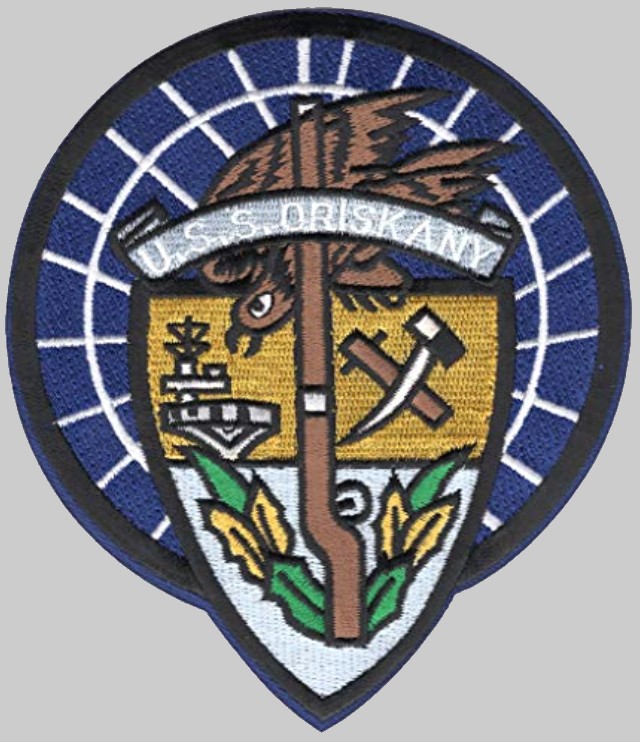 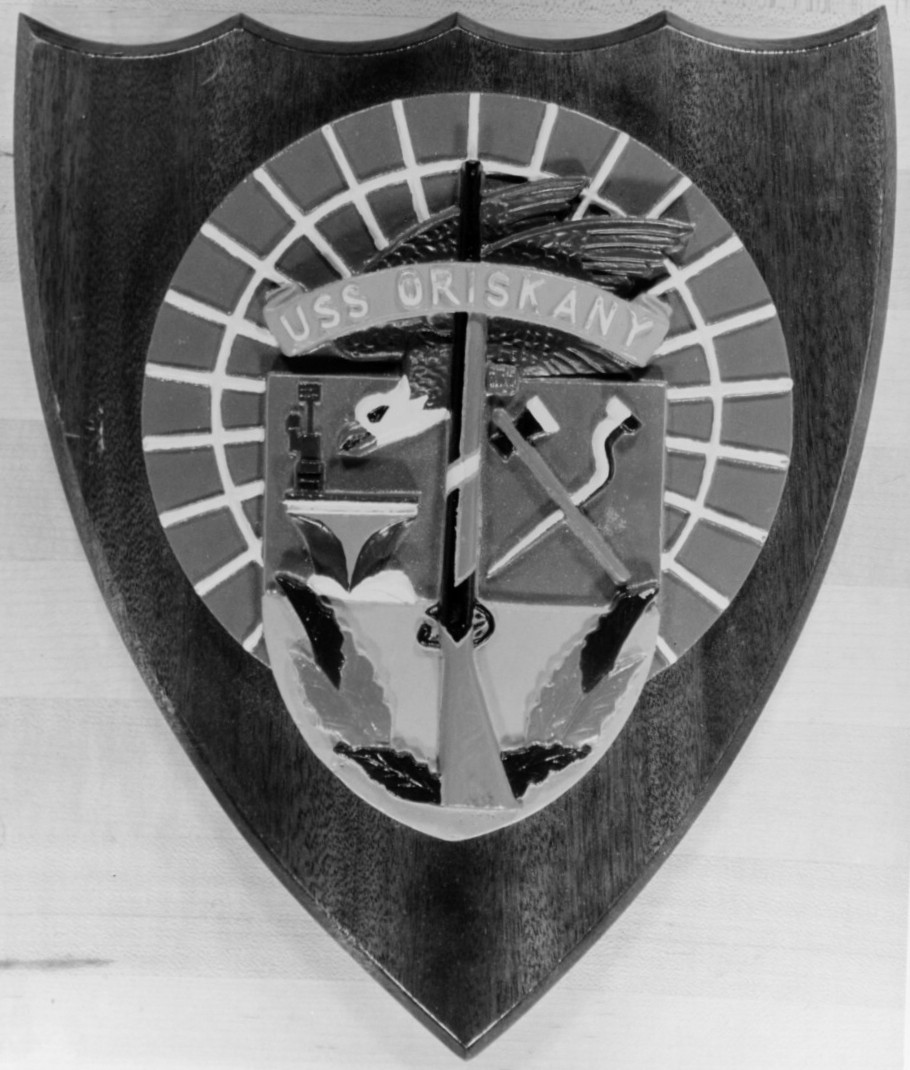 |
||
|
|
seaforces.org |
USN ships
start page | |